

How To Visit Mt Fuji From Tokyo: Ultimate Fuji Day Guide
If you are looking to experience one of Japan’s most quintessential experiences, a visit to Mount Fuji from Tokyo is the perfect day trip. From majestic mountain views and sparkling lakes, going on an excursion out of Tokyo will give you an unparalleled chance for exploration that combines culture with nature.
Whether it be hiking up its slopes or viewing cherry blossoms in nearby fields during springtime – stand atop this iconic peak and take in vistas like no other! In our comprehensive guide below, we detail various options for visiting Mt. Fuji from Tokyo so come along as we uncover all there is to explore near its mighty summit!
How To Get From Tokyo To Mount Fuji?
You have 3 main options for traveling from Tokyo to Mount Fuji. The train, the bus or Join a tour. Each option has its own advantages. The express train is the most comfortable, the highway bus is the cheapest and a tour will allow you to fit more into your trip, especially if you are planning just a day trip.
The Fuji Excursion Train

The Fuji Excursion is a fantastic new train service that began in 2019 and runs from Shinjuku Station in Tokyo to Kawaguchiko Station at the base of Mt.Fuji. The journey takes approximately 2 hours with 3 services running per day.
The Fuji Excursion is comfortable and provides travelers you an unparalleled view of Mount Fuji and the surrounding countryside as you make your way to the iconic mountain at speeds up to 155 miles per hour.
For JR Pass holders you can use it for some of the journeys but you’ll need a ticket for the final section which runs on a non-JR rail line.
There are no direct transport options from Tokyo Station so you should first travel to or stay near Shinjuku station where most of the best ways to get to Mount Fuji from Tokyo start off. Japan Rail Pass holders can also take the bullet train and then change to a bus but this option will actually take longer.
Note: Another Option is the Fujikyu railway line which requires a change or two.
Fujikyuko Bus
Another way to visit mount fuji from Tokyo is to take the Fujikyuko Bus. This affordable option offers a one-way ticket for just 2,000 yen per person and will take you on your journey in just over 2 hours.
The trip begins at the Shinjuku Expressway Bus Terminal, located on level 4. This modern transportation hub is next to the Shinjuku Train Station, making it easy to find and board. The bus takes a direct route to two popular destinations: Kawaguchiko Station and Fuji-Q Highland, giving you the chance to explore both places.
The bus runs every 10 to 30 minutes, so you have the flexibility to choose a departure time that fits your schedule. Buses run from 6:45 AM to 8:15 PM, so you can plan your trip accordingly.
Booking your bus tickets is hassle-free, you can do it online or at the bus terminal. To avoid disappointment, we recommend booking online or a day or two before at the terminal as there are times when the tickets at the bus terminal are fully booked.
Take A Bus Tour
Japan has such a great public transport system and it’s so easy to get around that you really don’t need to book tours for most destinations. But a day trip to Mount Fuji is one trip where a tour actually makes a lot of sense.
That’s because the Mont fuji area is quite spread out and getting around requires a confusing mix of trains and busses from different companies. And if you only have one day you can find yourself spending half your time waiting for trains and buses.
Here are some recommended tours that are easily booked online:
When is the best time of year to visit Mt Fuji?
The best time to view Mt Fuji is during the winter and spring months. The landscape surrounding Japan’s highest peak becomes even more beautiful when it appears on the horizon, with its snow-covered summit rising above a sea of clouds giving an otherworldly experience for visitors. This phenomenon known as “diamond dust” occurs from late November through March, affording breathtaking views that are unrivaled in their beauty. To further enhance your viewing experience try visiting at dawn or dusk – sunrise over Shiraito Falls is said to be particularly spectacular! On clear days you can also take advantage of excellent visibility by heading out onto Lake Kawaguchi and sailing into the shadow cast by Mount Fuji itself before watching its silhouette slowly disappear behind pink hues created as day transitions into the night – mesmerizing!
10 Things To Do On A Trip To Mount Fuji
In case you are not fond of climbing or your health doesn’t permit you to do so, you can wander around Mount Fuji’s base and enjoy plenty of attractions in the towns nearby.
Things to do in the mount fuji area include a diverse range of activities, from taking in the views, hiking, shopping or even visiting an awesome theme park.
While many people look to do a day trip from Toyko you could easily spend multiple days in the area and still have plenty to do. Here are some of the best of them.
Oshino Hakkai
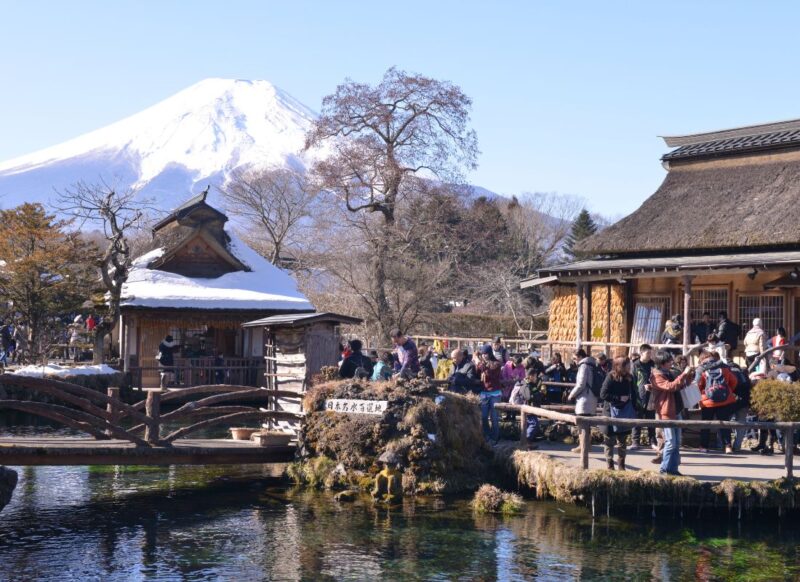
Oshino Hakkai is an incredibly unique and beautiful destination in Japan that all travelers should visit. Located at the foot of Mt. Fuji, it’s a stunning place to explore and find peace among its natural beauty.
The main attraction here is Lake Shoji—also known as Oshino Hakkai—which is made up of eight small ponds connected by waterfalls, giving off an air of serenity for visitors looking to take a break from their travels around Japan or hike along one of the many trails nearby.
The lake was created from melted snow on Mount Fuji which then ran down into these depressions over time, forming this gorgeous landscape with crystal-clear waters surrounded by green hillsides sprinkled with wildflowers during certain times of the year.
This area has been venerated since ancient times; local legends tell tales about Princess Konohana Sakuya Hime who brought flowing streams and forests upon coming to live near what became modern-day Oshino Village centuries ago – making her spirit said to still be present!
There are also various shrines located throughout this region dedicated to those gods related to the creation myth story mentioned above so you can feel even deeper ties with history while exploring them too.
Chureito Pagoda

The Chureito Pagoda is a stunning structure situated on the hills of Arakura Sengen Park. Built over 400 years ago, this unique pagoda has become quite an iconic symbol for many Japanese people and a photo of it with Fuji in the background has become one of the most iconic and recognised scenes in Japan.
The red five-story pagoda stands out amongst its lush green surroundings against which it seems to be dramatically perched atop. With its long winding stairs leading up to it, the view from the top alone makes climbing all 399 steps worth it!
Its vista can stretch as far as Mt Fuji and beyond during good weather conditions and it’s a popular place to view both the cherry blossom and Autumn “Koyo” leaves.
Not just beautiful landscapes but also intriguing stories are associated with this place like how these grounds were used by samurais back in ancient times or that every April they celebrate Cherry Blossom Festival along with traditional dances here.
You can get here by local train so it’s easy to discover the true beauty of Japan at Chureito Pagoda or if you plan to take a tour, here are a few that include this great location:
The Kachi Kachi Ropeway

The Kachi Kachi Ropeway, or Mt. Fuji Panoramic Ropeway, is one of those experiences that you simply can’t miss when visiting Mount Fuji. This ropeway, or aerial lift, takes you on a thrilling ride up to the top of Mount Tenjo, where you’ll be treated to some of the most breathtaking views of Mount Fuji and the surrounding area.
Once you reach the top, you’ll find yourself at the Kachi Kachi Yama observation deck, where you can take in the panoramic views of Mount Fuji and the surrounding area. It’s truly an awe-inspiring sight and one that you won’t forget.
From the observation deck, you can see the beautiful Fuji Five Lakes, and even spot Mount Fuji on a clear day.
The ropeway ride itself is a real treat. You’ll be gently gliding over the forest, taking in the sights and sounds of nature as you make your way up the mountain. The ride is about 15 minutes long and it gives you the chance to appreciate the natural beauty of the area.
Overall, the Kachi Kachi Ropeway is a must-do experience when visiting Mount Fuji. The views are simply spectacular, and the ride itself is a real treat. So, if you have time, make sure to add it to your itinerary.
Fuji Shibazakura

The Fuji Shibazakura, or pink moss Phlox, is an incredibly beautiful flower that blooms each year in the spring around Mount Fuji. It’s a stunning sight to behold and one of Japan’s most iconic natural attractions during this time of year – making it well worth visiting for any avid traveler!
Once at Mt Fuji 5th Station visitors will find themselves surrounded by an incredible carpet of these gorgeous flowers as far as the eye can see! The best time to visit is usually between late April and mid-May when peak bloom occurs although color variations may also occur due to weather conditions so if possible try planning ahead before traveling out here just in case.
Fuji-Q Highland
Catching the Fuji-Q Highland is an experience like no other. Located in Japan, this amusement park features some of the most thrilling rides you’ll ever find! From roller coasters that reach speeds up to 95 mph and towering drop towers reaching heights over 200 feet tall, there’s something for everyone at this one-of-a-kind Adventureland.
One example of a unique ride at Fuji Q Highland would be Dodonpa – considered by many as “the fastest coaster on Earth”, it reaches its top speed within 1 second after launch! It also has multiple loops and twists before finally coming to rest back where it began. Another popular attraction here is Takabisha: a heart-pounding freefall coaster with seven extreme drops – including one so steep that riders are actually pushed into their seats due to inertia forces known as “air time”!
The last stop must be the Eejanaika 4D Roller Coaster–this beastly machine not only spins 360 degrees but can even rotate your seat backward during certain parts of the track for extra thrills (and chills!).
Whether you’re looking for excitement or just want to take in all the sights from above, catching Fujii Q Highlander will leave you wanting more every single time. So don’t miss out on your chance to visit this incredible theme park – make sure you catch it soon!
Itchiku Kubota Art Museum

The Itchiku Kubota Art Museum is a world-famous museum located in Fujikawaguchiko, Japan. Founded by master kimono artist and dyer, Itchiku Kubota (1917–2003), the museum houses an amazing collection of his life’s work as well as works from other Japanese traditional artisans — all intricately crafted with hand-dyed silk fabric.
One example worth mentioning include Kubata’s famed Tsujigahana design used on many garments within the collection—an artistic style that blends textile dyeing techniques with elaborate nature motifs such as cherry blossoms or seasonal patterns like falling leaves to create complex layers of depth and texture.
Another noteworthy piece is “Tategami no Kuni,” a full-length robe composed entirely out of golden embroidery threads meant to represent clouds hovering over mountains – adding another layer to its intricate beauty!

Catching a glimpse of Mount Fuji from Oishi Park is an experience like no other. Located in Fujinomiya City, the park offers great views of Mt. Fuji and stretches across 5 hectares of waterside land with plenty to explore.
The main attraction at Oishi Park is its many cherry blossom trees that line both sides of the road as you make your way up towards the peak where you can take some amazing picturesque photos backdropped by Mount Fuji. The colors created by these blooming flowers during the spring season create a breathtaking view that will surely leave visitors mesmerized for hours together!
Apart from this natural beauty, there’s also plenty else to do here including hiking trails that offer spectacular views over different parts of Japan’s highest mountain, various picnic spots & even camping grounds.
Gotemba Premium Outlets
Gotemba Premium Outlets is Japan’s largest outlet mall, offering shoppers a unique and luxurious shopping experience. Located at the foot of Mount Fuji in Gotemba City, Shizuoka Prefecture this sprawling complex offers over 230 stores from some of the world’s leading fashion brands such as Burberry, Coach, and Gucci amongst others.
The outlets range from high-end luxury items to affordable everyday basics – all with amazing discounts up to 70% off retail prices!
One interesting feature of Gotemba Premium Outlets is its “Lucky Bags”. At certain times throughout the year, customers can purchase these bags which contain an assortment of mystery products ranging anywhere between ¥50000 – 200000 yen.
With no knowing what you’re going get it makes for exciting purchases every time! On top of that there are also free seasonal events like summer festivals, concerts and fireworks display taking place here each year that often attract large crowds who come out both shop & enjoy themselves.
Aokigahara Forest

Aokigahara Forest, also known as the Sea of Trees or Suicide Forest, is a vast expanse of wilderness and dense forests located at the base of Mount Fuji in Japan. It’s almost 35 square kilometers and full of dark tales that have been perpetuated over centuries by folklore and urban legends. As one might expect from its name, Aokigahara has become associated with suicide; it’s estimated that about 105 people take their lives there each year. Its eerie reputation dates back to feudal times when families would abandon elderly relatives to die alone within the forest due to poverty or illness – this practice even inspired an Edgar Allan Poe short story entitled “The Mines Of The Fukuoka-ya”.
In recent years, however, many efforts have gone into trying to reverse Aokighagara’s morbid image through positive activities like hiking trails being opened up for tourists who come visit Japan on holiday.
Local rangers offer guided tours designed specifically around exploring natural beauty while learning more about traditional Japanese culture during their hike.
Fuji 5th Station
The Fuji 5th Station is a special place located on the side of Mount Fuji, one of Japan’s most iconic and sacred locations. Located at an elevation close to 2,300 meters (7,500 feet), it marks about halfway up the mountain for climbers attempting to summit this mighty peak – that’s why many call it “the midpoint station.”
It got its name from being the fifth point in a series of lodges built along Fujisan’s climbing route beginning in 1937; each lodge was designated as either the first or second station depending upon their location near ascending/descending paths respectively.
The main attraction here is undoubtedly breathtaking views towards nearby peaks like Yatsugatake-san and Akaishi Mountains range while gazing out over Lake Kawaguchi below—a truly magical sight.
There are also plenty of other activities visitors can partake in such as hiking trails leading off into different parts of nature around Mt Fuiji with stunning waterfalls cascading down rock sides, souvenir shops selling food items native only found there plus traditional craftsman studios where you can watch artists creating beautiful works made right before your eyes!
If you’re more of the adventurous type and fond of adventurous activities and you’d like to actually climb it, read on. Fuji is 3776m high and can be reached by taking a direct bus from Shinjuku to the Subaru fifth station and climbing the mountain from thereon.
If you’re looking to do it the easy way you can take this tour of climbing Mt. Fuji from Tokyo and explore its breathtaking spots.
Climbing Mount Fuji – For the Adventurous and Fit

The climbing season at Mount Fuji starts July 1st and it remains open until September 14th. Even though climbing Mount Fuji is an adventure and excitement-filled journey, it can turn out to be quite tiring as it will take somewhere between 5 and 7 hours for an average person to climb it if they have taken the Yoshida Trail from Fifth Station.
Furthermore, it will require a further 3 to 5 hours to return back to the base. Therefore, it is recommended to reach the fifth station in the early morning so that you can climb the mountain in time and spend a night there.
This will not only give your body the much-needed rest but also provide you with the opportunity to have a once-in-a-lifetime experience of spending a night amidst the beautiful natural surroundings. After spending the night there, you can wake up early the next day to capture the amazing visual of sunrise and preserve it in your memories forever.
If you are not fascinated with the idea of spending a night in a mountain hut, then it is recommended to start early in the day so that you can come back by night. However, you need to be fit and healthy to accomplish this feat of climbing and descending in a single day.
2. Hiking in Mount Fuji Tour: This two-day tour will take hikers through five different trails located near the summit of this iconic peak for an incredible experience that’s sure to be both awe-inspiring and challenging all at once!. The first day involves taking bus transportation from Tokyo directly to Subashiri Trailhead before setting off early morning on your hike along one of several routes available depending upon the difficulty level desired by participants; overnight lodging is provided afterward prior to the final ascent the next day leading up towards summit itself with ample time spent exploring various points along the way if conditions permit including visit famous shrine known as Chureito Pagoda nestled away amidst lush surroundings atop nearby hillside offering picturesque views stretching outwards across horizon beyond during hours just after sunrise or right before sunset—definitely something not easily forgotten anytime soon thereafter!
When Is The Bst Time to Climb Mount Fuji
As discussed above, you can plan a trip to climb Mount Fuji between the 1st of July and the 14th of September. However, if you’d to avoid the crowds, select any weekday for climbing as most locals head to this mountain during the weekends.
Furthermore, mid-August is recorded to be the most crowded time. Therefore, plan your trip in the last days of July or early September to have the best experience.
Exploring Mount Fuji – The Easy Stroll
For those who merely want to explore the beauty of Mount Fuji without climbing it, you can take a stroll on the Ochudo Hiking Trail and explore the nearby towns after getting off at the Subaru Fifth Station. If you’d like it even easier – you can enjoy the panoramic views of this mountain by taking a bus that goes between the towns situated at the mountain base.
Some Points to Remember
These are some of the factors that you must consider before embarking on this journey of climbing Mount Fuji:
- It is located at a great height; thus, there are chances of altitude sickness
- If you want to spend a night in a mountain hut, it is strongly recommended to reserve it prior to starting your journey. During the peak season, it can prove to be extremely difficult to find a mountain hut to stay in
- If you are climbing through the night or climbing and descending in a single day, make sure you are in the best of your health. Moreover, you are not required to reserve a hut if you intend to stay in it for merely resting purposes. They typically charge on an hourly basis
- The weather conditions in Tokyo are fluctuating. Thus, reserving a mountain hut and bus in advance locks a particular day for you. Bad weather on such a day can make it difficult for you to climb. Therefore, make sure you have checked the weather forecast for the day before making reservations
Tokyo Trip Checklist
Similar posts.

Mt Fuji and Lake Kawaguchi Scenic 1-Day Bus Tour
In the heart of Japan’s stunning landscapes lies a tour that will transport you to a world of awe and wonder. The ‘Mt Fuji and…

Best Private Tours To Mount Fuji
Mount Fuji is one of the most popular tourist destinations in Japan, attracting millions of visitors each year. Located about 100 kilometers southwest of Tokyo,…
- Work With Us
- Blogging Bootcamp

- Van Conversion Academy
- Campervan Shop
- Campervan Rentals
- Plan a Trip
- Itineraries
- Destinations
- Responsible Travel
- Family Travel
- Budget Travel
- Scuba Diving
- Travel Credit Cards
- Digital Nomad
- Teach English Abroad
- Blogging Resources
- Income Reports
- Travel Shop
- Meet Katie & Ben
- About Two Wandering Soles
- Personal Stuff
- Portfolio & Press
Mount Fuji Day Trip From Tokyo: How to Get There + Tips!
Home » Blog » Japan » Mount Fuji Day Trip From Tokyo: How to Get There + Tips!
The iconic peak of Mount Fuji is without a doubt one of the top sights in Japan and absolutely worth adding to your itinerary. This guide will help you plan the perfect Mount Fuji day trip from Tokyo, including unique experiences and hidden gems.
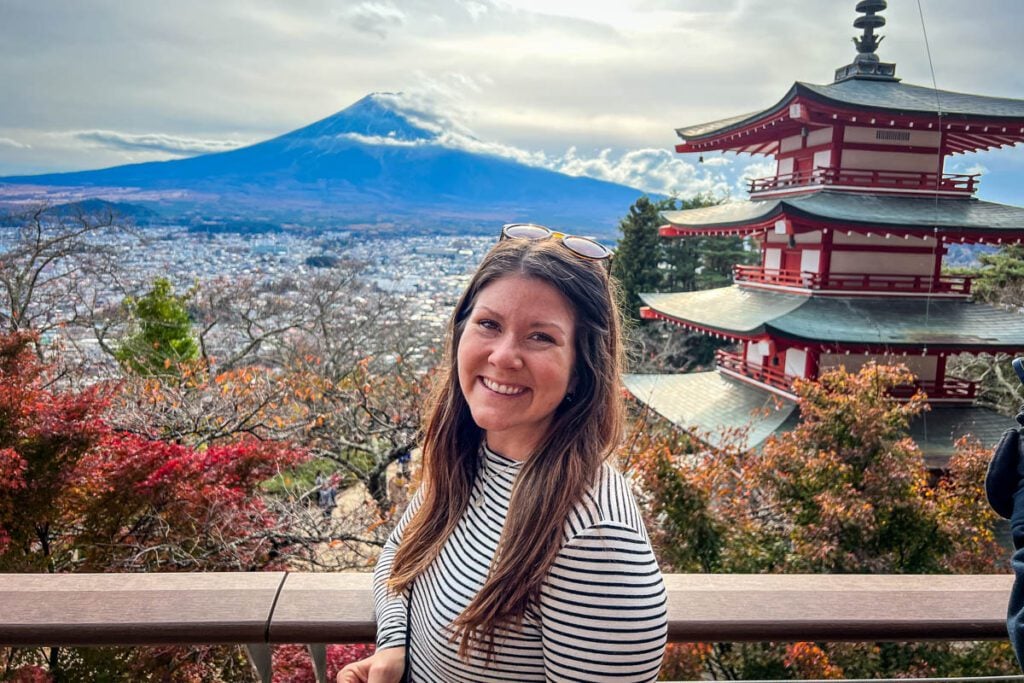
When you think about Japan, the majestic peak of Mount Fuji is probably one of the first images that comes to mind: a near-perfect conical volcano capped with snow and surrounded by stunning landscapes.
Seeing Mount Fuji in all her glory tops many travelers’ Japan bucket lists , and for good reason – this iconic mountain is almost synonymous with Japan and is truly incredible to see in person.
If you don’t have a lot of room in your Japan itinerary , a Mount Fuji day trip from Tokyo is a great way to peep the famous peak.
There are essentially 3 ways to experience Mount Fuji as a day trip from Tokyo :
- Use the Hakone Free Pass
- Self-drive to Kawaguchiko
- Join a guided tour
In this guide, you’ll find itineraries for each of these day trips, including top sights as well as hidden gems.
We’re also sharing some pros and cons for each so you can compare and decide the best day trip to Mount Fuji for your interests and travel style.
Mount Fuji Day Trip Guide
- Why take a day trip to Mount Fuji
Day trip #1: Hakone Free Pass
Day trip #2: self-drive to kawaguchiko, day trip #3: guided tour from tokyo.
- Mount Fuji facts
- Other things to do nearby
- When to visit
- What to pack
Mount Fuji FAQs

The ultimate Japan packing list
If you’re planning a trip to Japan, we have the ultimate resource for you!
This FREE PDF download includes everything you’re going to want to pack for your Japan trip, including what NOT to bring, plus tons of insider tips!
Sign up for our ultimate Japan packing list now and get a copy sent straight to your inbox.
Why should you take a day trip to Mount Fuji?
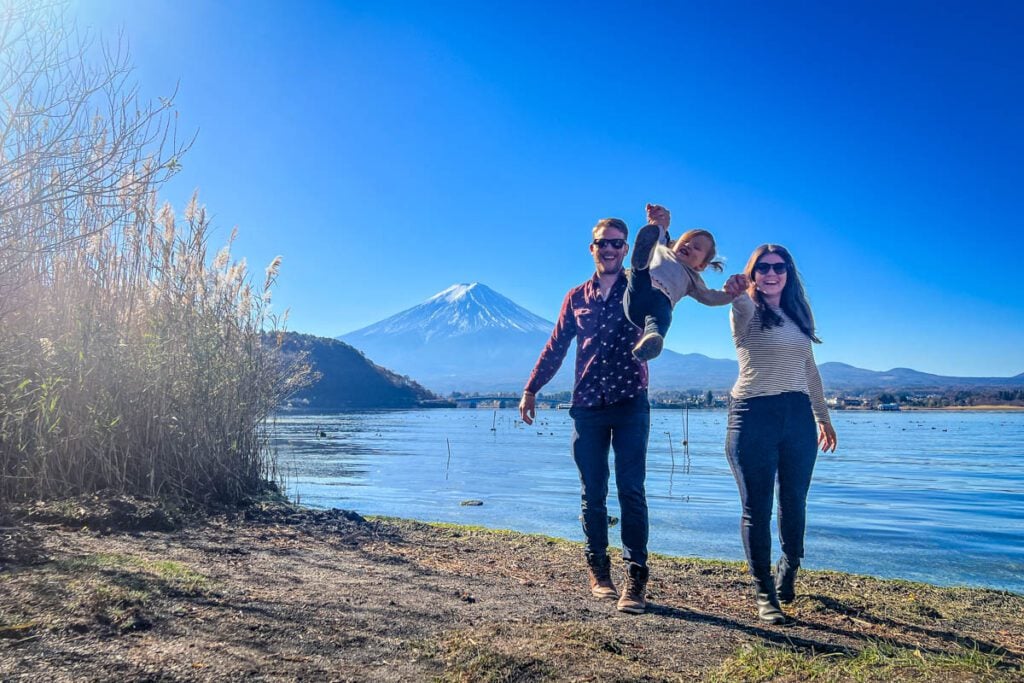
Mount Fuji should definitely be on your Japan itinerary; the question is, what is the best way to visit the magnificent peak?
The biggest advantage of a Mount Fuji day trip from Tokyo is that you can monitor the real-time forecast , look at the live cams , and plan a last-minute day trip when you have the best chances of visibility (as long as tours/rental cars/trains aren’t sold out).
That said, we highly recommend staying near Mount Fuji if you have the time.
For one thing, you’ll have more chances to see the mountain in case you get unlucky with the weather. Plus, there are lots of unique accommodations , onsens, and other things to do in the area that you wouldn’t be able to do on a day trip.
Stay at a traditional ryokan in Hakone and enjoy a relaxing soak in an onsen as stars twinkle overhead. Alternatively, Kawaguchiko has a ton of really cool glamping opportunities, like this one we personally stayed at (and loved!).
However, with an overwhelming number of things to do and beautiful places to see in Japan , lots of people will only have a day or so to spend in the Fujisan area. So without further ado, here are our recommendations for a perfect Mount Fuji day trip from Tokyo!
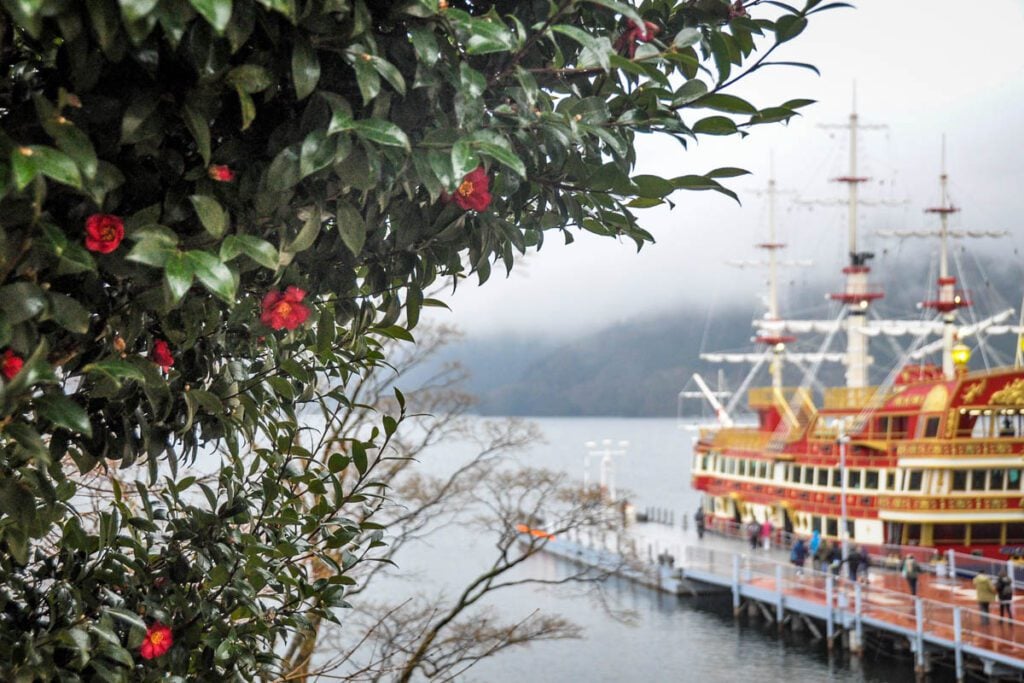
Nestled in the mountains on the shores of Lake Ashinoko, Hakone is a renowned hot spring destination and one of the most popular places to view Mount Fuji.
So popular, in fact, that the town basically has tourism down to a science in the form of the Hakone Free Pass .
Okay, so the pass is not “free” – it costs around $42-45 USD for a 2-day or 3-day pass . Note that single-day passes are not available, so if you needed an excuse to extend your trip to Hakone, you’ve found it!
The pass grants you unlimited travel on 5 different modes of transportation in Hakone, including buses, local trains, a cable car, a ropeway, and even a boat cruise. These are laid out in an easy-to-follow loop that takes you around the most famous attractions in Hakone.
- This route is specifically designed for tourists to see the top sights around Hakone .
- The pass also gets you discounts at a number of restaurants, shops, and accommodations in the area.
- Doing this as a day trip makes for a tight itinerary .
- You won’t be able to get off the beaten path much, and the main attractions are pretty touristy and very crowded .
How to get the Hakone Free Pass
You can purchase the Hakone Free Pass online in advance and pick it up at Shinjuku Station in Tokyo, or you can buy it in-person.
We recommend you pick up your pass a day or two beforehand , as the queue can get pretty long and you’ll want to start your day trip as early as possible.
How to get there
You should plan to arrive in Hakone and start the loop around 9 a.m. to avoid the crowds as much as possible.
With your Hakone Free Pass in hand, there are two trains you can take from Shinjuku to Odawara Station :
- The Odakyu Line takes about 1.5 hours and is included in the Hakone Free Pass
- The Romancecar Limited Express takes about 1 hour 12 minutes and costs an extra ¥1,910 (about $13 USD)
Then from Odawara, it’s a 20-minute train ride to Hakone-Yumoto Station (included in the pass), where you’ll start your sightseeing loop.
While most people go counter-clockwise, we’ve heard that doing the opposite can help you avoid some crowds; so this itinerary follows the loop in a clockwise direction .
1. See the floating torii gate at Hakone Shrine
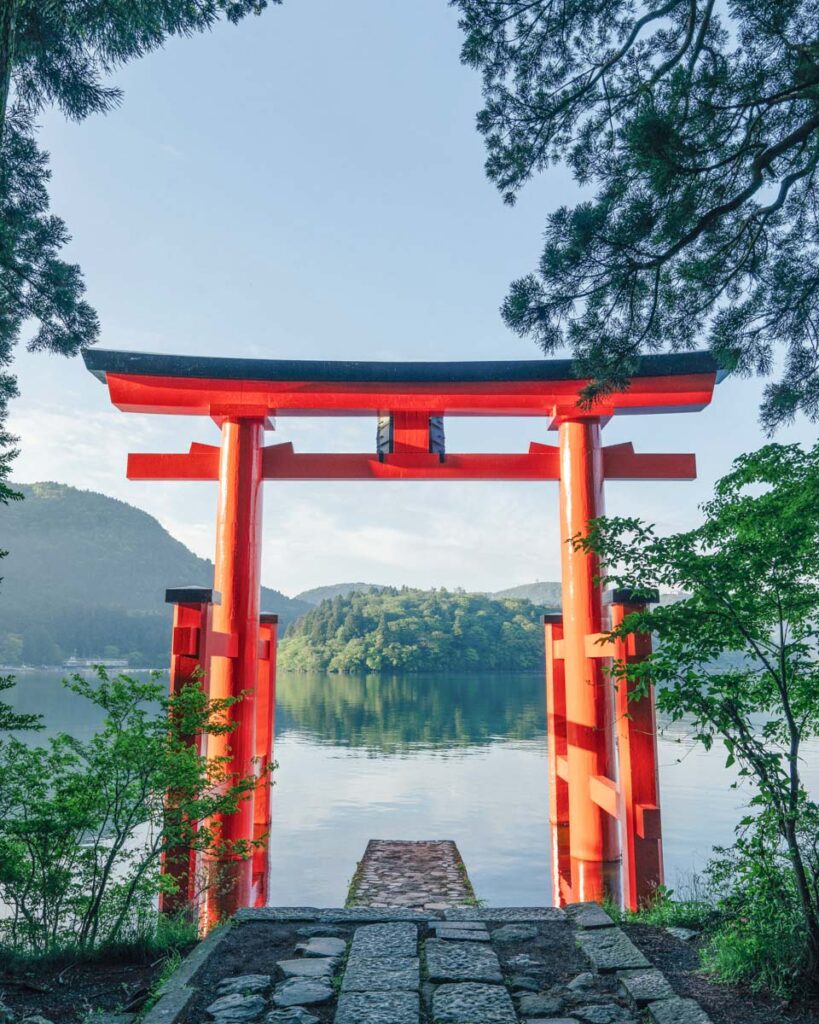
Hooray, you’ve arrived in Hakone! Hop on the Tozan Bus to Moto-Hakone pier (35 minutes). From here, it’s a short 5-10 minute walk along the lakeshore to your first stop of the day.
Hakone-jinja Shrine is the region’s most famous Shinto shrine, recognized by its iconic vermillion torii gate that stands within Lake Ashi . Known as Heiwa no Torii or “Gate of Peace”, the water gently lapping around the torii is a sight to behold.
But the rest of Hakone Shrine is not to be overlooked. Follow the beckoning torii gates into the towering 800-year-old cedars and climb the lantern-lined steps to the main shrine buildings hidden deep within the forest.
If you can peel yourself away from this peaceful setting, retrace your steps back to Moto-Hakone pier for the next leg of your journey.
2. Cruise Lake Ashi on a pirate ship
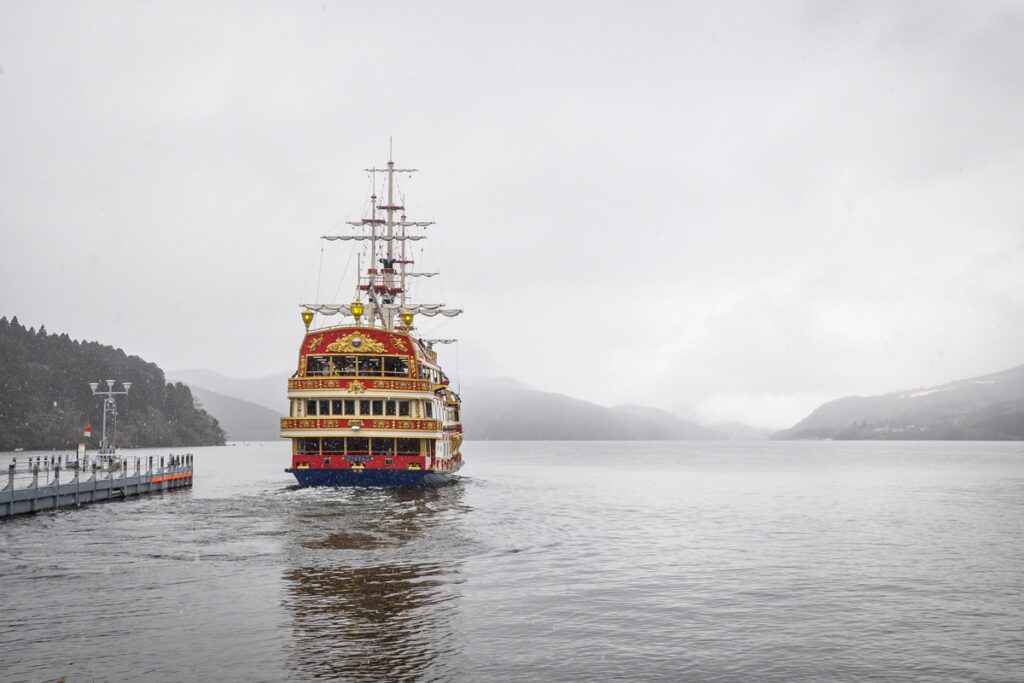
Yep, you read that correctly – included in the Hakone Free Pass is a sightseeing cruise on Lake Ashi in an elaborately-designed pirate ship.
Cheesy? Yes. Touristy? Also yes. But hey, it’s included in the pass, so climb aboard and enjoy scenic views from the water.
This is also where you’ll get that postcard-worthy shot of the floating red torii gate with Mount Fuji in the background , so have your camera ready!
3. Get a bird’s-eye view from the Hakone Ropeway
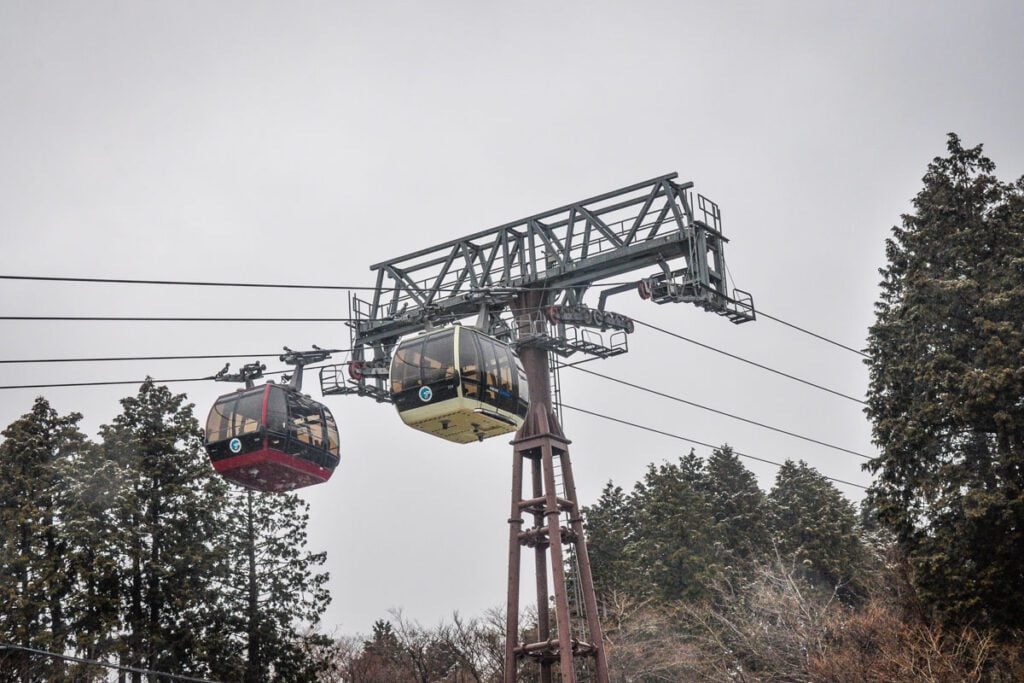
Disembark at Tōgendai Port and transfer onto the Hakone Ropeway.
Enjoy panoramic views of both Mount Fuji and Lake Ashinoko as your gondola steadily climbs higher and higher.
It takes about 15 minutes to reach the first stop at Ubako Station, then another 15 minutes to your next destination: Owakudani.
4. Eat the famous Owakudani black eggs
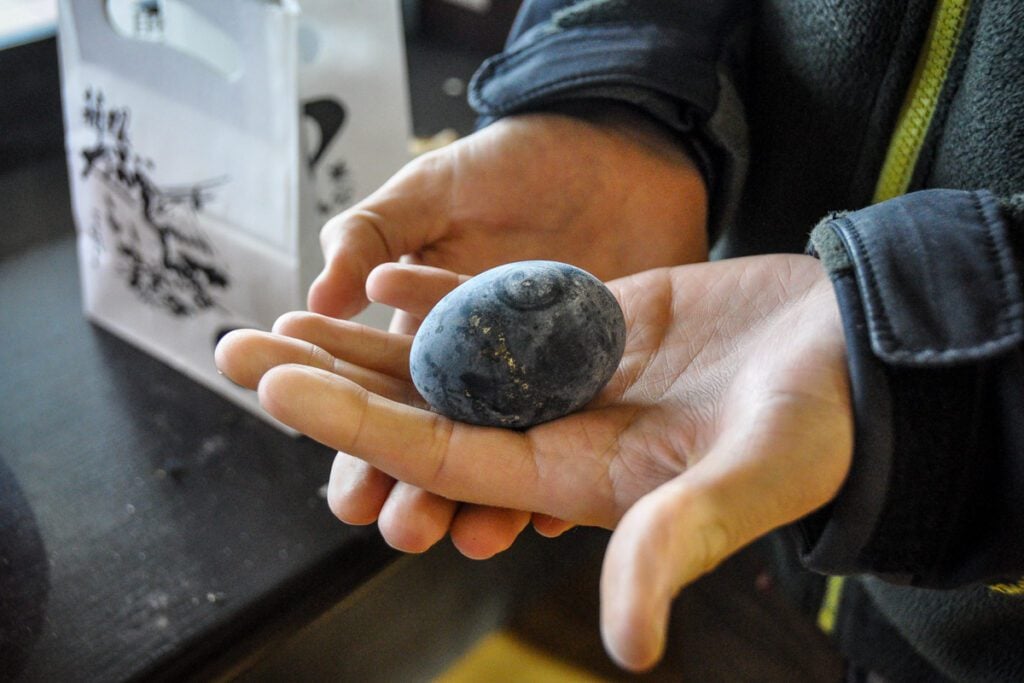
On arrival at Owakudani Station, head to Kurotamago House for a unique foodie experience you can’t have anywhere else: the famous black egg .
The eggs are boiled for an hour in local hot springs , whose waters are naturally heated by geothermal activity to a scalding 80° Celsius (176° Fahrenheit).
A chemical reaction occurs between the iron-coated eggshell and the hydrogen sulfide in the water, turning the shells jet-black. (P.s. The inside of the egg is totally normal – only the shells are black.)
Eating the black egg is a novel experience, but there’s another reason they’re so popular… Legend says that eating one will add 7 years to your life . We’ll see!
You can buy a bag of 5 eggs for ¥500 at Kurotamago House, along with a myriad of other black-egg-themed sweets and souvenirs.
Fun Fact: The eggs even have their own little ropeway to transport them from the hot spring to the store. How cute is that?!
5. Explore a volcanic valley
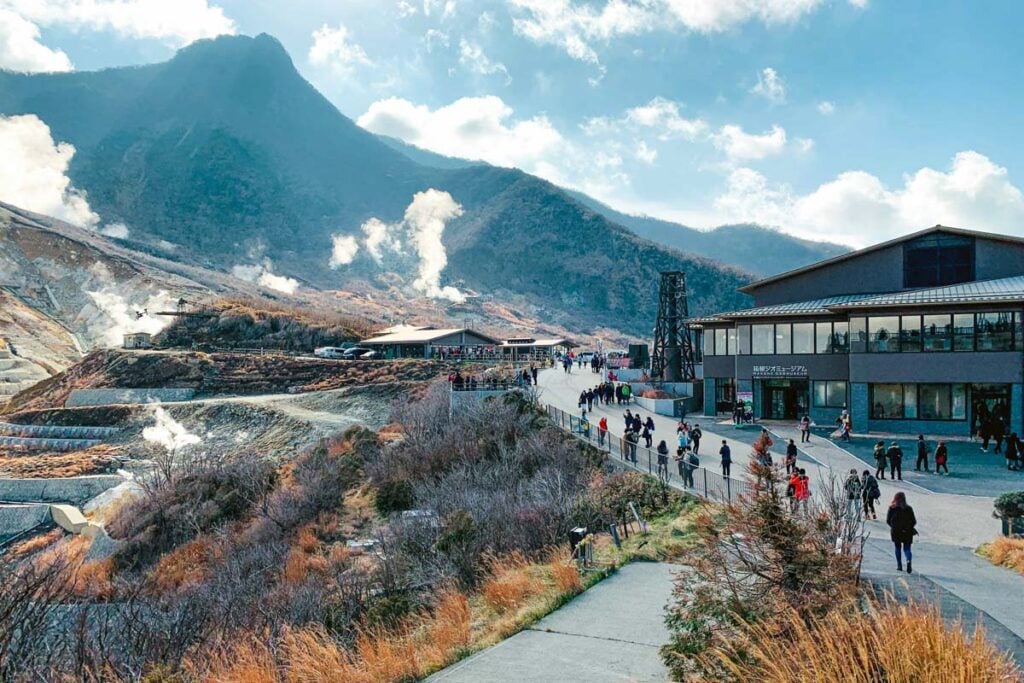
Now that you’ve had your fill of eggs, it’s time to explore one of Hakone’s most famous sights: the active volcanic zone of Owakudani .
With a name meaning “Great Boiling Valley”, Owakudani is a hotbed (pun intended) for geothermal activity. Sulfur vents spew plumes of white smoke into the air over the barren valley, creating an otherworldly landscape.
A short 10-minute walk from the ropeway station will bring you to the main volcanic zone, where you can see steam vents and bubbling hot springs up-close. On a clear day, you can even see Mount Fuji.
After taking in the scenery from the ground, hop back on the ropeway heading towards Sounzan Station. Enjoy breathtaking views from above as you soar 130 meters (436 feet) over the valley.
6. Discover the Hakone Open Air Museum
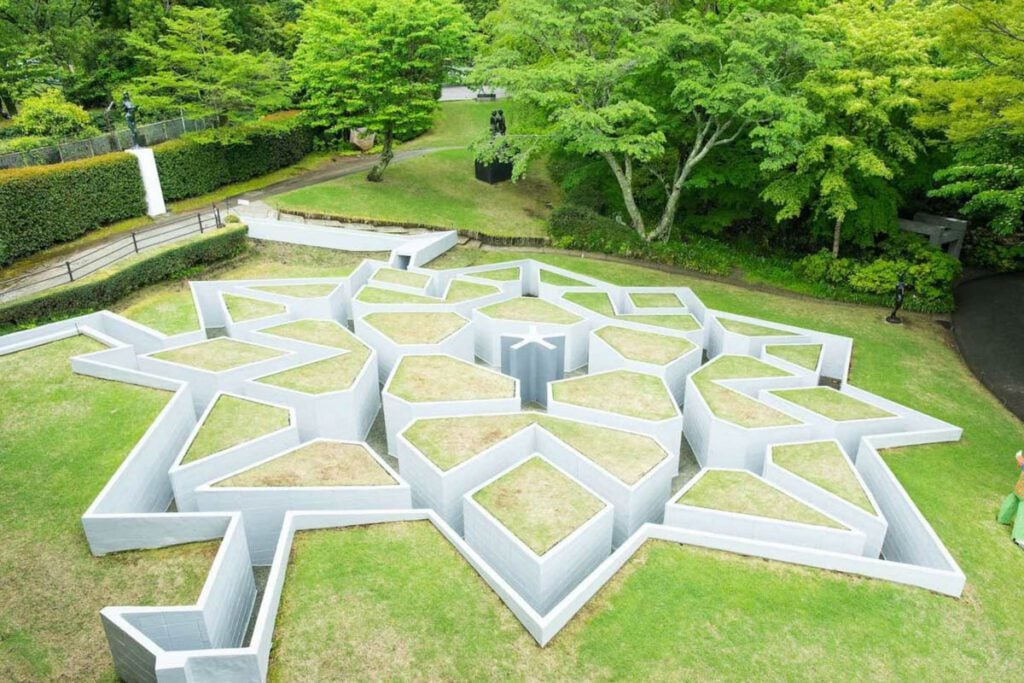
From Sounzan, take the Hakone Cable Car to Gora Station, then ride the train 1 stop (4 minutes) or walk 15 minutes to the Hakone Open Air Museum.
In Japan’s oldest outdoor museum, the natural environment is the setting of sculptures and art installations, including works from world-renowned artists like Picasso and Rodin .
You could easily lose yourself in the harmonious blend of art and nature for hours. If you’re following this itinerary as a single-day trip, you likely won’t be able to spend much time here.
- Entry fee: ¥1,400 (about $10 USD) with the Hakone Free Pass discount (¥1,600 without)
- Hours: 9 a.m. – 5 p.m. daily
7. Ride the scenic Hakone Tozan Railway
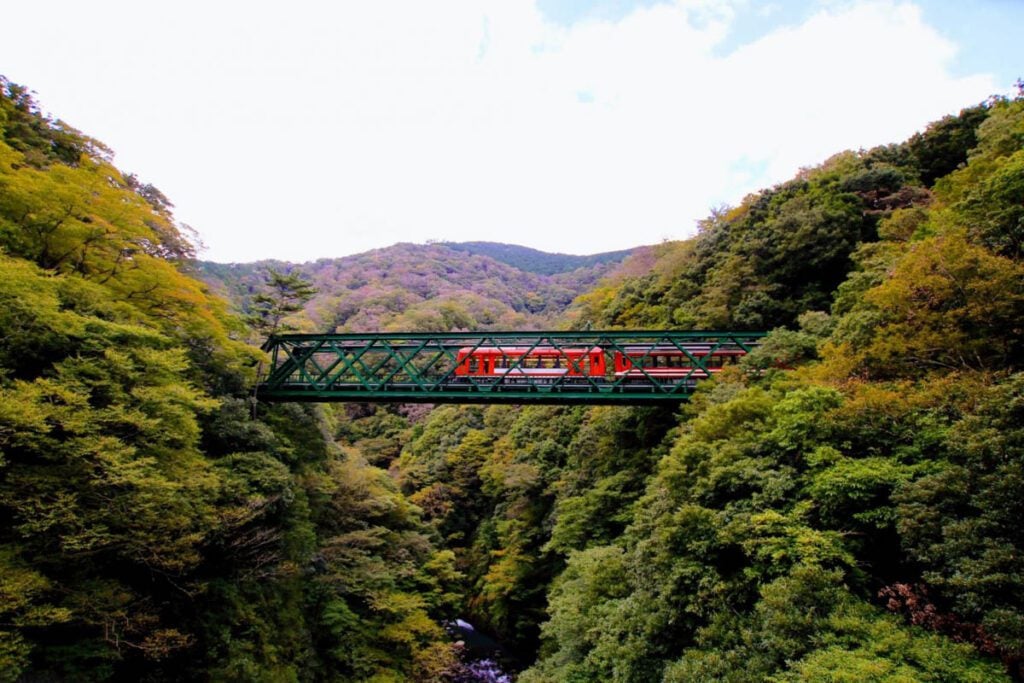
More than just a means of transportation, the Hakone Tozan Railway is Japan’s oldest mountain railway, and an experience in itself.
The ride from Gora Station to Hakone-Yumoto takes about 35 minutes as the train snakes its way through forested valleys, over high alpine bridges, and through deep mountain tunnels .
The ride is especially picturesque in late-June to early-July, when thousands of hydrangeas bloom alongside the tracks . Though if seeing Mount Fuji is your goal, keep in mind that this is statistically the worst time to view the peak.
Return to Shinjuku from Hakone-Yumoto Station the same way you came in. If you’re not too exhausted from your busy day trip, check out our favorite things to do in Tokyo at night .
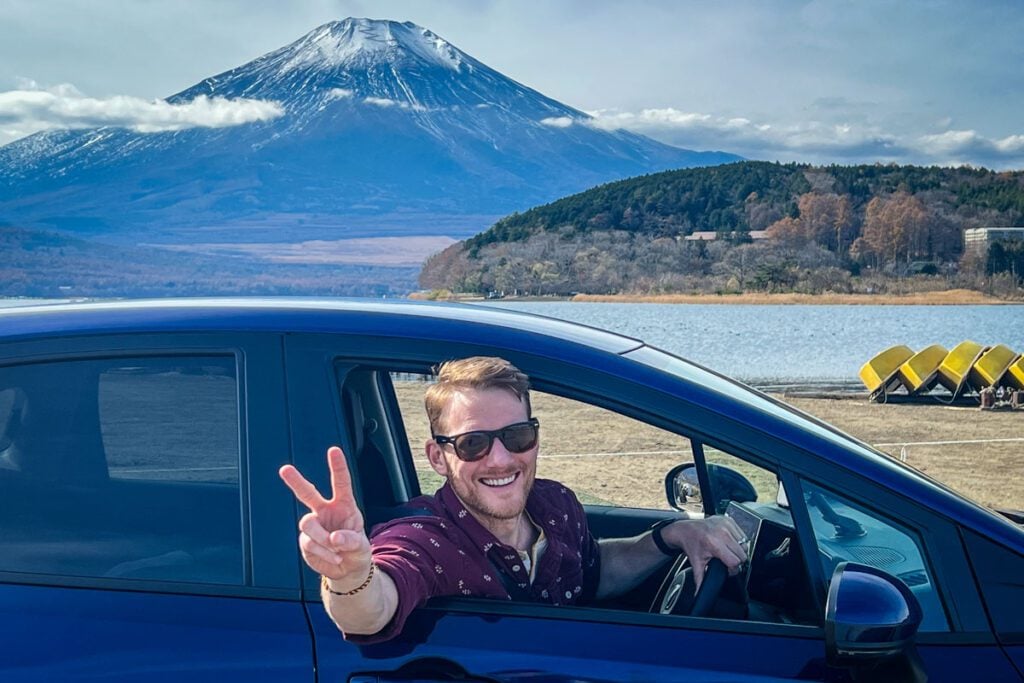
The most accessible of the Fuji Five Lakes, Lake Kawaguchi is undoubtedly one of the most popular places to view and photograph Mount Fuji. With multiple iconic viewpoints, must-see attractions, and hidden gems in the area, Kawaguchiko makes a great choice for a Fuji day trip from Tokyo.
First things first: for this itinerary, you will need a rental car .
We’ve looked into the logistics of visiting Kawaguchiko from Tokyo via public transportation, and it’s far too time-consuming and involves too much walking to be doable as a day trip.
We personally loved having our own wheels during our most recent trip to Japan, and we think you will, too!
- Self-driving gives you much more flexibility to travel at your own pace and choose the sights you most want to see.
- Driving in Kawaguchiko is easy . The roads are good, there isn’t a lot of congestion, and there’s ample parking available.
- Some people might be nervous about driving in a foreign country. Our guide to renting a car in Japan should help ease your worries!
You can pick up your rental car at just about any major train station in Tokyo. We personally picked ours up at Shinjuku Station and found it super easy.
From Shinjuku Station, follow these directions to Arakurayama Sengen Park. The distance is just under 100 km (62 miles) and the drive should take about 1 hour and 15-30 minutes, depending on traffic.
1. Photograph Mt. Fuji with Chureito Pagoda
Located within Arakurayama Sengen Park , Chureito Pagoda is celebrated as one of the best places to view and photograph Mount Fuji. By making this your first stop, you can avoid some of the crowds and capture the best lighting in the early morning.
Arrive as early as possible and secure parking at this free lot across from the park.
Opposite the parking lot, a set of lantern-lined stone steps leads up past the main buildings of Arakura Fuji Sengen Shrine. You can stop to check them out on your way back down – now it’s time to get your booty up to the viewpoint before it gets too crowded!
In total, there are 398 steps, though there is also a walking path if you prefer a gentler slope. At the top, you’ll be rewarded with arguably one of the most iconic views in Japan: the red 5-tiered Chureito Pagoda framed against the backdrop of Mount Fuji .
This is where you get that postcard-perfect shot – you know the one I’m talking about!
You’ll find several other viewpoints at the top of the hill, as well as a public toilet and some wooded hiking trails. You can do some exploring, but keep an eye on the time.
- Google Maps location
2. Ride the ropeway to panoramic views
Next, drive 13 minutes to the Mt. Fuji Panoramic Ropeway . This nearby lot is free (and actually has a nice view of the lake as an added bonus).
It takes only 3 minutes for the gondola to ascend 400 meters (1,312 feet) to Kawaguchiko Tenjozan Park. Stand near the back of the car to enjoy the view going up.
At the top of the ropeway is an observation deck offering breathtaking panoramas of Mount Fuji and Lake Kawaguchiko . Spend a few minutes enjoying the view before heading back down on the ropeway.
Wondering about all the rabbit and raccoon motifs? This mountain is the setting of a famous Japanese folktale about a rabbit and a tanuki (Japanese raccoon dog).
- Ropeway fee: ¥900 round-trip (about $6 USD)
- Hours: 9 a.m. – 4 p.m. weekdays, 9 a.m. – 5 p.m. weekends and holidays
3. Frame Mt. Fuji in a red torii gate
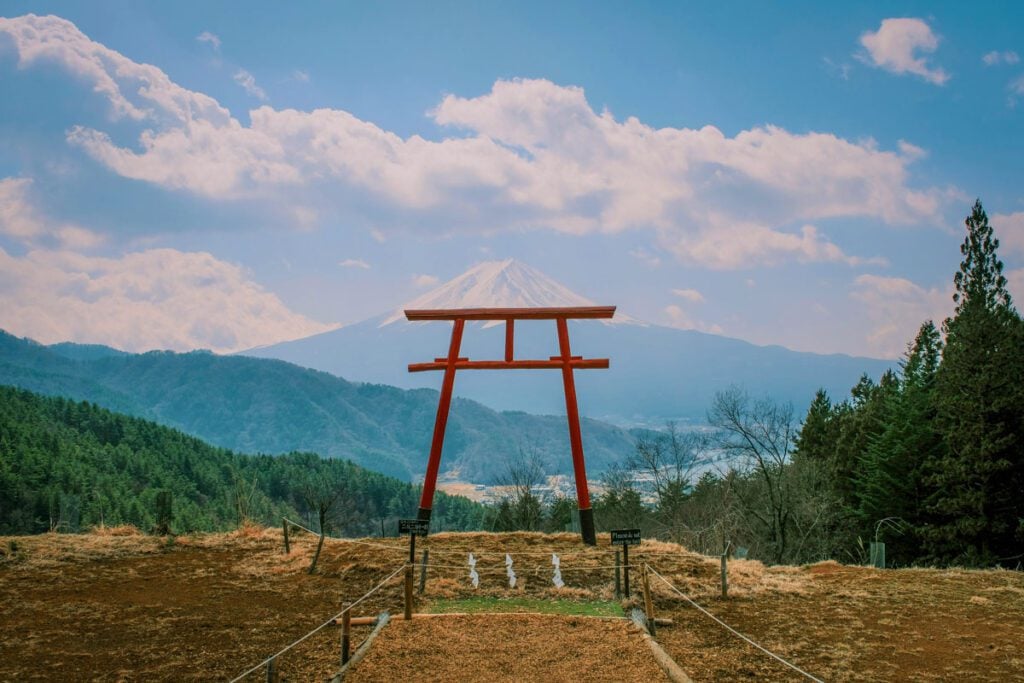
Drive another 13 minutes to Tenku no torii.
At this famous site, a red torii gate stands perched on the hillside, perfectly framing the snow-capped peak of Mount Fuji .
To approach the torii for that sought-after shot, you’ll need to pay a fee of ¥100 (about 68 cents US) to take photos with your phone, or ¥500 to use a camera. Tripods are prohibited.
Each group is limited to 3 minutes in front of the torii to take pictures. There’s usually a line, and we’ve heard the wait can be an hour or more during peak times.
Otherwise, there are plenty of fantastic views you can enjoy for free from the hilltop.
It is possible to drive up to Tenku no torii, but the road is narrow and parking can be dangerous as there is very little space and no designated lot. Alternatively, it’s about a 30-minute uphill walk from Kawaguchi Asama Shrine.
Another 10-15 minute walk up the mountain past Tenku no torii, there’s another red torii gate that stands next to a waterfall . This picturesque spot is much less busy and feels more like a hidden gem.
Drive back into town, about 4-5 minutes. The next few stops on this itinerary are within walking distance of each other, so we recommend parking and enjoying the sights on foot. This free lot is in a good location and there’s a scenic walking path along the lake.
4. Stop at this free viewpoint
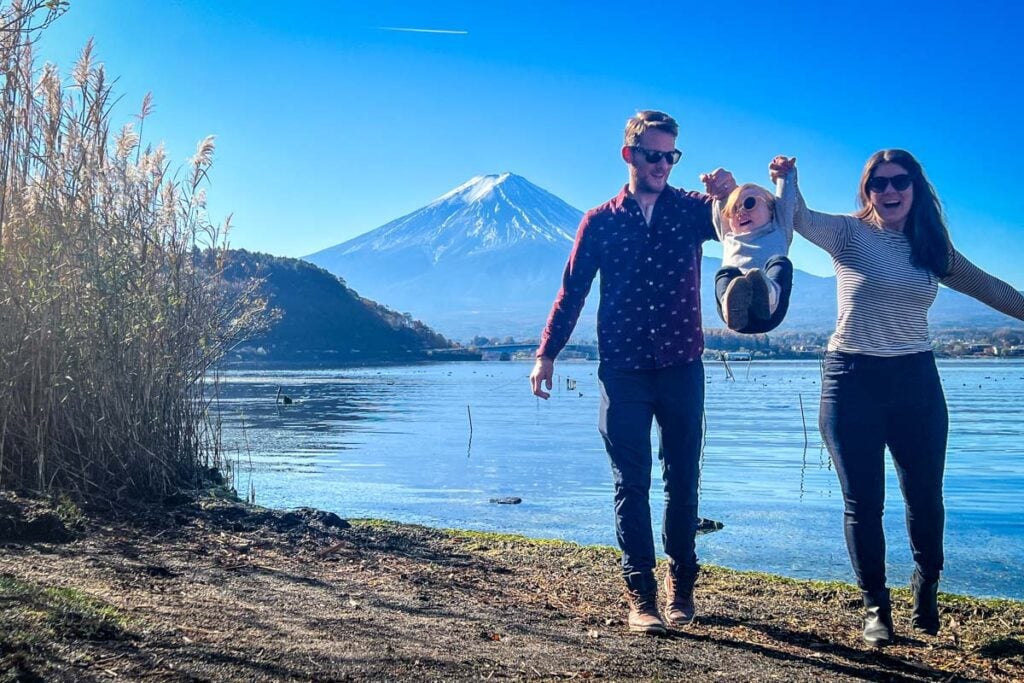
While exploring Kawaguchiko, we stopped at any viewpoint we saw that wasn’t too crowded.
This spot very close to the Music Forest Museum has unobstructed views of Mount Fuji across the lake where we were able to get some great shots!
5. Slurp hoto in a noodle shop
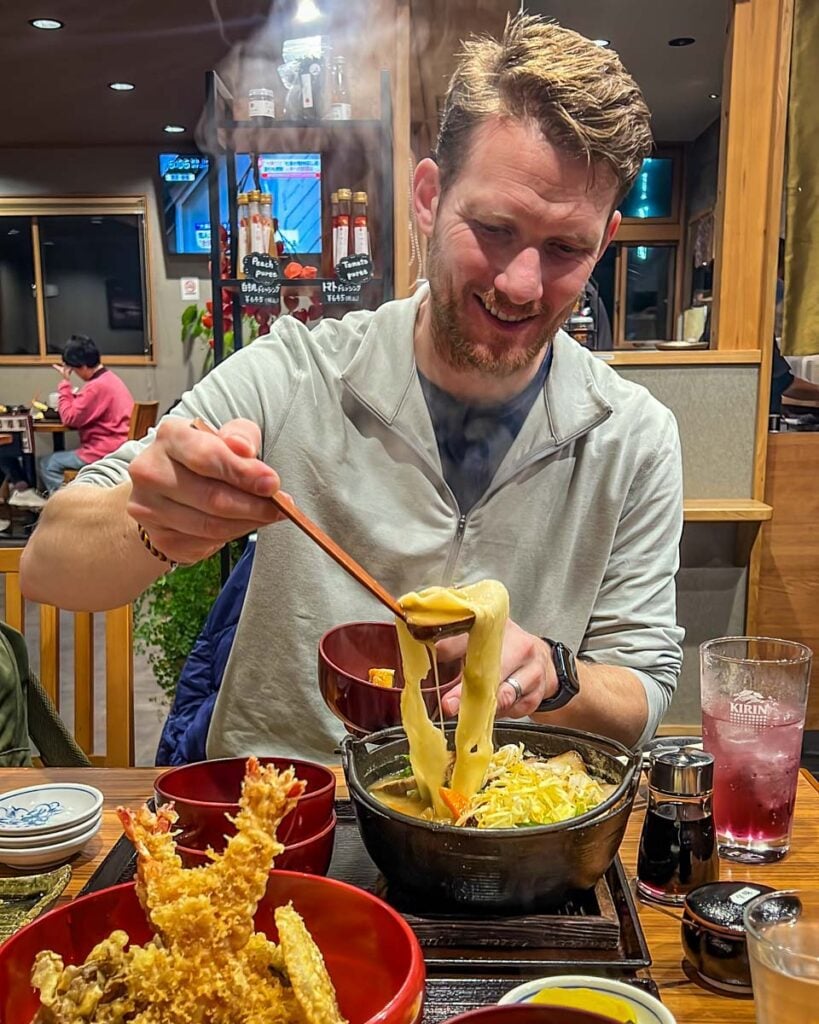
If your tummy is starting to rumble, now is a great time to get some lunch. The local specialty, hoto (sometimes spelled houtou), is sure to satisfy your craving for carbs.
Hoto is a regional stew famous in Yamanashi Prefecture. It’s made with thick, hearty noodles and vegetables (typically pumpkin) in a piping-hot miso-based broth . Some restaurants have meat options as well.
You can walk to any of these restaurants for a steaming bowl of hoto:
- Momijitei-Hoto : homey restaurant offering pumpkin, beef, or mushroom hoto à la carte or in a combo with tempura
- Houtou Fudou Kawaguchiko North Main Shop : limited menu with a special in-house spice mix you can add to your hoto
- KANJYUKUYA : farm-to-table restaurant with a seasonal menu in a renovated 120-year-old traditional house
6. Stroll the Momiji Corridor (in autumn)
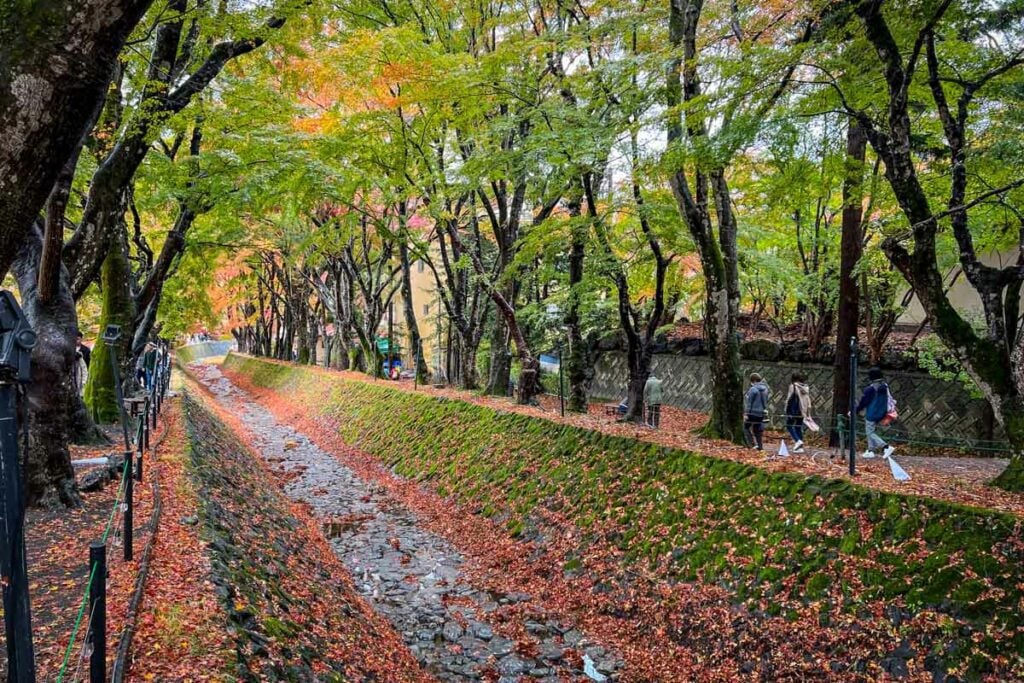
If you’re visiting Kawaguchiko in autumn, you won’t want to miss one of the best places to photograph Japan’s famous fall foliage: the Momiji Corridor .
For a stretch of about 150 meters (almost 500 feet), Japanese maple trees line the canal , their branches closing overhead to create a tunnel-like effect.
When autumn peaks around early- to mid-November, these trees display vivid shades of crimson, gold, and orange . Meanwhile, fallen leaves carpet the bottom of the dry canal to complete the 360-degree tunnel of fall colors.
Good to know: This location is different from the Momiji Tunnel , which is a popular spot to photograph Mount Fuji with red Japanese maples in the foreground.
7. Visit the Kubota Itchiku Art Museum
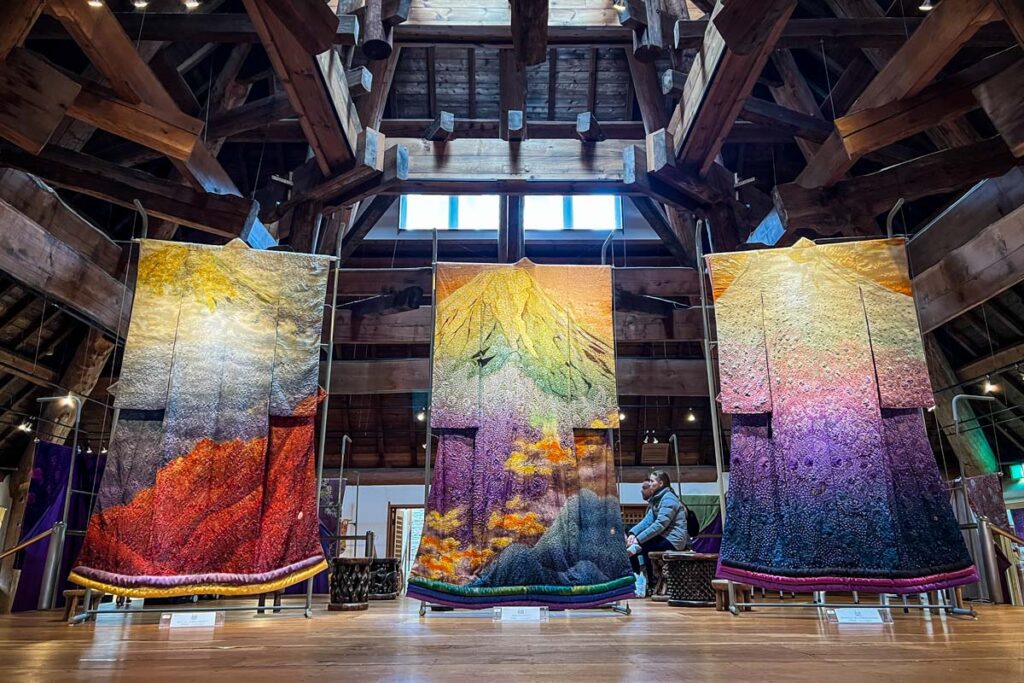
Tucked in the wooded foothills of Mt. Kurodake, just a 5-minute walk from the Momiji Corridor, the Kubota Itchiku Art Museum is a must-see if you have the time.
The museum is the legacy of the celebrated textile artist Kubota Itchiku . Kubota is credited with reviving tsujigahana , a method of silk-dyeing used during the Muromachi Period (1333-1573), and the museum houses his colorful collection of intricately-dyed kimonos .
Not only did Kubota supply the gallery, he also designed the museum itself, as well as its expansive gardens. With Gaudi-inspired architecture , cypress timber, and Okinawan coral and limestone, the buildings blend harmoniously with the natural surroundings.
The Japanese gardens are stunning and well worth exploring. Before you leave, be sure to check out the teahouse, located in Kubota’s former workshop.
We were lucky to be seated right in front of the windows, which look out on a tranquil pond surrounded by mossy rocks and maple trees . We visited on a drizzly day and watched raindrops ripple the water’s surface while we sipped our tea. It was magical .
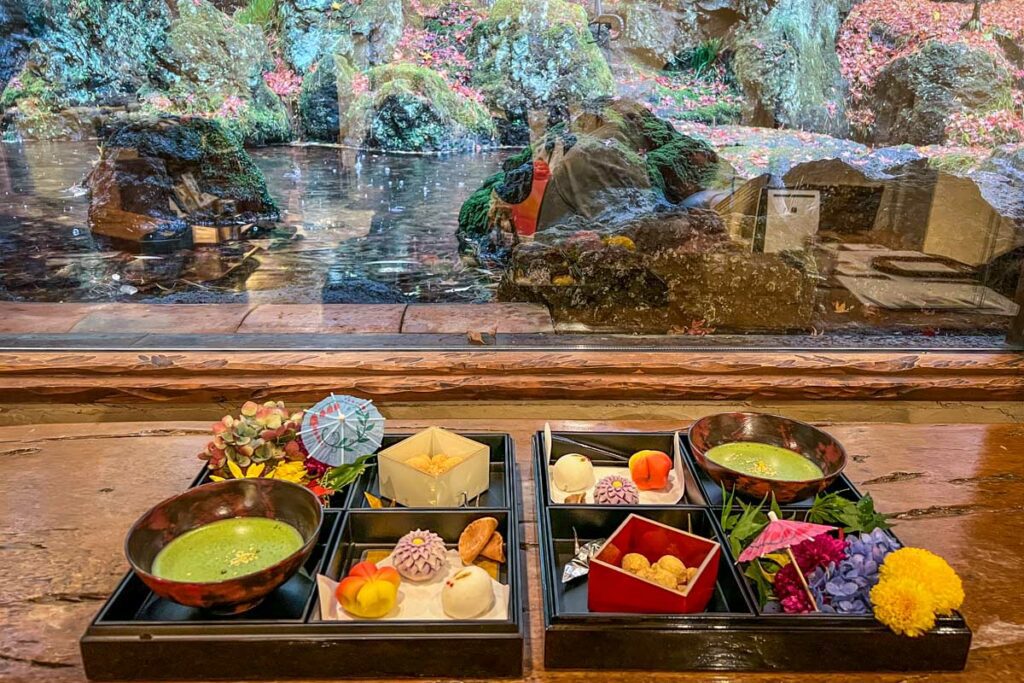
And as if the setting wasn’t perfect enough, the matcha set was the prettiest, most Instagram-worthy I have ever seen. I actually took 46 photos of the tea set alone – no joke. It was a work of art in itself.
- Entry fee: ¥1,300 (~$8.78 USD)
- Hours: 9:30 a.m. – 5:30 p.m. April to November, 10 a.m. – 4:30 p.m. December through March; closed on Tuesdays (except October and November)
8. Get an iconic view from Oishi Park
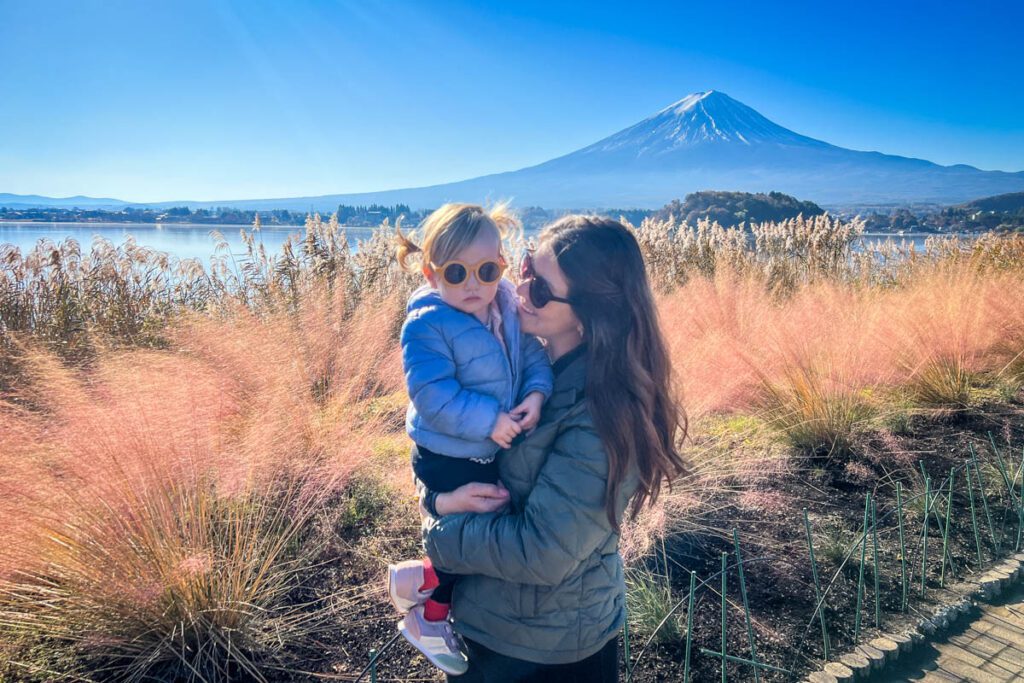
Head back to your car and drive to Oishi Park on the northern shore of Lake Kawaguchiko.
Expect it to be crowded, as this is one of the most popular places to photograph Mount Fuji – and for good reason.
The view is spectacular, with colorful flowers stretching to the edge of the glimmering lake while Mount Fuji towers above .
Known as “Flower Street”, the 350-meter (1,148-foot) path through Oishi Park is bordered on both sides by gardens that display seasonal blooms. The lavender fields in June – July are popular, as well as the rounded kochia bushes that turn bright red in the fall.
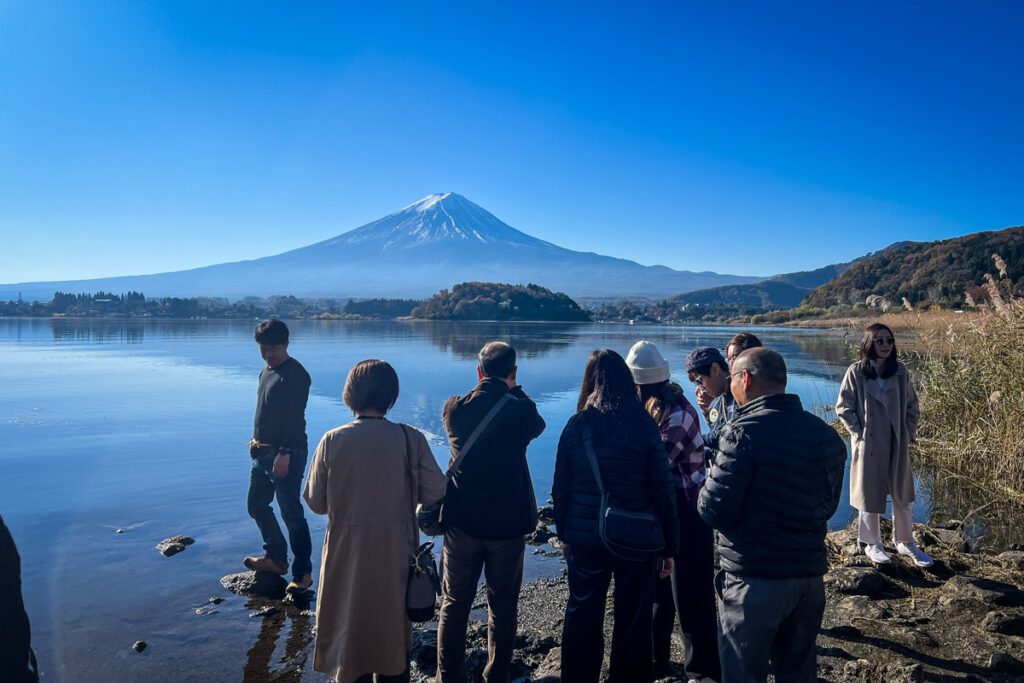
If you’re still feeling overwhelmed about planning a day trip to Mount Fuji, then joining a tour might be the way to go.
With itineraries ranging from 10-12 hours, these guided day trips are long but effective. This is by far the simplest way to ensure you see some of the top attractions in the Fujisan area and still make it back to your Tokyo hotel by bedtime.
- Everything is planned for you , so you don’t need to lift a finger.
- These tours are highly organized to maximize your time .
- You won’t be able to explore at your own pace.
- You’ll be traveling with a large group. (You could see this as a pro – hello, new friends!)
From Tokyo: Mt. Fuji Full-Day Sightseeing Trip
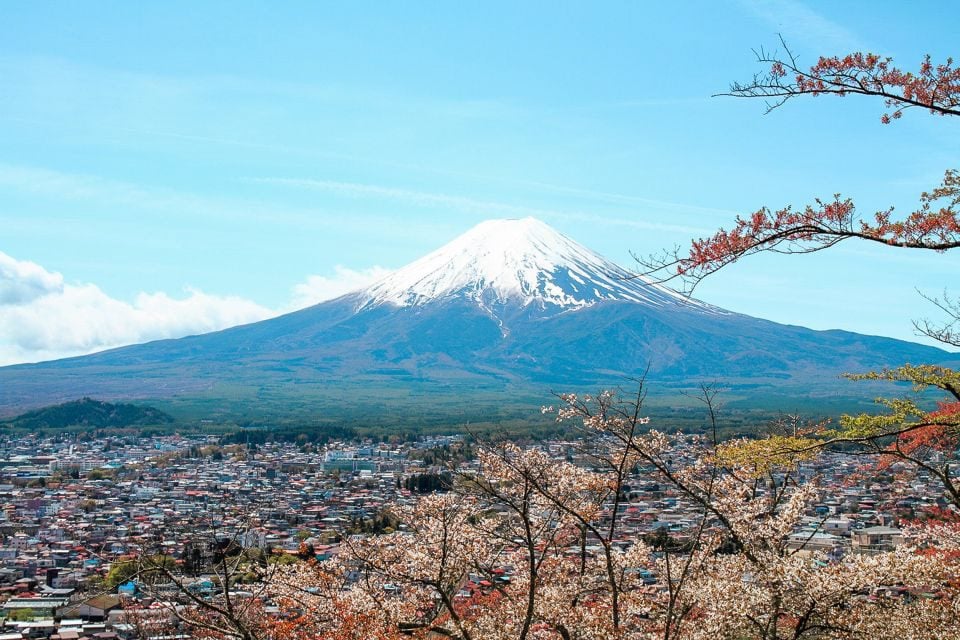
This affordable tour includes a round-trip bus from Tokyo and stops at Lake Kawaguchiko, Arakurayama Sengen Park, Oshino Hakkai, and Mt. Fuji 5th Station (weather permitting).
From Tokyo: Mt. Fuji 5th Station & Lake Kawaguchi Bus Tour
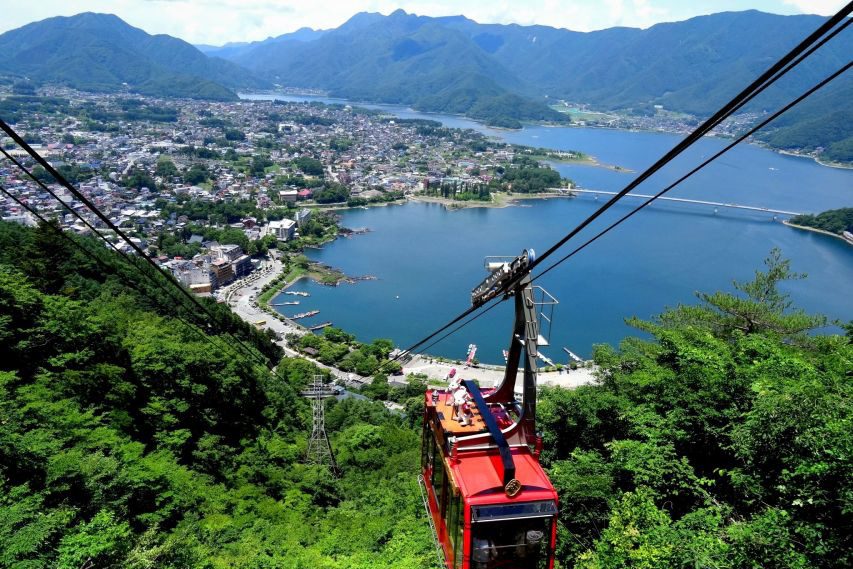
One the most highly-rated guided day trips from Tokyo to Mount Fuji, this tour includes a ride on the Panoramic Ropeway cable car and a scenic boat cruise on Lake Kawaguchiko. You can add lunch at FujiQ Highland for an additional fee.
From Tokyo: Guided Day Trip to Hakone, Owakudani & Mt. Fuji
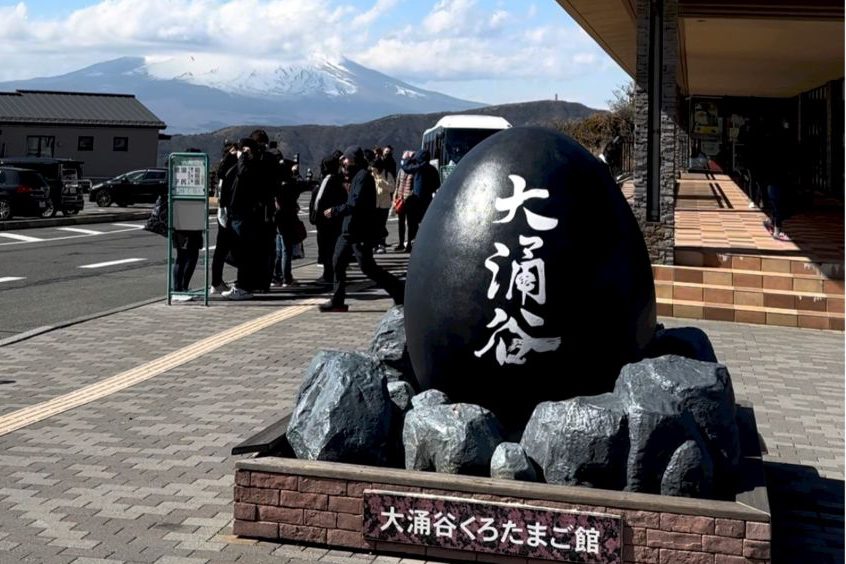
On this popular tour , you’ll cruise Lake Ashi aboard a pirate ship, ride the Hakone Ropeway cable car, and explore Owakudani, an active volcanic landscape of sulfur fumes and hot springs.
Weather permitting, you’ll end your tour at Mt. Fuji 5th Station and Oshino Hakkai, a UNESCO World Heritage Site.
This tour offers an optional lunch for an additional fee.
Facts about Mount Fuji
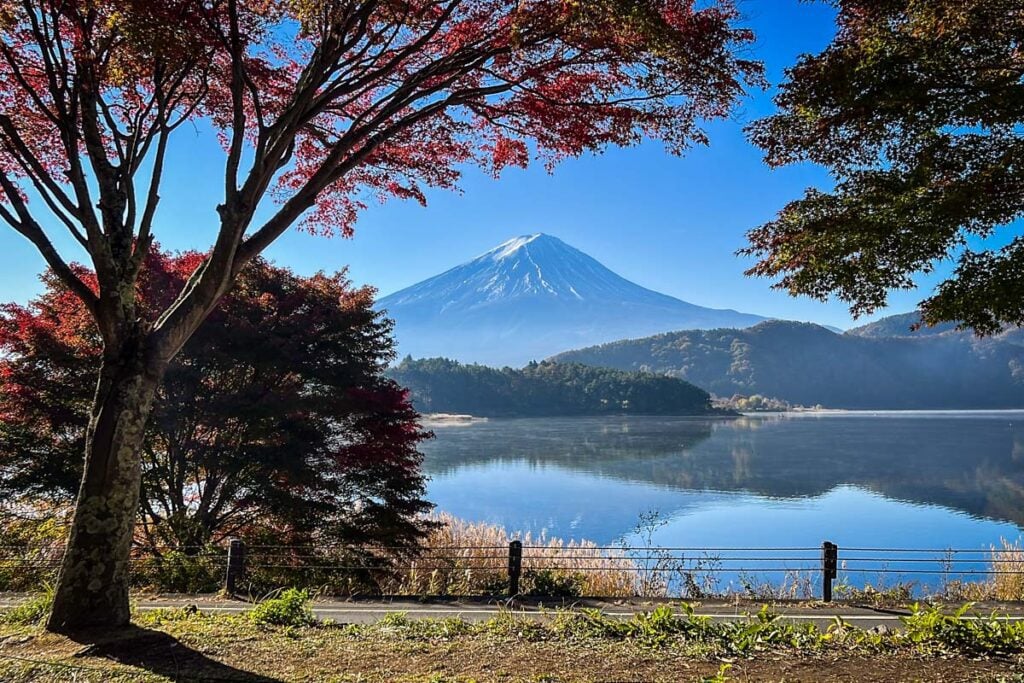
Now that you know your options for a day trip to Mt. Fuji from Tokyo, we thought we’d pump you up with some fun facts about Japan’s most famous mountain . Get ready to have your mind blown!
Essential Facts
- At 3,776 meters (12,388.5 feet), Mount Fuji is Japan’s highest peak . It is also the most climbed mountain in the country, as well as the most depicted in art, poetry, and music.
- Located on the island of Honshu, the mountain straddles Yamanashi and Shizuoka prefectures. It’s the focal point of Fuji-Hakone-Izu National Park and a UNESCO World Heritage Site .
- At its base, Mt. Fuji has a circumference of about 78 miles (125 km).
Scientific Facts
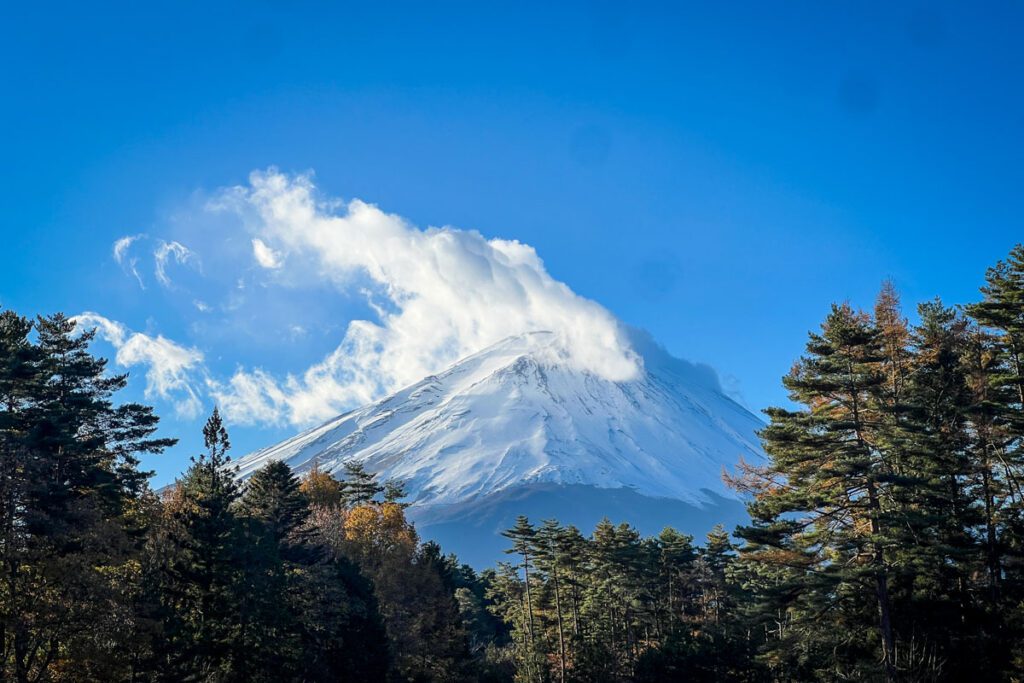
- Mount Fuji is considered an active volcano , even though it hasn’t erupted since the early 1700s. It’s even part of the infamous Ring of Fire , which sees the most volcanic eruptions and earthquakes in the world.
- It’s technically 3 volcanoes stacked on top of each other: Komitake on the bottom, Ko Fuji (Old Fuji) in the middle, and Shin Fuji (New Fuji) on top.
- Mt. Fuji supports a surprising amount of biodiversity, including more than 30 species of mammals such as Asiatic black bears, wild boar, and the Japanese serow.
Historical Facts
- The first person ever recorded to have summited Mount Fuji was a Buddhist monk in 663 AD.
- Until the late 1800s, women were forbidden from climbing Mount Fuji . Tatsu Takayama became the first woman to summit the mountain in 1832, before women were allowed.
- Sir Rutherford Alcock famously became the first foreigner known to have made the climb in 1860.
Cultural Facts
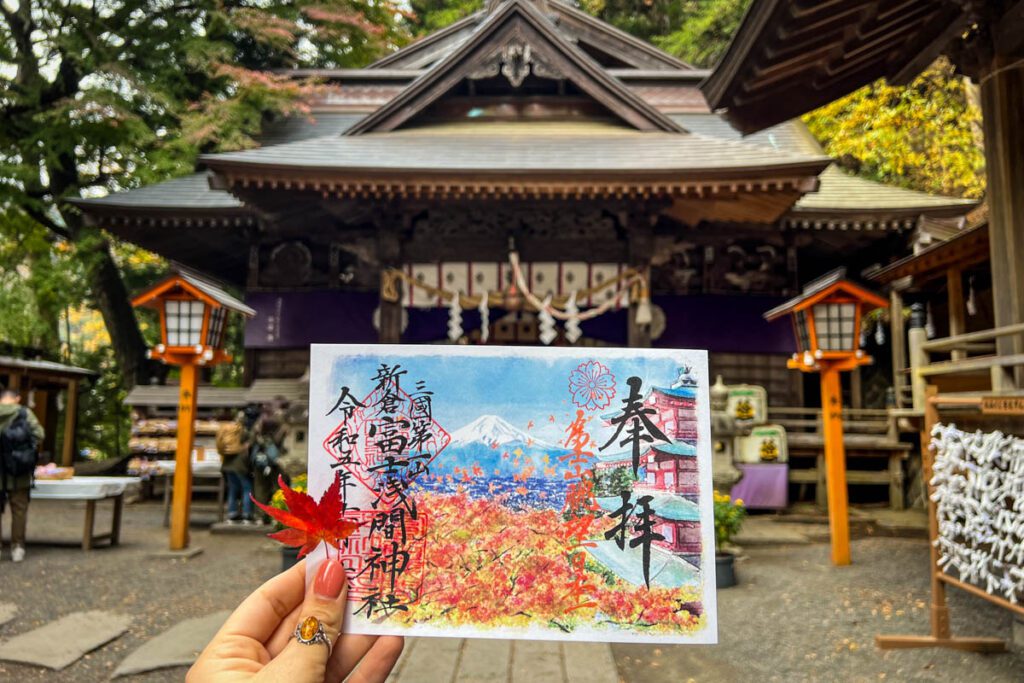
- Mt. Fuji is one of Japan’s three sacred mountains , along with Mount Haku and Mount Tateyama .
- Both major religions in Japan (Shinto and Buddhism) worship the natural symbol of Mount Fuji as a god, whereas its volcanic activity symbolizes earth, sky, and fire.
- Located at the peak, Fujisan Hongu Sengen Taisha is the highest shrine in Japan .
- You can send a postcard that’s actually postmarked from the famed peak, thanks to the Mount Fuji Summit Post Office ! Located—you guessed it—on top of the mountain, the office is open from 6 a.m. to 2 p.m. in the summer months.
- If you forgot to pick up a postcard, no worries – you can send off a quick email because there is WIFI at the summit!
- Hundreds of thousands of people climb Mount Fuji every year.
- The Japanese thing to do is to hike up in the dark and arrive at the peak to watch the sunrise . Poetically, the Japanese even have a word for this exact experience: goraiko (御来光), or “the Great Sunrise at the top of Mt. Fuji”.
Other things to do nearby Mount Fuji if you have the time
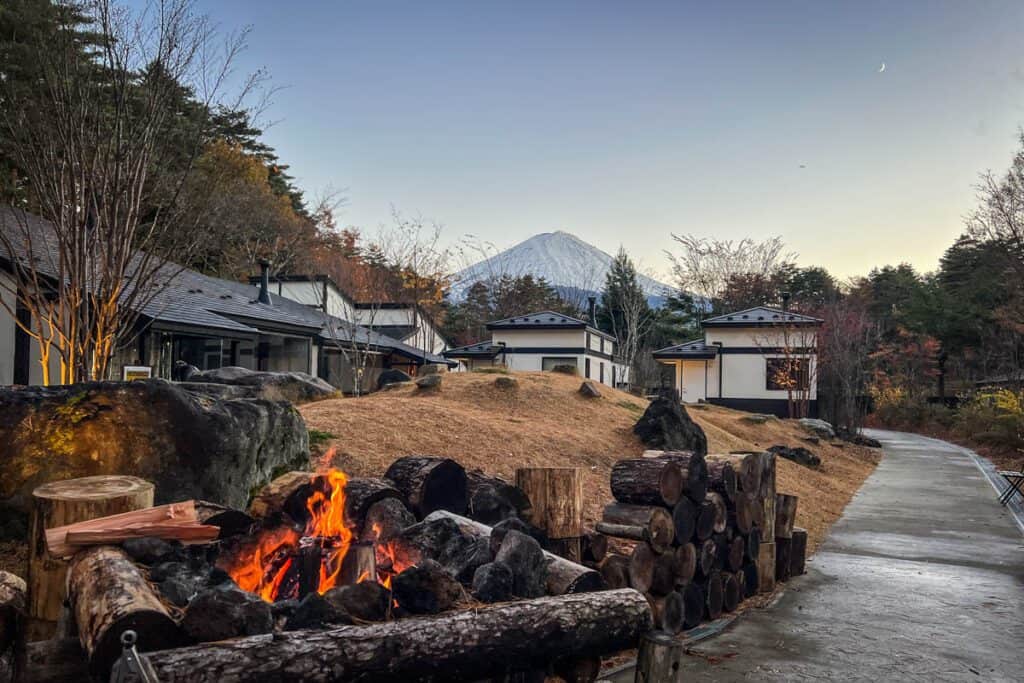
If you decide to extend your day trip and spend more time around Mount Fuji, you’ll find endless things to do in the area. Here are a few recommendations:
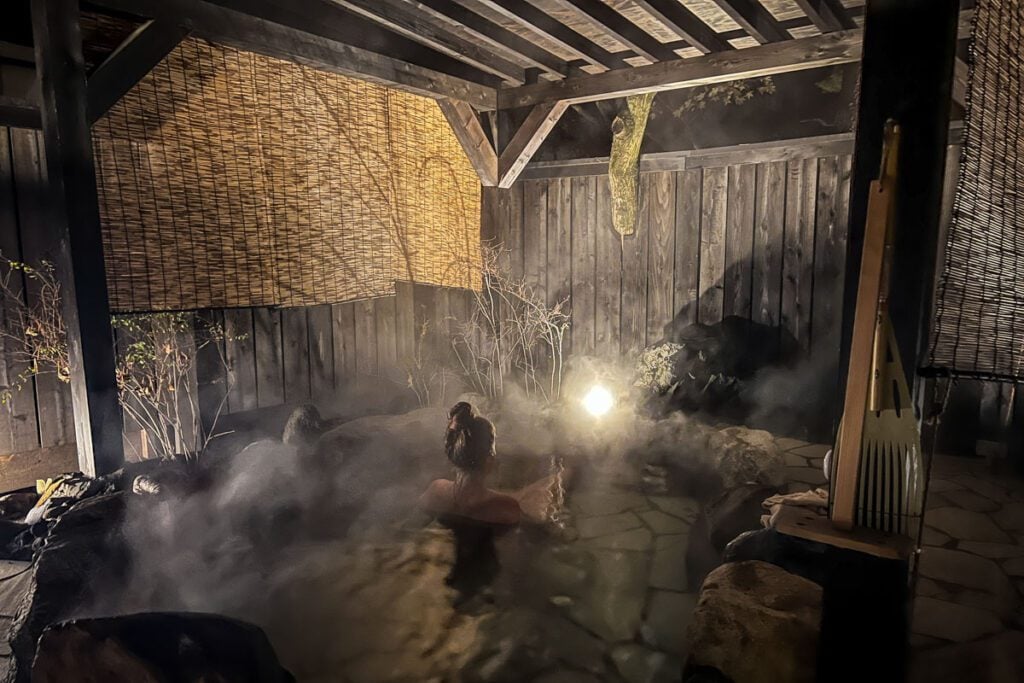
- Stay at one of the many traditional Japanese ryokan . Tip: Look for one that offers a discount with your Hakone Free Pass.
- Enjoy a relaxing soak at Tenzan Onsen , a hot spring village with indoor and outdoor baths in a tranquil natural setting.
- Stroll through a sea of swaying pampas at Sengokuhara Susuki Grass Fields , a dreamy landscape that changes color with the seasons.
- Hike to Hiryu Falls , a two-tiered cascade tucked away in a lush forest.
Kawaguchiko
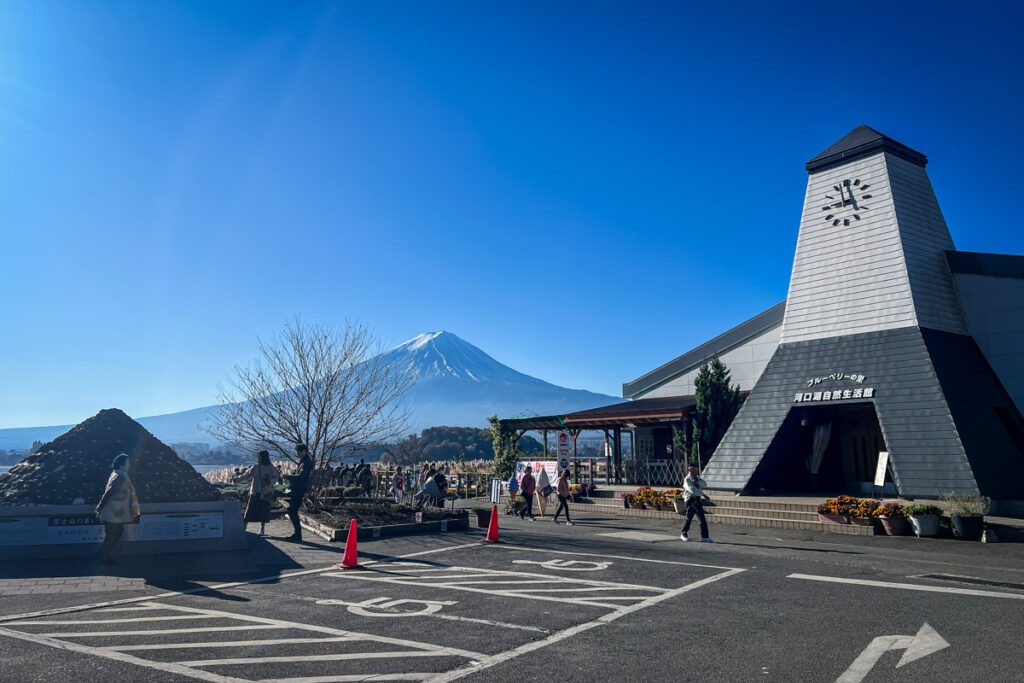
- Go glamping in the Fuji Five Lakes area. We loved our stay at this glampground , which has an incredible view of Mount Fuji.
- Discover the Kawaguchiko Music Forest , a museum that houses antique music boxes and mechanical instruments within beautiful European-style gardens.
- Make your own jam at the Kawaguchiko Natural Living Center in Oishi Park. The center also offers a couple of cafes, a handful of shops, and fruit picking in the summer.
- Get ice cream at Gelateria Angela , a shop known for unique flavors such as chili pepper dark chocolate, charcoal vanilla, and parmigiano reggiano.
Best time to visit Mount Fuji
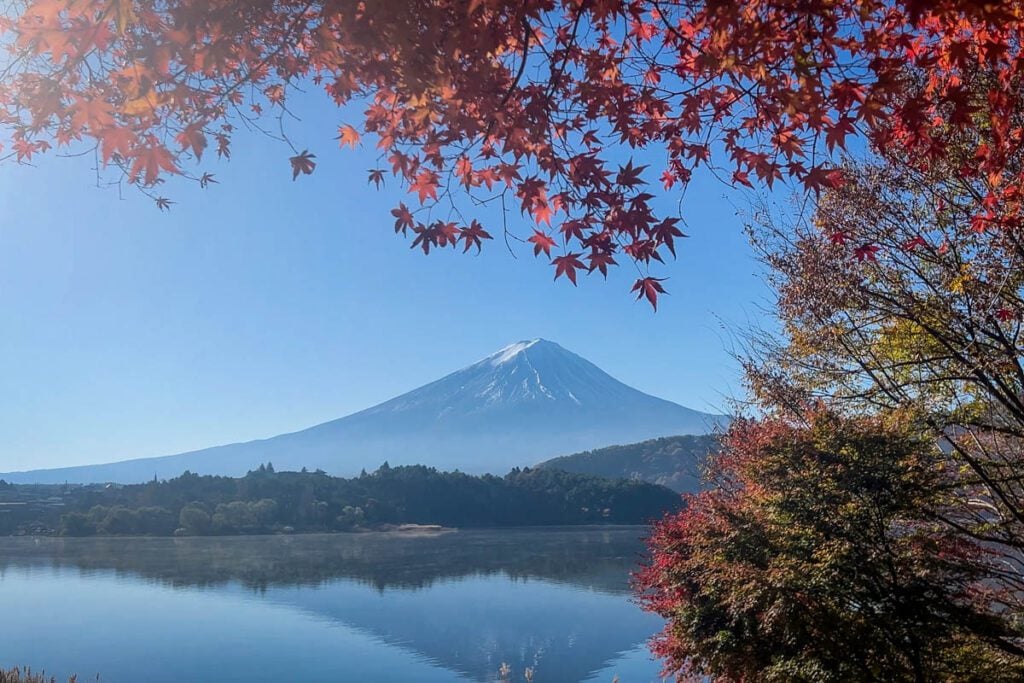
One thing many first-time visitors to Japan may not realize (including us in 2015!) is that Mount Fuji is notoriously shy . There is much of the year where she will stay cloaked behind clouds and haze, only peeking through on rare occasions.
Statistically speaking, you will have the best chance of seeing Mount Fuji between the months of October and February . Conversely, the worst chance of visibility is in July.
That said, nothing is promised when it comes to weather…
Case in point: our first trip to Japan was early February, when we should have had a good chance of seeing Mount Fuji – but all we saw was a wall of white clouds. On the other hand, we’ve known people who have seen Fuji peek out during July and August, supposedly bad months for viewing the mountain.
Our thoughts: We think Mount Fuji is particularly photogenic in autumn, with fall foliage all around and a good chance of seeing the peak covered in a blanket of white after a snow storm.
When to arrive
We recommend starting your day trip to Mount Fuji from Tokyo as early as possible so that you have time to see everything on this itinerary and not feel rushed.
Psst! For more info, check out our guides to the best time to visit Japan and the best time to visit Tokyo .
What to pack for a day trip to Mount Fuji
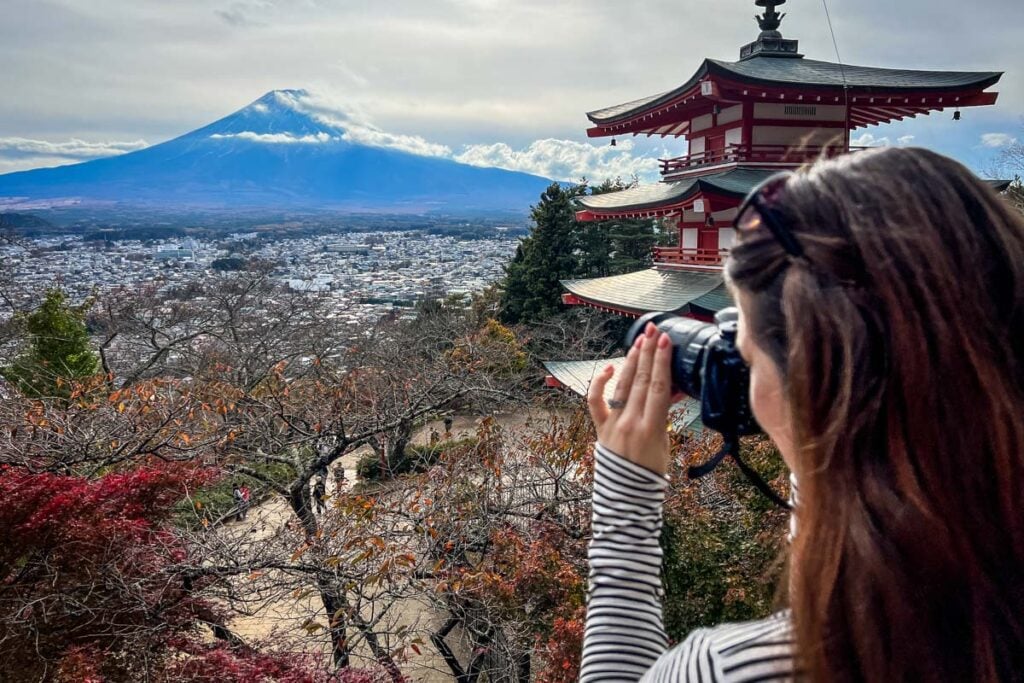
What you’ll need to bring to Mount Fuji will depend on how you get there, when you visit, and what you plan to do. Here are a few universal day trip essentials to get you started:
- Daypack : Having a small backpack will be a good way to carry your belongings.
- Photo equipment : Though smartphones these days have great cameras, this area is world-renowned for photography , so you might want to bring out the big guns.
- Comfortable shoes : Wearing comfy shoes is a must, as you’ll be clocking in lots of steps.
Be sure to check out these super handy guides full of packing hacks and tips for traveling in Japan that you won’t find anywhere else:
- Our Japan packing guide lists all the essentials (many of which you might not think about), as well as what you should NOT pack for a trip to Japan.
- This article on what to wear in Japan will help you create a perfect capsule wardrobe for every season and let you in on some cultural taboos so you can be sure to dress appropriately.
- With this FREE Japan packing list PDF download , we’ll send checklists straight to your inbox for everything from clothing and toiletries (for both women and men!) to what shoes to pack and extra stuff you may want to have on-hand just in case. Click the image below to get your free copy!
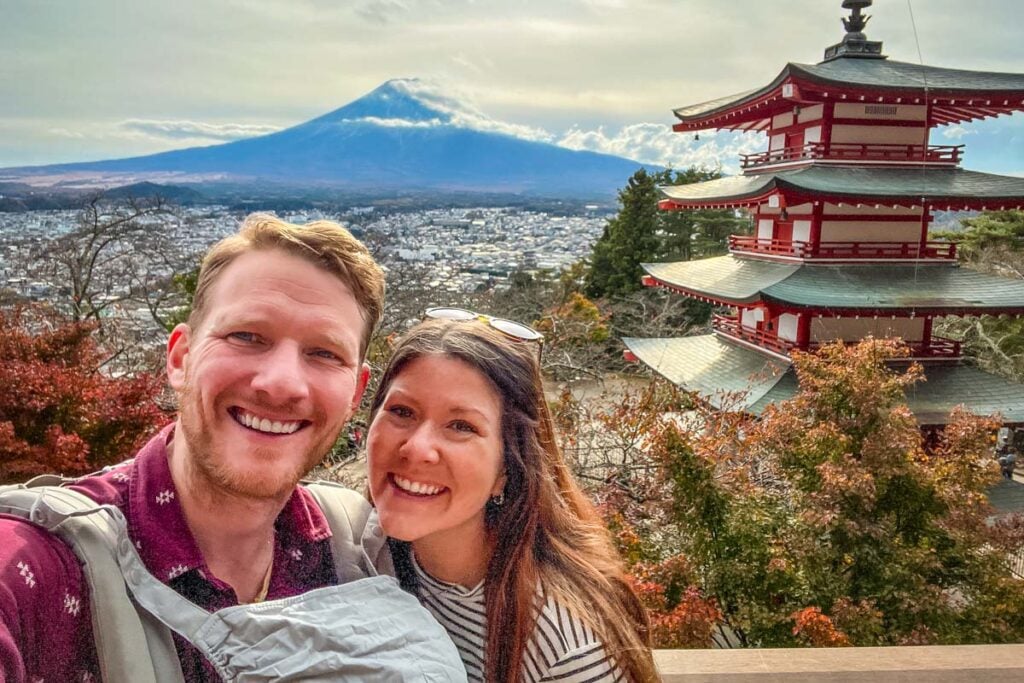
Still have questions about visiting Mount Fuji? We’ve answered some common questions below. If you don’t see what you’re looking for, ask us in the comment section at the end of this article and we will do our best to get back to you!
Can Mt. Fuji be a day trip from Tokyo?
The short answer is yes, you can visit Mount Fuji as a day trip from Tokyo .
However, we highly recommend spending more time in the area if you can manage.
There are lots of unique accommodations, from onsen ryokans in Hakone to glamping in Kawaguchiko. Plus, you’ll have more chances to see the mountain in case you get unlucky with the weather!
Is a Mount Fuji day trip worth it?
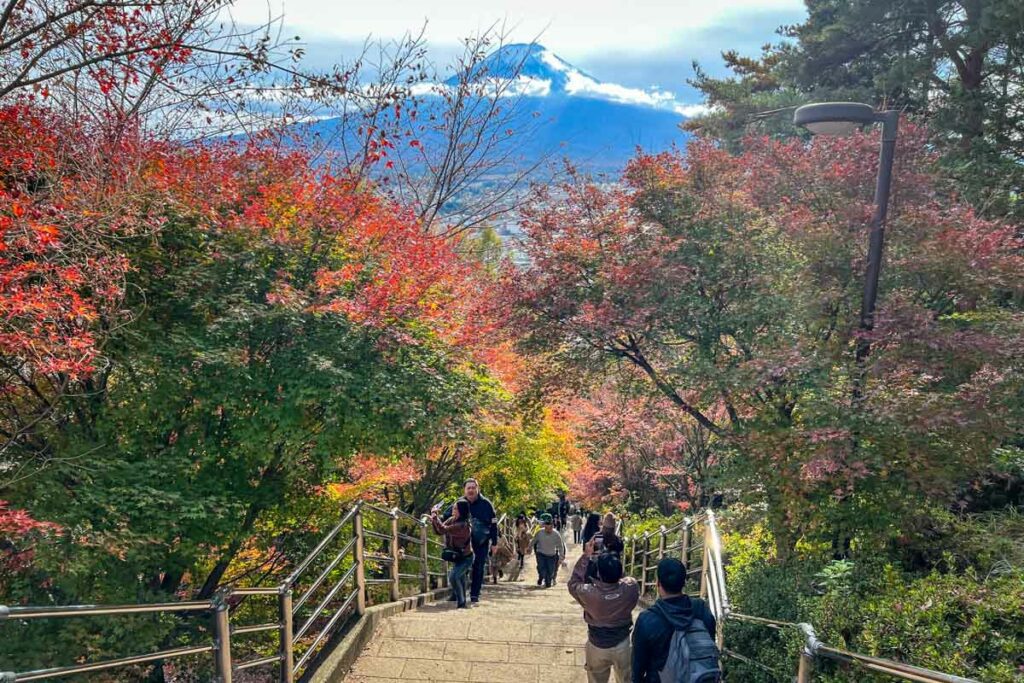
This kind of depends on two things: the weather, and your attitude.
If you get lucky with clear skies, then taking a day trip to Mount Fuji is one of the best things you can do in Japan , hands-down.
But if the notoriously shy mountain is hiding in the clouds… well, the word disappointed didn’t seem strong enough when this happened to us on our first trip to Japan.
My best advice would be to manage your expectations, and to have a couple of ideas for fun backup activities in case Mount Fuji is not visible. That way, you can still enjoy the area even if you don’t get to see the mountain. Trust me, there’s a lot to love about this part of Japan!
What is the best way to see Mount Fuji?
There are a few ways to go about catching a glimpse of the famous Mount Fuji.
The best choice for yourself will depend on several factors, such as your travel style, how much time you have, and whether or not you’re renting a car in Japan .
Can I use the JR Pass to get to Mt. Fuji?
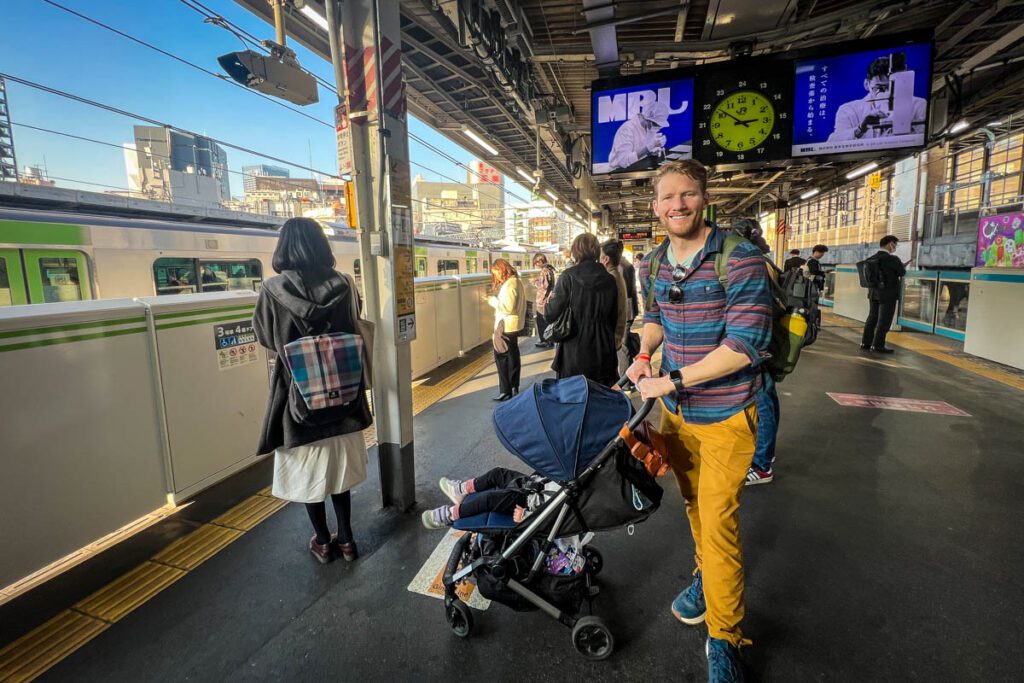
The Hakone region is not covered by the JR Pass . You’ll need to purchase the Hakone Free Pass or individual tickets for this day trip.
Psst! We have a detailed guide that answers all your questions about the Japan Rail Pass , including how to get it, how to use it, how much it costs, and whether it will be worth it for your trip.
How much is the train ticket from Tokyo to Fuji?
The Hakone Free Pass ($42-45 USD for a 2-day or 3-day pass) includes round-trip travel from Shinjuku Station to Hakone on the regular Odakyu Line, as well as 5 different modes of transportation within Hakone.
Without the pass, the same trip would only cost about $17 USD; however, you would then have to pay for all your transportation in Hakone on top of that. Not only could it end up costing more depending on what you do, but you’d also have to worry about getting individual tickets for everything.
Trust me on this one – the Hakone Free Pass is worth it!
How long is the bullet train from Tokyo to Mount Fuji?
It takes around 2 hours to get to Hakone from Shinjuku Station on the regular train, or about 80 minutes on the express train. There’s no direct Shinkansen from Tokyo to Hakone .
When did Mount Fuji last erupt?
The last confirmed eruption of Mount Fuji was recorded on December 16, 1707 .
Can tourists climb Mount Fuji?
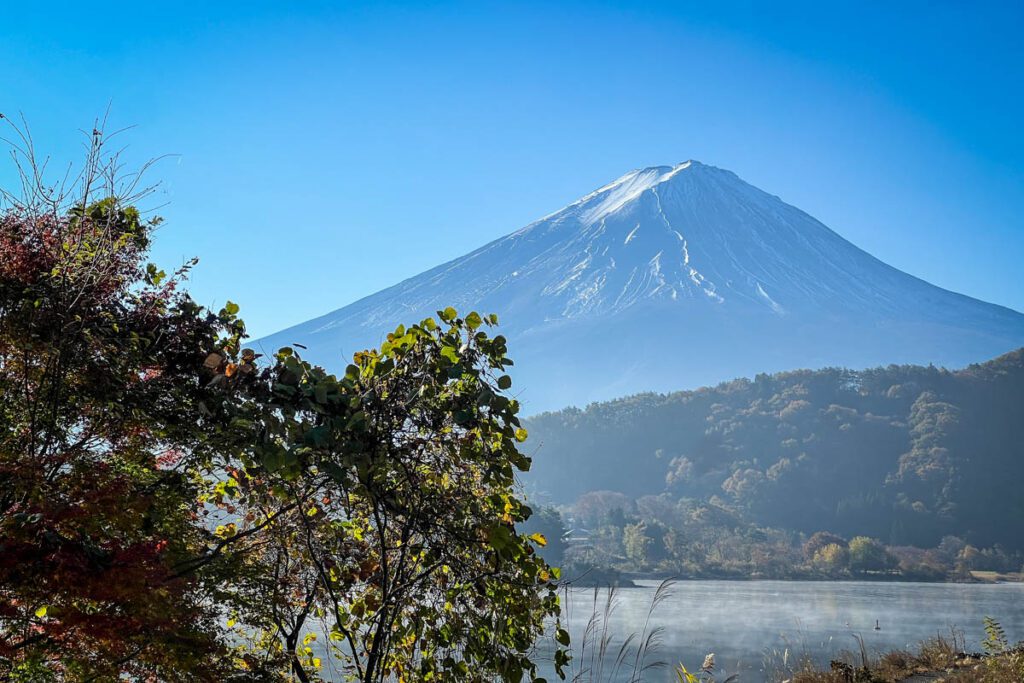
Yes, tourists are welcome to climb Mount Fuji . However, overcrowding in recent years has led the Japanese government to impose new restrictions.
Starting July 1, 2024, the number of tourists allowed to hike the mountain will be capped at 4,000 per day . Currently, the short July-to-September season sees more than 200,000 climbers (both locals and visitors) each year.
Foreign climbers will also be required under the new regulations to pay an entry fee of ¥2,000 per person (about $13.50 USD) . The trails will also be supervised to ensure safe and responsible behavior among hikers.
More resources for traveling in Japan
We have TONS of resources on travel in Japan and destinations throughout the country. Check out our Ultimate Japan Travel Guide for all the answers to your most burning questions, or read some of our favorite articles below!
- Best Time to Visit Japan: When to Go & When to Avoid
- Japan Rail Pass: Where to Buy & Is It Worthwhile?
- Renting a Car in Japan: Essential Driving Tips You Need to Know!
- Japan Travel Cost: Exactly How Much is a Trip to Japan?
- One Week in Japan: Best Itinerary for Your First Visit
- Expert Tips for Visiting Japan (Dos and Dont’s!)
- Japan Pocket Wifi vs. Japanese SIM Card: Review & Comparison
- Best Japan Travel Apps
- Foods to Eat in Japan: Guide to Japanese Cuisine
- Helpful Japanese Words & Phrases to Know for Traveling in Japan
Save this article on Pinterest for later!

We want to hear from you!
Have you ever seen Mount Fuji in person? Do you still have questions taking a Mt. Fuji day trip after reading this article? Leave us a comment below and we’ll do our best to get back to you!
Leave a Reply Cancel reply
Your email address will not be published. Required fields are marked *
Save my name, email, and website in this browser for the next time I comment.
- Itineraries
- Tours and Activities
- Travel Guides
- Best of Japan
JRailPass.com » Japan Travel Blog » Mount Fuji from Tokyo: Day trip itinerary
Mount Fuji from Tokyo: Day trip itinerary
November 8, 2022
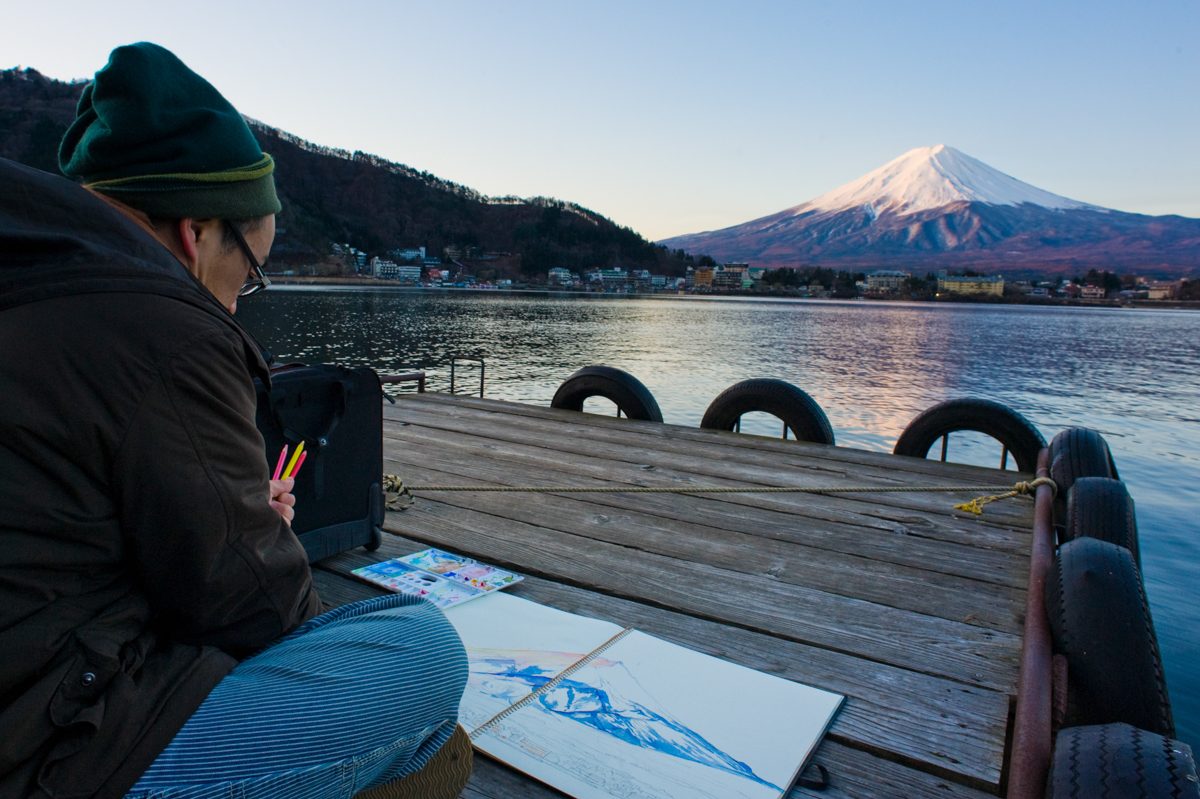
A day-trip from Tokyo to Mount Fuji and the lesser-known Hakone five lakes area is among the favorite experiences of many travelers to Japan, so here is our guide on how to visit this famous landmark with the Japan Rail Pass. Whether you prefer climbing or a more relaxed pace, we have the perfect guide for you make the most out of this trip!
Let’s start with some interesting facts about Fuji-san : Mt Fuji is not only the highest mountain ( 3.776 meters) , and Japan’s most climbed and depicted one, but it is also the pure representation of good luck and good fortune for all Japanese citizens. This is a curious fact, considering the mountain is actually a giant volcano.
Nevertheless, what is even more fascinating is that it is not a single volcano. It is part of three volcanoes, one on top of the other. The bottom one is Komitake volcano, and the second layer is Kofuji, while Fuji is the youngest of all three. Although officially classified as active, it has a very low eruption risk, since it was last active in 1708.
Interesting fact: Did you know that Mount Fuji is part of the Fuji-Hakone-Izu National Park , located less than 100 kilometers away from Japan’s capital?
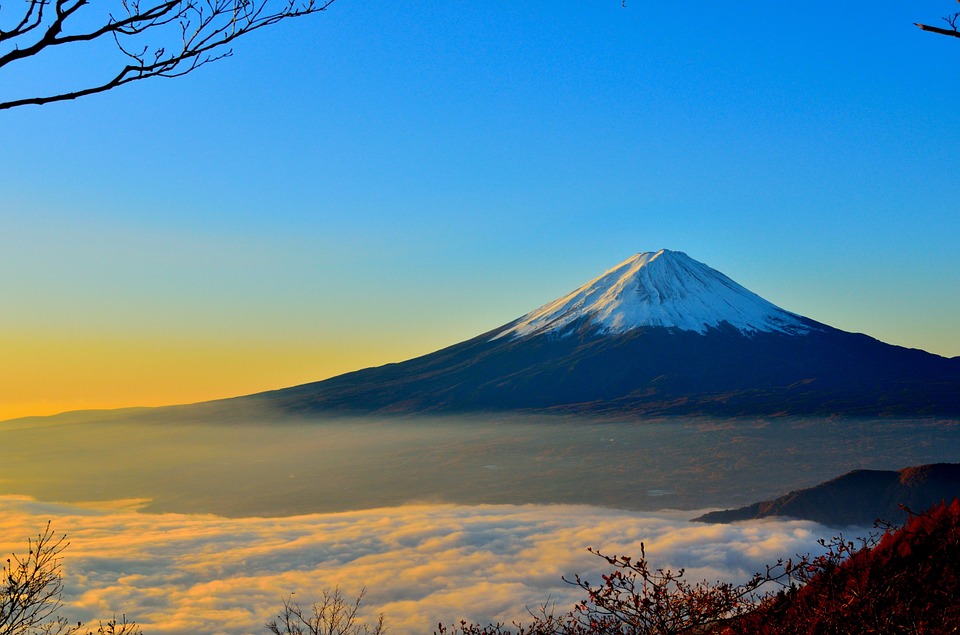
Climbing Mount Fuji
All travelers eager to climb the top of Mount Fuji must bear in mind that the climbing season lasts from July until September . During summer all hiking trails are open.
In any other period, trails and mountain huts will be closed, so it can be very dangerous for anyone to attempt climbing on their own.
Also read: Mount Fuji climbing guide
To climb Mount Fuji, there are four Fuji trails, which will take you to the mountaintop:
- Yoshida trail – 2,300m (altitude of head trail)
- Subashiri trail – 2,000m
- Gotemba trail – 1,450m
- Fujinomiya trail – 2,400m
All trails can be accessed via a mountain bus, taking passengers from one of the five 5th stations (although they are all named 5th station, these are different stations ), with the Fuji Subaru Line 5th Station, at Yoshida trail, being the most popular one.

Tokyo to Mount Fuji via Gotemba
Apart from the Yoshida trail, the Gotemba trail is one of the most popular routes among visitors. Travel time by train is a little over 2 hours from Tokyo. To get there:
- Take JR Tokaido line for Kozu from Tokyo Station, using your JR Pass
- Once at Kozu (Kanagawa), take the JR Gotemba Line for Numazu
- Get off at Gotemba Station | final destination

Note: The Hyperdia screenshot shows you a detailed description of a journey example with pre-selected departure time and date. Note that the train trip will be free of charge for all Japan Rail Pass holders. The displayed price is only valid for passengers with no JR pass.
Once at Gotemba station, take a bus to Subashiri 5th station , the gateway to climbing Mount Fuji. The bus operated by Fujikyu to reach the Gotemba climbing route. A one-way bus journey is about an hour long, at the cost of 1.540 yen (round trips are 2.060 yen).
Please note that Fujikyu is not part of the Japan Rail Group, which means the Japan Rail Pass does not cover buses ran by this company , and no seat reservations are available .
Note: During the climbing season, buses operate differently in comparison to the off-season. For more detailed information and timetables, please check with the local operator. [banner-en]
Mount Fuji from the Shinkansen trains
Summer is also the time when Mount Fuji can be clearly seen from a Shinkansen train leaving Tokyo towards Nagoya – Osaka – Kyoto. The window view is impressive – make sure to reserve your D or E seat (C or D in Green Cars ), which is the right side from Tokyo, left side from Kyoto .
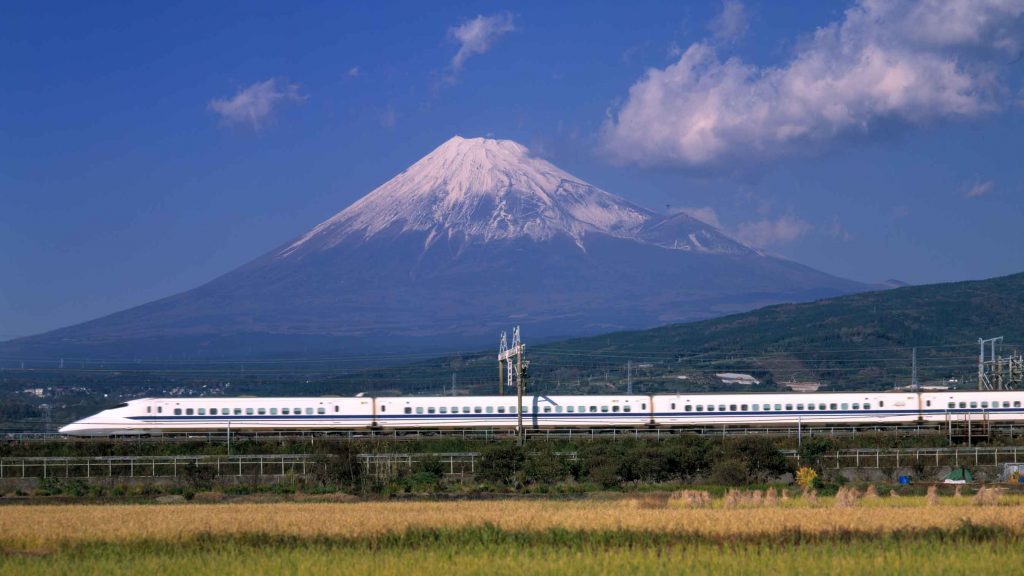
What to see in the Mount Fuji area
As we have already mentioned, Mount Fuji forms part of the Fuji-Hakone-Izu National Park. Hakone is one of the most popular destinations for tourists, located less than 100 km. from the capital city of Japan.
Famous for its scenic area, Ashi lake , hot springs and breathtaking views of Mount Fuji, Hakone is more than worth the visit.
Please check our new Hakone guide for more information on visiting the area.

Best time to visit Mount Fuji and its area
Also, please remember that the best time to visit any of these places is the hiking (summer) season , from July to mid-September . These are the months that promise sunshine, good weather, and fantastic views.
Unfortunately, travelers who decide to make this trip in October or March may not be able to enjoy the area’s scenery fully due to heavy rains or clouded mountain peaks.
Tokyo to Hakone with the JR Pass
Here’s how to get from Tokyo to Hakone with the bullet train :
- Take the Tokaido Shinkansen (Kodama and some Hikari trains, please check) from Tokyo Station (covered by the Japan Rail Pass)
- Get off at Odawara station
- Take the Hakone Tozan train for Hakone-Yumoto (not covered by JR)
- Get off at Hakone-Itabashi. This is your final destination.
Also very popular among the locals are Fujigoko or Fuji’s Five Lakes , which are located in the northern area of Mount Fuji.
Tokyo to Fuji Five Lakes
Kawaguchiko (or lake Kawaguchi) , Saiko, Yamanakako, Shojiko, and Motosuko are the Fuji Five Lakes. Each of them offers unforgettable views and outdoor activities, including fishing, hiking, and camping. Most hotels in the area are located close to the five lakes too.
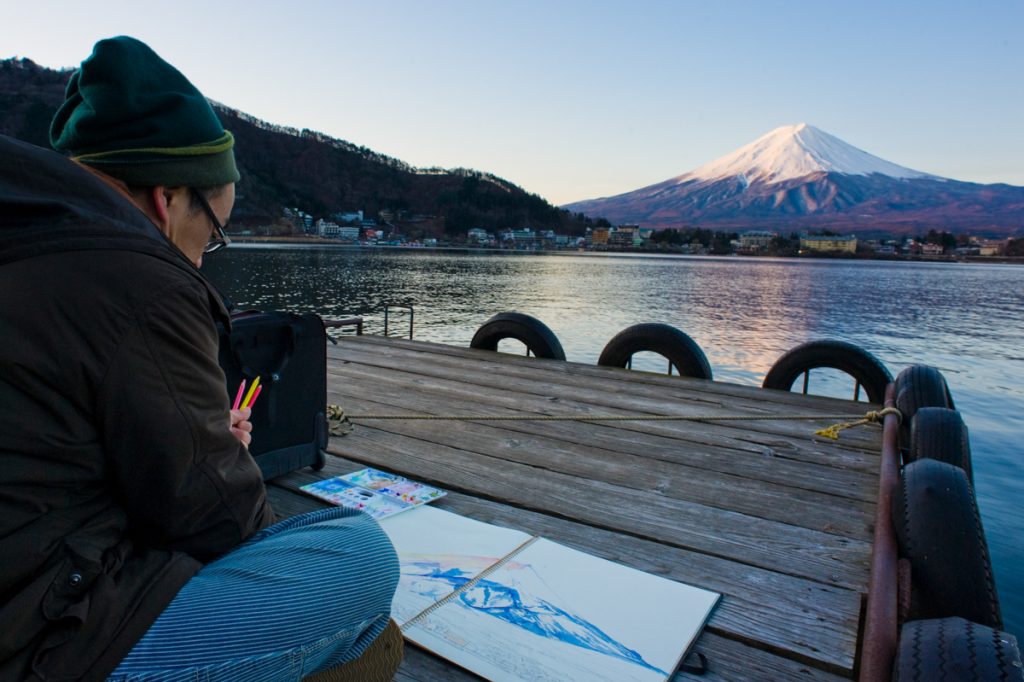
To get to the Fuji Five Lakes:
- Take the JR Chuo Line from Shinjuku Station (Tokyo) to Otsuki Station (Azusa trains, covered by the JR Pass).
- Once at Otsuki, take Fujikyu Railway to Kawaguchiko Station (not covered by the JR Pass).
Kyoto and Osaka to Hakone
Some travelers prefer to visit the area coming from the Kansai region (Osaka and Kyoto). Here’s how to get there from the west with a bullet train :
- Take the Tokaido Shinkansen (Kodama and some Hikari trains, please check) from Kyoto Station or Shin-Osaka station (covered by the Japan Rail Pass)
- Take the Hakone Tozan train for Hakone-Yumoto Station (not covered by JR)
- Get off at Hakone-Itabashi Station. This is your final destination and the gateway for the Mount Fuji area.
Related posts
Related tours & activities.
Pirate Ship Dows the JR pass cover access to the pirate ship on the lake?
Thanks Walid
No, sorry. The Pirate Ship is owned by a private company and is not covered by the JR Pass.
Happy travels!
HI, we are traveling from Tokyo to Kyoto and will use the JR pass. We would love to stop in Hakone on our way, and make a 1/2 day visit to see Mt. Fuji close up. I have been able to find directions on how to get from Tokyo to Hakone, but have NOT found how to get from Hakone to Kyoto, and if there are times I need to be aware of before there no more trains to catch late in the day. Thanks!
Hi Ana! We recommend you to read our Hakone travel guide: Access and what to do article. There you will find all the details on how to travel from Hakone to Kyoto 😉 Happy travels!
Not sure if this is JR rail pass? Does your 14 day tour that you have advertised are the trains all covered by the JR rail pass for this trip
KYOTO to FUKUOKA
I would like to take the JR Pass from Kyoto to Fukuoka. I don’t seem to find any train information on that route. Are trains going from Kyoto to Fukuoka and can I use my 7 day Pass? THANKS
Yes, you can go from Kyoto Station to Hakata Station in Fukuoka using your 7-day JR Pass. Please check our Fukuoka guide for further information on the itinerary.
Pls. let me know which train do I need for the following : 1. Roundtrip ticket train from Tokyo to Mt Fuji and which train station should we get off when reach MtFuji. 2. Do we need any transportation in order to reach 5th station 5? 3. Roundtrip ticket train from Tokyo to Kyoto?
Hi Christie! All the details regarding reaching Mount Fuji are detailed in this article you are commenting, we encourage you to carefully read it. Getting from Tokyo to Kyoto with the Japan Rail Pass is easy. You should take the Shinkansen Hikari bullet train from either Tokyo Station or Shinagawa Station in central Tokyo, and arrive at Kyoto Station.
Hi there! Me and my wife is going to japan on October 9 for 14 days and I am plan to get a 14 days JR pass, my 1st trip to Japan,, can’t wait for it.. Landing at Narita International Airport Day 1 – Arriving at Narita 11:30 am planning to stay in Shibuya or Shinjuku (afternoon Tokyo sightseeing) Day 2 – Day trip Kamakura passing by ONODEN Day 3 – Day trip Central Nikko & Okunikko Day 4 – Day trip Hakone & Mt. fuji Day 5 – Move to Takayama and explore Takayama Day 6 – Day trip to Shirakawago and Kanazawa Day 7 – Move to Kyoto Day 8 – Day trip to Arashiyama Day 9 – Day trip to OASAK Day 10 – Day trip to Nara Day 11 – In Kyoto the whole day and back to Tokyo on Night Train Day 12 – Tokyo East Side Day 13 – Free time (still planning) Day 14 – Depart Narita @ 13:10 Kind of very tight on the schedule , Is the 14 day JR pass worth on our trip? Thanks a lot and more power!
Hi Abraham! Since you are travelling around the whole country and given your itinerary, the 14-day Japan Rail Pass pays off. Enjoy your stay!
Hi, I’ll be visiting Tokyo and Osaka by mid-November 2018 and would like to pay a visit to Mt.Fuji. I would like to have an experience go by bullet train. I planning to purchase JR pass. Is there any bullet train for: 1. Tokyo to Osaka (Return) 2. Tokyo to Mt. Fuji Look forward to your reply. Thanks
Hi Jovi Ong! Getting from Tokyo to Kyoto with the Japan Rail Pass is easy. You should take the Shinkansen Hikari train from either Tokyo Station or Shinagawa Station in central Tokyo, and arrive at Kyoto Station. This line is fully included in your Japan Rail Pass . Regarding how to get to Mount Fuji, the itinerary is partially covered by the pass. This article you are commenting has all the details 😉 please check carefully.
We are traveling 12 days in Japan, from Narita airport to Tokyo to Nagana to Kyoto and Mount Koyasan to Osaka to Hiroshima and Miyajima then fly to Okinawa and then go to Tokyo and Mount Fuji. Do you suggest Japan Rail Pass, or JR East or JR West 4 day or 7 day pass? Thank you for any help. We leave July 23. We want to also go to Universal in Tokyo.
Hi Cindy! The nation-wide Japan Rail Pass is the only pass that will allow you travel along the whole country. Should you want a pass to travel to all mentioned locations it would be adviceable to go for the Japan Rail Pass.
Hello there – I will be In Japan for 9 days only, below is my travel itinerary, I need advise how best to utilise and activate my 7-days JR pass so I can use it for the Narita Express on my departure on my last day as well, any tips and realistic advise is truly and highly appreciated:
* Day 1-3: arriving Fukuoka Airport and stay in Fukuoka for 4 days * Day 4-5: travelling from Fukuoka to Osaka and stay in Osaka for 3 days * Day 6: travelling from Osaka to Tokyo and stay in Tokyo for 4 days * Day 9: departing Japan from Narita Airport
Questions that need your expert advise pls: 1. I would love to visit Mount Fuji (but not climbing, only to view, I believe can be done so at either the Lakes or Hakone (?)), shall I go to Mount Fuji from Hakata (during my Fukuoka stay) or Tokyo (during my Tokyo stay) or Osaka (during my Osaka stay)?
2. Is there a night train from “Hakata to Osaka” and “Osaka to Tokyo”? If not, what is the best way/timing to travel in these routes pls?
3. Is it better to do the Kimono/traditional photoshoots in Tokyo Asakusa or Osaka?
4. Heard that the “TOEI Animation Gallery” has closed down already, is there any place that we can see most animation-related stuff esp. Naruto and Dragonball pls?
5. Can we visit the Ghibli Museum & J-World Tokyo on the same day pls?
I would really appreciate any advise/suggestion/recommendation you can provide me with esp. utilising the 7-day JR pass.
Thanks again and awaiting your soonest reply. Labe
Hi I would like to ask about coin lockers at Numazu Station, our itinerary would be:
Checkout at Tokyo, travel to Mt Fuji Day Trip at Mt Fuji Travel to Osaka
This would be possible if we could leave our baggages at coin lockers. Are there any coin lockers at Numazu Station? Thank you very much!!!
Hi we are planning on a trip from Tokyo to Mt Fuji for the night and then to Kyoto. We have the 7 day pass, how do we go about doing that?
Hi Bronislava! In this article you can read all about travelling between Tokyo and the Mount Fuji. Should you want to move afterwards to Kyoto, as specified also in this article, you can do so in the Tokaido Shinkansen .
Hi, I plan to visit Mt Fuji , the five Lakes on 17 June 2018 for a day trip. Then,how do i go to Kyoto after that ? Your kind advice is much appreciated. Thank you very much.
Hi Carol! Should you want to move afterwards to Kyoto, as specified also in this article, you can do so in the Tokaido Shinkansen. It is also included in your Japan Rail Pass .
We want to stop by mount Fuji on the way to Kyoto. We are wondering if there is any large size coin locker to deposit our luggage at the Gotemba or Kozu station? Any other thought about how to handle the luggage would also be appreciated.
Is the JR rail the only way to get to mount fuji? I am considering to get the metro ticket for my stay in tokyo, but i am not sure if it is sufficient or not. Would love to hear from advise on it!
Hi Joyce! Please note Mount Fuji and its area are not part of Tokyo metro. Should you want to reach Mount Fuji you will have to consider purchasing other types of ticket.
Hi JRPass Team. We are arriving Tokyo, Narita airport on May 28 late afternoon. for 10 days. Of course we wil buy JR Pass for 7 days. On our arrival to Narita to our accommodation to Urayasu-shi, Chiba-ken, Todaijima we do not want to use yet our JR Pass instead we will buy one off ticket to get into our accommodation. OUr itinerary 1st day – Narita airport to Urayusu-shi, Chiba Ken for accommodation apartment in Urayusu-shi 2nd day – Disneyland (will buy ticket goin to disneyland) – any idea how much 3rd day – Disney Sea (will buy ticket goin to disneysea- any idea how much 4th day – Activate our 7 days JR Pass from this day. Tokyo city centre for Mt Fuji tour, JR Pass 5th day – Tokyo-kyoto-nara-tokyo or should we go tokyo-Kyoto-nara-osaka(stay overnight)-is this a long long trip 6th day – Tokyo-Osaka 7th day – Osaka back to Tokyo 8th day – tokyo sightseeing 9th day- tokyo sightseeing 10th day – 7th day of JR Pass from Urayusu-shi to Narita airport for departure. Lastly when is the best time to buy JR Pass online, our departure is May 28, 2018. How long does it take delivery from mail. Thank you and looking forward to have this once in a lifetime experience in Japan.
If you get your Japan Rail Pass from http://www.jrailpass.com the standard delivery time varies between 24 and 48 hours. However, the exact delivery time will depend on the customer’s location, time of order, public holidays as well as customs problems and/or ground/air transportation disruption. The estimated maximum delivery time is 72 hours.
Enjoy your trip!
hi, My family of 3 adults and 2 kids will arrive in Haneda on the 14 April ard midnight. Our apt is near Hirai Station. Our itinerary as follows: D1- Tokyo (15 April 2018) D2-Disneyland D3-Mount Fuji/ Lake Kawaguchi/Tokyo Skytree D4- Day trip to Tateyama Kurobe Alpine Route-Nagago-Toyama D5- Tokyo/Tsukiji/Tokyo D6- Day trip to Shikarawago ? open option on this D7- Tokyo-Haneda (21 April)
I got two questions? 1- Can I use the JRPass immediately when i arrive and still can be use when we going back to Haneda on the 21 April at 7pm. 2-Your opinion on my itinerary
Hi Khairul!
The Japan Rail Pass validity period is calculated in days, not in hours. Therefore, if you have purchased a 8-day pass and your activation date (when you first use the pass) is the 14th of April, the exact expiration time will be midnight on April 20.
We hope you enjoy your trip!
I am planning for an 8 days holiday in May 12-19 this year. My rough itinerary is as follow: May 12: Arrival Narita airport (1800). May 13: Shibuya- harajuku- shinjuku and maybe Asakusa May 14: Mt Fuji- chureito Pagoda- shibazakura Festival May 15: Yokohama- Travel to Osaka May 16: USJ May 17: Kyoto May 18: Nara- Osaka (afternoon) May 19: First train to Tokyo for departure at Narita. PS: I want to try the night train (Sunrise Seto) Osaka-Tokyo on May 18.. Is it possible? They said hard to reserve and must be in Japan in time or reservation..
Will a 7 day pass worth it for my Itinerary? Will it be advisable to get Pasmo card for some trains or buses that does not include the JR Pass?
Thank you in advance
The Japan Rail Pass would pay off – please note that it has a cheaper price than a Tokyo to Kyoto return ticket, on a Shinkansen bullet train. Given your itinerary, it will amost be fully coveres with the pass:
– The Narita Express is the most convenient Tokyo city transfer from and to Narita International Airport. – When in Tokyo, the pass affords access to 5 different local lines: the Yamanote Line , the Keihin-Tohoku Line , the Rapid Chuo Line, the local Chuo-Sobu line and other metropolitan lines that circulate on the outskirts of the city such as the JR Keiyo, Musashi, Nambu and Yokohama lines. Please note that Shibuya, Harajuku and Shinjuku can be accessed with the Yamanote line. – Hakone and Mount Fuji area can also be accessed with the pass, however some small parts may require to buy separate tickets. – From Tokyo, your Japan Rail Pass gives you direct access to all that Yokohama has to offer. After you will also be able to easily reach Osaka at not additional cost in the JR Tokaido Shinkansen line (Kodama train). – While in Osaka, you will be able to make full use of the Osaka Loop Line. This line will also take you straight to Universal Studios Japan . – Travelling between Kyoto and Osaka is now easier than ever. Just take the Hikari train on the Tokaido Shinkansen line. You will get between Kyoto Station and Shin-Osaka Station. – In order to get from Kyoto to Nara , begin at Kyoto Station. Take the Miyakoji Rapid Train, on the JR Nara line to JR Nara Station. To get then to Osaka jusr raje the Yamatoji Rapid Train to Osaka Station .
We hope you enjoy your stay!
Hi there, I will arrive Toyko on 14/11/18 and depart from Osaka on 23/11/18 . I plan to visit as many places as possible and suggest whether a 7 days JR pass is advisable. Plan to stay in Tokyo, Kyoto, Nara ? Osaka or do you suggest that I stay only in Tokyo and balance all days in Osaka but travel out everyday to other places. If I have finished my JR pass on 22nd, how to I travel from Osaka to the airport.
Hi SC Chiew! We strongly recommend you to check our 10 days in Japan: Travel itinerary for our itinerary and recommendations.
hello. we would like suggestions on how to travel from TOKYO to Mount FUJI in December 23, 2018. Five Lakes would be ok. will Mt. Fuji be visible in December 23 or so?
appreciate reply. thanks.
Our best suggestions are detailed on this article you are commenting 😉 We recommend you to carefully read it. If travelling in Dececember you may not be able to enjoy the area scenery fully due to heavy rains or clouded mountain peaks – but of course it will always depend on the concrete day.
We hope you enjoy yout stay!
Hi! Planning to travel this coming April. I have 4 kids in tow so this trip will be quite challenging. My first concern is we want to see Cherry Blossom and first stop is Tokyo or Osaka. We also plan to visit Disneyland. Any suggestion if we are planning to stay for 7 days or better if we book 14 days? You have any suggestion re itinerary? And what route should we do first if we want to see cherry blossom. Thank you!
Sure, our blog is full of itineraries and travel tips .
If you want to enjoy cherry blossom you cannot miss our 2018 cherry blossom forecast for Japan article. There you will be able to find which areas are expected to be in full bloom at the date of your trip and then you can just adapt to it. For example, the best times to visit (full bloom) are expected to be around March 24 in Tokyo , and March 28-29 in Hiroshima , Kyoto and Osaka.
Hi there! I’m going to japan end of this month for 10 days, my 1st trip to Japan,, can’t wait for it.. Landing at Kansai International Airport Day 1 – Arr at Osaka Day 2 – Osaka Sightseeing (free and easy) Day 3 – Universal Day 4 – Kyoto sightseeing Day 5 – Shirakawa-go Day 6 – Tokyo Sightseeing Day 7 – Disney Sea Day 8 – Tokyo sightseeing / planning to Gala Yuzawa Day 9 – Mt.Fuji Day 10 – Narita Kind of very tight on the schedule , and we only purchase 7 days JR Pass, any suggestion ? And if we would like to do day trip to Mt.Fuji, is it possible to visit Gotemba and Hakone and back to Tokyo before 7 pm? and how to go there from Ueno ? Gotemba first or Hakone first? Do I need to reserve the seat? Thanks a lot!!
Your full itinerary is covered by the Japan Rail Pass :
– To travel from the Kansai Airport to the city of Osaka, board the Limited Express Haruka at the Kansai Airport Station. Take the Haruka to Shin-Osaka Station. At Shin-Osaka , transfer to a local train to Osaka Station. – While in Osaka, you can make full use of the Osaka Loop Line . – To get to Universal Studios , from Osaka Station take the Osaka loop line to Universal City Station. – To get from Osaka to Kyoto you can take the Hikari train on the Tokaido line. The same train will take you straight to Tokyo. – While in Tokyo, the JR Pass affords access to five local railway lines: the Yamanote Line , the Keihin-Tohoku Line , the Rapid Chuo Line, the local Chuo-Sobu line and other metropolitan lines that circulate on the outskirts of the city such as the JR Keiyo, Musashi, Nambu and Yokohama lines. – DisneySea is a twenty-minute walk from Maihama Station, or you can take the Disney Resort Monorail from Maihama to Tokyo Disney Sea Station. – Mount Fuji trip is already described in this article. – From central Tokyo to Narita Airport you can travel in the Narita Express , fully included in your pass.
Hi , How can I go to My-t Fuji using JR rail pass. Can I go to 5th station. and come bak.
Hi Shanthi!
This article you are commenting describes well how to get to Mount Fuji from Tokyo using your Japan Rail Pass . Make sure to check the ‘Tokyo to Mount Fuji via Gotemba’ part 😉
I’m travelling to Japan on 28/04/2018. Touch down in Osaka then will be going to Kyoto for temples visit on 01/05/2018. Next will be Mount Fuji and Tokyo city. Could you please recommend on how can I travel from Kyoto to Mount Fuji? Or can you please suggest some planning to me? As I check online, I find out that all they way from Kyoto to Mount Fuji takes more than 5 hours by train. But I’m not sure with all the trains. Appreciate for your help.
Thank you. Elaine
Reaching the Mount Fuji is easiest from Tokyo since it’s the closer than Kyoto. Should you still want to go to Mount Fuji from Kyoto , you may take the JR Tokaido Shinkansen to Mishima (included in th JR Pass), then Fujikyu Bus to Kawaguchiko (not included in the JR Pass ). This is the fastest method.
We hope you enjoy your visit!
Hi, I will visit Japan from Osaka (arriving May 01, 2018 – 8AM @Kansai) and then back from Haneda (May 14 – 11.45AM). I will stay in Osaka, and going back and forth the Kansai Prefecture – Osaka, Kyoto, Nara, Kobe, then go to Tokyo, then Fuji, then back to Tokyo for shopping. I also would like to visit Gotemba Premium Outlet for my last shopping.
Any idea on how I maximized by 7 day JR Pass during this visit and any good place that I might be missing. I’m more of a cultural person, but also like to mix with modern entertainment such as Universal Studio, Osaka Aquarium, Museum of Art etc.
I’m still mixed on having to take JR Pass (fast but expensive) and JR-West rail which is cheaper but spent more time on the road. I’m not looking for a tight schedule. 🙂 Some ppl recommend me to go to Nagoya, or even in the between Osaka – Tokyo cities. Would like to visit a good onsen if any. 🙂
Appreciate your help. 🙂
Since you are staying around 14 days in Japan we strongly recommend you to check our Japan in 14 days: Travel itinerary for our best recommendations on how to seize this amount of days. For further ideas we recommend you to also check our articles The 10 Best Theme and Amusement Parks in Japan and How to use Onsen: the best Japanese hot springs for the best onsens in the country.
We hope you enjoy your stay in the country!
hello I plan to be in japan from May 13th to May 29th – 17 full days. I’d like to see Tokyo, Kyoto, Nara, Nikko, Kanazawa, Osaka, Hokkaido, Hiroshima. There is so much information online and I’m not sure how to plan the route of the trip so as to save travelling time. Off course, I’ll be buying the JRP however what route should we take? What is the order of the cities we should take? Im most concerned about Hokkaido. How do I get there and which place is the most convenient to stay between Matsumae and Sopporo? Would this trip be covered by the JRP? I’m aware that JRP can be used for commuting outside of Tokyo however what can I use to travel within Tokyo? Do i need to purcvhase an additional pass for within Tokyo?
We recommend you to check our Japan in 21 days: The ultimate travel itinerary article. It features our best recommendations to enjoy to the fullest a stay of 3 weeks in Japan and includes almost all of your desired visits. From our point of view, the best itinerary in your case should be as follows: Tokyo, Nikko , Kanazawa, Kyoto , Osaka , Nara , Hiroshima .
You can reach Hokkaido from any of the main cities, being Tokyo the closest one. However the trip from Tokyo to Sapporo would take you 8 hours (and 11 from Kyoto) so we recommend to plan this part carefully. The trip is fully covered by the Japan Rail Pass as specified in our redicated article.
The JR Pass affords access to five different Tokyo railway lines: the Yamanote Line , the Keihin-Tohoku Line, the Rapid Chuo Line, the local Chuo-Sobu line and other metropolitan lines that circulate on the outskirts of the city such as the JR Keiyo, Musashi, Nambu and Yokohama lines. Should you need to take any other line you would need to chose any of the prepaid ic cards available.
Just been to Japan for 10 fantastic days. We bought 7 day JR Pass. First 3 spent in Tokyo bought tickets as required (we were not sure how much we would be able to cover per day). Activated JRP on 4th day to get to our next base, Osaka. Stayed there for 6 days in a hotel inside the station and travelled to Kyoto, Hiroshima, Mijeyama, Nara, Namba, one day in Osaka, all covered by JRP, while the luggage stayed in our room. Some stations are enormous so can take 10-12 minutes walking just changing lines. Last day returned to Tokyo because of better weather, made use of JRP on Yamanote line (Loop Line) which takes you to most important sights. Hope this helps.
Hi there! We are planning a day trip (27 March 218) from Tokyo (Shinjuku) to Lake Kawaguchiko to Gotemba and back to tokyo. Could you advise me on how I can get to gotemba from kawaguchiko, then back to tokyo? We have already purchased the 14 days JR pass 🙂 Thank you!
Hi Yun Jie!
To travel from Shinjuku ( Tokyo ) to Kawaguchiko you need to take the JR Chuo Line from Shinjuku Station to Otsuki Station (covered by your Japan Rail Pass). Once at Otsuki, take Fujikyu Railway to Kawaguchiko Station (not covered by your Japan Rail Pass). To get to Gotemba, take the JR Tokaido line for Kozu. Once at Kozu (Kanagawa), take the JR Gotemba Line for Numazu, and get off at Gotemba.
Have an amazing trip!
Hello! We are planning to visit Mt Fuji in Winter January and a day trip from Tokyo. Would Hakone and the Five Lakes be doable to do in both one day and are they in the same direction getting there, or is one more preferable than the other? Which way would we go to first and what would we have to pay that is not covered by the JR Pass? Also, is the Fuji Hakone Izu National Park walkable from Hakone Station? Thank you
Hi Darlene!
Hakone and the Five Lakes form part of the Fuji Hakone Izu National Park . Should you want to visit the Five lakes, you would need to travel until Kawaguchiko Station as described in this article.
Have a nice trip!
Hi, it is advisable to stayover one night in Hakone area or a day trip to Mt Fuji area from Tokyo will be sufficient?
That will be a chioce that will depend on you, on the time you have to visit Japan, on the kind of places you like to discover… The beautiful lakes, mountains, hot-spring resorts, historical sites and incredible views of Mount Fuji are just a small number of the attractions Hakone has to offer.
Hakone area is full of amazing places to discover: not only Mount Fuji but also the Fuji Hakone Izu National Park ,
Hi I have a JR pass for 7 days and plan to do a DIY trip for Mt. Fuji, Hakone and Gotemba. Please let me know what will be the best trip to do to achieve that in 1 day.
If you are planning to reach Mount Fuji it should be easy to combine with Gotemba: if you take the Gotemba trail, as described in this article, you will be able to easily hop off at Gotemba station. It will also be easy to reach Hakone since it is the same area. To get to Hakone you can take the same line that brought you to Mount Fuji ( Tokaido Shinkansen ) and get off at Odawara station. From there itinerary will be as described in this article.
Since they might be many places to fit in a single day trip, we recommend you to use Hyperdia to plan the itinerary so that you make sure you get to see them all.
Hi, I will be going to japan for 10 days and plan to get a 7 day JR pass. However, I’m not sure which day would be the best day to activate it considering I’ll be going to Tokyo Disneyland and Osaka’s Universal Studios, which means the JR pass will be sort of “wasted” for 2 full days.
My itinerary is as follows:
Landing at Narita International Airport Day 1 – Tokyo (free and easy – Shibuya/Shinjuku) Day 2 – Tokyo (free and easy) Day 3 – Mount Fuji Day 4 – Disneyland Day 5 – Transit to Osaka Day 6 – Osaka Universal Studios Day 7 – Kyoto Day 8 – Kyoto/Nara Day 9 – Osaka free and easy Day 10 – Kansai Airport
Could you kindly advise on which day should I activate the JR pass? Activating on which day would be the most cost effective as I’m not sure on which day the travelling cost is higher.
Indeed the Japan Rail Pass would be useful for almost all days. We recommend you to check which is the cost of the individual tickets for each trip and compare it to the cost of the pass. This can be easily done using Hyperdia – the number 1 Japanese online transportation planning tool.
See below how the Japan Rail Pass would make your trip easier:
– You will be able to reach central Tokyo from Narita Airport in the Narita Express , fully included in the pass. – When in Tokyo, the JR Pass affords access to five different railway lines: the Yamanote line , the Keihin-Tohoku line, the Rapid Chuo line, the local Chuo-Sobu line and other metropolitan lines that circulate on the outskirts of the city such as the JR Keiyo, Musashi, Nambu and Yokohama lines. – You will be able to reach Mount Fuji through the Gotemba trail, as you have already read in this article. – To get to Tokyo Disneyland just use your JR Pass to travel from Tokyo Station to Maihama Station, on the JR Keiyo line. – To go from Tokyo to Osaka , you will need to take either the Hikari bullet train or Kodama from Tokyo or Shinagawa stations in central Tokyo. Both run on the Tokaido Shinkansen line. – When in Osaka, you will be entitled to make full use of the Osaka Loop Line . – You can easily access Universal Studios Japan in Osaka: just start from Osaka Station and take the Osaka loop line to Universal City Station. From Nishikujo Station, you can also take the JR Sakurajima line (also called Yumesaki line). – To travel between Kyoto and Osaka just take the Hikari train on the Tokaido Shinkansen line. You will get between Kyoto Station and Shin-Osaka Station in less than 30 minutes. – To get from Kyoto to Nara , begin at Kyoto Station. Take the Miyakoji Rapid Train, on the JR Nara line to JR Nara Station. – And last but not least, to go to Kansai Airport you will just need to take the Haruka Express from either Kyoto or Osaka.
We hope you have an amazing trip!
Hi, I’m visiting Tokyo in Dec 2017 and will stay in Tokyo mostly except for a day trip to Mt Fuji. Is getting a JR pass worthwhile?
The most economical pass will always depend on your itinerary and that is why we always recommend you to check which is the cost of the individual trips at Hyperdia and compare it to the price of the nation-wide pass. Keep in mind the Japan Rail Pass would not only cover your trip to Mount Fuji but also the airport transfers and some transportation within Tokyo city.
We hope your have an amazing trip!
My husband and I will go to Japan in March 2018. Plan to stay in Tokyo from march 20 to march 25. Then go to mt. Fuji in march 26 leave in march 27( avoid the crowd in weekend). Then from mt. Fuji to Kyoto from march 27 till April 1. Do we need a two weeks JR pass or just One week pass? Which way, which date should we use the JR pass? And also we will leave Kyoto to Osaka for 3 nights then fly back home. Do we need JR pass from Kyoto to Osaka? Or just use daily pass?
Mei Kwan from Australia
If you want to assess which pass is more cost effective for you we recommend you to first draw your whole itinerary. Once you have it, check which the cost of each individual trip is. You can do this very easily using Hyperdia – the number 1 Japanese online transportation planning tool. Knowing this should be very easy to compare how much do individual trips cost to the Japan Rail Pass.
Hello JR Pass team!
Thank you for your amazing customer service. We are a family of 4 going around Japan from mid January for 2 weeks. We are planning to do a day trip from Tokyo to see Mt Fuji with the JR Pass. Obviously we cannot climb it, but which is the best location to receive the best views of the mountain/lake etc during winter and how do we get there using the Jr Pass? Thanks so much
Thank you for your warm comment 🙂 To have good views of the astonishing Mount Fuji you might want to visit the five lakes, each of them offering unforgettable views and outdoor activities. You have all the details on how to get there in this article you are reading.
I am planning to visit Mt Fuji from Osaka in a 1 day trip with my parents using JR Pass (7 day). Is it possible to cover this in a single day. I would like them to see Mt Fuji view from any location, if possible.
Other days, I would like them to visit Hiroshima and Kyoto.
Your response would ne highly appreciated 🙂
Hi Ajitesh!
Visiting Mount Fuji from Osaka in just 1 day might be too much since each individual trip will take you around 3 hours. It might be a best idea to go there while they are in Tokyo. And a tip: if what you aim is to have the majestic view of Mount Fuji and not climbing it you might like to visit Fuji Hakone Izu National Park 😉
To Visit Hiroshima from Osaka city center you need to first take the JR Haruka Express to Shin-Osaka Station, and then transfer to the Sanyo Shinkansen line (westbound, Hikari trains).
Our schedule going to Japan Nov 3, 2017 i ask, when can we reserved seat and how to process to reseved seat to JR pass bullet train .Thanks
Hi, we have travel to japan we already purchased the jr bullet train can i ask when can we reserved our seat and how to process to reserved the seat
i am going to japan with my family (1 toddler and 1 infant) for new year 2018, we are planning to go to osaka from tokyo and afterwards return to tokyo again using JRpass. I have read in a few travel blog that it is easier changing train in shinagawa station, because its easier and less crowded than Tokyo station. is that true ?
thank you so much from your answer
Hello Citra,
For traveling with kids, shinagawa station may be a better option. It is easier to change lines, no hassle and less crowds. Still a good location to take the Tokaido Shinkansen to go to Osaka, as you can see in our map.
Hope you and your family have a great time in Japan!
Planning a short trip December 11-16. Would this be a bad time to see mt. Fuji on a day trip from Tokyo? We will be in shinagawa near the prince hotel.
Mahalo Chris
Hello Chris,
Tourists are advised to schedule their visits to this special mountain during the climbing season which is from July to August. These months are ideal because of the good weather, accommodation options and convenient transportation. However, the snow will be seen covering the whole mountain during the winter, which reveals the most famous views or pictures of Mount Fuji. Apart from the summer months, temperatures at the peak are usually below freezing with the average temperatures falling around 19°F (-7°C ).
Winter is a good time to visit Japan and you are looking for some ideas, don´t miss our post best times of the year to visit Japan
Happy reading!!
I will be going to Tokyo in Dec . I shall be staying in Gotanda . I need to go togoshi to have dialysis treatment every Mon, Wed and Fri . Does jr pass cover that area ?
Does jr pass cover Yamamoto line? I shall be visiting Lake kawaguichiko (staying in kananso ryokan) Yomiuriland in Kawasaki Kamakura Odaiba Shiodome Daimon Is it more worthwhile to buy jr pass in my case for 14 days or 7 days? What advice can you give me?
Hi Kelly, Hope you are well 🙂
After seeing all the places you would like to visit, I suggest you to go for the 14 days Japan Rail Pass, because it gives you more flexibility and allows you to include more possibilities to your Japan trip. For that matter please have a look at our travel itinerary: Japan in 14 days
Although, the Yamanote Line is included in the Japan Rail Pass and is the best way to get around Tokyo and discover Tokyo major spots, you won´t be able to use it to go to the hospital. however, you can go walking, wich is 20 minutes or by metro, but you will need to get a single ticket every time you take.
Anyway, we hope you enjoy Japan as much as you can!
Have a safe trip
Best regards
HI..I AM TRAVELLING WITH 4 YEAR OLD GIRL AND INFANT(LESS THAN ONE YEAR) DO I HAVE TO BUY JR PASS FOR THEM OR THE TRANSPORTATION CONSIDERED FREE FOR AGE LESS THAN 6 TQ
Hi Marwiza!
Babies and children under the age of 6 are eligible to travel free of charge on all JR public transport. However, please note that you will not be able to make any seat reservations for your child if they don’t have a valid train ticket (JR Pass). If there are no available seats, children can be held by their parents in the unlikely event of full train cars.
We’ll be spending two weeks in Japan, which we are really looking forward too. Thanks for all the information provided on your page, these are really helpful. Purchasing the JR Pass is a no brainer, but we haven’t figured out yet whether a 1 or 2 week pass is the better option. We’ll arrive at Narita Airport and plan spending the first 5 days in Tokyo, including a trip to Nikko on the last. Then we’ll be heading to Kyoto for another 4 days and to Hiroshima and Myajima for 2 days before heading back to Tokyo and finally flying out from Narita again. We plan to validate the 1-week ticket for the second week of the trip where we’ll be using it mainly for the long distance connections between Tokyo-Kyoto-Hiroshima-Tokyo. However, this wouldn’t include the connection to the airport (upon arrival and departure) and the trip to Nikko, as well as some inner-city connections during our stay in Tokyo (such as the Yamanote line). The difference between the 1-week and 2-week JR pass amounts to 17000 Yen per person. Do you think we’ll be spending more than 17000Yen for the back and forth connections to the airport, to Nikko and for some inner-city travel during our stay in Tokyo?
Thanks in advance. Akin
Thank you for your nice comments on our blog 🙂
For the exact cost of each train ride please check Hyperdia – the number 1 Japanese online transportation planning tool. Please note that the Japan Rail Pass is more useful the more you travel and the far you do so it will always depend on the use you are going to give to the pass.
The Narita Express ticket price will differ depending on where you head to, its cost will be between 3.000 and 6.000 yen approximately since you will have to pay to reserve a seat a part of paying for the trip (please note you cannot travel without the seat reservation). All costs related to Narita Express are included in the Japan Rail Pass.
Travelling to Nikko from Tokyo will take you around 1 hour and 30 or 45 minutes and cost starts from a little more than 2.500 yen, one way. However to this you will have to add the cost of reserving your space, which will either be a seat or a standing space. All of them have an additional price that can go from 2.500 yen onwards.
We recommend you to take your time to draw your itinerary and to compare the cost of purchasing individual tickets with Hyperdia’s help to the cost of the Japan Rail Pass itself. It will for sure help you make the best choice.
Hello JRailpass, We are a family of five (2x adults and 3x kids under 10) traveling to Tokyo (Narita airport) from 5th April to 12th April 2018 inclusive. We plan to base in Tokyo (Ueno area) to see the cherry blossoms but also like to fit in a day trip to see Mt Fuji (not hiking, just looking from base or nearby with pagoda/ hot-spring side-trip), and possibly a day trip to Universal Studio or Disneyland.
Please can you recommend an itinerary based on above that maximize JR pass? Will a 7 days pass be sufficient? the kids will be 10, 7 and 4 so we should only need 2 children tickets? (we will arrive in Tokyo very early on Thursday 5th April around 8.30am, so would it be better to go somewhere first before checking to Ueno accommodation? logistic of luggages and train travel plus most accommodation only checks in after 3pm)
Many thanks, Leo.
Sure – we recommend you to check our Japan in 7 days: Travel itinerary as a reference of our recommended itinerary. Since you will spend an additional day you can easily add a visit to Universal Studios Japan (Osaka) or Tokyo Disneyland easily, and both can be reached with the Japan Rail Pass.
You will only need 2 children tickets since only 2 of your kids are between 6 and 11 years old. Children under the age of 6 are eligible to travel free of charge on all JR public transport. However, please note that you will not be able to make any seat reservations for your child if they don’t have a valid train ticket (JR Pass).
Wanting to get the Shinkansen from Shinjuku to Kawaguchiko. Is this possible or are the trains just regular local trains? It is the only opportunity we will have to experience the Shinkansen and I understand that it may not be the most economical or time-saving option but we really did want to travel on a bullet train. Thank you in advance.
Hi Danielle!
To travel from Shinjuku (Tokyo) to Kawaguchiko you need to take the JR Chuo Line from Shinjuku Station to Otsuki Station (covered by your Japan Rail Pass). Once at Otsuki, take Fujikyu Railway to Kawaguchiko Station (not covered by your Japan Rail Pass).
We hope you enjoy the bullet train experience!
Thanks for the great article and just want to say firstly your customer service seems fantastic! I’ll be travelling to Mount Fuji next month and just wanted to ask what is the easiest route to travel from Mount Fuji onwards to Kyoto using the JR pass? Thanks in advance.
We are happy you like our site 🙂
To go to Kyoto from Mount Fuji you can take Fujikyu Bus from Kawaguchiko and then JR Tokaido Shinkansen to Mishima, it is the fastest method.
Hi dear sir or madam:- I am wish to come Tokyo see Mt Fuji which train station should we be staying close from Tokyo to mt.fuji? Is it Take the JR Chuo Line from Shinjuku Station (Tokyo) to Otsuki Station (covered by JR) Once at Otsuki, take Fujikyu Railway to Kawaguchiko Station (not covered by JR)
Where to stay will see mt fuji everyday ? Hotel La vista ? Airport -Tokyo 2 night Mt Fuji 3 days 2 night
Back to Tokyo
Need to buy JR pass ? Thank you.
You might start your trip to Mount Fuji from Tokyo Station – the central as well as a terminal station for all Shinkansen bullet trains. From there take JR Tokaido line for Kozu and, once at Kozu (Kanagawa), take the JR Gotemba Line for Numazu. Then get off at Gotemba Station and you will be there. All the trip is covered by the Japan Rail Pass.
at which station of the tokaido line should I get off ?It says Kozu but I cannot find it on the tokaido itinerary.
Hi Susanna,
Yes, you should change trains in Kozu Station (Kanagawa prefecture). It’s on the JR Tokaido line from Tokyo to Odawara. For further itinerary details, please check out Hyperdia: https://www.hyperdia.com .
Hi If we are visiting Mt Fuji and Lake Ashi from Hakone, which train station should we be staying close by to if we are to head to Kanazawa early morning next day by JR pass? Any ideas of airbnb in the area? Thanks
The closest JR station in Hakone is Odawara JR station. You can take JR Tokaido Shinkansen line from there to go to Mt Fuji. It takes about an hour to get the Shin-Fuji station which is the closest Shinkansen stop to Mt Fuji.
We hope you enjoy your stay in Japan!
Comments are closed.
The Ultimate Guide to Your Mount Fuji Day Trip from Tokyo
BY Pelago by Singapore Airlines
11 MAR 24 . 5 MIN READ . GUIDES
Konnichiwa to Mount Fuji!
As spring’s gentle touch melts winter’s chill, an itch for exploration takes root in the Land of the Rising Sun.
Imagine setting out on a journey that begins with the electric pulse of Tokyo, only to crescendo as you approach the foot of a revered mountain.
The story unfolds with a backdrop that doesn’t need an introduction – Mount Fuji, a majestic sentinel that beckons adventurers from Tokyo and beyond.
It is not just a mountain you are heading to; it’s a voyage through a landscape that metamorphoses with the seasons.
From the delicate pink cherry blossom blooms of spring to the fiery foliage of autumn, Mount Fuji dons a few robes of colours every year.
So, leave behind the ordinary and dive into a Mt Fuji day trip from Tokyo.
For the allure of the mountain in Japan, we unravel the best ways to travel from Tokyo to Mount Fuji and the treasures that await your discovery around it.
The Iconic Japanese Journey - How To Go To Mount Fuji From Tokyo
As the sun rises over the urban landscape of Tokyo, your quest to Mount Fuji begins.
What avenue shall you choose?
The well-trodden path by bus, the iron rails of the train, or the guidance of an expert-led tour?
The canvas of choice is yours.
1. By Fujikyuko Bus
View this post on Instagram A post shared by 富士急バス FUJIKYU BUS (@fujikyubus_official)
Step onto the direct bus and watch the skyscrapers of Tokyo give way to rural vistas as you glide towards the icon of Japan.
The buses run towards the looming presence of Mount Fuji every 10 to 30 minutes from 6:45am to 8:15am and drop you at Kawaguchiko Station.
Travel Time : 2 hours
Price : 2,000+ yen per person
2. By Train
Jr whole japan rail pass.
Feel the gentle rumble beneath your feet as you gaze out the window, watching the urban landscape gradually transform into rolling fields.
While several trains connect Tokyo and Mount Fuji, the Fuji Excursion Limited Express train, included in the JR pass , from Shinjuku Station is the best option.
The train departs only in the mornings and as early as 7:30am.
Travel Time : 1 hour 50 minutes.
Price : 1600 yen per person.
3. Guided Tours
Fuji subaru line 5th station & arakurayama sengen park,....
Do you prefer a well-curated expedition?
Join a guided Mt. Fuji tour from Tokyo that weaves the narrative of your journey.
Knowledgeable guides transform mundane travel into a tapestry of stories, revealing the nuances of this extraordinary terrain.
With every step, you are not merely exploring the Fuji-Hakone-Izu National Park but connecting with its history, culture, and nature.
Navigating the 10 Treasures of Mount Fuji Area
The rolling wheels of a bus or the rhythmic clatter of this train becomes the soundtrack to your anticipation, setting the stage for your grand arrival at Mount Fuji.
As you disembark, the adventure intensifies.
Each step reveals a new facet of the enchantment of Mount Fuji, beckoning you to explore its wonders.
4. Oishi Park

Behold the symphony of colours as you stroll through Oishi Park on the northern shore of Lake Kawaguchiko.
From a pink carpet of moss phlox in early May to lavender bloom from mid-June through early July, the meadows enliven with stunning floral displays adorning the landscape.
Walk the Flowers Road or gaze across the mirror-like Lake Kawaguchi , its surface reflecting the magnificence of the mountain.
Time : Open daily, 24 hours
Price : Free
Address : Oishi, Fujikawaguchiko, Yamanashi 401-0305, Japan ( map )
5. Lake Kawaguchi
Lake Kawaguchi, or Kawaguchiko, is the most popular among the Fuji Five Lakes Itinerary.
Dip into tranquillity at Kawaguchiko, where the water holds a mirror, capturing the perfection of Mount Fuji.
While each of the five lakes has unique vantage points and offers different perspectives of Mount Fuji, Lake Kawaguchiko is the easiest to access and with the most things to see around it.
Address : Fujikawaguchiko, Minamitsuru District, Yamanashi, Japan ( map )
6. Kawaguchiko Music Forest Museum
View this post on Instagram A post shared by GimEian Thasa Tuanweeradatch (@iam_gimeian)
Let the notes guide you through antique music boxes and mechanical organs against the backdrop of Lake Kawaguchiko and Mount Fuji.
The atmosphere is fairytale-like, with European-style houses, manicured gardens, canals, and a winding path that leads towards the lake.
Time : Open daily, 10am to 5pm
Price : 1800 yen
Address : 3077-20 Kawaguchi, Fujikawaguchiko, Yamanashi 401-0304, Japan ( map )
7. Mount Fuji Panoramic Ropeway
Mt fuji, panoramic ropeway, seasonal fruit picking tour....
Ascend 400 meters on the Mt. Kachi Kachi Ropeway, or the Mount Fuji Panoramic Ropeway , from the shores of Lake Kawaguchi to an observation deck at 1000 meters above sea level.
Witness Mount Fuji and Lake Kawaguchi intertwined in a dance of beauty, in a journey of panoramas that paints a canvas of serenity and steals your breath.
Time : Open daily, 9:30am to 5pm
Price : 900 yen
Address : 1163-1 Azagawa, Fujikawaguchiko, Yamanashi 401-0303, Japan ( map )
8. Mount Fuji 5th Station
View this post on Instagram A post shared by Harold Miras Bongbong (@iamharoldmb)
A commanding view of the Fuji Five Lakes area awaits at Mt. Fuji 5th Station at 2300 meters, especially from an observation deck at Komitake Shrine.
Welcome to the realm where climbers prepare for their ascent and utilise their last chance to stock supplies.
Price : 1570 yen (one way) and 2300 yen (round trip)
Address : 9PVM+P2, Narusawa, Yamanashi 401-0320, Japan ( map )
9. Chureito Pagoda, Arakurayama Sengen Park

A tapestry of red leaves or cherry blossoms and a five-storied pagoda overlook Mt. Fuji on the horizon every autumn or spring.
As you climb the stairs to the Chureito Pagoda, you realize how the view frames the majestic mountain in a portrait of grace and grandeur.
The pagoda is part of the Arakura Sengen Shrine, a 10 minutes walk from Shimo-Yoshida Station on Fujikyu Railway Line.
Time : Open 24 hours
Price : 310 yen
Address : 2-chome-4-1 Asama, Fujiyoshida, Yamanashi 403-0011, Japan ( map )
10. Oshino Hakkai
Discover the whispers of ancient times at Oshino Hakkai, where eight crystal-clear ponds offer a glimpse into the site of a sixth lake that dried hundreds of years ago.
Snow melts from the slopes of Mount Fuji feed these ponds after filtering through porous volcanic rocks for over 80 years.
Traditional thatched roof houses surround these ponds, creating a picturesque setting with Mount Fuji rising behind them.
Time : Open daily, 9am to 5pm
Address : Shibokusa, Oshino, Minamitsuru District, Yamanashi 401-0511, Japan ( map )
11. Lake Yamanaka Flower Park
Tokyo: mt. fuji, lake kawaguchi, yamanaka and onsen tour.
Step into the Lake Yamanaka Flower Park, and you will get a whiff of sweet fragrances.
Vibrant blooms of every shade – from the soft pastels of cherry blossoms to the bold reds of tulips – carpet the grounds, painting the landscape into an artwork.
The gentle rustling of leaves, the occasional flutter of a butterfly, and the sight of Mount Fuji gracing the horizon lull you into a state of tranquillity.
Time : Open daily, 8:30am to 5:30pm
Address : 1650 Yamanaka, Yamanakako, Yamanashi 401-0501, Japan ( map )
12. Mount Fuji Shibazakura Festival
Mt. fuji flower festivals & mt. kachi kachi ropeway tour.
Springtime heralds the arrival of the Mount Fuji Shibazakura Festival, a spectacle that transforms the Fuji Motosuko Resort into a wonderland of pink moss blossoms.
Picture a living mosaic of pink, white, and purple as far as the eye can see, with a snow-capped Mount Fuji standing tall in the backdrop.
The juxtaposition of the grandeur of the mountain against the delicate petals is a sight to behold.
Time : Open during the festival period, 9am to 4pm
Price : 1200 yen
Address : 212 Fujigane, Fujikawaguchiko, Minamitsuru District, Yamanashi 401-0338, Japan ( map )
13. Hakone: Beyond the Veil of Mount Fuji
Mount fuji and hakone day tour to lake ashi and ropeway.
Extend your adventure to a Hakone Day Trip From Tokyo, a realm that cradles a tranquil lake, hot springs, shrines, and many more wonders.
Ride the Hakone Ropeway for panoramic vistas of the sulfur springs of the Owakudani Valley.
Or hop on the Komagatake Ropeway to the peak of Mount Hakone.
What steals the show is the iconic torii gate of Hakone Shrine emerging from the mirrored surface of Lake Ashinoko.
On a good weather day, Mount Fuji appearing in the distance becomes the cherry on top.
Pro tip: make it a point to visit Lake Ashi, and combine your trip the Komagatake Ropeway .
Address : 171 Motohakone, Hakone, Kanagawa 250-0522, Japan. ( map )
Touring Within Mt. Fuji Area

Once you reach Kawaguchiko Station, there are four types of buses and a train to help you get around the Mount Fuji area. A 1-Day Mt. Fuji Pass covers all these transportation options for 5,500 yen, with additional discounts on several attractions and a free ride on Kachi Kachi Ropeway.
Kawaguchiko Sightseeing Bus (Red Line of Omni Buses)
You can board these buses upon arriving at Kawaguchiko Station with a pass for two consecutive days, which costs 1500 yen. These Red Line buses are best for Kawaguchiko sightseeing, covering Mount Fuji Panoramic Ropeway, Kawaguchiko Music Forest Museum, and Oishi Park.
Fuji Subaru Line bus
For Mt. Fuji 5th Station, take the Fuji Subaru Line bus from Kawaguchiko Station to the Fuji-Subaru Line 5th Station stop. The travel time is 50 minutes from Kawaguchiko Station. The one-way fare is 1,570 yen, while the round-trip costs 2,300 yen.
Fujikko-Go Bus
If Oshino Hakkai and areas around Lake Yamanakako are part of your plan, ride the Fujikko-Go Bus. The travel time is 30 minutes from Kawaguchiko Station. The two-day unlimited ticket for this bus is 1,500 yen per person.
Fujikyu Railway Line
To visit the Chureito Pagoda, take a train on the Fujikyu Railway Line from Kawaguchiko Station to Shimoyoshida Station. The ride lasts about 15 minutes, and a single ticket costs 310 yen.
Shibazakura Liner
Shibazakura Liner is a special shuttle bus connecting Kawaguchiko Station to the Mt. Fuji Shibazakura Festival venue. The fare costs about 2,400 yen, which includes the round trip fare and entrance fee to the festival.
An Itinerary for a Day Tour of the Mount Fuji Area
- Take the Fujikyuko Bus or Fuji Excursion Limited Express train from Tokyo’s Shinjuku Station to Kawaguchiko Station.
- Ride the Kawaguchiko Sightseeing Omni Bus (Red Line) from Kawaguchiko Station to Kawaguchiko Natural Living Center bus stop for Oishi Park. The ride time is about 30 minutes.
- Take the reverse Red Line bus from Kawaguchiko Natural Living Center to Kawaguchiko Music Forest Museum. The ride time is 7 minutes.
- Again, take the same bus from Kawaguchiko Music Forest Museum to Ropeway Entrance. The ride time is 7 minutes.
- Ride the Mount Fuji Panoramic Ropeway to Fujimidai Station for 3 minutes for a panoramic view of the area.
- Return to Kawaguchiko Station on another Red Line bus and change to the Fuji Subaru Line bus for travel to Fuji 5th Station.
- Back at Kawaguchiko Station, board a train on the Fujikyu Railway Line to head to Chureito Pagoda. Alternatively, switch to Fujikko-Go Bus for Oshino Hakkai, instead.
- Take the reverse train or Fujikko-Go Bus to Kawaguchiko Station and head back to Tokyo.
A Journey to Remember at Mount Fuji
In the journey from Tokyo to Mount Fuji, every step, every view, every encounter is a brushstroke that colours your memories with the poetry of nature.
From the cherry blossoms that flirt with the breeze to the crimson leaves that blanket the earth, the journey is a sensory masterpiece, a rendezvous with Japan’s soul-stirring beauty.
As you return to Tokyo, you will carry the echoes of a great mountain’s call in your heart.
You might also like
5 best muay thai gyms in pattaya to train like a pro.
25 APR 24 . 2 MIN READ . GUIDES
7 Universal Studios Singapore Rides You Shouldn't Miss
25 APR 24 . 3 MIN READ . GUIDES
Bali FAQs: 37 Things to Know Before Going to Bali for Travellers
25 APR 24 . 4 MIN READ . GUIDES
15 Best Restaurants in Shinjuku: Tokyo's Culinary Gem
25 APR 24 . 7 MIN READ . GUIDES

Mount Fuji Day Trip: Complete 1-Day Itinerary for Lake Kawaguchiko
The 5 Best Mt Fuji Day Trips From Tokyo [2024 Reviews]
It’s no secret why countless tourists from all over the world head to the bustling neon, skyscraper-lined streets of Tokyo, Japan.
However, if you’d like to take a day away from the metropolis and experience the awe of nature’s magnificence, you’re in the right place. I’ve gone ahead and carefully curated a selection of 5 of the top day trips to Mt. Fuji from Tokyo, offering a kind of serene majesty in a simply incomparable way.
If you’d like to experience the raw beauty of Japan’s natural landscapes, look no further because each of these offers something special. Let’s get started!
Be sure to see our reviews of Tokyo Food Tours , Mario Cart Tours and Guided Tours of Tokyo .
Best Mount Fuji Tours From Tokyo
Quick answer: the 5 best mount fuji day trips from tokyo for 2024.
- Mt. Fuji, Hakone, Lake Ashi Cruise and Bullet Train From Tokyo
- From Tokyo: Mt. Fuji or Hakone Private Sightseeing Day Trip
- Mt. Fuji Full-Day Sightseeing Trip From Tokyo
- From Tokyo: Guided Day Trip to Hakone, Owakudani & Mt. Fuji
- Mt Fuji Classic Route Private Day Tour From Tokyo
Mt. Fuji Day Trip Reviews
1. mt. fuji, hakone, lake ashi cruise and bullet train from tokyo.
- Duration: 10 hours
- Departure: 6 Chome-5-1 Nishishinjuku, Shinjuku City, Tokyo
- Departure Time: 7:50 AM
- Includes: English-speaking guide, a ir-conditioned vehicle with Wi-Fi, p ickup from Ginza, entrance ticket for Hakone Ropewa, Lake Ashi Cruise, and Shinobi, m ultilingual audio guide, b uffet lunch (if the option is selected), 1-way bullet train ticket from Odawara Station to Tokyo Station
Let’s start things off on the right foot, with one of the most incredible tours I’ve ever experienced! The Tokyo Mt. Fuji, Hakone, Lake Ashi Cruise and Bullet Train Tour is a must-take experience if you’re in Tokyo to give you a completely different aspect of Japan.
With professional guides, excellent organization, and top-notch services, it simply couldn’t be better! After being picked up from your hotel in Tokyo, you’ll set off for a journey that will take you through some of the country’s most beautiful landscapes.
With plenty of legroom, large windows, climate control, and Wi-Fi, you will have everything you need onboard. Your first stop of the day is the phenomenal Mt. Fuji, where you’ll head to the 5th station sitting 2,000 meters above the ground.
Once here, you’ll have plenty of time to take in the fresh air and spiritual atmosphere at the Shinto Shrine (make sure to bring a jacket as it can get windy!). It’s then time to head back to the coach, where you’ll go to the Ninja Village of Oshino Shinobi no Sato for a delicious buffet lunch.
Expand To See More See Less
Take a stroll after through a traditional Japanese garden with views of Mt. Fuji looming overhead as a perfect way to kickstart digestion. After, check out the Owakudani valley complete with an active volcano, where you can even try eating a black egg said to add years to your life.
Our entire group enjoyed the Hakone Ropeway which was perfect for adrenaline-and-nature-lovers alike. The ropeway brings you all the way to Lake Ashi where you’ll finally get some time to relax on a beautiful cruise.
The tour at Hakone Shrine was a powerful one, where you can really take in the entire scene and even fill your bottle with spring water said to eliminate bad spirits.
Tour Information & Booking
100% refund for cancellations within 24 hours of tour experience, other experiences you may enjoy:, 2. mt. fuji or hakone private sightseeing day trip from toyko.
- Departure: Hotel pickup and drop-off
- Departure Time: 8:30 AM
- Includes: P rivate transportation in an air-conditioned vehicle, Wi-Fi in vehicle (subject to availability), English-speaking driver, Fuel and tolls
This is yet another comprehensive tour outside of Japan that will offer valuable insight into the country’s spirituality and beautiful natural landscapes.
It also lets you select between 2 different itineraries: one that focuses on Mount Fuji and Lakes and the other that takes you to Hakone’s hot springs and other wonders. If that sounds interesting to you, check out the Mt. Fuji or Hakone Private Sightseeing Day Trip tour!
Itinerary A starts out by taking you to the breathtaking Arakurayama Sengen Park, offering one of the most impressive views of Mount Fuji. As you climb up, you’ll become more and more excited as the vistas get even more impressive.
It’s then time to head over to the Kitaguchi Hongu Fuji Sengen Shrine, where you can take time to connect with your spiritual side and seek protection.
Quite possibly the most magical part of the entire itinerary was the 5th Station of Mount Fuji, offering some of the most gorgeous views in all of Japan.
Then, head down to Lake Kawaguchi which is part of the famous Fuji 5 Lakes. These tranquil waters perfectly reflect Mt. Fuji and create an atmosphere that makes it feel like you’ve stepped into a postcard.
The beauty and tradition of Oishi Park and Oshino Hakkai are next, where your guide will tell you all about them as you stroll around.
Itinerary B starts off at Arakurayama Sengen Park for great views of Mt. Fuji before heading to Oishi Park for a truly serene atmosphere that blurs lines between nature and art. Then, hop onboard the Hakone Ropeway where you’ll enjoy jaw-dropping vistas until your arrival at Lake Ashi!
Here, you’ll take a relaxing cruise where you’ll become immersed in the epitome of Japanese nature, with the famous Torii gate of the Hakone Shrine in the distance. The hot springs bath completely melted away my soreness and stress, and with the serene atmosphere surrounding us, it only helped calm the mind.
Afterward, you’ll get to learn all about Japanese art at the impressive Hakone Open Air Museum set in equally as gorgeous surroundings.
3. Mt. Fuji Full-Day Sightseeing Trip From Tokyo
- Departure: Mitsui Sumitomo Bank, Shinjuku Nishiguchi Branch
- Departure Time: 8:00 AM
- Includes: Entry tickets, Round-trip transportation, Bilingual guide
Next up, we have the Mt. Fuji Full-Day Sightseeing Trip Tour for a wild and wondrous journey through quite possibly the crown jewel of the country’s entire natural landscape. Mount Fuji can be seen in many different ways, and this tour is definitely not your average tourist shuffle.
Rather, this experience will take a deep dive into the history, culture, and magnificent vistas of this area like never before. After meeting up with your guide and the rest of your party, you’ll head out from the bustling metropolis of Tokyo and make your way to the very center of nature.
First stop in Kawaguchiko Oishi Park, where the serene Lake Kawaguchi cradles the commanding Mount Fuji in its reflective embrace, offering the perfect opportunity for stunning photos and video.
This opening act certainly sets the scene, but get ready for the Arakura Sengen Park up next which is set halfway up Mount Arakura complete with cherry blossoms and ethereal hues.
The famous Oshino Hakkai calls next, which is a storied realm consisting of 8 pristine lakes right next to Fuji. You are encouraged to drink right from these crystalline waters, sourced right from the mountain’s very heart. Your guide will lead you throughout, making sure everyone learns about each area and offer enrichment to each location.
If you’d like to partake in a bit of retail therapy, you’ll enjoy a visit to the Gotemba Premium Outlets with a great variety of shops and even better views of Mount Fuji.
If your tour takes place from May on, you’ll visit the 5th Station of Mount Fuji instead, which I honestly do believe is a much preferable alternative to Gotemba outlets.
This gateway to the raw beauty and spiritual significance of the country’s famed peak stands around 2,000 meters above sea level and is filled with different climbing trails and spiritual sites.
4. Guided Day Trip to Hakone, Owakudani & Mt. Fuji From Tokyo
- Duration: 12 hours
- Departure: Shinjuku Center Building
- Departure Time: 8:50 AM
- Includes: Guide, Local taxes, Japanese lunch, r oundtrip bus fare , Leaflet of detailed itinerary and tour point description, Boarding ticket for the pirate cruise ship and ropeway
Tokyo is certainly one of the most incredible places in the world to visit, but one may not call it “relaxing”. If you would like to take things calmly, the Guided Day Trip to Hakone, Owakudani & Mt. Fuji Tour is just the ticket.
Those who seem to find themselves off the beaten path, you’ll also enjoy this experience that will take you right to the heart of Japan’s natural beauty.
After meeting up with your guide and the rest of your party at the Shinjuku Center Building, you’ll hop on a comfortable coach that will take you further and further into Mother Nature.
The crisp air meets with serene scenes as you head into the Hakone area, which is known for its hot springs, natural beauty, shrines, boat tours, and so much more. Whether you’re an architecture aficionado, history buff, or outdoor adventurer, you’ll surely fall in love with this tour as much as we did!
If you’ve taken a cruise before, perhaps you have the idea in your mind that they’re all more or less the same. The cruise that you’re about to take on the Hakone Pirate Ship defies them all, though, setting sail from Motohakone Pier to Togendai Pier in just 25 minutes.
This ship easily has more personality than my favorite dive bar, offering entertainment and intrigue from the landscapes surrounding you to the interior of the vessel.
Refuel with a tasty lunchtime stop and with your belly now full, you’re ready to tackle the next leg of this Japanese odyssey. Take on the Hakone Ropeway’s vertical voyage from Togendai to Owakudenai, where sulfur fumes and hot rivers tell their own tales.
Next is the gateway to the heavens: the Mount Fuji 5th Station, which perfectly captures the essence of Japan in every way.
5. Mt Fuji Classic Route Private Day Tour From Tokyo
- Departure Time: 7:00, 8:00 or 9:00 AM
- Includes: Air-conditioned vehicle, p rivate transportation
I have to say that I was thoroughly impressed with all of the other tours in this guide. However, if you’re really looking for a VIP twist to them, this next tour is perfect for you.
The Mt. Fuji Classic Route Private Day Tour from Tokyo really just involves you and your party so you get all the attention and customization based on your specific interests.
How would you like to instead by taken by private transportation to all of the sites you’re most interested in, rather than by coach with strangers that may not have the same interests as you?
Not only that, but your guide is there to answer any and all questions you may have, taking you to some hidden gems along the way that they feel you’ll enjoy.
Your tour starts off with your professional guide picking you right up from your hotel lobby, so there’s no need to worry about booking separate transportation at any point.
If you’re eager for a slice of that incredible Mount Fuji action but don’t want to get stuck into a cookie-cutter tour, this is your best bet. This bespoke experience is tailored to you, with a flexible itinerary that ensures you and your friends or family have a fantastic time.
I also appreciated their customer service, which they offered literally at any time and were there to help clarify any doubts we had.
Of course, including any changes you and your group may make, this tour does involve the classic Mt. Fuji route. You’ll first see the majestic volcano peak with incredible panoramic views perfect for taking photos and videos of.
Lake Kawaguchiko is so serene, it’ll make you feel like you’re in some sort of dream – it’s relaxing and ideal for letting your mind rest.
Oshino Hakkai is a traditional Japanese village with beautiful green ponds and incredible views of Mount Fuji, but it was very interesting to learn about its history.
The Kitaguchi Hongu Fuji Sengen Jinja Shrine is easily the most well-known in the area, and when there are over 1,300, that’s saying a lot. You also get the option to make a stop for some shopping at the Gotemba Premium Outlets, if you’d like.
FAQs About Mt. Fuji Day trips
Q; how far is mount fuji from tokyo.
A: Mount Fuji is 62 miles and takes between 1.5 to 3 hours to get there by car, bus, or train.
Q; What is the best way to get to Mount Fuji from Tokyo?
A: The most popular way is hinkansen or (bullet train), but you can also take a bus or rent a car. The train is the fastest and most comfortable option, however they are not cheap. Taking a bus is the cheapest and most convenient option since it drops you off at the 5th Station of Mount Fuji. This is where most of the hiking trails start. Rental car is the most flexible option of course but you need to be aware of the tolls, parking fees and traffic.
Q: What are some things to do at Mount Fuji?
- Hiking : If you are looking for a challenge there are four trails that lead to the summit of Mount Fuji: Yoshida Trail, Subashiri Trail, Gotemba Trail or Fujinomiya Trail. You can hike the summit from July to September. Depending on your pace it will take 5 to 10 hours to reach the summit. You can also stay overnight at a mountain hut along the way.
- Sightseeing : You can view Mount Fuji from different angles and perspectives by going to scenic spots around the mountain, such as Lake Kawaguchiko, Oishi Park, Chureito Pagoda, Arakurayama Sengen Park orOshino Hakkai Village.
- Shopping : If you are looking to buy some souvenirs related to Mount Fuji there is no shortage of shopping areas around the mountain, like the Gotemba Premium Outlets or Kawaguchiko Craft Park.
- Relaxing : If you are looking to relax after a long day of hiking Mount Fuji, there are hot spring resorts around the mountain, such as Lake Kawaguchi Onsen Village, Yamanakako Onsen Village and Hakone Onsen Town. Here you can soak in natural mineral water that is said to have healing effects on your body and mind. You can even enjoy the view of Mount Fuji while sitting in some of the hot springs.
Q: When is the best time to visit Mount Fuji?
A: If you want to hike to the summit of Mount Fuji, you will need to go from July to September. Unfortunately, this is also when Mount Fuji is most crowded with hikers and tourists. To see Mount Fuji with cherry blossoms or autumn leaves, you should go during spring or fall. This is when the scenery is most colorful and beautiful, unfortunately Mount Fuji is more likely to be hidden by clouds or fog.
Q: Why is Mount Fuji is so special?
- First off its the tallest mountain in Japan at 12,388 feet. It is a dormant volcano with the last eruption in 1707.
- It is considered a sacred place by many Japanese people, that believe that it is inhabited by kami (spirits) and ancestors. Some Shinto shrines are located on or near the mountain, such as the Sengen Shrine at the base and the Asama Shrine at the summit.
- It’s a very popular for hiking and climbing.
- While it is quite a climb, many people hike to the top to see the sunrise. Seeing it here is believed to bring good luck and happiness. Many people also perform rituals or prayers along the way.
- In 2012 UNESCO recognized it as a World Heritage site for its cultural significance as an object of worship and artistic inspiration.
Tour Guides
The Mt. Fuji, Hakone, Lake Ashi Cruise and Bullet Train is our Editors Choice for the best Mt Fuji day trip from Tokyo
Krysha Thayer
Related articles, the 5 best taj majal tours from new delhi [2024 reviews], the 5 best halong bay cruises [2024 reviews], ▷ the 5 best hanoi city tours [2024 reviews], ▷ the 5 best mekong delta & cu chi tunnels tours [2024 reviews].
Day Trip from Tokyo to Mount Fuji
Explore the country's tallest peak in a day.
We recently took a day trip from Tokyo to Mount Fuji. This is undoubtedly a great way to see Japan’s tallest mountain in one day. Unless you plan on climbing Mt Fuji, one day will be more than enough. Here’s what you need to know about the Mount Fuji tour.

RESERVE A SPOT
All Mount Fuji Tour Details
The day trip to Mount Fuji is a full-day guided tour, meaning that you don’t only get to enjoy the beautiful views, but also learn interesting facts and stories from your guide. Know that Mount Fuji is not the only amazing sight in Fuji-Hakone-Izu National Park. Mount Fuji is only 59 miles away from Tokyo, making it a perfect day trip.
Sights you will see:
- Mt Komagatake
Inclusions:
- hotel pickup from selected hotels
- bus ride with free WiFi
- professional guide
- lunch (optional)
- cruise on Lake Ashi
- ropeway to the peak of Mt Komagatake
- bullet train ride
Exclusions:
- hotel drop-off
The Mount Fuji Tour Itinerary
To give you a better idea of what the day trip from Tokyo to Mount Fuji looks like, we’ve described the tour step by step for you:
7:30 am: Bus pick up

The coach will pick you up between 7:30 and 9 am , depending on your designated pickup location . You can choose from 5 locations when booking your day trip from Tokyo to Mount Fuji: Hotel Metropolitan, Kelo Plaza Hotel, Courtyard Marriott, Grand Prince Hotel New Takanawa or the Hamamatsucho Bus Terminal. You can choose a hotel as your pick-up spot even if you are not staying there!
11:30 am: Mt Fuji 5th Station

Around 11:30 am you will arrive at 5th Station at Mt Fuji, which is about halfway up the mountain : 5th Station is located at 7,454 feet and Mount Fuji’s height is 12,388 feet. On a clear day, you can overlook the region . There, you can explore a few shrines, tori gates, and souvenir shops. This is also where people prepare to climb up Mt Fuji. It’s the beginning of the Yoshida Trail, the most popular trail to reach the summit of Fuji.
1 pm: Lunch Break

Before heading to your next spot, Lake Ashi, you’ll have time for lunch. If you have added lunch to your initial booking you will follow the guide and he or she will take you there. Otherwise, you can simply wander around and find a nice food spot on your own. We did not add lunch to our booking, but rather explored the area by ourselves. However, we’ve heard that the lunch was great, so either way, you will be fine. If you decide to have lunch by yourself, you will meet the rest of the tour at a specific time announced by your guide. Do not be late!
2:30 pm: Cruise on Lake Ashi

Upon arrival at Lake Ashi, you’ll hop on a cruise. If you can, try to be one of the first ones to board the cruise. There is enough space for everyone on the cruise, but the outside spots are highly sought-after due to the ability to fully enjoy the beautiful scenery.
4 pm: Ropeway to Mt Komagatake

The ropeway takes you all the way to the summit of Mt Komagatake, where you will find the shrine Momotsumiya . Literally translated Momotsumiya means original shrine. It’s the same type you’ll see by Lake Ashi. The views from up here can’t be described with words!
5:30 pm: Bullet train ride back to Tokyo

After descending from Mount Komagatake by ropeway it’s time to head back to Tokyo. You will be taking the bus to the train station. The Shinkansen bullet train that takes less than one hour . It’s a great experience and also extremely convenient after such an eventful day. You’ll be dropped off at Tokyo Station.
BOOK YOUR TOUR
Mount Fuji Day Trip Review
We highly recommend the day trip from Tokyo to Mount Fuji as it gave us a chance to see Fuji and Hakone National Park in the course of only one day. If you’re still not sure if the tour to Mount Fuji is worth it, you can read more reviews by fellow travelers. It has already more than 4,000 positive reviews!
Leave a Reply Cancel reply
Your email address will not be published. Required fields are marked *
Save my name and email in this browser until I comment again.
We use cookies to ensure that we give you the best experience.

The Perfect Mt. Fuji Day Trip – Itineraries, Tours, and More
David Taylor
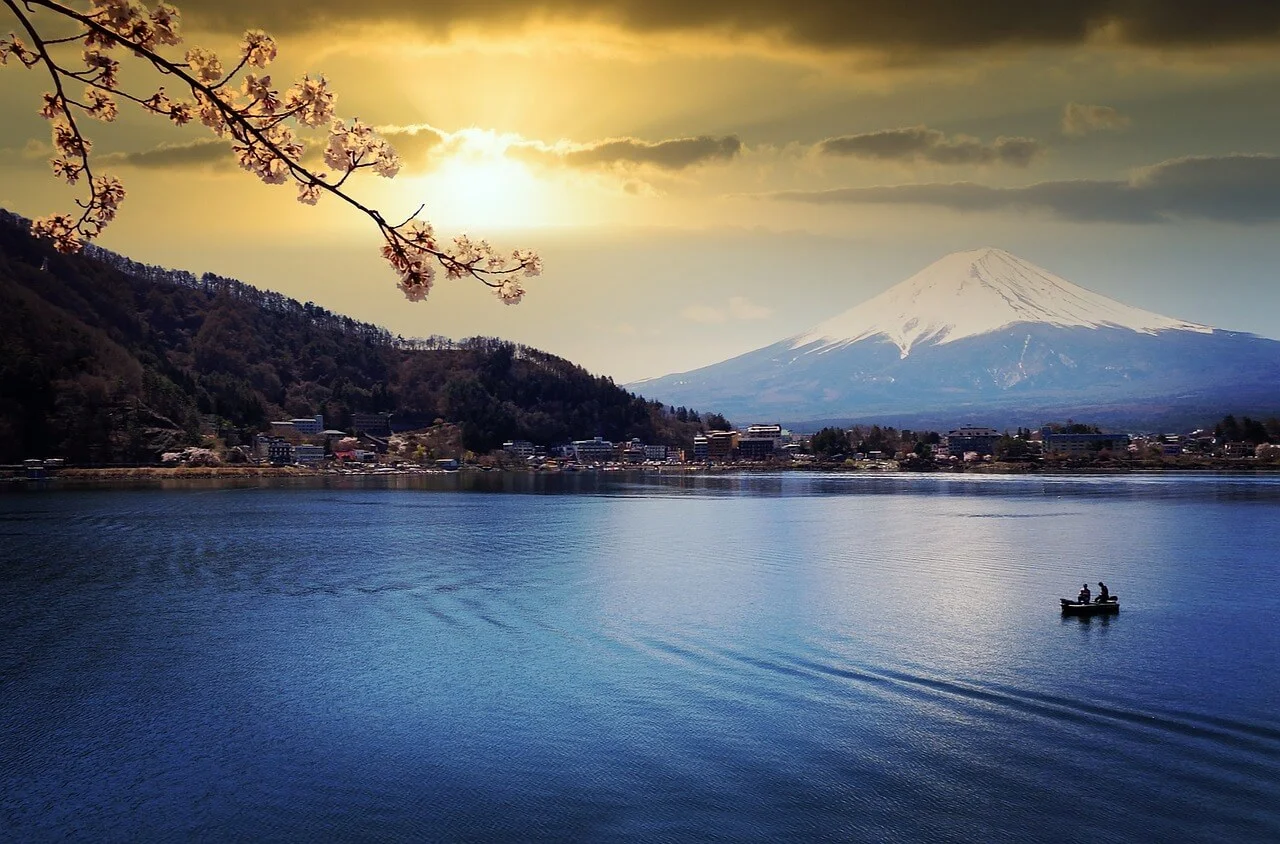
Looking for a breath of fresh air after spending time in Japan’s big cities? Look no further than Mount Fuji, one of the most incredible outdoor destinations Japan has to offer.
There are plenty of set tours with a number of price ranges for first timers. However, with Japan becoming more accessible to English speakers, it’s never been easier to personalize your journey.
By the end of this guide, you’ll have a customizable blueprint that will allow you to experience Mount Fuji and the surrounding areas in your own unique way.
Getting to Mt. Fuji
The first, and (probably) most important step for enjoying a trip to Mount Fuji, is getting there.
There are a number of ways to get to Mount Fuji, and if you’re coming from abroad it depends on which airport you arrive in. Tokyo is the most logical starting point and has the most options in terms of transportation.
If you’re coming from Tokyo, you have three main options for getting to Mount Fuji:
- Highway-buses are the most convenient option and run from Tokyo (Shibuya, Shinjuku stations) and other locations across Japan.
- Driving, for those who are willing to pay a little more for the extra freedom and comfort.
- A bullet train to one of the closer cities that offer tours or busses from there.
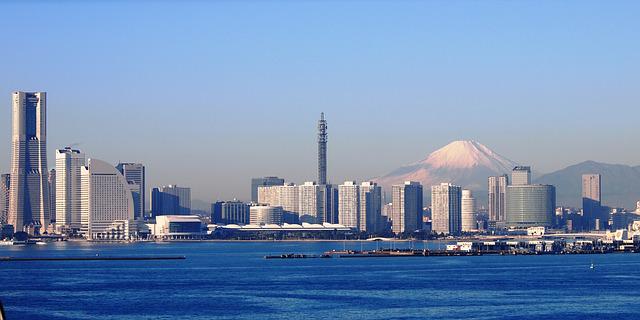
If you decide on taking the train or bus, there are several smartphone navigation apps that’ll make planning the trip a lot easier.
Compared to Tokyo, Kyoto is a bit far from Mount Fuji. So, if possible, it’s best to plan your trip from Tokyo and make your way to Kyoto after that.
However, if you wake up early enough in Kyoto and get bullet train tickets for one of the first departures, there’s no reason you can’t pack in a full day of fun around Mount Fuji.
Take the shinkansen (bullet train) to Mishima station and transfer to the Fuji Q bus bound for Kawaguchi-ko station. Between train and bus, the cost is about ¥13,000 and takes about 3.5 hours total. Take a look at the bus times via Mishima station for yourself and plan accordingly.
How Long Is the Drive From Tokyo to Mt. Fuji?
Driving from Tokyo to Mount Fuji takes between 2-3 hours depending on traffic. The Chuo expressway is the quickest option, but there is a toll. The fee is based on car size, with regular cars costing up to ¥5000 and smaller ones (kei cars with yellow license plates) closer to ¥4000.
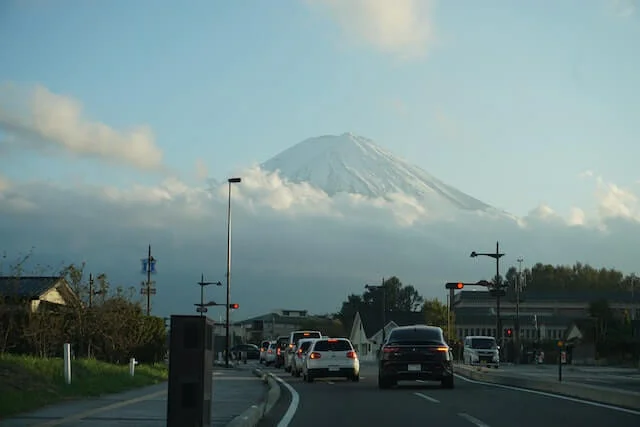
Toll prices are a bit difficult to work out, but if you know the departure and arrival city names then you can use this toll estimation tool for a general idea of the price of your ride.
Mt. Fuji Itinerary Ideas
There is no single ultimate Mount Fuji day trip, and that’s a very good thing! People have different tastes, and the Fuji area is capable of catering to them all.
Take a look at our previous article exploring 14 different Mount Fuji trip ideas for a better idea of what we mean. Everything in the itineraries below is pulled from that list, from shopping at the massive Gotemba outlet to taking the perfect photo from one of the surrounding panorama parks.
Just note that many of the best Fuji attractions are on the east and southeast side. The main exception is some fantastic hot springs like Fujiy Yurari and the Mount Fuji Heritage Center, which is why we included it in the Kyoto itinerary, since you would be coming from the west.
Also, if you have a tokyo rail pass that applies to Fuji, you can consider most, if not all, of the train fees to be zero.
Fuji-Q Day Trip
This first itinerary is for the thrill seekers, as the main focus is one of Japan’s best amusement parks, Fuji-Q Highland .

- Leave from Shinjuku station by bus for Mt. Fuji 5th station at 6:45 AM. Travel time 2h 25 mins (¥3,800 for adults, ¥1,900 for children, one way). This is the highest point you can reach on Mount Fuji by public transport and has an amazing view of the surrounding area.
- Head to Fuji-Q Highland from Mt. Fuji 5th station via Kawaguchi-ko station by highway bus . The 11:40 AM departure will take 40 minutes and cost ¥1,570, one way. From there, you can enjoy roller coasters and other theme park rides to your heart’s content. Day passes are ¥6,300 per person and the park is open until 5 pm.
- Enjoy the view from Mt. Fuji Panoramic Ropeway. Take the train from Fuji Q highland station to Kawaguchi-ko station. The 3 pm train is ¥180, and from there it’s a 10 minute walk to the Base of Mt. Fuji Panoramic ropeway . ¥900 round trip for adults and ¥450 for children. Enjoy some beautiful views and try to catch the sunset!
- Try the local delicacy, Unagi. Not too far from Kawaguchi-ko station, you can try grilled eel at the delicious Unagi Riki . High-grade eel is ¥3,450 per person and the budget option is ¥2,350.
- Back to Tokyo. A 5 minute walk back to Kawaguchi-ko station before taking the limited express Fuji Excursion train to Shinjuku JR station.
Mt. Fuji World Heritage Center Day Trip
This second itinerary is more for someone wanting to get a better sense of the area from indoors. For variety, we’ll start off in Kyoto, but you could do this trip from Tokyo even more easily.

- Leave Kyoto Station on the 6:26 AM shinkansen heading for Shizuoka. There are a few different route options, from transferring onto a limited express train in Shizuoka to multiple local trains. Your destination is Fujinomiya Station.
- Walk to the Mount Fuji World Heritage Center from the station. The Mount Fuji center opens at 9 AM, so after walking from the station after the express train, you’ll be right on time.
- After soaking up Mount Fuji-related facts and history for a couple of hours, grab a bite to eat near Fujinomiya station. There’s no shortage of options.
- Hop on another train from Fujinomiya, bound for Iwanami station. From there, take a bus to Gotemba Premium Outlets and get your shopping fix with a gorgeous view of Mount Fuji.
- Either make the long return to Kyoto or plan your overall trip so that you’re staying in Tokyo that night (recommended).

Chureito Pagoda Day Trip
With one of the most scenic views of Fuji, Chureito Pagoda is a hot spot for tourists. And it’s also a great focal point for another Mount Fuji day trip itinerary.
- Rent a car and drive to Chureito Pagoda in the morning and enjoy the scenery while taking some fantastic pictures.
- Make your way to Fuji’s nearby lakes. From there, you could rent a kayak and go paddling on the pristine waters or find a nice trail for a hike.
- Put a cherry on top of your day with a visit to a Japanese onsen before enjoying some of Yamanashi prefecture’s famous hotpot , called Houtou nabe.
- Make the reluctant return to Tokyo.
Mt. Fuji Day Tours
Just want to kick back and let someone else plan your Mount Fuji trip for you? A professional tour might be the thing you’re looking for to make your visit stress-free.
Here is a list of some recommended day tours which offer a range of unique ways to experience the beauty of Mount Fuji.
Mt. Fuji and Hakone Full Day Tour
Hato bus provides full day tours between April 1st and June 30th. From 9 AM until 8 PM they take you to key spots in surrounding Mount Fuji and Hakone areas. Some of the highlights you can look forward to are as follows:
- A cruise on Lake Ashi
- Visiting the 5th level of Mount Fuji
- Panoramic view of the mountain and surrounding areas from Komagatake Ropeway
Lunch is provided and prices are 12,800 JPY for adults and 10,800 JPY for children (subject to change). Follow this link for more info on this Fuji tour .
Private Car Tour of Mt. Fuji and Gotemba Outlet
This service will pick you up from almost any hotel in Tokyo and provide transportation via private car to and from Mount Fuji’s 5th station. The tour then moves on to the popular Gotemba outlet mall where travelers can spend as much time (and money) as they like.
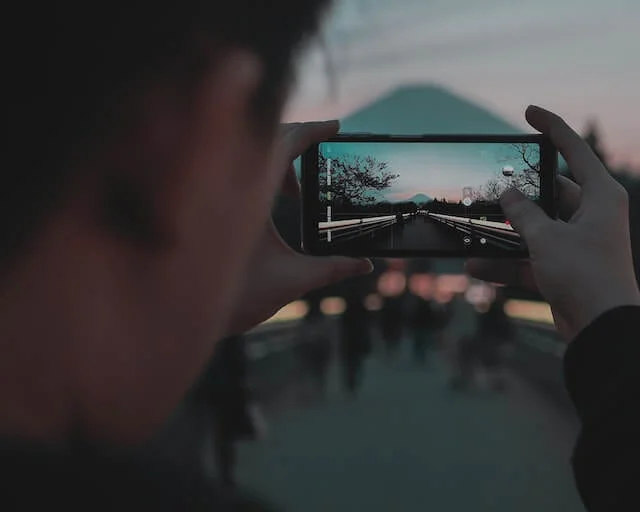
The 10 hour tour is ¥150,000 ($1,178USD) per group and can take up to nine people. Follow this link for more info on this private car tour .
When is the Best Time to Visit Mt. Fuji?
The best time to visit Mount Fuji is during the summer months of July and August when the weather is generally stable and clear, allowing for good views of the mountain. This is also the peak tourist season and the busiest time to visit, so be prepared for crowds.
If you prefer a less crowded experience, you may consider visiting in the spring (April to June) or autumn (October) when the weather is still mild and the foliage is changing colors. As with any mountainous area, check the weather forecast before your trip, as it can be unpredictable and quickly change from clear to cloudy or rainy.
Can You Climb Mt. Fuji in a Day?
If you’re in really great shape, you can climb Mount Fuji in a day. Fuji’s 5th Station is the highest starting point at 2,400 meters in elevation, making the total ascent a little under 1,400 meters. The trail from that point is 5 kilometers, which is doable if you’re up for a challenge.
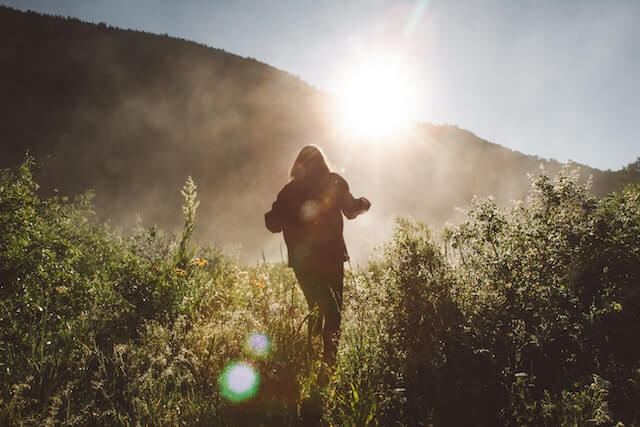
The Yoshida trail takes an average 5-7 hours to climb, and because of the sudden rise in altitude it’s very common to experience altitude sickness. If you’re not extremely confident, you may want to plan to do the climb over a two day period and try to stay at one of the mountain huts.
Mount Fuji day trips are fairly easy to plan since there are plenty of buses and trains going to the different attractions. And if you don’t feel like organizing things for yourself, there are many one day tours, each offering a unique way to enjoy the wonder that is Mt. Fuji.
Try to plan your trip from mid-spring to early fall based on what kind of foliage you want to see and the availability of certain tours. Once you’re there, enjoy the view.
Mount Fuji Heritage Center image by SHIZUOKACITYperson, CC BY-SA 4.0 https://creativecommons.org/licenses/by-sa/4.0 , via Wikimedia Commons
Share the adventures Share this content
- Opens in a new window X
- Opens in a new window Facebook
- Opens in a new window Pinterest
- Opens in a new window LinkedIn
- Opens in a new window Reddit
- Opens in a new window Tumblr
- Opens in a new window WhatsApp
You Might Also Like
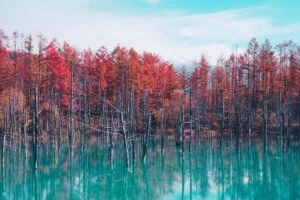
Hokkaido’s Top 7 All-Natural Onsen
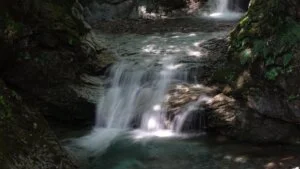
The 6 Best Onsen in Kumamoto
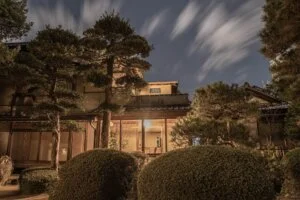
The Top 11 Onsen in Japan with Private Baths
Leave a reply cancel reply.
Save my name, email, and website in this browser for the next time I comment.
- Skip to main content
- Skip to primary sidebar

Destinations
- Plan Your Trip
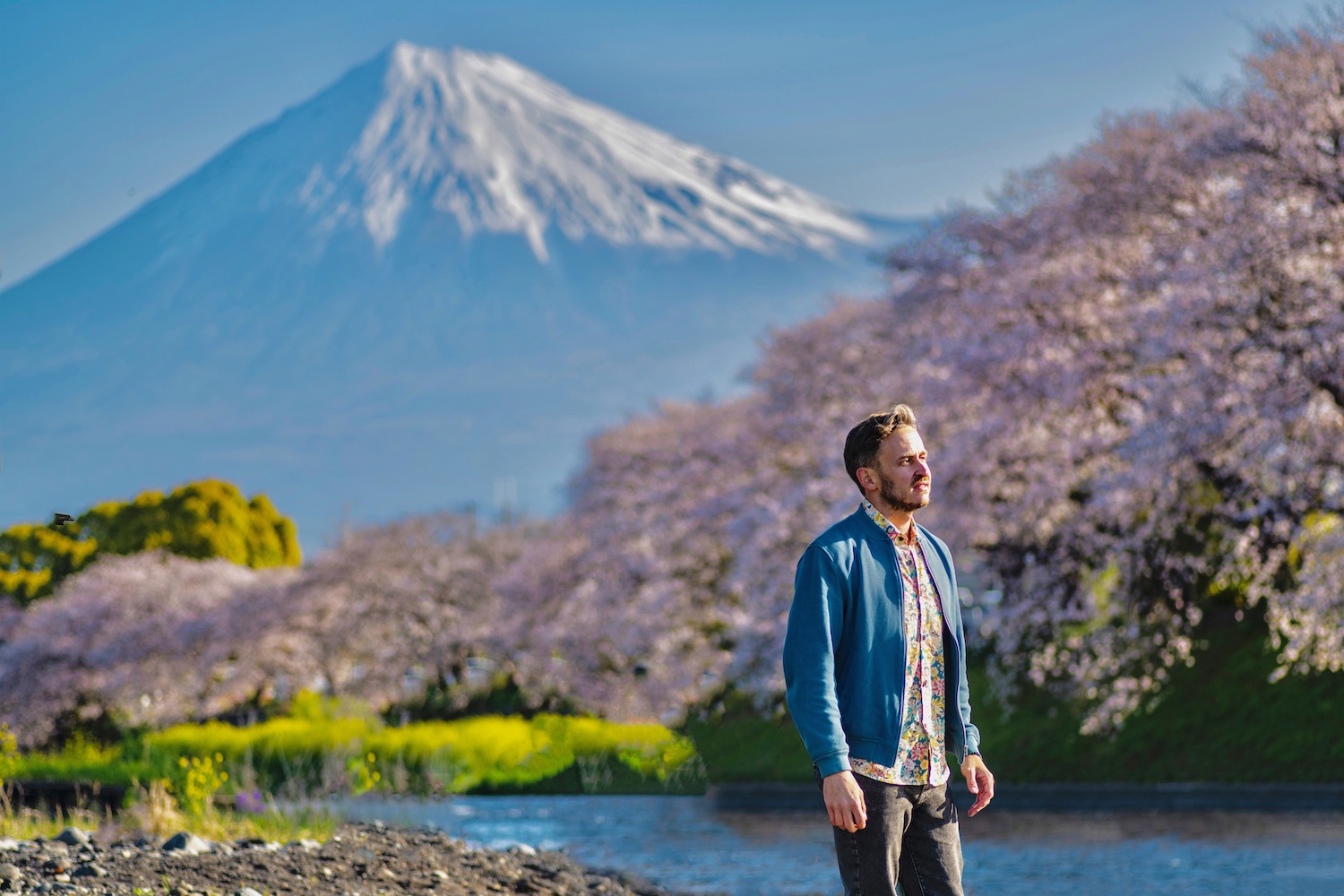

A Perfect Day at Mt. Fuji
June 10, 2022 by Robert Schrader Leave a Comment
I find that travelers to Japan fall into two camps: Those who believe Fujisan rises directly above Tokyo ; and those who think you simply can’t take a Mt. Fuji day trip. The truth, of course, lies somewhere between these two extremes. You can see Mt. Fuji from various places in Japan’s capital (though not like this, certainly )—and it’s actually very easy to take a day excursion to the Fuji Five Lakes region.
Of course, many companies will try to sell you a Mt. Fuji tour, though since this is Japan we’re talking about, I’ll go ahead and assume they have good intentions. Yet mine are better: With the information in this article, you can easily have an amazing time at Mt. Fuji all on your own—and get back to Tokyo in time for dinner.
And I’m not talking about Tokyo to Hakone, which is a lovely place , but is far from the best place to view Fuji. Continue reading to learn more about how to get up-close-and-personal with Japan’s most famous mountain in half a day or less.
Don’t want to read the whole article? Then take just one tip to start: If the weather forecast for your destination isn’t totally clear, it probably isn’t worth making the journey!
How to Reach Mt. Fuji from Tokyo
One reason not to book a Mt. Fuji tour from Tokyo? Direct buses depart Shibuya every day, bound for Kawaguchiko and Fujiyoshida, the two major cities of the Fuji Five Lakes region. It takes just over two hours to travel from Tokyo to Mt. Fuji, and you can book the tickets online here up to three months in advance.
This isn’t appealing to some travelers, namely because they’d rather take a Tokyo to Mt. Fuji train (which would be covered by the Japan Rail Pass —the bus isn’t). Unfortunately, while a new direct service from Shinjuku to Kawaguchiko now exists, the service requires a hefty ¥1,140 “supplement” for JR Pass users, which makes it a less than attractive alternative.
Things to Do on Your Mt. Fuji Day Trip
See fuji’s reflection in lake kawaguchi.
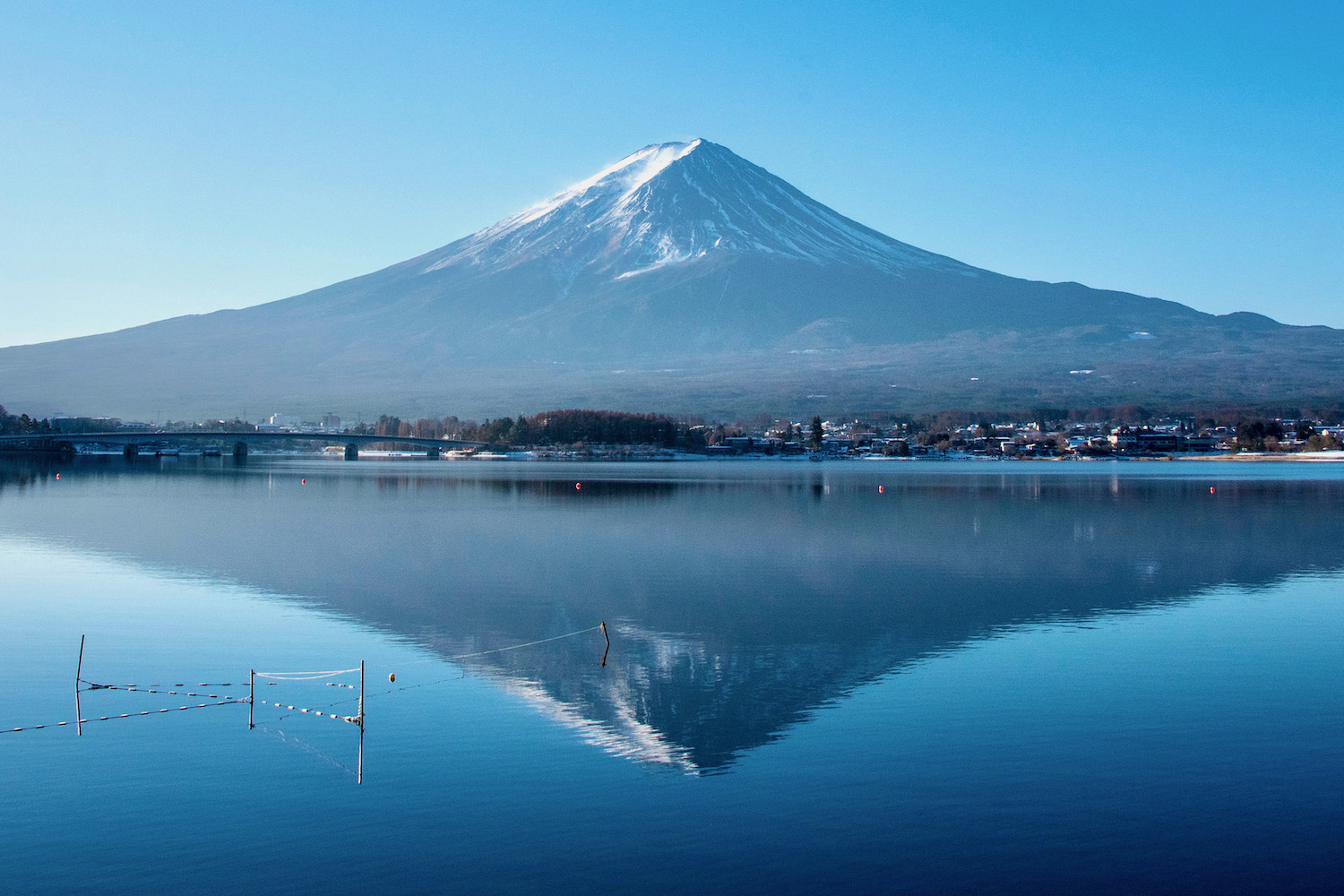
My #1 favorite part of a Tokyo to Mt Fuji day trip? Seeing the mountain reflected in the waters of Lake Kawaguchi , of course! To get the best view either walk, bike or take a bus from Kawaguchiko Station to the north shore of the lake, which is about 3 km away. If you get to this spot and it’s cloud, don’t worry, as I’m about to suggest another activity that can keep you occupied for an hour or so of your day trip to Fuji Five Lakes from Tokyo, should you need to wait for clearer skies.
Visit a Unique Museum
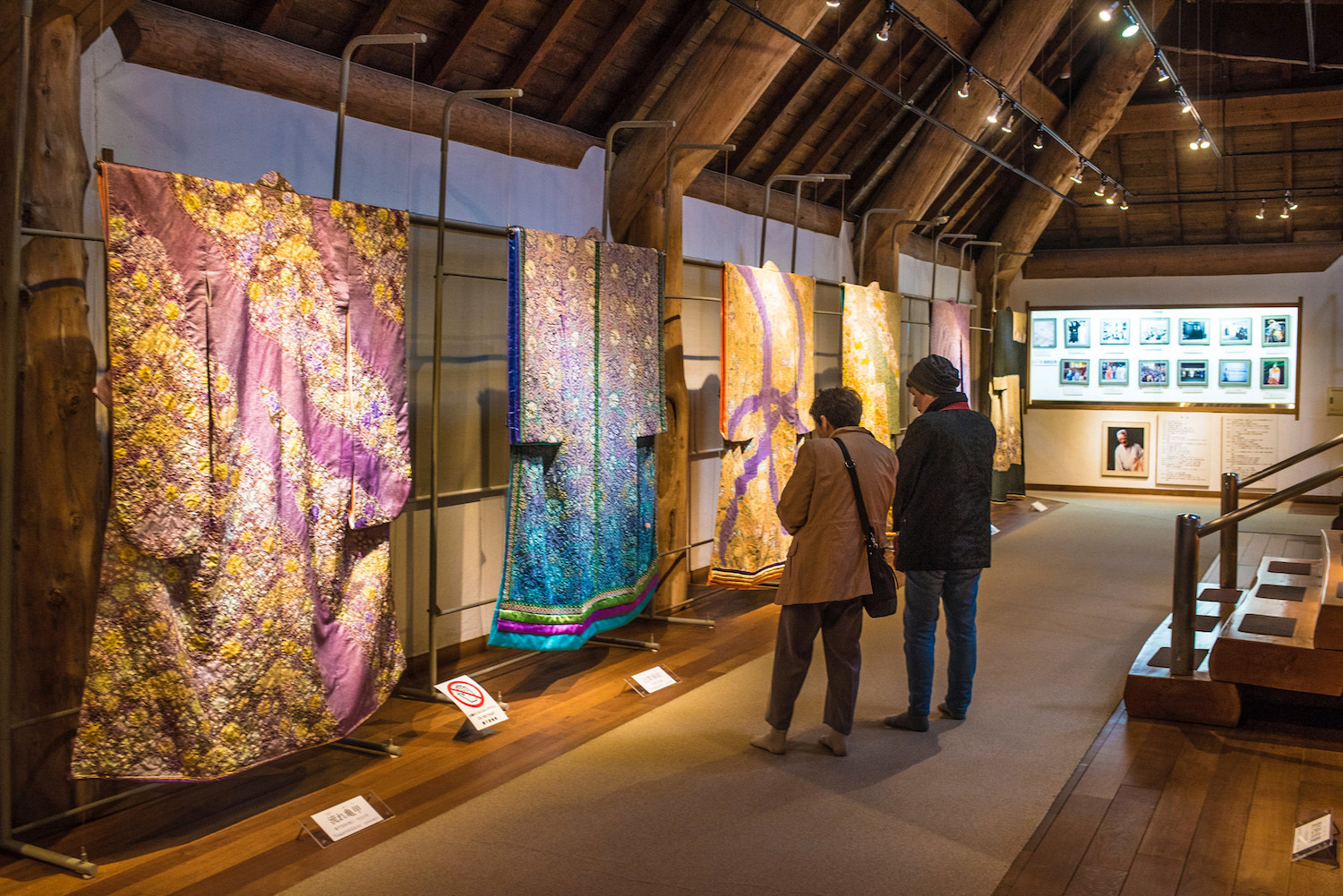
A museum might be the last thing you expect to add to your Mount Fuji day trip itinerary. However, there are a couple that are very worthy of your time, especially if the weather is less than ideal. If you’re in Kawaguchiko, visit Kubota Itchiku Art Museum , which is dedicated to the man who revived the ancient kimono style of dress for the modern era, and displays dozens of the garments inside. In Fujiyoshida, visit the Fujisan Museum , which tells the story of several notable climbs up Mt. Fuji .
Enjoy the View from Chureito Pagoda
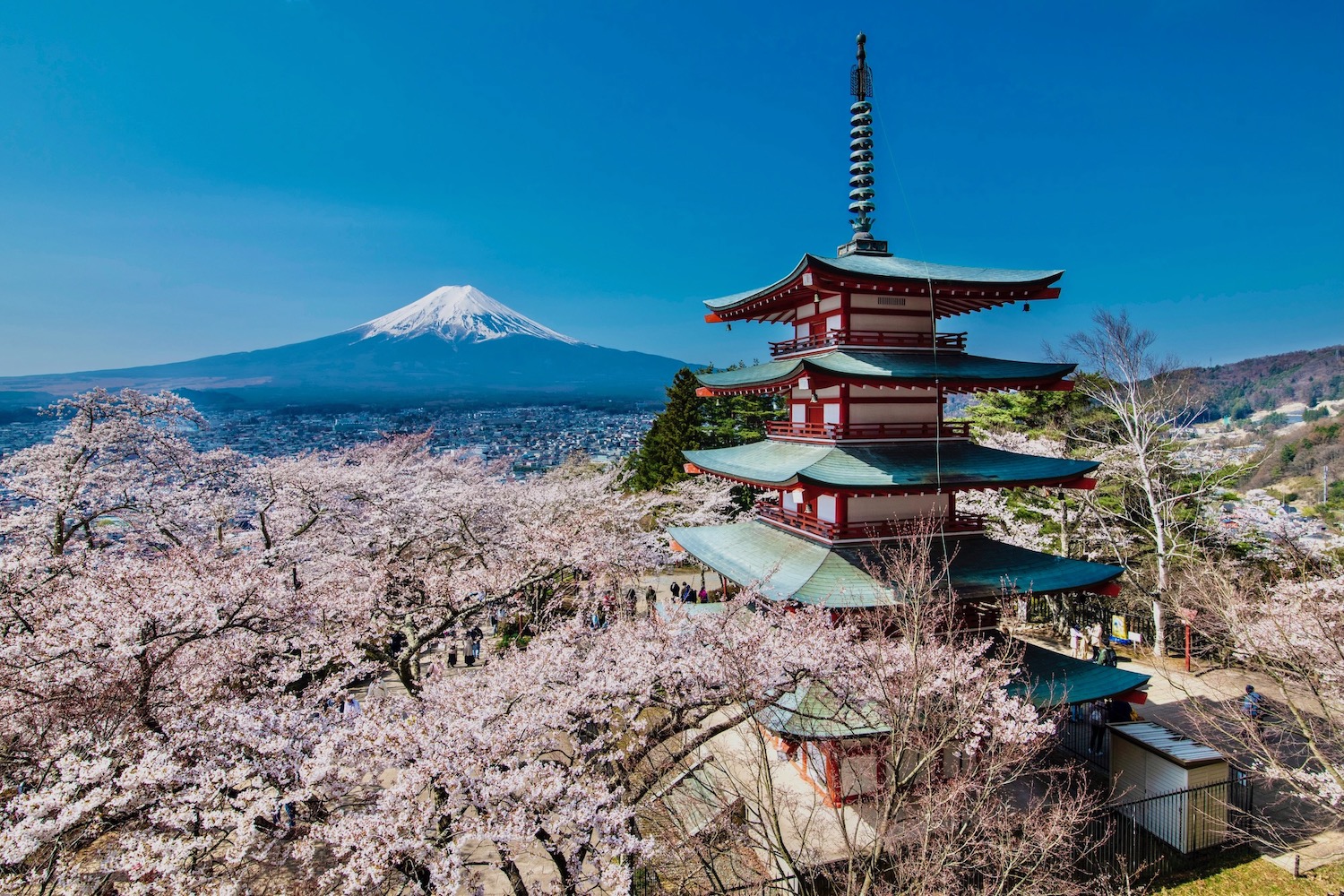
Although Chureito Pagoda might not come up when you Google “how to see Mt. Fuji,” it certainly provides one of the most iconic views of the mountain—especially during cherry blossom season . Well, if you get a clear day that is—if not, you’ll have no idea that Fuji looms behind the wall of clouds. Still, a walk here (about 15 minutes from Shimoyoshida station, and then 20 minutes up a couple of set of stairs) is far from a wasted endeavor, as the pagoda and Arakura Fuji Sengen temple itself are charming.
Or From A Thrilling Rollercoaster
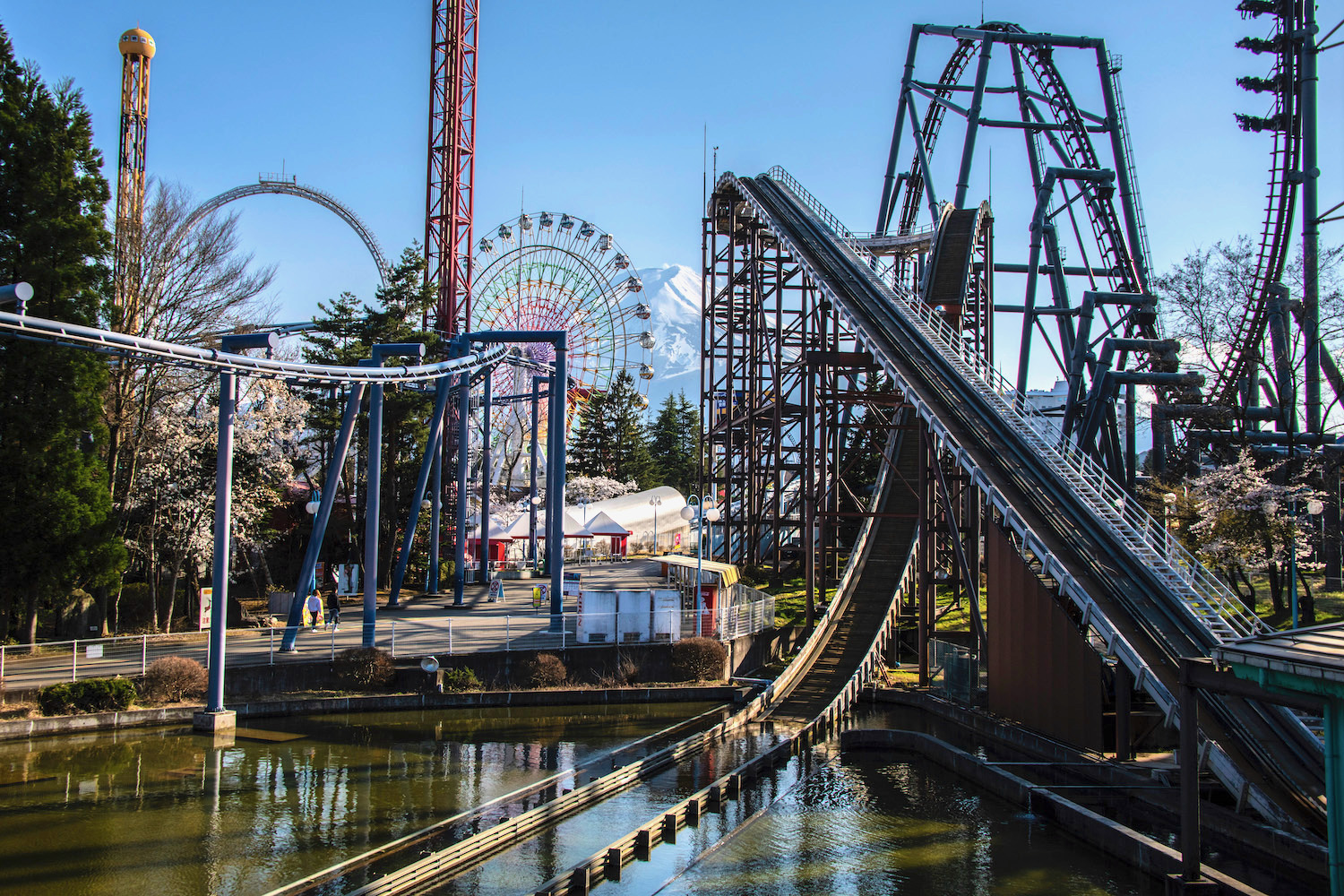
Want to take a Mt. Fuji day trip that’s more thrilling than tranquil? Skip the scenic views and enjoy a more hair-raising one. Specifically, get off the bus at Fujikyu Highlands , which might just be the most scenic amusement park in the world. You don’t need to ride rollercoasters like Fujiyama and Eejanaika , of course—entrance to the park itself is free; you simply need to pay to get on the rides themselves, which admittedly provide the best views of Fujisan during your Mount Fuji day trip.
Take a Hike
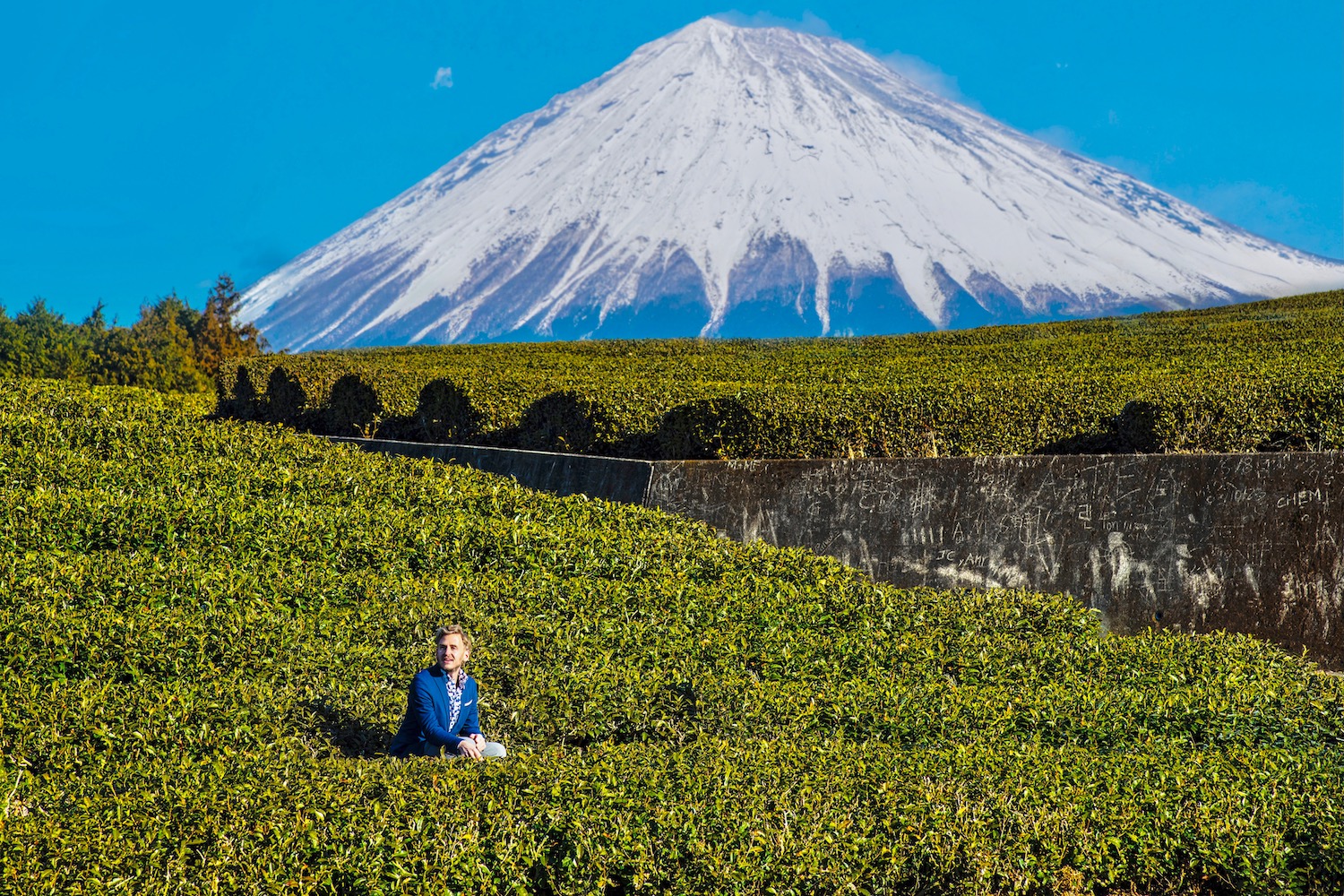
The bad news? You won’t be able to take a Mount Fuji climbing tour if you’re taking a day trip to Mt. Fuji from Tokyo. The good news? There are plenty of amazing hikes in the Fuji Five Lakes region, even if you simply walk around the base of Lake Kawaguchi. Want to gain some elevation? Make a beeline for the trail head of the Panorama-dei trek, which is actually closer to Lake Yamanako , another in the Fujigoko area. You may even opt to hike through the Obuchi Sasaba tea fields (if the owners don’t run you off!).
Best Time to Visit Mt. Fuji
Since you’re probably planning your Mt. Fuji itinerary as part of a larger Japan trip (and probably, for whenever you plan to be in the Tokyo area) I imagine you have limited flexibility. With this being said, you should keep a short list of the things to do in Mt. Fuji on your person as you prepare for your trip, particularly if you don’t commission a custom Japan itinerary from me .
The two most important things to keep in mind for your Mt. Fuji day trip are as follows. First of all, that summer in Japan (aka the tsuyu monsoon) bears the greatest risk of rain and, therefore, the highest chance that you won’t be able to see the mountain. Secondly, the seasonal delights I mentioned earlier (sakura in spring and colors of the fall) are later and earlier, respectively, than they are in Tokyo. Sakura reach their peak in Fujigoko in mid- to late-April, while autumn colors peak during the first half of November or even earlier.
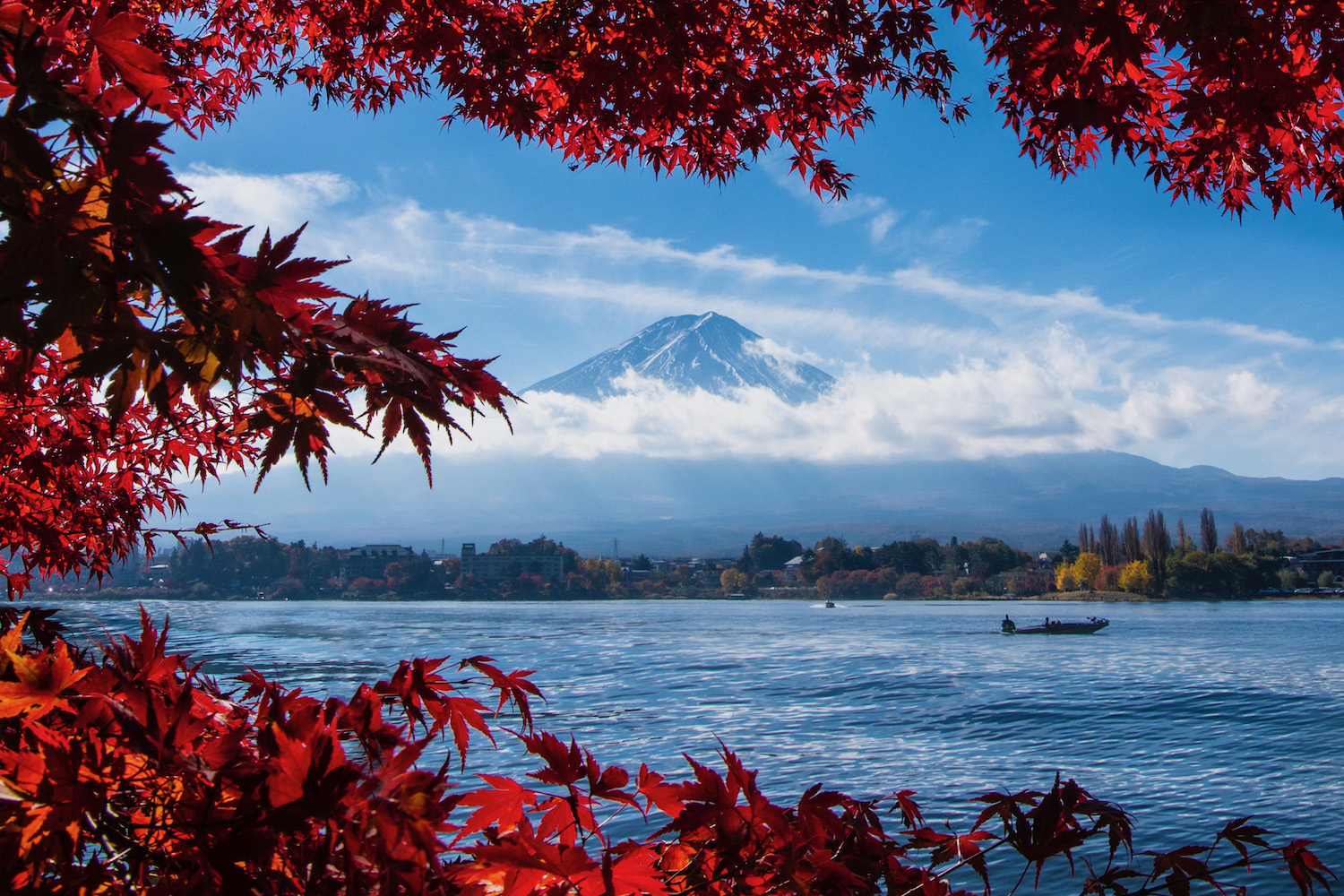
Should You Spend the Night at Mt. Fuji?
Whether you choose an expensive Fuji view hotel on the north shore of Lake Kawaguchi ( Shuhokaku Kogetsu is probably my current favorite) or a more budget-friendly accommodation like Peace Kawaguchiko , there are plenty of great places to stay a night at Mt. Fuji should you decide to stay there. But is it necessary?
There are a few reasons this might be a good idea—firstly, that Fuji can be fickle to show its face, so the longer you have, the better chance you have to get the money shot. It should go without saying that you’ll need to spend at least one night if you plan to climb Mt. Fuji. Additionally, if you plan to do more than a couple of the activities I’ve listed above, you’ll definitely want to scout out where to stay near Mt. Fuji, as a matter of necessity.
Other FAQ About Your Mt. Fuji Day Trip
Can you do mount fuji in a day.
You can travel to any number of the best places to see Mt. Fuji in a day, although you can’t realistically climb the mountain (plus get there and back) without spending a night. If you want to climb Mt. Fuji, travel to the trailhead in the morning of your first day, so you can reach the “eighth station” before nightfall. Rise long before dawn the next morning so you can watch the sunrise from the top, then return to whatever city you’re staying in the next afternoon.
Can you do a day trip from Tokyo to Mt Fuji?
You can take a day trip from Tokyo to Mt Fuji (and adjacent destinations), such as the hot springs town of Hakone or the Fuji Five Lakes, which sit just at the base of the mountain. However, if you want to climb Mt. Fuji it’s really best to stay at least one night, for reasons I describe in the previous paragraph.
Is Mt. Fuji worth visiting?
Mt. Fuji is absolutely worth visiting, assuming you are able to get a clear view of it. It’s for this reason that it’s essential to carefully monitor weather conditions before making the journey—a totally clear day is ideal, and your only guarantee of seeing Mt. Fuji. While it’s not totally worthless to visit the Fuji area without seeing the mountain, it does somewhat defeat the purpose.
The Bottom Line
A day trip from Tokyo to Mt Fuji can take many forms, but all are relatively easy to execute. If the weather is good, head straight to Kawaguchiko, and marvel at the reflection of Fujisan in the lake. If you’re seeking a thrill, enjoy views of the mountain from the rollercoasters of Fujikyu Higlands. Even if conditions for viewing the mountain are less than ideal, an eclectic array of cultural attractions make the Fuji Five Lakes region worthy of a visit. Need personalized help planning your Mt. Fuji day trip? Commission a custom Japan itinerary!
Plan Your Japan Trip

Subscribe to email updates!
Words, images and design ©2018-2024 Robert Schrader, All rights reserved. Read Privacy Policy or view sitemap .

Tokyo to Mount Fuji: A Complete Day Trip Guide for You
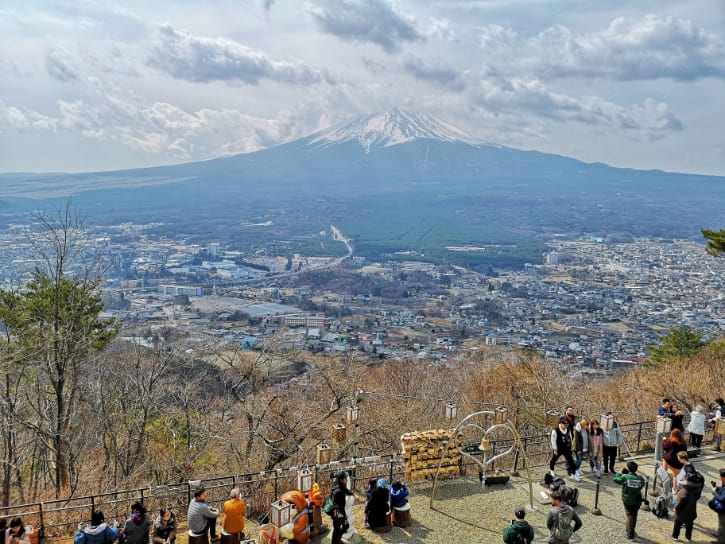
Thinking about a day trip from Tokyo to Mount Fuji ? Let me share with you in detail the ways on how to go to Mt. Fuji and what attractions you must see upon arrival .
I did a day trip with my wife to Mt. Fuji during our visit to Tokyo and we definitely had a great time. The place was surrounded by beautiful and relaxing views .
Luckily, most of the attractions are easily accessible via the sightseeing bus tour . You will get to know more about this later on, along with the best and easy ways to get around the area .
Let’s dive into the details of a Mount Fuji day trip from Tokyo . The information below will surely make your trip more convenient and memorable . 🙂
- Fujikyuko or Keio Bus (Highway Bus)
- Fuji Excursion (Limited Express Train)
- Fuji Day Tour
Best Things to Do on Your Day Trip to Mount Fuji
1. oshino hakkai, 2. kachi kachi ropeway (mt. fuji panoramic ropeway), 3. kawaguchiko music forest museum, 4. chureito pagoda, 5. fuji 5th station, 6. gotemba premium outlets, 7. fuji-q highland, 8. oshino ninja village, 9. fuji shibazakura festival, 10. oishi park, how to tour around mount fuji, mount fuji day trip from tokyo (suggested itineraries), related posts, 3 best ways to go from tokyo to mount fuji.
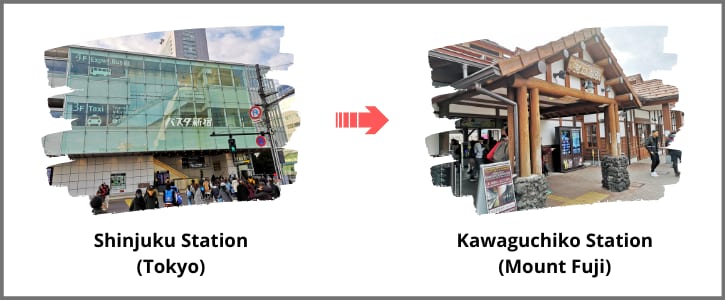
Mount Fuji is around 100 km from Tokyo and it takes about 2 hours to complete the journey.
There are 3 best transport options available ― Fujikyuko/ Keio Bus (Highway Bus), Fuji Excursion train, and guided tour.
Depart: Shinjuku (Tokyo)
For a day trip going to Mount Fuji from Tokyo , the best and easiest way is to take a highway bus or train from Shinjuku .
If you choose the bus, you can take it at Shinjuku Expressway Bus Terminal. For the train, you need to board it at Shinjuku Train Station.
Arrive: Kawaguchiko Station Kawaguchiko Station is the main transportation hub within the Mount Fuji area. Most of the buses and trains depart and stop here.
There’s a sightseeing bus tour available in Kawaguchiko Station. This is such a great choice if you want to tour around the area conveniently.
The options below are some of the public transports that will take you to the Kawaguchiko Station.
1. Fujikyuko or Keio Bus (Highway Bus)
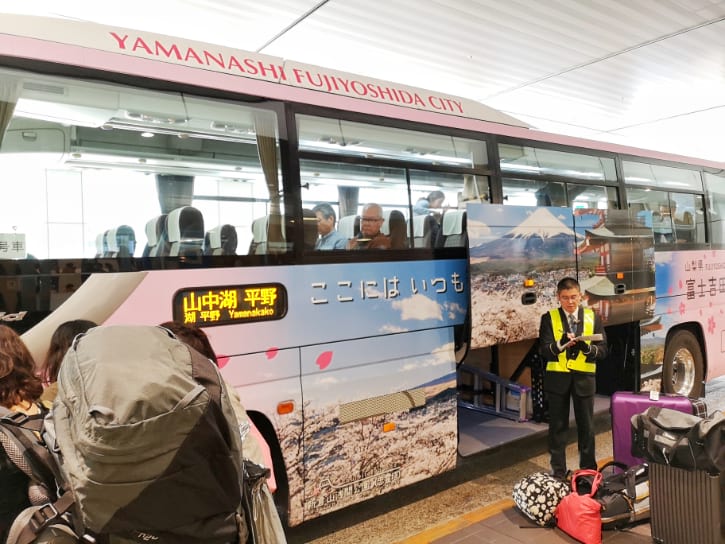
The cheapest way to get from Tokyo to Mount Fuji is taking the Fujikyuko Bus or Keio Bus . For a single trip , you just have to pay 2,200 yen per person for the bus ticket price. The ride takes around 1 hour 45 minutes .
You can take the bus from level 4 of the Shinjuku Expressway Bus Terminal in Tokyo. It’s located beside the Shinjuku Train Station.
This is a direct bus route and it will stop at Kawaguchiko Station and Fuji-Q Highland .
Bus Information:
- The buses leave every 10 to 30 minutes and they start at 6:45 AM and end by 8:15 PM. You can book the bus tickets online or directly at the bus terminal.
- I personally prefer booking online because there are times the tickets at the bus terminal are fully booked.
2. Fuji Excursion (Limited Express Train)
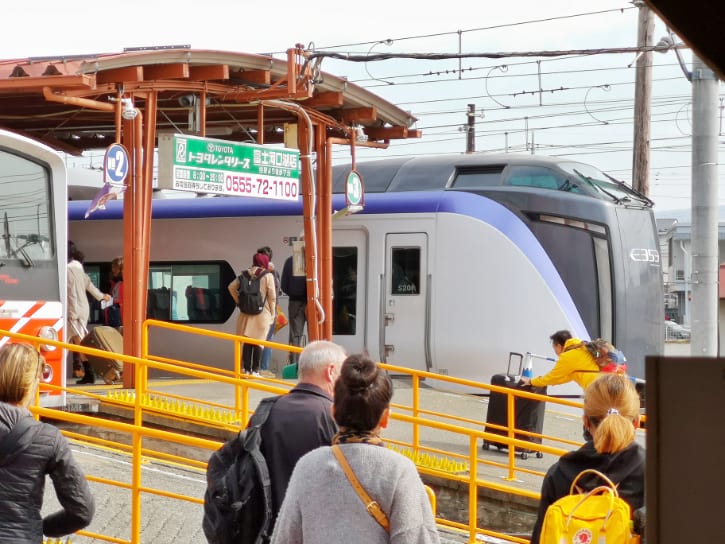
From Shinjuku Station (Tokyo) , take the Fuji Excursion Limited Express Train to Mount Fuji . The single journey takes around 1 hour and 53 minutes and costs roughly 4,130 yen per person. This train will take you directly to Kawaguchiko Station, which is in the Mt. Fuji area.
Train Information:
- The train only provides 3 round trips every day between Tokyo and Mount Fuji. The departure times from Shinjuku Station are 7:30 AM, 8:30 AM, and 9:30 AM.
- And for the return trip, the departure times of the trains from Kawaguchiko Station are 3:03 PM, 4:51 PM, and 5:36 PM.
- You can buy your train tickets online or purchase these at the ticket office of Shinjuku Station .
If you opt for an online reservation, here’s a step-by-step guide that you can follow. Alternatively, you can book the train tickets online here , which is much easier than using the website below.
- Head to the JR-East Train Reservation website .
- Choose “Purchase tickets” (Customers not using a pass).
- Click on “Search by Line”.
- Line: “Chuo Line(Chiba/Tokyo – Matsumoto, and others)”, Departure station: “Shinjuku”, Arrival station: “Kawaguchiko” and Date of travel: Select the date you want to visit.
- Click on “Search”.
- Choose FUJI EXCURSION 3 (Departure time is 7:30 AM)/ FUJI EXCURSION 7 (Departure time is 8:30 AM)/ FUJI EXCURSION 11 (Departure time is 9:30 AM)
3. Fuji Day Tour
Taking the Mount Fuji day tour from Tokyo is the best choice if you don’t have extra time to plan for your day trip .
This is highly recommended if you just want to sit back, relax, and let the tour guide bring you to the main sights .
Aside from saving time from doing your research, this minimizes the possibility of getting lost during your travel . It’s because everything is already accounted for during the day tour.
You can check out one of the best tours here: Mt. Fuji Tour 1 / Mt. Fuji Tour 2 / Mt. Fuji Tour 3 , if you’re looking a stress-free trip.
An alternative way to enjoy a day trip to Mt. Fuji is to hire a private car charter . You can book their car service here , which comes with a professional English-speaking driver. Plus, you have the flexibility to customize your own itinerary .
Mount Fuji is such a gorgeous place to explore. It is loaded with beautiful views, breathtaking gardens, traditional sites, and a lot more.
So, let me introduce you to the 10 best things to do and see around Mt. Fuji . All of these are perfect for a one-day trip , especially for first-time visitors who want to discover this amazing place from Tokyo.
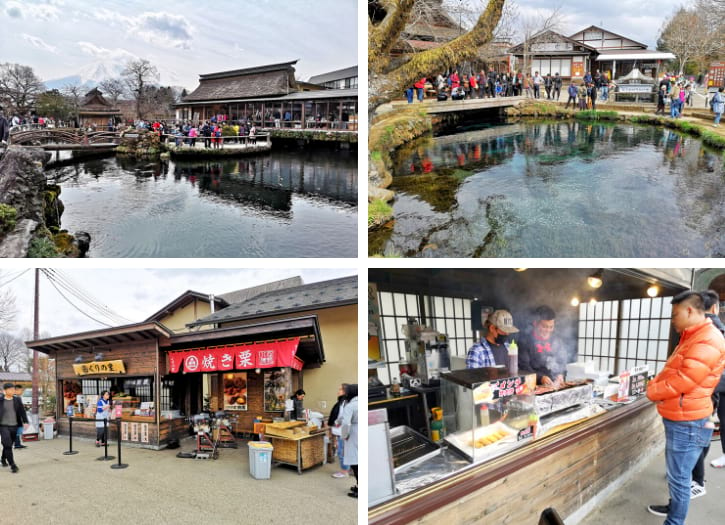
A Mt. Fuji day trip from Tokyo is incomplete without experiencing the serene charm of Oshino Hakkai .
This small village is filled with eight scenic ponds and offers many gorgeous sights to capture . Walk around the beautiful pathways and enjoy the peaceful ambience.
As you explore the ponds, try to take a photo of Mount Fuji and the traditional sites surrounding the area .
Along the way, you’ll come across various local vendors selling tasty snacks and drinks .
There are also plenty of souvenir shops that feature unique crafts and artistic products.
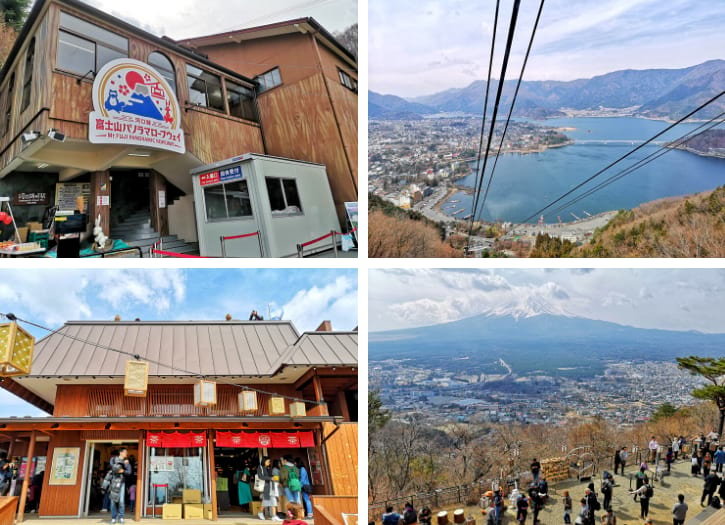
Kachi Kachi Ropeway should also be on your Mount Fuji day trip list. This cable car offers you an exceptional journey bounded by breathtaking lake views and mountain sights .
Without a doubt, this is one of the best spots to take a photograph of Mount Fuji .
Glide your way from the shore of Lake Kawaguchiko to the observation peak along Mount Tenjo.
There’s an option for you to avail of the round trip and simply just relax while the cable car travels back and forth.
But if you want extra fun, you may take off at the observation deck and then tour around the place.
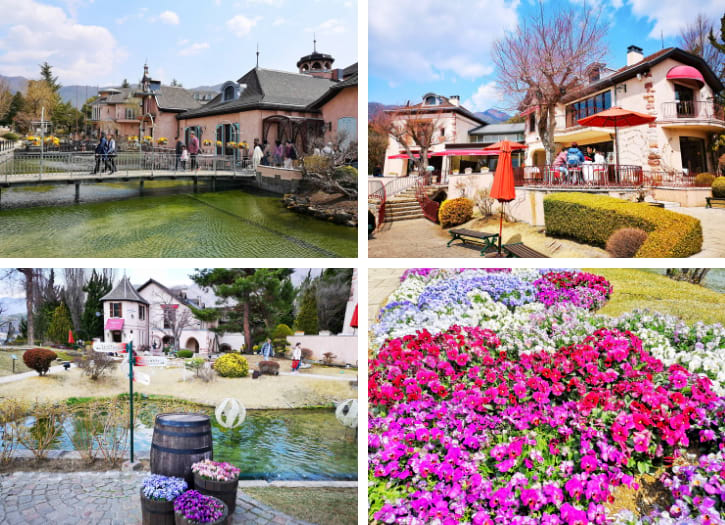
Visit the Kawaguchiko Music Forest Museum and be in awe of the European-inspired designs .
This beautifully styled theme park is known for its cosy atmosphere and unparalleled view of Mount Fuji .
Aside from its themed landscapes, the inside of the museum holds a special collection of musical instruments .
Navigate the antique exhibits and unravel the array of vintage organs .
There are also several musical experiences as well as instrument demonstrations for everyone. And, make sure not to miss the live performances and sand art storytelling shows.

Head to the 5-storied Chureito Pagoda and see the spectacular Mount Fuji from afar .
This well-known shrine requires you to hike your way up the mountain. It takes around 400 steps to reach the top , so ready yourself in advance.
While at the top, explore the popular pagoda and capture the beautiful views of the iconic mountain and surrounding lakes .
If you visit the place during spring or autumn , the shrine’s even more captivating because of the bright nature colors.
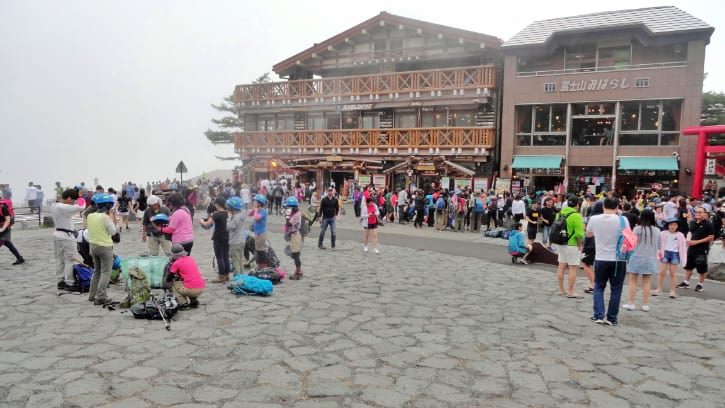
Take a trip to Mt. Fuji 5th Station or Fuji Subaru Line 5th Station. This is the starting point for those who want to see Mount Fuji up-close .
It is located near the Yoshida Trail, which opens up halfway to the summit of the famous mountain.
So, if you don’t have extra time to climb the peak of Mount Fuji, simply visit this place and enjoy the incredible sights. Watching the hikers ascend to the top is already a remarkable experience.
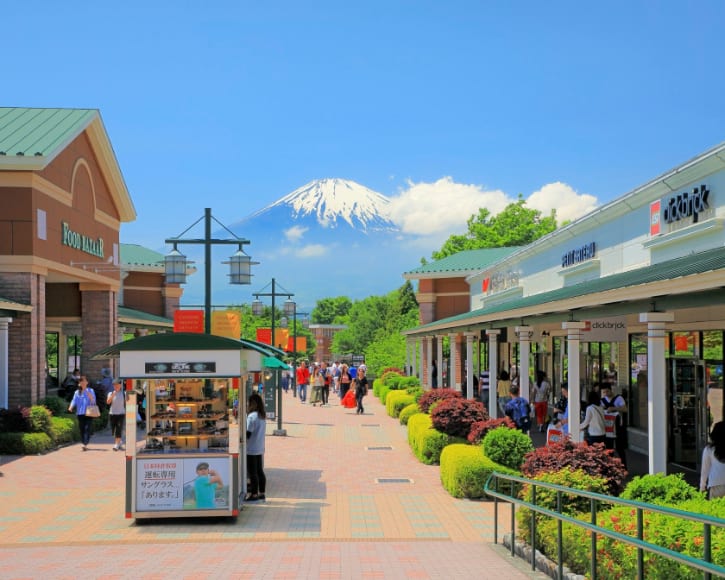
If your Mount Fuji day trip from Tokyo has a shopping agenda, Gotemba Premium Outlets is a top pick. This flagship mall is situated in Gotemba, offering a remarkable view of Mt. Fuji.
Unlike other shopping centers, this one is very huge , featuring over hundreds of stores and restaurants .
Go around the different stalls and find various international brands . There are plenty of fashion items , household goods , electronics , and sports stuff .
Aside from the shops, this mall comes with its own Ferris wheel, hotel, and hot spring bath.
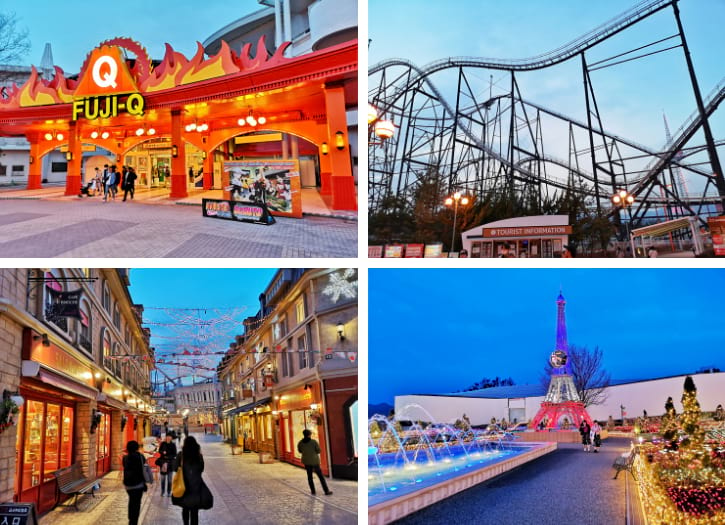
Fuji-Q Highland might not be as popular as Tokyo DisneySea or Tokyo Disneyland , but it’s definitely a must-visit amusement park .
Try the thrilling roller coasters that cater to all kinds of adventure-seekers . There are fast-paced as well as steep ones to fuel your adrenaline.
If you’re not a fan of scary rides, don’t worry because there are other options.
Be entertained by the themed attractions that are mostly based on famous anime series . You can also complete some mazes and enjoy traditional rides like carousel, teacup, and more.
To top it all, there are restaurants, souvenir shops, and rest areas.
And before you visit the park, it’s recommended that you book the admission tickets from website 1 or website 2 to save money.
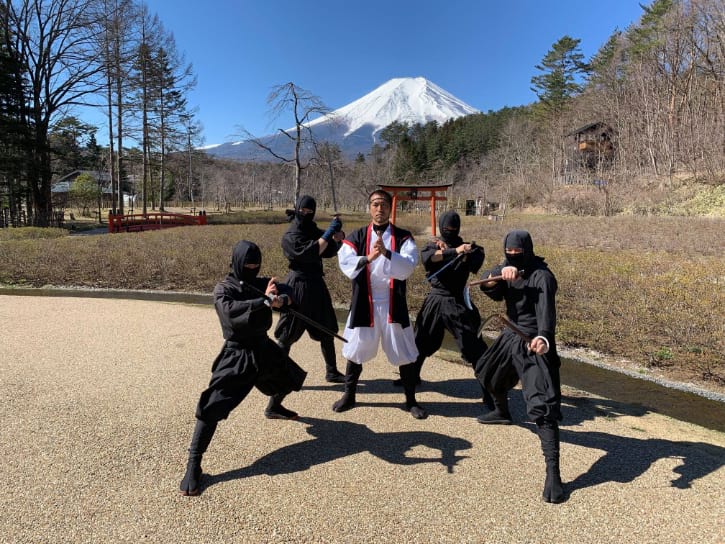
Drop by Oshino Ninja Village and witness some incredible ninja performances .
This scenic complex welcomes visitors with their one-of-a-kind presentations. And to make the shows even more exciting, they are all dressed up in character.
Be mesmerized by their amazing ninja fighting skills and techniques that are really fun to watch . While they are performing, you can also catch a glimpse of Mt. Fuji.
And if you have extra time, wander around the vast Japanese garden and enjoy the relaxing atmosphere.

Visiting Mt. Fuji between April and May? Don’t miss the Fuji Shibazakura Festival , one of the most anticipated annual events.
At this time, people flock to the Fuji Five Lakes area to witness the incredible landscape of Shibazakura .
Watch the beautiful combination of pink and purple hues that stretches up to 2.4 hectares of land.
The captivating flower scene is set against the unmatched backdrop of Mt. Fuji .
So, be ready to capture this spectacular sight or simply revel in the beauty straight from your eyes.
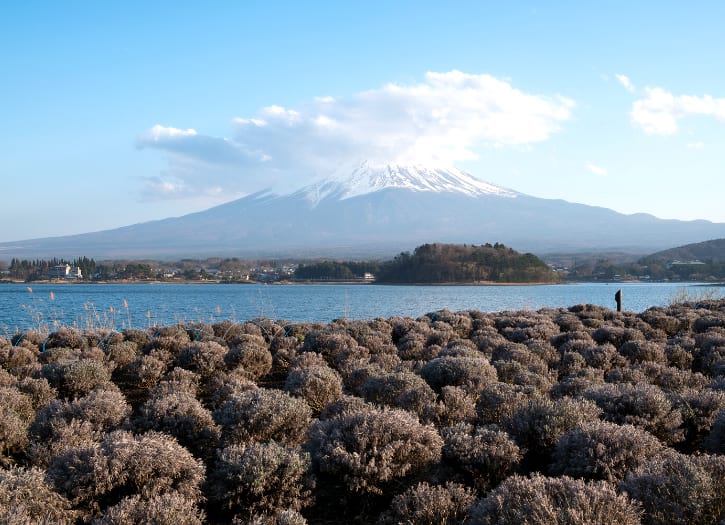
Stroll around Oishi Park and enjoy the picturesque nature views .
This park is very popular for its fields of lavender that are set near the panoramic Mt. Fuji and the pristine Lake Kawaguchiko.
Because of its gorgeous landscape, it has become a favorite among photographers .
And if you want to have a more amazing experience, try to visit the place during early summer . This is the best time to catch the Kawaguchiko Herb Festival and see the seasonal flowers in full bloom.
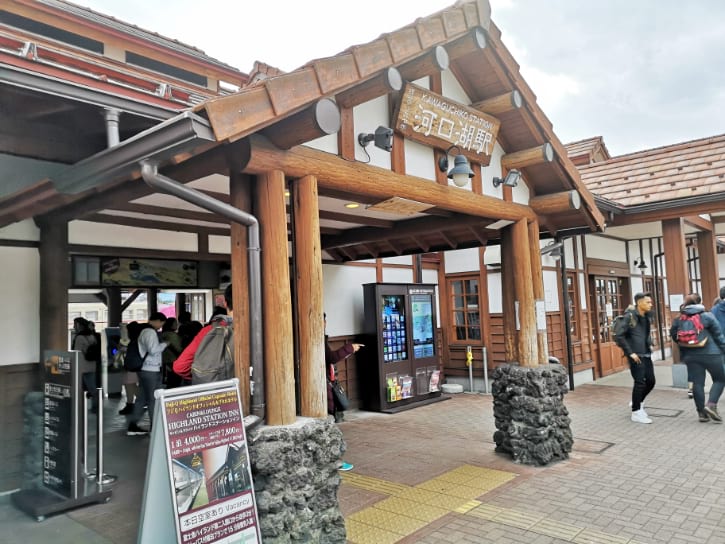
Once you reach Kawaguchiko Station from Tokyo, there are 5 types of buses to choose from. These buses help you get around the Mount Fuji area conveniently .
But be reminded that each bus covers different tourist spots. Don’t worry because I’ll explain everything in detail later on.
If you want to visit Chureito Pagoda , it’s highly recommended that you take a train instead. It’s the best and fastest way to reach the shrine. You can get more information about this option through point 6 written below.
1. Omni Buses
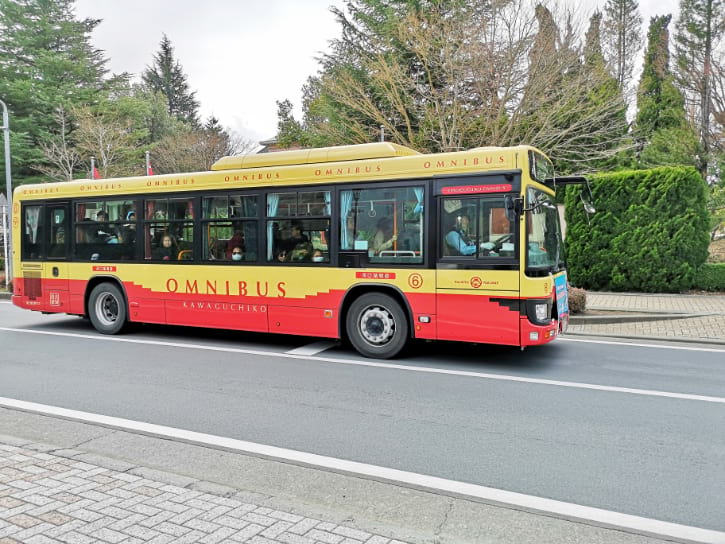
Omni buses have 3 lines , and these are Kawaguchiko Sightseeing Bus (Red-Line), Saiko Sightseeing Bus (Green-Line), and Narusawa/Shojiko/Motosuko Sightseeing Bus (Blue-Line). You can easily get on the buses upon arriving at Kawaguchiko Station.
If you want to save money, try to avail of the pass that offers unlimited use for all three lines.
You can use this pass for two consecutive calendar days . Each pass costs 1,700 yen .
- Red-Line: This bus covers major sights such as Kachi Kachi Ropeway, Kawaguchiko Music Forest, Oishi Park, and Fuji Q Highland
- Green-Line: For attractions like Kawaguchiko Herb Hall, Saiko Bat Cave (Lava Cave), and Lake Saiko, choose this one.
- Blue-Line: Take this if you want to visit Fuji Q Highland, Fujisan World Heritage Center, Fugaku Fuketsu (Wind Cave), Narusawa Hyoketsu (Ice Cave), and Lake Shojiko.
2. Fujikko-Go Bus
For those planning to go to Oshino Hakkai , Oshino Ninja Village , Fuji Q Highland , and around Lake Yamanakako , ride the Fujikko-Go Bus .
The two-day unlimited ticket for this bus is 1,700 yen per person.
3. Fuji-Subaru Line (Shuttle Bus)
If you want to reach Mt. Fuji 5th Station , take the Fuji-Subaru Line that is located at the Kawaguchiko Station. Then, get off the shuttle bus at the Fuji-Subaru Line 5th Station .
The one-way trip takes around 50 minutes while the bus fare is 1,780 yen . For the round-trip , it costs 2,800 yen .
4. Local Bus (Line A or Line C)/ Express Bus
Opt for the local bus (Line A or Line C) or express bus if you wish to go to Gotemba Premium Outlets .
If you choose the local bus , the single trip takes around 1 hour and 35 minutes and costs 1,540 yen .
For the express bus , the travel duration is about 1 hour and the price is 1,630 yen .
If the first or last stop of your trip to Mount Fuji is Gotemba Premium Outlets, you can visit this website . This will show you how to go from Tokyo and vice versa.
5. Shibazakura Liner (Shuttle Bus)
The last option is via the Shibazakura Liner (Shuttle Bus) . This bus takes you from Kawaguchiko Station to Fuji Shibazakura Festival for roughly 40 minutes . The fare costs 2,400 yen , which already includes the entrance fee and round-trip .
Do take note that the Fuji Shibazakura Festival is only best to explore from mid-April until the end of May . The rest of the days are no longer worth the visit.
6. Fujikyu Railway Line
As mentioned earlier, if you want to explore Chureito Pagoda , you should take the Fujikyu Railway Line .
Ride the train from Kawaguchiko Station to Shimoyoshida Station , which takes around 15 minutes . You have to pay 310 yen for this one-way trip .
I have prepared some sample day trip itineraries from Tokyo to Mount Fuji below to help you during your preparation.
Each itinerary will show you how long you should stay at each attraction . It also details out the ways on how to visit the places .
Also, don’t miss to check out my perfect 7 day Tokyo itinerary , which is very helpful for first-timers!
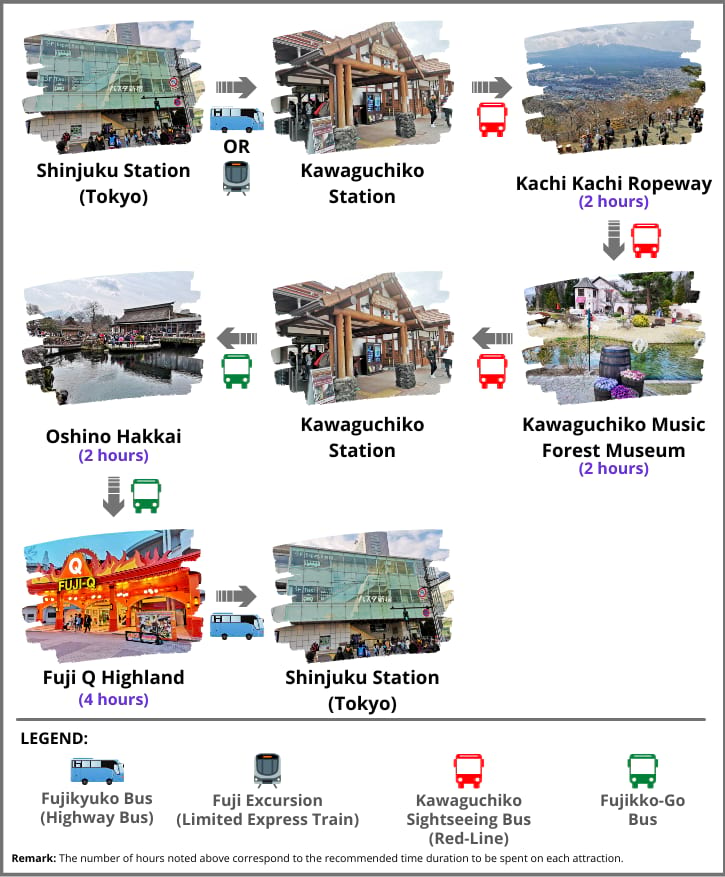
- Detailed Information for Option 1 Itinerary
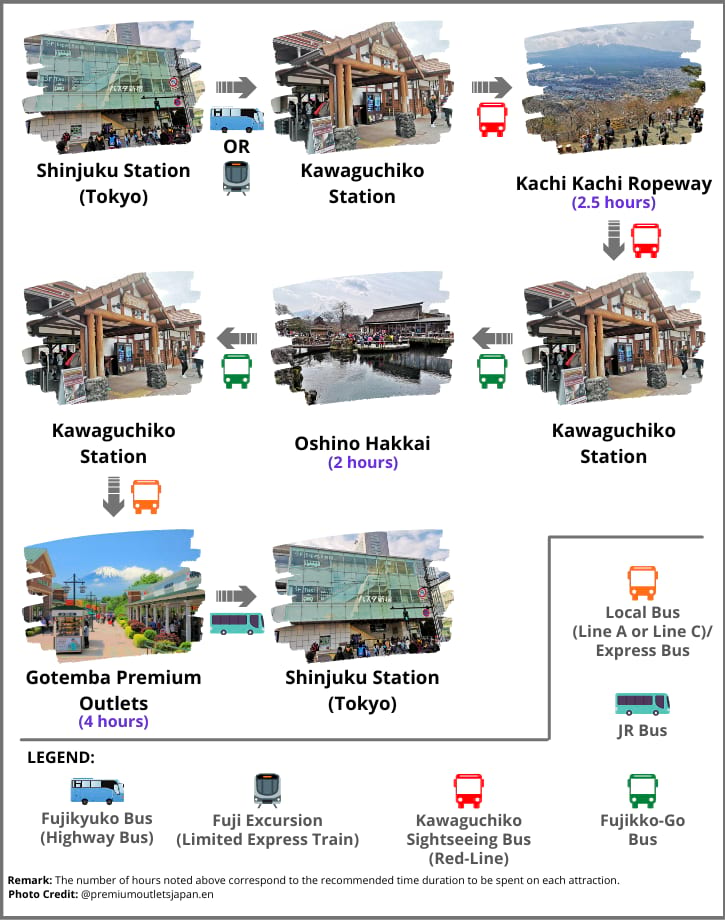
- Detailed Information for Option 2 Itinerary
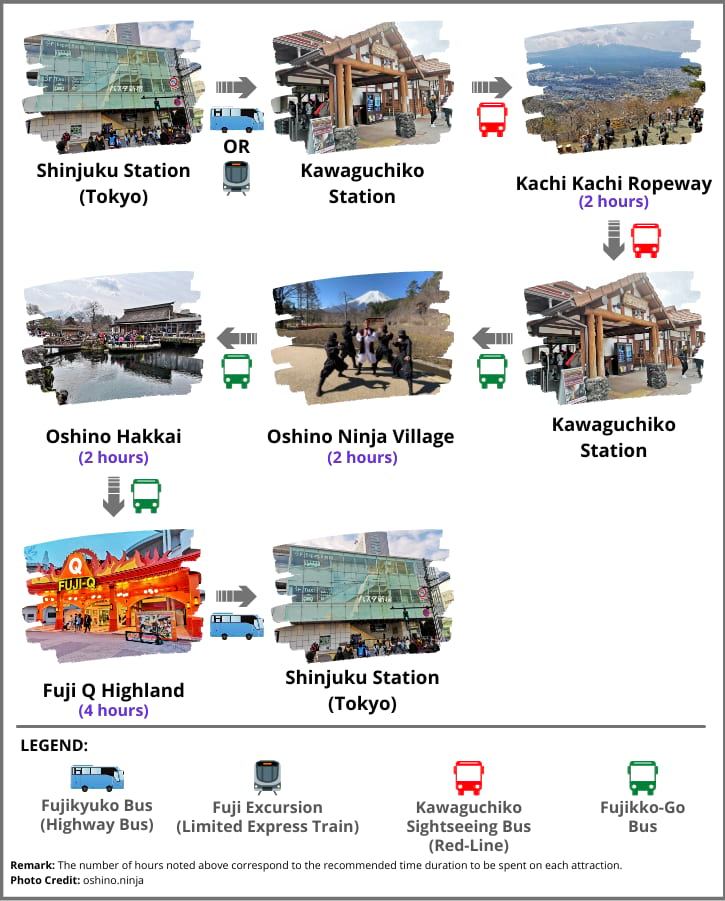
- Detailed Information for Option 3 Itinerary
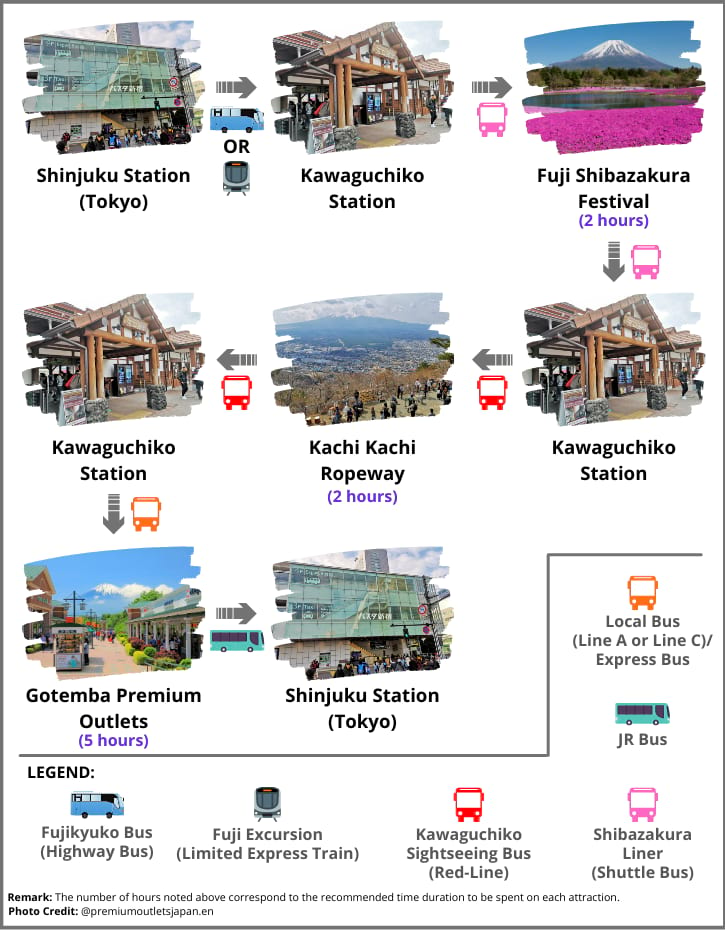
- Detailed Information for Option 4 Itinerary
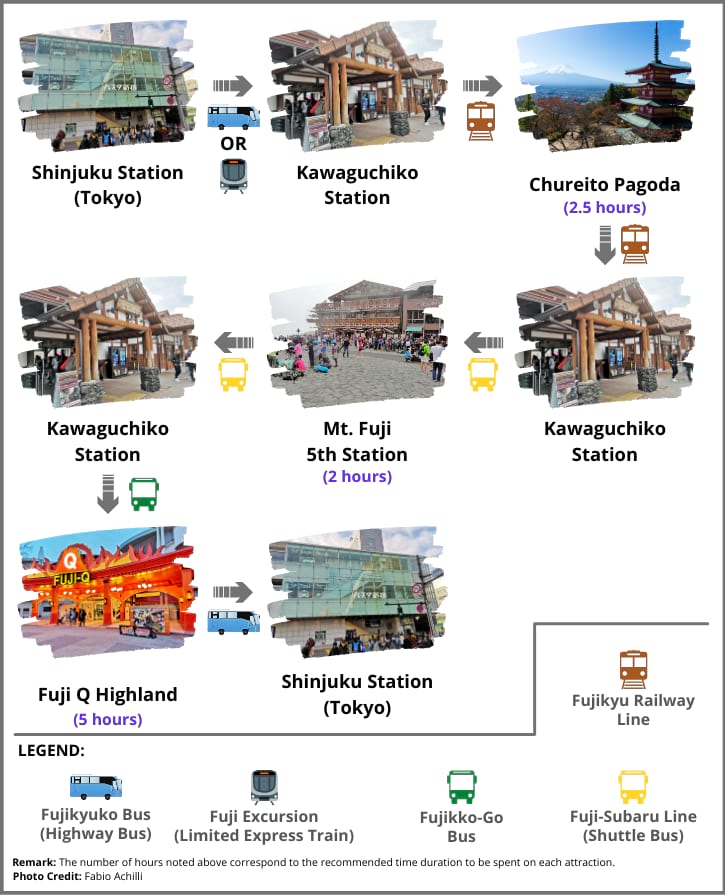
- Detailed Information for Option 5 Itinerary

Tokyo Itinerary: The Best 7-Day Guide for a Fantastic Trip

17 Best Things to Do in Shinjuku with My Perfect Itinerary

35 Best Things to Do in Tokyo You’ll Want to Go in 2024
28 thoughts on “tokyo to mount fuji: a complete day trip guide for you”.
Hi! May I know can I board the Omni Red Line bus from the midway bus stop at Kachi Kachi Ropeway to Kawaguchiko Living Center (Oishi Park) instead of starting at Kawaguchiko Station? Additionally, am I able to use my Pasmo card for this journey without the need to purchase a pass?
Hi Jamie, you can board the Omni Red Line bus at Kachi Kachi Ropeway; there’s no need to start at Kawaguchiko Station. However, you can’t use your Pasmo card on this bus. Instead, you’ll need to purchase a pass directly from the bus driver when you get on.
hi, I love the detailed itinerary – can you suggest a route if we want to visit these places only, we plan to go by January Thanks in advance! > GOTEMBA OUTLET > LAKE KAWAGUCHI > OSHI NO HAKKAI > CHUREITO PAGODA
Hi radgj, I suggest the following route for your day trip: Shinjuku Expressway Bus Terminal > Odakyu Bus/ JR Bus > Gotemba Premium Outlets > Limited Express Bus > Kawaguchiko Station > Red Line Bus > Lake Kawaguchi > Red Line Bus > Kawaguchiko Station > Fujikko-Go Bus > Oshino Hakkai > Fujikko-Go Bus > Kawaguchiko Station > Highway Bus/ Fuji Excursion > Shinjuku (Tokyo).
Organizing these four places into one day trip is difficult due to the considerable distances between them, which results in longer commute times.
Hi! Thank you for the useful information and itinerary suggestions! I saw in an earlier comment that Pasmo cards (i assume Suica as well) are not usable for Omni. Are they not usable for all bus types apart from the local buses?
Yes, Pasmo and Suica cards cannot be used for Omni and other bus types, except local buses.
Hi Josh, Can you suggest a route for these places that we are planning to visit as a day trip. Thanks in advance Lake Kawaguchi Oshino Hakkai Chureito Pagoda Mt fuji Panoramic Ropeway Kawaguchiko Music Forest Museum
Here’s my suggested route for you:
Kawaguchiko Station > Red Line Bus > Lake Kawaguchi > Walk to Mt Fuji Panoramic Ropeway Station > Red Line Bus > Kawaguchiko Music Forest Museum > Kawaguchiko Station > Fujikko-Go Bus > Oshino Hakkai > Fujikko-Go Bus > Mt. Fuji Station > Take Highway Bus or Fuji Excursion Limited Express Train to return to Tokyo
I didn’t include Chureito Pagoda in my suggested route because this attraction requires more time, and I don’t think it can be visited with the above attractions in one day.
Hi, thank you so much for the information! Could you please suggest a route if we want to visit these places only for a day trip, we plan to go in the end of Nov. Thank you so much! 1. Kachi Kachi Ropeway 2. Oishi park 3. Oshino ninja village 4. Chireito pagoda
Sorry for my late reply.
Here you go: Kawaguchiko Station > Red Line Bus > Kachi Kachi Ropeway > Red Line Bus > Oishi Park > Red Line Bus > Kawaguchiko Station > Fujikko-Go Bus > Oshino Ninja Village > Fujikko-Go Bus > Mt. Fuji Station > Fujikyu Railway Line > Shimoyoshida Station > Walk > Chireito Pagoda > Walk > Shimoyoshida Station > Fujikyu Railway Line > Mt. Fuji Station > Use the Highway Bus or Fuji Excursion Limited Express Train for your journey back to Tokyo
Hi Josh, l going to Tokyo soon and also travel to Nikko and Mt Fuji area. I already have esim and wonder it’s necessary to carry a portable WiFi since on the outskirts the signal will be weak. Please advise and thank you!
Hi Tom Quah, you should be good to go with your eSIM as long as it can connect to the internet. This way, you won’t have to bother carrying a portable Wi-Fi device.
HI, Can you suggest a day trip itinerary to mount fuji by car and then we will continue our journey to Matsumoto. I’m not planning any shopping for this trip if possible . Thanks in advance
Hi Suria, I recommend this driving route for you: Start at Kachi Kachi Ropeway, then head to the Kawaguchiko Music Forest Museum, followed by Oshino Hakkai, and finish at either Chureito Pagoda or Fuji-Q Highland. Hope you like it!
Can you suggest an itenary for Lake Kawaguchi Mt Fuji 5th Station Oshino Hakkai Ropeway Gotemba Outlet
And any tour that includes above.
Thanks Rohit
Hi Rohit, It’s challenging to visit all the places you’ve listed in one day, as some are quite far apart.
Here’s my suggested itinerary for you:
- Start at Kawaguchiko Station
- Take the Red Line Bus to Lake Kawaguchi
- Walk to the Ropeway
- Return to Kawaguchiko Station via Red Line Bus
- Board the Fujikko-Go Bus to Oshino Hakkai from Kawaguchiko Station
- Take the Fujikko-Go Bus back to Kawaguchiko Station
- Catch the Limited Express Bus to Gotemba Premium Outlets
- From Gotemba Premium Outlets, return to Shinjuku Expressway Bus Terminal via JR BUS
For a day tour, consider the popular Mt. Fuji tour covering Mt. Fuji 5th Station, Lake Kawaguchi, Oshino Hakkai, and Gotemba Premium Outlets.
If you’re going on a trip with a group or family, check out the Mt. Fuji private one-day tour . It’s great because you can customize your itinerary to your preference.
Hi Josh, I’m planning to visit Oshino Hakkai, Ropeway and Lake Kawaguchiko boat ride. If I’m taking the Fuji Excursion Limited Express train, would it make more sense to alight at Mt Fuji station instead of Kawaguchiko station and take the bus there to Oshino Hakkai?
Yes, you’re correct.
For option 2, if I remove Gotemba premium from the itinerary, will I be able to reach Tokyo before 4 pm? I will take the first trip from Shinjuku to to Kawaguchiko.
Hi Jess, I think it should be okay, but it’ll be a bit rushed. You need to make sure to reach the Kachi Kachi Ropeway (Mt. Fuji Panoramic Ropeway) by 9:00 AM and perhaps plan to stay there for about 1.5 hours before heading to another destination.
For your return trip to Tokyo, you should take the highway bus, as the first Fuji Excursion train from Kawaguchiko Station doesn’t leave until 3:03 PM.
If you’re rushing for a flight on that day, then I wouldn’t suggest visiting Mt. Fuji
Hi Josh: I had bought Fuji Hakone 3 days pass. I will go to mount fuji from shinjuku. I will stay a night at mount Fuji and travel to Hakone the next day. Here are the places that i wish to visit: Lake Kawaguchi Mt Fuji 5th Station Oshino Hakkai Ropeway Gotemba Outlet Can you please give me some guide? Is Fuji Hakone pass will allow me to take any type of buses or train? Thank you in advance for your help. Sim
Hi Hui Hui,
I would recommend following this route: Day 1: Kawaguchiko Station > Fuji Subaru Line Bus > Mt Fuji 5th Station > Fuji Subaru Line Bus > Kawaguchiko Station > Red Line Bus > Ropeway > Walk > Lake Kawaguchi > Red Line Bus > Kawaguchiko Station > Fujikko-Go Bus > Oshino Hakkai > Fujikko-Go Bus > Kawaguchiko Station/ Mt. Fuji Station Day 2: Traveling from Kawaguchiko Station to Gotemba Outlet via the Limited Express Bus
I haven’t personally used the Fuji Hakone Pass before, and I found that it doesn’t cover much of the transportation in the Fuji area. I believe it doesn’t include the Red Line Bus and Fujikko-Go Bus.
Im planning to visit the following mid dec 2023. How should i plan it. is it feasible to do all and able to catch the highway bus back (6.35pm)
Chireito pagoda Lake Kawaguchi Oishi Park Honcho street Kachi Kachi Ropeway Oshino Hakkai
Thank you so much Jac
Hi Jac, I’ve decided to skip Oishi Park in the itinerary since it’s quite far from Chureito Pagoda, Honcho Street, and Oshino Hakkai. I don’t think it’s feasible to visit all these places in one day. So, here’s my alternative suggested route for you. I hope you find it helpful.
Kawaguchiko Station > Red Line Bus > Kachi Kachi Ropeway > Red Line Bus > Kawaguchiko Station > Fujikyu Railway Line > Shimoyoshida Station > Walk > Chireito Pagoda > Walk > Honcho Street > Walk > Shimoyoshida Station > Fujikyu Railway Line > Mt. Fuji Station > Fujikko-Go Bus > Oshino Hakkai > Fujikko-Go Bus > Mt. Fuji Station > Going Back to Tokyo.
Hi Josh, thank you so much for the information! Could you suggest a route if we want to visit these places only for a day trip, we plan to go on mid January. Thank you so much! 1. Kachi Kachi Ropeway 2. Oishi park 3. Oshino Hakkai 4. Chireito pagoda 5. Kawaguchiko Music Forest Museum
I didn’t include Chureito Pagoda in the itinerary because it’s quite far from the other four places. I don’t think it’s possible to cover all of them in one day. Here’s my suggested route instead. I hope you’re fine with this change.
Kawaguchiko Station > Red Line Bus > Kachi Kachi Ropeway > Red Line Bus > Kawaguchiko Music Forest Museum > Red Line Bus > Oishi Park > Red Line Bus > Kawaguchiko Station > Fujikko-Go Bus > Oshino Hakkai > Fujikko-Go Bus > Mt. Fuji Station > Return to Tokyo.
Hi Josh, thank you so much for the information! Could you suggest a route if we want to visit these places only for a day trip, we plan to go next week. Thank you so much! 1. Honcho street 2. Oishi park 3. Oshino Hakkai 4. Chireito pagoda 5. FujiQ highland 6. Arayayama Shrine
It’s quite challenging to visit all the suggested places in just one day trip. Below is the itinerary I recommend:
Kawaguchiko Station > Red Line Bus > Oishi Park > Red Line Bus > Kawaguchiko Station > Fujikko-Go Bus > Oshino Hakkai > Fujikko-Go Bus > Mt. Fuji Station > Fujikyu Railway Line > Shimoyoshida Station > Chireito Pagoda > Honcho Street > Shimoyoshida Station > Fujikyu Railway Line > Kawaguchiko Station/ Mt Fuji Station > Highway Bus > Head back to Tokyo
Leave a Comment Cancel reply
Send me an email when the author replied my comment. (Please take note your comment only will show on this blog post after approved by me to prevent spam comments.)

From Tokyo to Mount Fuji: 4 Best Ways to Get There
Written by Diana Bocco Updated Jul 13, 2022 We may earn a commission from affiliate links ( )
Japan's highest volcano and most beloved mountain is a popular destination for visitors. But getting to Mount Fuji from Tokyo can be tricky and often requires transportation changes and several hours of travel.
Most people visiting Mount Fuji are actually heading to the mountain's 5th Station , located at an altitude of over 2,300 meters above sea level. This is Mt. Fuji's best lookout point for non-climbers, from where you'll get a direct view of the snow-covered summit and the surrounding mountains.
Whether you're looking for speed, convenience, amazing views, or extra stops along the way, here are the best ways to get from Tokyo to Mount Fuji.
On This Page:
- From Tokyo to Mount Fuji by Private Tour
- From Tokyo to Mount Fuji by Bus
- From Tokyo to Mount Fuji by Train
- From Tokyo to Mount Fuji by Group Tour
1. From Tokyo to Mount Fuji by Private Tour
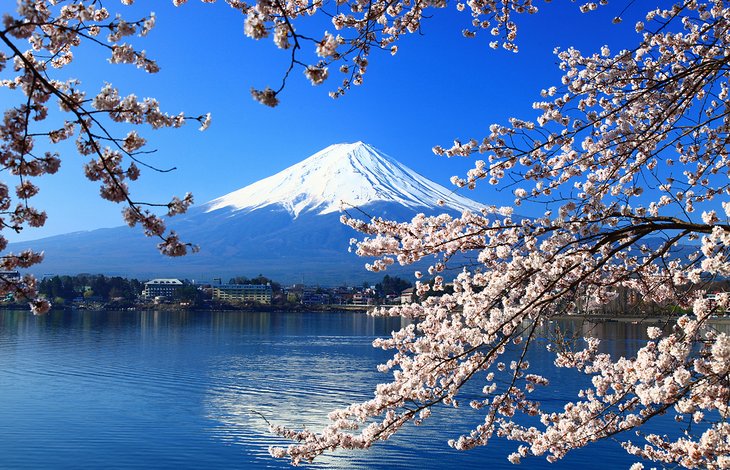
For the ultimate Mt. Fuji experience, nothing beats a tour you can design on your own so you can decide where to go, how long to spend in each place, and when to get back. Even better, the tour can be organized for a single person or a small group, depending on how many people you're traveling with.
The 10-hour Private Full-Day Sightseeing Tour to Mount Fuji and Hakone starts right at your hotel's door, where a limo or van will take you and your group to Mt. Fuji's 5th Station, Lake Kawaguchi, Hakone, and nearby attractions.
You decide how long you spend in each place; if you're unsure, the driver will recommend options, such as heading to Komitake Shrine for unobstructed views over stunning blue Lake Yamanaka and stepping on the observation deck at Mount Tenjo (reached after a 400-meter ascent via the Kachi Kachi ropeway cable car) for panoramic views of Mt. Fuji.
Hanoke, famous for its hot springs and the beautiful Lake Ashinoko, is another must-see, as is Lake Kawaguchi and the beautiful surrounding resort area. During the summer, you can take a cruise through the lake for beautiful views of Mt. Fuji. The driver will bring you back to your hotel at the end of the day.
2. From Tokyo to Mount Fuji by Bus
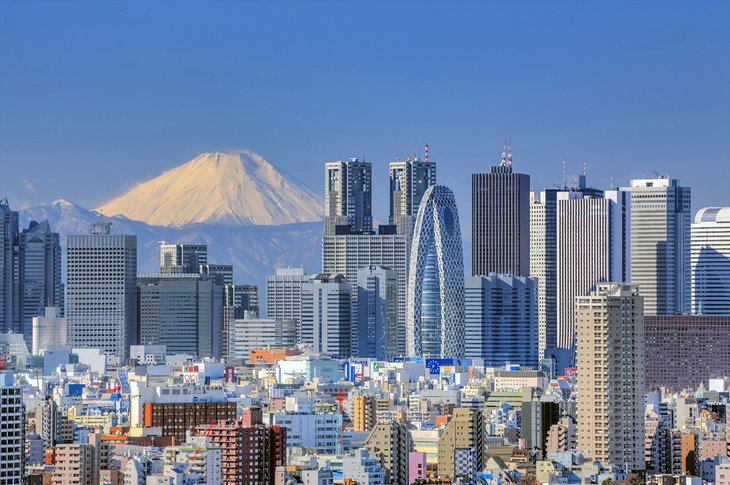
The easiest and cheapest way to reach Mt. Fuji from Tokyo is by bus – but you'll miss out on some of the stunning views along the way.
Tokyo (and greater Tokyo) has several bus stations, so it's important you head to the right one when planning a trip. Most visitors leave from the main Tokyo station just because it's easier to reach and less complicated to maneuver.
From here, you can catch a direct bus between 6:20am and 9:20pm to the Mt. Fuji area. Depending on traffic, the journey takes between 2 and 2.5 hours . Keep in mind that there are more buses in the morning than in the afternoon, so plan well.
These buses take you to the broader Fuji area and offer four main stops there: Kawaguchiko Station (well-known for its lakes and easy hiking trails), Fuji-Q Highland (where you'll find a world-famous thrill-ride amusement park), and Lake Yamanakako station. Where you get off depends on what you want to explore, but keep in mind none of these stops is exactly at Mount Fuji itself.
To get to the Fuji Subaru Line 5th Station – the lookout point and Mt. Fuji Basecamp, from where all the hikes that follow the Yoshida Trail up the mountain start – you'll need to take a second bus. Just get off at Kawaguchiko Station and grab a local bus for an additional 50-minute ride. Local buses run every hour and are usually marked, so you won't miss them.
If you're traveling to Mount Fuji during climbing season (July to mid-September), there's a direct bus from Shinjuku Expressway Bus Terminal (located in Greater Tokyo, outside the city center) to the 5th Station. The journey takes 2.5 hours, and the buses fill up quickly, so it's better to make a reservation in advance on the Highway-buses.jp website.
3. From Tokyo to Mount Fuji by Train
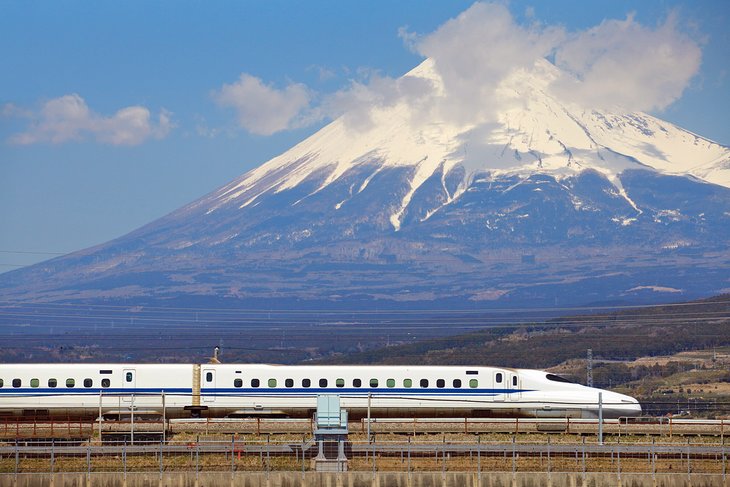
There are regular year-round trains from Tokyo to the Mount Fuji area. And while trains cost more and take an hour longer than buses , they also offer stunning views of mountains and lakes along the way.
The best train option available is the Fuji Excursion Limited Express train , which runs from Tokyo's Shinjuku Station (considered the world's busiest railway station) to the Kawaguchiko stop. Please keep in mind that once you get off there, you'll still need to grab a local bus if your final destination is the Subashiri 5th Station.
The Fuji Excursion Limited Express train departs from Shinjuku only in the mornings, twice on weekdays and three times on weekends, starting as early as 7:30am. The return trips are not very late, with the latest train departing from Kawaguchiko Station at 5:38pm on weekends.
This means you won't have much time to explore upon arrival and will have to plan everything well to fit all the sights into the limited time slot.
There are a number of additional train connections that can get you to the Fuji area, but all require switching along the way, plus a bus at the end. If you have your heart set on taking the Shinkansen (bullet train) while in Japan, this might be the right time. The bullet train doesn't take you to Mt. Fuji's 5th Station, but it will take you to a nearby area with some of the best views of the mountain.
Using your JR pass (Japan Rail pass), board the Tokaido Shinkansen train in Tokyo and travel to Odawara Station. Here, switch to a local Hakone Tozan train and get off at the Hakone-Itabashi station. The Fuji's Five Lakes park lies at the northern base of Mount Fuji and offers some of the best views of the mountain.
4. From Tokyo to Mount Fuji by Group Tour
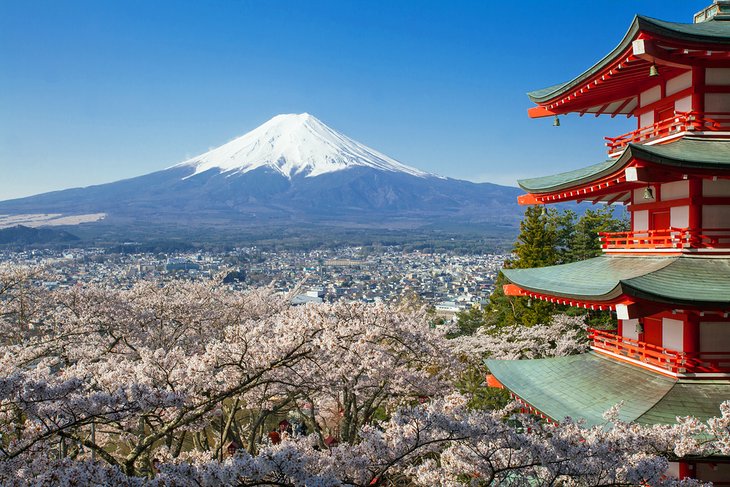
If you want to experience more of Japan's stunning natural beauty in one day, a tour that combines Mt. Fuji with a stop at Lake Ashinoko might be a good option.
The 10-hour Mt. Fuji & Hakone One-Day Tour starts in the morning at a central pickup point in Shinjuku City, Tokyo's buzzing commercial center and "Skyscraper District." From here, the van will head straight to Mount Fuji's 5th Station, where you will have some time for pictures and a quick bite at the local restaurant.
From here, the tour continues on towards Owaku-dani Valley, an active volcanic area, where visitors can see bubbling pools, hot springs, and steam vents. Next on the schedule is the Hakone Ropeway, a cable car that takes you up a volcanic mountain to the shores of Lake Ashi.
The final stop on the tour is Lake Ashinoko, where you can enjoy a relaxing cruise with views of Mt. Fuji. The van will then drop you off near Shinjuku Station or at Odawara Station if you choose to return to Tokyo via Bullet Train.
More Related Articles on PlanetWare.com
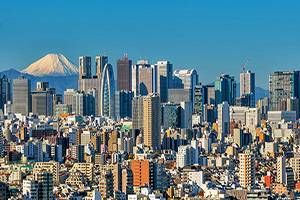
What to See and Where to Stay in Tokyo : Tokyo is worth taking the time to explore. With so much to see and do, it can seem overwhelming for new visitors. Hit the ground running with our list of the top attractions in Tokyo .

More on Japan

- Tokyo Cheapo (繁體中文)
For the Views: 10 Best Mt. Fuji Tours
So you want to go on a Mount Fuji tour while you’re in Japan? Well you’re in luck, because there are lots of different tours that will take you from Tokyo to Mt. Fuji as a day trip. But the thing is, the sheer number of options is overwhelming (and confusing). To save you some time, we’ve rounded up the very best Mt. Fuji tours out there.
3 tips for choosing the best Mt. Fuji tour
There are a few things you need to know before booking your Mt. Fuji tour.
1. Don’t book too far in advance
You need nice clear weather to get the best views of Mt. Fuji — if it’s even a little cloudy, you might not see anything! Trust us, we know from experience. So, the best thing to do is to check the weather forecast and book your tour no more than a week in advance . This is where the huge variety of tours really helps, because there’ll always be something available.

2. Avoid peak times
On a similar note, try to avoid booking a tour on weekends or during holiday periods . Not only will prices likely be higher, but it will also be more crowded. Traffic jams often happen, and if you’re on a bus tour this can add several hours to your journey time, both ways.
3. Decide whether you want a view OF or a view FROM Mt. Fuji
Finally, decide whether you want to go up Mt. Fuji or just look at it. Tours that go up Mt. Fuji usually stop at the 5th Station (about halfway up), unless they’re specifically a climbing Fuji tour. And while you get to say that you stood on Mt. Fuji, the view isn’t actually that impressive. If you want to get the best views, then there are plenty of other iconic photo spots and viewing areas you can visit instead.
The best Mt. Fuji tours, compared
Here’s a quick comparison of some of the most popular Mt. Fuji day-trip tours from Tokyo, so you can see how much they cost and what they include. Note that some charge per person, while others charge per group.

1. Most scenic: Lake Kawaguchi & views of Mt. Fuji tour
¥ 12,300 to ¥ 15,800 per person Book here Lunch upgrades available
This one-day bus tour takes the top spot for the most scenic tour of the Mt. Fuji area. You’ll visit the iconic Chūreitō Pagoda and (weather permitting) snap your own version of the above photo.
Next, you’ll have a lunch break near Lake Kawaguchi , before heading to Oishi Park . The park is known for its seasonal flowers, and the fantastic view of Mt. Fuji across the lake.
The final stop is Saiko Iyashi no Sato Nenba (also known as Healing Village). This open-air museum is on the site of an old farming village that was destroyed by a landslide in 1966. It was reconstructed, and the old thatched-roof houses were converted into museums, galleries, and shops. It’s a great spot to pick up handcrafted souvenirs, and of course there’s another chance to take a good photo of Mt. Fuji.

The tour includes round-trip bus transport from Tokyo. There are two pick-up locations: one in Shinagawa and one in Shinjuku. However, at the end of tour there is only one drop-off point, which is in Shinjuku.
The tour bus is large and comfortable, and along the way the guide will share information about the history of the sites in English. We recommend upgrading to include lunch, because there aren’t many other cafés or restaurants near the lunch stop. Otherwise, you can pack your own lunch and picnic by the lake to save a bit of money.
2. Best of both worlds: Hakone & Mt. Fuji 5th Station tour
¥ 19,488 to ¥ 21,539 per person Book here Lunch upgrades available (vegetarian and halal meals on request)
This tour gives you the best of both worlds — you’ll get stunning views and also get to step foot on Mt. Fuji itself. Your first stop is Mt. Fuji’s 5th Station, about halfway up the mountain. From here you can look out over the Fuji Five Lakes, but it’s not the best place to view the mountain itself.
Next, you’ll head to Shinobi No Sato Ninja Village, a ninja theme park. You’ll have lunch there, and then finish off the day with a visit to the Hakone area . Hakone is known for its natural beauty and — if the weather is good — a great view of Mt. Fuji.

On this tour, you depart Tokyo by bus from pick-up locations in either Shinjuku or Ginza. Included in the price is a return Shinkansen ticket to get you back at the end of the day.
There is WiFi on the bus, and there are multilingual audioguides available. If you upgrade to include lunch, it’s a buffet style all-you-can-eat affair. Vegetarian and halal options are available, but make sure to request them when booking.
3. Hot spring visit and Mt. Fuji tour
¥ 7,800 per person Book here
If a day of relaxation is more up your alley, then you’ll like this one. Your guide will take you to an onsen (hot spring) spa near Lake Yamanaka, where you can soak away your troubles.
First, though, you’ll check out Lake Kawaguchi for postcard-perfect views of Mt. Fuji. You’ll also visit the legendary Chūreitō Pagoda, or — depending on the time of year and weather — the 5th Station of Fuji itself.
This tour includes round-trip travel from Tokyo Station or Shinjuku Station. However, lunch isn’t included, and you’ll also need to pay a bit extra for the hot spring entry ticket.
4. Shop till you drop: Gotemba Premium Outlets & views of Mt. Fuji tour
¥ 6,599 per person Book here
If a shopping trip with views of Mt. Fuji sounds like your kind of thing, then this one-day tour is perfect. First, you’ll head to Gotemba Premium Outlets , where you’ll have two hours of free time to shop your heart out, and grab some lunch too. Gotemba Premium Outlets is an open-air mall with over 200 shops selling luxury and brand-name goods at bargain prices. You can also relax in a hot spring there.
In the afternoon, you’ll stop by Oshino Hakkai (the famous Fuji ponds) and Lake Kawaguchi to take in some lovely views of Mt. Fuji.
The tour includes round-trip bus transport from Ginza.
5. Best for families: Private & customizable Fuji tour
¥ 65,835 per group (up to five people) Book here
For families, you can’t beat the convenience of a private Mt. Fuji day-trip tour from Tokyo. This particular one is great because it’s also fully customizable. An English-speaking driver will take you to some of the most famous sites around Mt. Fuji and even up to the 5th Station, if you like.
You’ll be picked up from your Tokyo hotel in an airconditioned vehicle, and dropped back off at the end of the day. The vehicle has free WiFi, and you can also request a child seat. We like that this particular tour is also stroller, wheelchair, and service-animal friendly.
6. Canoeing tour with Mt. Fuji views
¥ 5,500 per person Book here
This small group canoe tour is perfect for all the sporty types out there. Rise bright and early for a 7 a.m. paddle around Lake Kawaguchiko with a professional guide, and drink in the spectacular views of Mt. Fuji while you’re at it.
The experience lasts for 90 minutes, and because of the early start it’s best suited for people who are already staying near Kawaguchiko . Also keep in mind, that the tour needs a minimum of two participants to go ahead.
7. Great in all seasons: Mt Fuji 5th Station & fruit-picking tour
¥ 10,898 per person Book here Lunch included (vegetarian on request)
This tour has a great range of activities that are perfect for a wonderful experience year-round. First, you’ll visit a farm in Yamanashi Prefecture to pick seasonal fruit — for example, grapes in fall or peaches in summer. Then it’s on to Oishi Park, known for its view of Mt. Fuji and beautiful flowers. In spring and fall, you might visit different locations that are known for their cherry blossoms or autumn leaves instead.
For lunch, you’ll have hōtō , a popular noodle dish from the Mt. Fuji area. Finally, in the afternoon you’ll take a ride on th Mt. Fuji Panoramic Ropeway and visit Mt. Fuji 5th Station.
Bus pick-up and drop-off from Shinjuku is included in the tour. WiFi is available onboard. Lunch is also included, and there are vegetarian options available on request.

8. Once in a lifetime: Helicopter tours to Mt. Fuji
¥ 320,000 per group (up to three people) Book here
For that once-in-a-lifetime, burn-through-money, not-at-all-sustainable experience, you can’t top a helicopter tour to Mt. Fuji. This one is a 70-minute round-trip from Tokyo, with the route changing depending on the weather — so you know you’ll get a good view, regardless. You’ll also get an aerial look at Tokyo, so keep your eye out for iconic sights like Tokyo Tower .
9. Best Mt. Fuji trekking tour (summer only)
¥ 175,000 per group (up to nine people) Book here
Want to climb Mt. Fuji but not sure where to start? Then this is the tour for you. You’ll hike from the 5th Station to the 7th Station under the watchful eye of an experienced, English-speaking guide. There is also the option to continue to the summit, if you’re so inclined.
The tour includes pick-up and drop-off from your Tokyo hotel in a private, airconditioned vehicle. Snacks and drinks are also included. This tour is charged at a flat rate of ¥ 175,000 per group of up to nine people — so get some friends together to make the most of it.

10. Ski & snowboard tour to Mt. Fuji (winter only)
From ¥ 12,940 per person Book here
Not into climbing Mt. Fuji? What about skiing or snowboarding on it instead? With this tour, you can do just that. We highly recommend it for beginners because it takes the hassle out of planning a ski trip. Plus, you get to boast that you learnt to ski on Mt. Fuji. Just be sure to get in quickly — this package has limited availability .
The basic package includes a round-trip bus ride from Tokyo to Fujiyama Snow Resort Yeti , and you can upgrade to include equipment and clothing rental, lessons, and lift passes. Prices start at ¥ 12,940 per person for the basic package, and go up to ¥ 25,060 per person for the full package.
Mt. Fuji tours: Frequently asked questions
Is a mt. fuji tour worth it.
For most travelers, yes. A Mt. Fuji tour from Tokyo is an easy, convenient and cost-effective way to see the mountain and surrounding areas in one day. Everything is arranged for you, so all you have to do is hop on the bus or into the car, and enjoy the sightseeing.
Should I upgrade my tour to include lunch?
Yes, we definitely recommend upgrading to include lunch in your tour. Attractions in the Mt. Fuji area are quite spread out, so there’s no guarantee there’ll be other dining options nearby — it’s much easier to go along with your group to a pre-booked restaurant. However, if you have special dietary requirements or preferences, confirm with your tour provider beforehand, because they might not be able to cater to your needs. If this is the case, or you just want to save some money, packing your lunch is always a good option.
When is the best season to see Mt. Fuji?
Winter is the best time to visit if you want to see the iconic mountain. If you’d like to climb Mt. Fuji , you have to wait for the official climbing season (usually July to September). If you visit during fall or spring you’ll be treated to some lovely seasonal scenery, but you might not be able to see Mt. Fuji clearly.

Can you take a bus up Mt. Fuji?
You can get a bus as far up Mt. Fuji as the 5th Station. During the climbing season there are frequent buses from Kawaguchiko Station , and there is also a direct bus from Shinjuku. The buses are less frequent during other parts of the year.
To find out more, check out our full guide on how to get from Tokyo to Mt. Fuji .
Is Mt. Fuji a good day trip from Tokyo?
Mt. Fuji is a good — and very popular — day trip from Tokyo. But we’ll be real with you: it’s a long day, with most tours lasting 10 or more hours, including the round-trip transport from Tokyo. If you’ve got the time, we recommend spending a night or two in the Mt. Fuji area . It’s more relaxing, and there’ll be more chances for Mt. Fuji spotting.

When is the best time to book a Mt. Fuji tour?
If you’re planning to book a Mt. Fuji day-trip tour, we recommend booking about a week in advance. This is because if the weather is bad, your chances of seeing Mt. Fuji are next to nothing — and weather forecasts just aren’t accurate enough much further in advance.
Check the weather a week ahead and book accordingly. Don’t worry too much about tours selling out; there are lots to choose from, so even if our top picks are sold out there’ll probably be something else just as good available.
While we do our best to ensure it’s correct, information is subject to change.
- Day trips from Tokyo
- Family friendly
- Sightseeing
Get our Tokyo Cheapo Hacks direct to your inbox

A Beginner's Guide to Shibuya - Scramble Crossing, Shopping & Great Views!

A Guide to ALL Pokemon Centers in Tokyo, Japan

Asakusa: A Guide to Tokyo's Traditional Center

Hidden Gems: Tokyo's BEST Underrated Shrines and Gardens

24 Hours in Tokyo — The Ultimate Itinerary Guide

Narita Airport to Tokyo

Tokyo Sumo Guide: When and Where to Experience Sumo Wrestling

7 Things To Do in Harajuku's Hottest New Attraction, Harakado
From rooftop bars to public baths, art spaces, and more — there's lots to keep you busy.

New Video! Hidden Gems: Tokyo's Most Underrated Shrines and Gardens
Tokyo is often described as busy, crowded and futuristic, but there are also traditional shrines and gardens where you can swap the hustle and bustle of the city for peace and quiet.

3 Hidden Sound, Art and Poetry Experiences in Tokyo
A different way to tune into the city.

New Video: Top 20 Things to Do in Shinjuku
You'll need more than a day — there are LOTS of things to try!

6 Spectacular Spring Flower Festivals Around Tokyo
Move over, cherry blossoms! These other blooms will take your breath away well into late spring.

English-Speaking Hospitals in Tokyo — And How To Visit Them
Absolutely everything you need to know about seeing a doctor in Japan.

Yozakura: 8 Best Nighttime Cherry Blossom Illuminations in Tokyo
Light-ups have been extended, since the blossoms were so late this year.

Updated Forecast: 2024 Tokyo Cherry Blossom Dates
They've been teasing us — but looks like they're about to bloom, at last.

April 2024: 5 Events Not To Miss in Tokyo
A chance to see the infamous "penis festival", puppies, processions, and more!

Mega Guide: 24 Best Places to See Cherry Blossoms in Tokyo
Choose from parks, traditional gardens, mountains and more.

The Hokuriku Arch Pass: Taking the Slow Route Between Tokyo and Osaka
Meander along Japan's "golden route" — exploring Nagano, Kanazawa and more.

Spring Escapes: Top 7 Day Trips from Tokyo
Must-see cherry blossom, moss phlox, and wisteria locations — all easily accessible from Tokyo.

Recommended hotels located nearby

Close without accepting

Mt. Fuji tour from Tokyo: 9 best tours and tips (2024 guide)
By: Author Sylvia
Posted on Last updated: March 25, 2024
What is the best Mt. Fuji tour for you?
There are so many Mt. Fuji Tours from Tokyo to choose from that it is kind of hard to choose the best one.
That’s why we made this overview to help you choose the best Mount Fuji Tour from Tokyo.
We list the highlights and the pros and cons of each tour so you can pick the one that suits you most based on your interests and preferences.
There’s a Mount Fuji tour for everybody. Whether you just want to spend a full day seeing Mount Fuji, combine some activities that are certain to entertain your kids, or want to end your fun Mount Fuji tour with some bargain hunting at the outlet shops (with a view of the mountain!). It’s all covered in this overview.
We hope that our overview will help you to pick the best tour and have an amazing day near Mt. Fuji.
There is a really good chance that this post contains affiliate links. If you click one of them, we may receive a small commission (for which we are deeply grateful) at no extra cost to you.
In a hurry? These are the most popular Mt. Fuji tours:
Tour 1: Mount Fuji and Hakone tour with sightseeing cruise.
Lake Kawaguchiko:
Tour 8: Lake Kawaguchi and Chureito Pagoda.
Table of Contents

Let’s start this list of the best Fuji tours with a quick guide that makes it easy for you to compare the different tours.
Which Mt Fuji Day trip is for you – Quick Guide
To start, here’s a quick overview of the various tours. At the end of the article is a brief description of the various sightseeing spots .

What to know when booking a bus tour to Mt. Fuji
Tour hours are approximate.
Note that the tour hours and tour schedule are approximate since the weather and road traffic can affect the tour schedule.
Road traffic to and from Mount Fuji, especially during public holidays, can be very busy.
A day trip to Mt. Fuji can be a long and tiring day. 2 tours therefore provide the option to return with the Shinkansen at the end of the excursion. This may get you back to your hotel 2 hours faster.
The tours where you can book the bullet train are: Tour 1 (only on weekends and public holidays from April to November) and Tour 2
Itineraries may change without prior notice
We do our best to keep this overview accurate, but the itineraries of these tours are regularly updated. Our overview may therefore not always be completely correct.
Sometimes the tours are also adjusted on the day itself due to weather conditions, temporary closures, or other matters.
It is not guaranteed that you will see Fuji-San
Keep in mind that Mount Fuji is often in the clouds and therefore a clear view is never guaranteed.
Read more about the best period to see Mt. Fuj in our FAQ.
Do a private tour and save!
If your party is 5 or more you may want to consider a private tour. These private tours are often cheaper than the standard group tours for groups of 5 people or more.
In addition, private tours are highly customizable and you will be able to fit more stops in.
We included one tour in this overview and compared 7 other private guided Mt. Fuji tours in this article.

Detailed overview of the different Mt Fuji tours
Here you can find our detailed overview of the different Mount Fuji day trips from Tokyo that exist.
1. Mount Fuji and Hakone Tour with Sightseeing Cruise
This Mount Fuji tour includes a scenic cruise at Lake Ashi, the must-do ropeway to Owakudani Valley, the iconic floating torii gate at Hakone Shrine, and a visit to Fuji Subaru Line 5th station.
Along the way, you get the chance to taste the famous Kuro Tamago black eggs that are boiled in the hot volcanic spring water in the Owakudani Valey.
The tour starts and ends in Shinjuku except during weekends and holidays from April to November when the bus will drop you off at Odowara station at the end of the tour. On these days you can purchase a bullet train ticket with the tour. If you have a JR pass (national or JR-east) there’s no need to pay extra, you can use these passes on the trains between Odawara & Tokyo. (the Shinkansen is only covered by the national pass)
- Lots of possibilities to see and take pictures of Mount Fuji, weather permitting.
- English live tour guide + audio guide in 6 other languages
- Cancel up to 24 hours in advance for a full refund.
- Free WiFi on tour bus
- Lunch is not included (can be added)
- From April to November the tour ends at Odawara station on public holiday & weekends.
Guests who took this tour say they loved the guide that explained everything very well. Since you make a pirate cruise and ride the hakone ropeway it is also a great tour for families with kids.
This is a really varied tour with a cruise on a pirate ship, several opportunities to see Fuji-San and a ride on the ropeway. It offers lots of photo opportunities and the whole family will absolutely love it!
From 16.000 JPY (approx. 98€ or $107 depending on the exchange rate).
Check prices and availability: Mount Fuji and Hakone tour
2. Mount Fuji and Hakone 1 Day Tour with optional return by bullet train
This 11-hour tour found on Viator will take you to Mount Fuji highlights such as Mount Fuji Subaru Line 5th Station , Lake Ashi, and the Hakone Ropeway. All places from where you can enjoy beautiful views of Mount Fuji.
At the end of the tour, you have the possibility to be dropped off at Odawara station where you can board the Shinkansen which will take you back to Shinjuku station in just 40 minutes.
A great opportunity to experience the famous bullet train. If you don’t want to ride the bullet train you can also just return by coach.
Lunch is optional. You can opt to include lunch in the package or bring your own food.
- English speaking guide.
- Stroller accessible. (no wheelchairs)
- Cancel up to 24hours in advance for a full refund.
- Option to ride the bullet train for a faster return
This is a good family tour that offers lots of possibilities to see Mount Fuji. Children will love the pirate cruise and there is also the possibilty to return by the fast shinkansen to Tokyo.
From 15.000 JPY(approx. €91 or $100 depending on the exchange rate).
Check prices and availability: Mount Fuji Tour

3. Mt Fuji Full-Day Sightseeing Trip
This 10-hour tour that can be booked on GetYourGuide will take you to some of the most famous sightseeing spots near Mount Fuji such as Lake Kawaguchiko and the touristy Oshino Hakkai village .
The tour also stops at the Fuji Subaru Line 5th station. In winter you will visit Yamanakako Hananomiyako Park instead.
- English and Chinese speaking guide.
- No lunch included.
We like this Mt. Fuji day tour because it gives you lots of opportunities to take amazing pictures of Fujisan.
From 12.250 JPY( approx. €75 or $82 depending on the exchange rate).

4. Mount Fuji Classic Tour: Oshino Hakkai, Gotemba Premium Outlets & Matcha Experience
This 11-hour tour found on Klook visits some classic Mt. Fuji sites and includes some time for shopping.
Depending on the time of the year and the weather you will first head to Mt. Fuji Subaru Line 5th station or the Fujisan World Heritage Center.
You then continue to Lake Kawaguchiko and the 8 picturesque ponds in the village of Oshino Hakkai.
At Lake Kawaguchiko you also attend a matcha tea-making experience where you will learn more about this quintessial Japanese tea-making process.
The last stop of the tour is at the Gotemba premium outlets. Here you can go on a shopping spree but weather permitting you will also have the opportunity to take some great pictures of Mount Fuji.
- Chinese and English speaking guide
- Matcha experience at Lake Kawaguchiko
- A cheap tour with good reviews
- 72-hrs notice for full refund
- Lunch not included.
The guide of this tour gets good reviews and some reviewers also metion that this tour is also fun in bad weather because of the included matcha tea-making experience and the stop at the Gotemba Outlets.
This tour takes you to many breathtaking viewpoints of Mount Fuji. This is an excellent Mt. Fuji day tour if you’re also looking to attend a matcha tea making activity or want to look for some bargains at the outlet shops.
From 7.580 JPY(approx. €46 or $50 depending on the exchange rate).

5. Mt Fuji Day Tour from Tokyo
This 11-hour tour found on Klook will first take you to one of the Mount Fuji 5th stations from where you can enjoy beautiful views of the mountain. When the road to the station is closed (eg. in case of bad weather), you will instead go to the Fujiyoshida Sengen Shrine, an attractive shrine in a beautiful wooded area.
From there you will continue to Lake Kawaguchiko. The lake is particularly beautiful during the autumn foliage and the Sakura season. Fuji-San is in the background of the lake and on a clear day Mt. Fuji towers majestically above the lake and you can see its reflection in the water.
This is also where you’ll have lunch. You can provide this yourself or book it with the tour.
The next stop is Oshino Hakkai a world cultural heritage site famous for its 8 ponds with crystal clear water. The water is so clear that it seems you’re looking at an aquarium.
At the end of the tour, during the last stop, you will have time to go shopping at the Gotemba premium outlets.
- English, Chinese and Japanese speaking guide.
- Stroller & wheelchair accessible tour
- This is one of the cheapest Mt. Fuji tours
- For a full refund the cancellation must be made at least 11 days before the selected activity date.
This is another highly-rated tour that combines stops at several scenic Mt. Fuji viewpoints with some time for shopping at the Gotemba Outlets.
From 9.600 JPY (approx. €58 or $64 depending on the exchange rate).
Check prices and availability: Mount Fuji Day Tour from Tokyo

6. Mt Fuji & Hakone Day Tour: Lake Ashi & Ropeway Day Trip from Tokyo
This 10-hour tour found on Klook will take you to Mount Fuji 5th station.
You will then cruise Lake Ashi and ride the Komagatake Ropeway in Hakone from where you can enjoy great views of Mount Fuji ( weather permitting ).
- English speaking guide + audio guide in 6 other languages (if you want to use the audio guides you have to specify this when making your booking)
- Full refunds will be issued for cancellations made at least 24 hours prior to the activity.
- Only tour that includes the Mt. Komagatake Ropeway
- Optional Japanese style lunch. If you do not order lunch, you must bring your own food because there are no other restaurants nearby.
This is a great family tour and the only tour that includes a ride to the top of Mount Komagatake.
From 15.000 yen (approx. €101.65 or $102.35 depending on the exchange rate).
Check prices and availability: Mount Fuji Day Tour

7. Mount Fuji and Hakone Day Trip from Tokyo: 5 th station, Hakone Pirate ship, and Gotemba outlets
This 11-hour tour found exclusively on Klook will take you to Mount Fuji 5th station. If you travel from December to March, Mt Fuji’s 5th station is replaced by Mt Fuji’s second station where you will have the opportunity to play in the snow.
The tour will then continue to the Gotemba outlets where you can go shopping and have lunch. A lunch box is included.
Next, you will head to Hakone where you will cruise Lake Ashi and take the Hakone Ropeway to the Owakudani valley which is famous for its black eggs.
- English and Chinese speaking guide + video translation. (+ travel brochure)
- Lunch box included
- Wheelchair accessible (must be accompanied by paying adult)
- For a full refund the cancellation must be made at least 5 days before the selected activity date.
This tour offers a well-filled day with several stops at places where you can enjoy a beautiful view of Mt. Fuji and a good amount of time for shopping.
From 12.980 JPY (approx. €80 or $87 depending on the exchange rate).
Check prices and availability: Mount Fuji and Hakone Day Tour

8. Scenic Spots Day Trip to Mt Fuji and Lake Kawaguchiko
This 10 hour tour found on Klook will first stop at the impressive Chureito Pagoda at the Arakurayama Sengen Park.
Next you head to Lake Kawaguchiko where you will have lunch. After lunch, you stop at Oishi Park, one of the most picturesque spots at the lakeshore with impressive views of Mt. Fuji.
The last stop of this tour is at Iyashi no Sato, a traditional Japanese Village at Lake Saiko. This open-air museum consists of more than 20 reconstructed houses where you learn more about the traditional culture and can participate in workshops to make various traditional products such as washi paper or soba noodles.
- English/Chinese speaking guide.
- Visit of the Chureito Pagoda
- The stop at Iyashi no Sato adds a pinch of culture to this trip
- Cancellations must be made 14 days in advance for a full refund.
Thanks to the visit to Iyashi no Sato, this tour combines the beautiful nature and breathtaking vistas with some time to immerse yourself in traditional culture.
From 9.800 JPY (approx. €60 or $65 depending on the exchange rate).
9. Private Tour of Hakone and Lake Kawaguchiko
With this private tour you can explore the Lake Kawaguchiko and Hakone region at your own pace. The guide has a recommended itinerary but as it is a private tour, you are free to customize this itinerary any way you want.
This is a more comfortable way to visit this region. Some of the group tours may feel rushed, with a private tour you can take as much time as you want at each of the stops.
- English guide
- Pick-up/drop off in Tokyo included
- Fully customizable
- Infant seats available
- Wheelchair and stroller accessible
- Free cancellations up to 24 hrs before the activity date
- No entrance fees included
- Lunch not included
With a private tour you can explore the region in comfort and at your own pace. From a group of 5 it is also cheaper than some of the group tours.
From 74.000 JPY (approx. €460 or $500 depending on the exchange rate).
Check prices and availability: Private Mount Fuji Day Tour
Discover 7 more private guided Mt. Fuji tours in this article.

Going independent
Were you unable to find a tour and would you like to visit the region independently?
To help you plan your trip we created the following guides with more information on the Lake Kawaguchiko and Hakone region:
The Tokyo to Mt Fuji Day Trip article contains more information on Lake Kawaguchiko.
In the Hakone day trip guide we describe the famous Hakone loop and more sights in the Hakone region.
Points of interest around the Mt. Fuji area
To help you make your choice, we have a little more information about the different points of interest that are included in these tours.

Mt. Fuji 5th station
A Mt. Fuji 5th station is as close to Mt. Fuji as you can get without climbing the mountain. There are four different so-called 5th stations. These stations contain shops where those who will climb to the top can buy their supplies.
The stations are excellent places for beautiful views of Mount Fuji, the Japanese Alps, and the greater Fifth Lake area.
The Mount Fuji Subaru Line 5th station is the most accessible of the 4 stations and therefore most tours will make a stop here.
Keep in mind that visiting a Mount Fuji 5th station is not always possible. The roads are closed in winter and outside that period the road may also be closed at short notice because of heavy snowfall or rain. In those cases, the itineraries of these tours will be changed.
Kawaguchiko Lake
Lake Kawaguchiko is the largest of the 5 Mt. Fuji lakes.
Weather permitting, it’s a great place to catch amazing views of Mt. Fuji.
Besides splendid views of Mount Fuji, it offers plenty of other great activities such as onsen, museums, cable cars, hiking trails, an amusement park, and much more.
Below we share the places that are most often visited with a tour.
Arakura Sengen Shrine and Chureito Pagoda
The Chureito Pagoda is part of the Arakura Sengen Shrine.
This is an iconic Mount Fuji viewing spot. We took this picture in February, if you visit the shrine a few weeks later, during the Sakura season, the view is even more beautiful.
A stop at this famous shrine is included in tour 3 and tour 8 .
Oshino Hakkai Village
Oshino Hakkai is recognized as a world cultural heritage site since 2013.
It is famous for its eight sacred ponds with crystal water.
Here you can also find Hannoki Bayashi Shiryokan, an open-air museum that showcases old traditional farmhouses along with traditional farming tools, samurai armors, and various weapons from that time.
The traditional houses, with the perfectly shaped volcano in the background, make for a perfect picture that could have been made in the old days of Japan.
It is visited with tour 3 , tour 4 , and tour 5 .
Oshino Shinobi no Sato
Oshino Shinobi no Sato also called the Ninja Village, is a place where you can rent Ninja costumes, watch a Ninja show and solve the mystery of the Karakuri house which is full of traps and secret doors.
From the garden, you can enjoy great views of Mt. Fuji.
It’s a great place to visit if you are traveling with children.
Saiko Iyashi no Sato Nemba
This is an open-air museum on the Western shores of Lake Saiko.
Take a stroll through the village and marvel at the houses with thatched roofs which will give you a glimpse into life in Japan in the olden days.
Here you can also participate in craft workshops and rent Japanese costumes to take a picture.
It is visited with tour 8 .

Hakone is a lush green and picturesque region not too far from Mt. Fuji. It is renowned for its stunning natural landscapes and hot springs, and even more so for the views of iconic Mount Fuji.
Below are the activities that these tours do in the Hakone region.
Lake Ashi is a peaceful lake surrounded by mountains. It’s a busy destination in Hakone as it is part of the Hakone Loop , a popular loop that takes you past many of Hakone’s highlights.
Lake Ashi is a great place for hiking. Trails follow the shoreline or lead to viewpoints up into the mountains.
Another popular activity is a cruise. If weather permits the cruise will offer good views of Mt. Fuji.
The following tours include a cruise on the lake: tour 1 , tour 2 , tour 6 , and tour 7 .

Hakone ropeway
On a clear day, you’ll be able to spot a scenic view of Mount Fuji as you ride the ropeway. In addition, the cable car also offers a beautiful view of the volcanic Owakudani valley.
This ropeway is included in tour 1 , tour 2 , tour 6 , and tour 7 .
Owakudani Valley, also known as “Hell Valley”, is an amazing place. It is one of the few places in the region where you can see the volcanic activity so clearly.
You smell the sulfur smell and see the boiling mud pools.
You can also eat black eggs here, eggs that were boiled in the mud puddles. Eating 1 egg would give you 7 extra years of life. At least that’s how the myth goes…
A visit to the valley is included in tour 1 , tour 2, tour 6 and tour 7 .

Gotemba Premium Outlets
The Gotemba Premium Outlets is one of the largest outlets in Japan where you can find most of the US and European premium brands such as Hugo Boss, Gap, Prada, Ralph Lauren, Godiva chocolates, etc.
Most of the stores are tax-free for tourists. So don’t forget to take your passport and show it to the cashier when you pay.
It’s a great place to combine bargain hunting with taking pictures of Mount Fuji.
Shopping time at the Gotemba Premium Outlets is included in tour 4, tour 5, and tour 7
Komagatake Ropeway
The Komagatake Ropeway starts at the shore of Lake Ashi and leads to the peak of Mt. Komagatake, at 1.356 meters one of the tallest peaks in the area.
On a clear day, you can enjoy beautiful views of Lake Ashi and Mount Fuji from the observation platform at the top station.
You can also visit the Mototsumiya Shrine. The “shrine in the sky” is at the very top of the mountain, only a short walk from the top station of the gondola.
The Komagatake ropeway is included in tour 6 .
Mishima Skywalk
The Mishima Skywalk is the longest pedestrian suspension bridge in Japan. It is 400 meters long and thanks to its spectacular location it offers breathtaking views on both Mt. Fuji and Suruga Bay.
Next to the suspension bridge there is also an adventure park with a zip line and a treetop parcours.

Five Awesome Mount Fuji Day Trip Itinerary Ideas
Dear reader: This article contains links to products and services that I may be compensated for, at no extra cost to you.
So you’re heading on a Mt. Fuji day trip from Tokyo? With only one day, you may need a bit of luck to get a clear view of the elusive mountain. But not all hope is lost, as there are many other great things to do in Mt. Fuji area, whether you get clear views of not.
With limited time, you’ll want to come armed with a good Mount Fuji day trip itinerary. Below I will detail five awesome and totally different Mt. Fuji day trip ideas, because different people have different ways to travel, right? If you most important concern is seeing Japan’s most iconic mountain from the best spots, check out my article on the 10 best Mount Fuji viewpoints !
For this article, I’ve focused on the Fuji Five Lakes area, where the best places to see Mount Fuji can be found. Hakone, which is a little further away from the mountain, also offers great Fuji views when skies are clear. See this other article for more info on a Hakone day trip from Tokyo .
If you end up deciding to stay at Mount Fuji for more than just one day (I would strongly recommend it!) then I’ll recommend some accommodation options below, including this amazing traditional minshuku that I stayed in with a view of Mt. Fuji right in front of it.
At the end, I’ll also cover how to get to Mt. Fuji from Tokyo or from destinations to the south, such as Osaka and Kyoto.
Besides Mount Fuji, don’t miss Kamakura, another great day trip from Tokyo . Also see my cherry blossoms guide to Osaka , autumn foliage guide to Kyoto , and best places to see in Japan in winter .
Table of Contents
Getting to Mt. Fuji
– I’ll be recommending several tours from Klook, my preferred provider of small group tours. You can get a free credit in your account if you sing up with this link !
– Book a discounted Japan SIM card or an Unlimited WiFi Device before you arrive in Japan. You’ll definitely want Internet access for finding your way around!
– I recommend using 12Go for buying individual bus and train tickets to the Mt. Fuji area.
– The Fujikyuko retro-style sightseeing buses are the best way to get around the Mount Fuji region.
– Want to travel in absolute comfort? Charter a car for the day from Tokyo!
Idea 1: Mt. Fuji Day Tour from Tokyo

Maybe you don’t want to figure out all the planning & buses by yourself. Or perhaps you want to eliminate stress about missing your bus back to Tokyo. Then taking a Mount Fuji day tour from Tokyo may be the best choice for you!
There are many Mt. Fuji day tours available. They come with a wide variety of different ideas and attractions For example, you can even go skiing on Mt. Fuji on a day trip from Tokyo !
When shopping for your ideal Mount Fuji day tour, keep an eye out for the following activities listed:
Gotemba Premium Outlets Shopping
One of the largest outlet malls in Japan, Gotemba Premium offers great views of Mt. Fuji combined with a modern shopping experience.
Almost all tours, such as this one (classic day tour on GetYourGuide) this one (classic day tour on Klook), this one (tour with onsen experience), this one (with stop at Chureito Pagoda), this one (with Fuji 5th station), and this one (Hakone and Fuji tour) include a shopping stop there.
If you want a Mount Fuji day tour with NO SHOPPING, try this one .
Mt. Fuji Ropeway
The Mt. Fuji Panoramic Ropeway (formerly called Kachi Kachi Cable Car) ascends 400 meters to the top of Mount Tenjo for epic views of Mt. Fuji and Lake Kawaguchiko. The cable car is named after a folk story about a rabbit and a tanuki (Japanese raccoon), so you’ll see lots of imagery relating to the two animals up there.
The Mt. Fuji Ropeway is included on this tour and this tour .
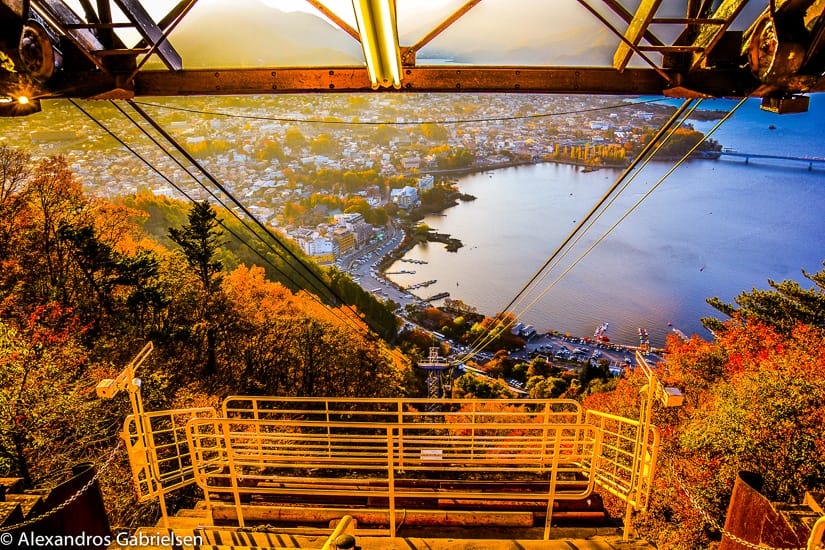
Oshino Hakkai
In this tourist’s village, eight scenic ponds are surrounded with traditional Japanese farmhouses, with Mount Fuji views dominating the background. It is located in Oshino, a small village between Lake Kawaguchi and Lake Yamanaka.
Oshino Hakkai is included on this tour , this one , and this one .
Fuji 5th Station
Fuji 5th station lies about halfway between the traditional starting point of the Mount Fuji climb at Fuji Sengen shrine and the peak of Mount Fuji.
The village is accessible almost year-round, and offers both stunning views of the peak of Mount Fuji and down to the Fuji Five Lakes. Fuji 5th station is included on many tours, including this one and this one .
Chureito Pagoda
This shrine is most famous for having what is perhaps the single most famous view of Mount Fuji, from behind Chureito Pagoda.
Chureito Pagoda is included on this tour .
Love temples? Check out my articles on staying at a temple in Koyasan and the impressive Kumano Sanzan temples in Wakayama
Idea 2: Mt. Fuji Adventure Day Trip
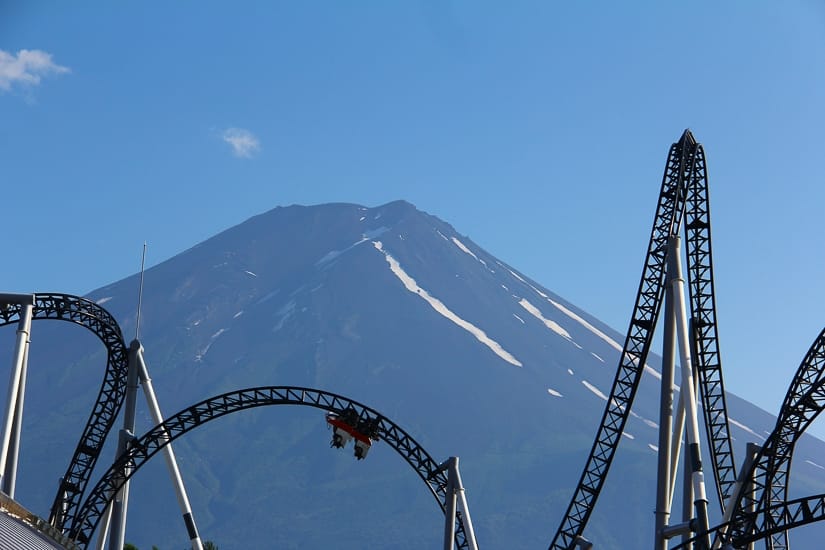
For thrill seekers, here’s a Mt. Fuji itinerary for you. This large amusement park sits very close to the base of Mt. Fuji, offering the chance to see one of the world’s most famous mountains from the top of a roller coaster!
Start your day by heading directly to Fuji Q Highland. This deal includes transfer from Tokyo and entrance tickets. Or get there on your own by booking your transportation on 12Go , then get a discounted admission ticket here .
Some of the most awesome rides in the park include 79-meter Fujiyama , the world’s 8th tallest, 5th longest, and 10th fastest roller coaster, Dododonpa a shorter but even faster roller coaster, Eejanaika , a “4th dimension” roller coaster, and Takabisha , the world’s steepest roller coaster. There are are several haunted attractions, a Ferris wheel, and rides where you get wet.
There is even an onsen (¥1,400 weekdays/¥1,700 weekends, only ¥620 7-9 am) beside Fuji Q, with a view of Mt. Fuji from the relaxation area. There also many restaurants inside Fuji Q to choose from for lunch.
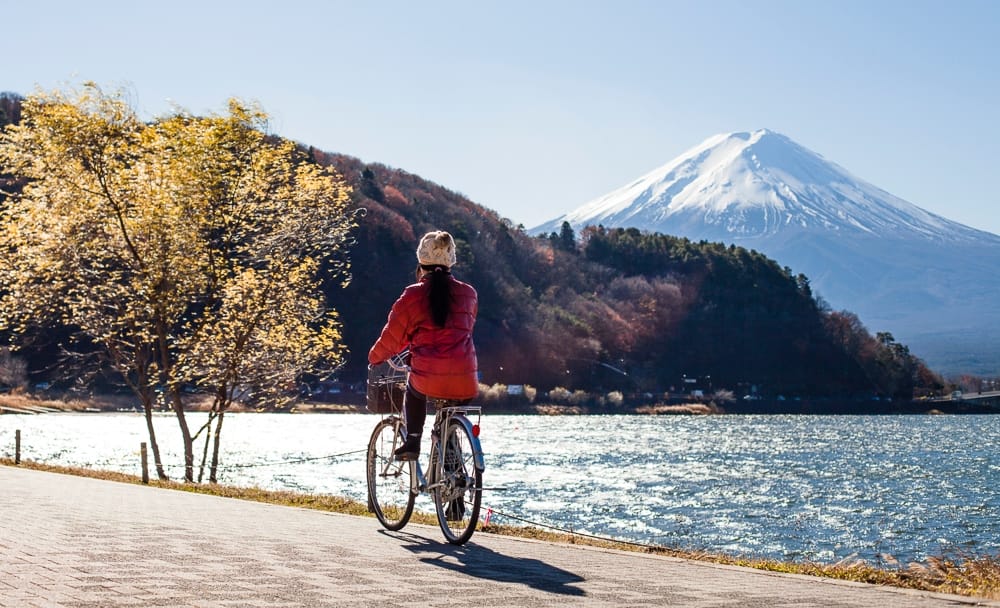
After you’ve had your fill of rides (and lunch), hop on the Fujikyuko bus to Mt. Fuji Yamanakako station (40 minutes) and hire a bicycle (¥1500 for the day) to ride on the dedicated cycling path around the lake, taking in incredible Fuji views along the way.
At the end of your ride, go for a soak in Onsen Benifuji No Yu (10 am to 9 pm, from 6 am on weekends and in winter, ¥700), a (nude only) hot spring which offers Mt. Fuji views. Visitors with tattoos may not be allowed.
Make sure to book your return ride back to Tokyo , and don’t miss the last one!
When it Tokyo, don’t miss the geeky attractions of Akihabara district !
Idea 3: Explore Kawaguchiko
Kawaguchiko, or Lake Kawaguchi, is the most famous and visited of the Fuji Five Lakes. The train station and bus station are located about 10 minute’s walk from the south side of the lake, while postcard-worthy Mt. Fuji views can be enjoyed from the north side.
After traveling from Tokyo to Kawaguchiko , the red line of the Fujikyuko sightseeing bus departs from Kawaguchiko station to all the below sights. It is also possible to ride a bike or walk between many of them.
Start by taking the the bus (11 minutes) to stop #9 or walking (15 minutes) to the Mt. Fuji Panoramic Ropeway for epic Fuji views from the summit of Mt. Tenjo.
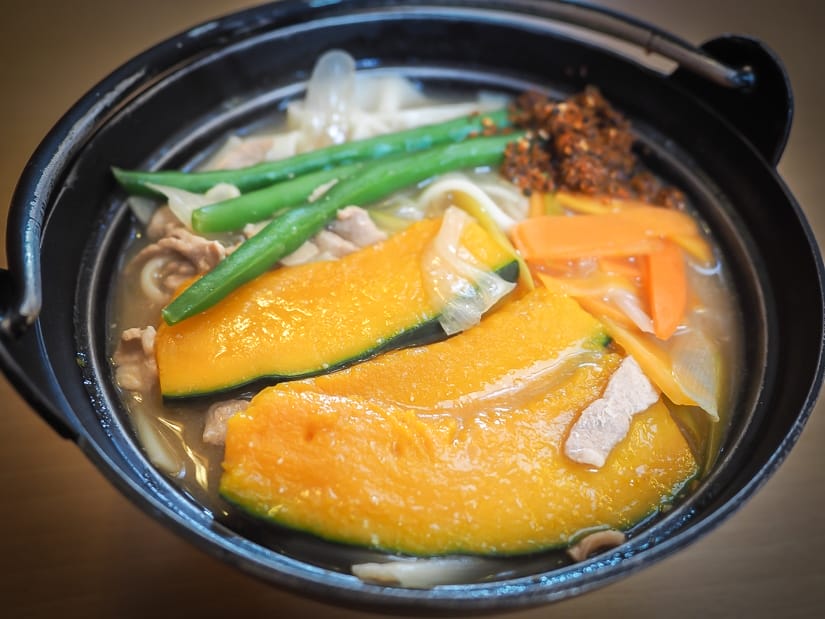
For lunch, take the bus to stop #15 (called “Kawaguchiko Music Forest Museum stop”). Go to Houto-Labo or Houtou Fudou for a lunch of “hoto”. This is a Yamanashi/Mount Fuji specialty that consists of thick udon noodles in a miso broth with pumpkin. Both restaurants are within walking distance of the bus stop.
Nearby, you can also pop into the Kawaguchiko Museum of Art (¥800, open 9:30-5), which houses a large collection of Fuji-related artworks, or the somewhat unusual Kawaguchiko Music Forest Museum (¥1,500), a musical theme park at the lakeside, which the bus stop is named after.
Another worthwhile stop is Kubota Itchiku Art Museum (stop #17), dedicated to a master of silk dying. On display you can see his unfinished masterpiece, an image of Mount Fuji made up of 80 kimonos. The museum is surrounded by lovely woods. Make sure to check whether it’s open before you go.
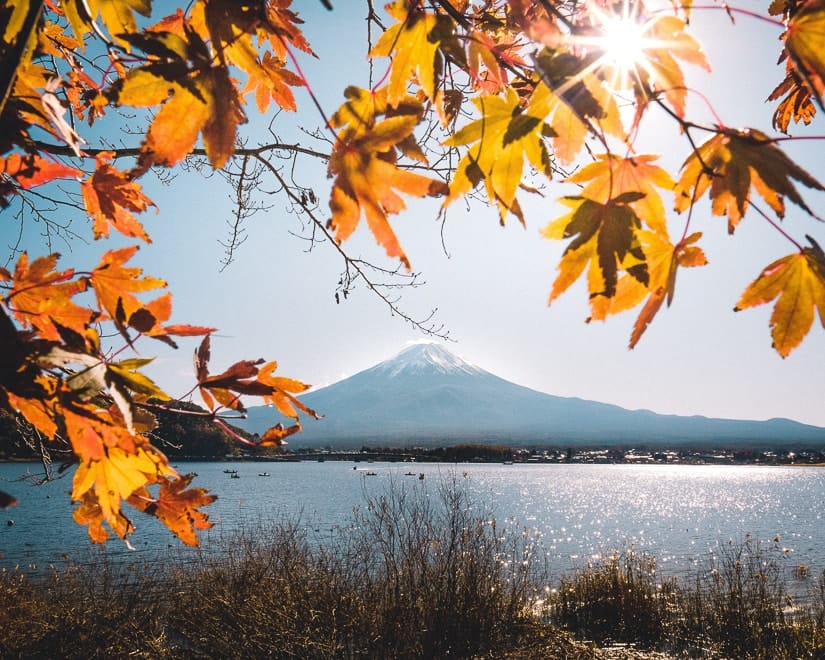
Nearby, the Maple Corridor is a must if you happen to visiting in autumn, while Nagasaki Park (stop #18) offers some of the finest Fuji views on this side of the lake.
If you continue to the end of the bus line (stop #20), Kawaguchiko Natural Living Center features lakeside gardens, fruit picking, and jam making.
Hey day-trippers, here are 40 awesome day-trip ideas from Taipei, Taiwan !
Idea 4: Sacred Sights & Culture
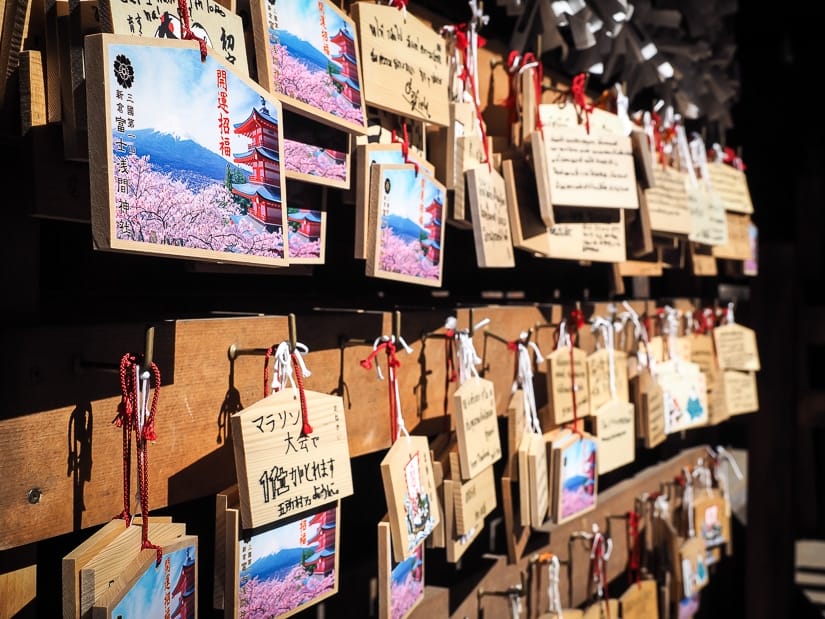
Mount Fuji is sacred to the Japanese. Since ancient times, it has been a Shinto pilgrimage site, a source of artistic inspiration, and a center of training for ascetic Buddhism. Today, there are more than 1000 Fuji Sengen shrines across Japan, which are dedicated to Princess Konohanasakuya, the deity associated with Mt. Fuji.
If you are interested in Mount Fuji’s spiritual connections, you should plan your Mt. Fuji day trip itinerary around visiting some of its most important temples.
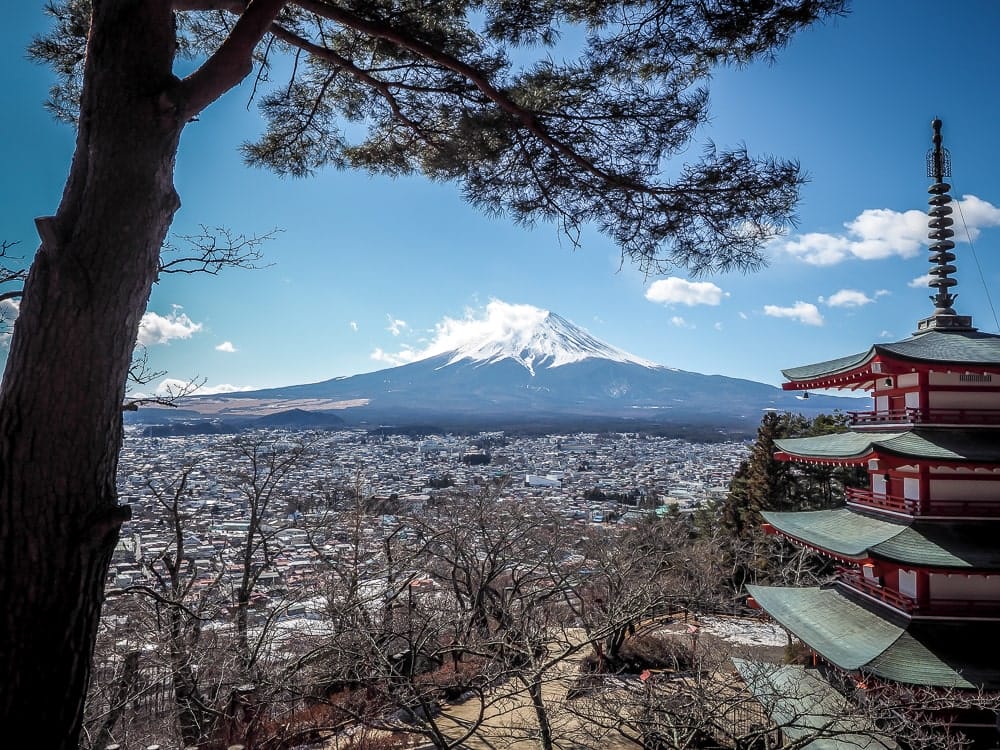
Since Mt. Fuji is usually best seen in the morning, try to take one of the earliest buses from Tokyo to Kawaguchiko .
Start your day by heading to Arakura Sengen Shrine (sometimes called Kawaguchi Sengen Shrine), pictured above. While the shrine itself is peaceful and worth a look, most people come for Chureito Pagoda , where one of Japan’s most iconic views can be enjoyed.
A trail of 398 steps lead to a position behind the pagoda with an unbeatable view of Mt. Fuji. Come in mid-April to add cherry blossoms to your shot, but be prepared for some serious crowds!
To reach Arakura Sengen Shrine, you’ll need to catch the train from Kawaguchiko to Shimo-Yoshida Station (10 minutes, ¥300). From there it’s a 10-minute walk, plus however long it takes you to get up those steps! If you don’t want to go through the transportation trouble, you can visit this pagoda on this organized day tour .
If you are interested in spiritual places, see my articles on hiking the Kumano Kodo pilgrimage and soaking in the sacred hot springs of Wakayama .
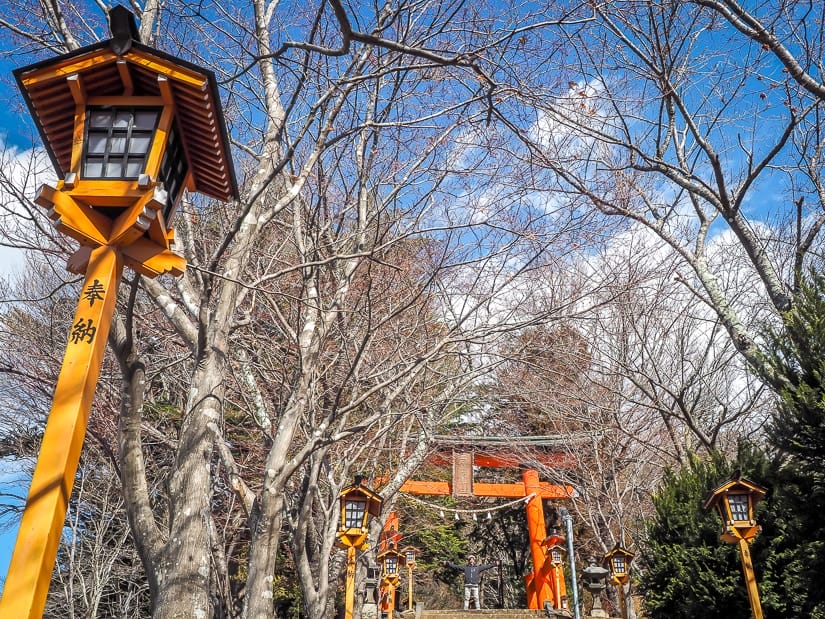
Next on your itinerary, hop on the train from Shimo-Yoshida Station to Fujisan Station (¥219, 6 minutes) to reach the second stop, Fuji Sengen-jinja Shrine (also known as Fujiyoshida Sengen Shrine or Kitaguchi Hongu Sengen Jinja).
The shrine is a 30-minute uphill walk from Fujisan train station. For lunch, you can try Musashi Udon along the way.
You an also get there in 20/10 minutes from Kawaguchiko/Fujisan station on the the Yamanaka Fujikyuko bus (stop at Kitaguchi Hongu Fujisengen Jinja-mae).
Besides these train + walking/busing options, you can hop on the World Heritage Loop bus from Arakura Sengen Shrine all the way to Fuji Sengen-jinja Shrine (30 minutes), but note that this bus doesn’t run from December 1 to March 31.
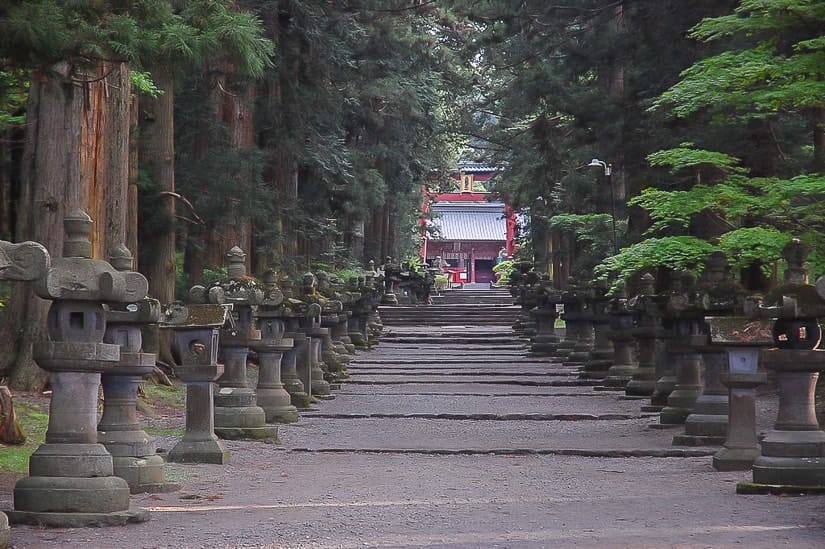
Fuji Sengen-jinja Shrine is the second most important of the three sengen shrines in the Mt. Fuji area (the most important is Fujisan Hongu Sengen Taisha on the other side of Mt. Fuji, but that’s a little too far to include on this Mt. Fuji 1 day itinerary!)
Fuji Sengen-jinja Shrine is also the historical starting point of the hike to the summit of Mt. Fuji from the north, so visiting here is an appropriate inclusion on your Mt. Fuji explorations. From the moment you enter via the long approach from the main road through a cedar forest, you will sense you are in sacred territory.
If you want to see the official start of the hike up to the peak of Mt. Fuji, you can find it to the right behind the main hall, although most hikers nowadays start halfway up the mountain at Fuji 5th Station.
From Fuji Sengen-jinja Shrine, you can also walk (15 minutes) to another smaller forest shrine called Arayayama Shrine , a quiet place dedicated to the god of economic fortune.
Finish your day by hoping back on the Yamanakako bound Fujikyuko bus and heading to Oshino Ninja Village (9am-5pm, ¥1800), and/or Oshino Hakkai (24 hours, museum 9am-5pm, ¥300) where you can learn about traditional local culture.
For a less touristy option, head to the northeast shore of Lake Kawaguchiko and find your way to Kawaguchiko Asama Shrine , a secluded shrine with an 18-meter Otorii (traditional gate) at the entrance and surrounded by 1200-year-old cedars.
Idea 5: Off-the-Beaten Track & Nature
If you prefer to escape the tourist crowds and get into nature, then this Mt. Fuji day trip option is for you. You’ll want to to catch an early ride to Kawaguchiko if you plan to squeeze the below itinerary into one day. Otherwise, you might have to skip a few stops, and make sure to keep an eye on those bus times if you need to get back to Kawaguchiko for your ride back to Tokyo.
For Kawaguchiko Station, hop on the Fujikyuko bus blue line to Koyo-Dai Entrance stop (27 minutes), which is one stop before Narusawa Hyoketsu (Ice Cave) and two stops before Fugaku Fuketsu (Wind Cave) stops.
From the bus stop, a small road runs north off the highway, which you can follow all the way to the peaks of three mountain-top lookout points with incredible views of Mt. Fuji and the Five Lakes: Koyo-Dai (1165m), Sanko-Dai (1202m), and Goko-Dai (1355m).
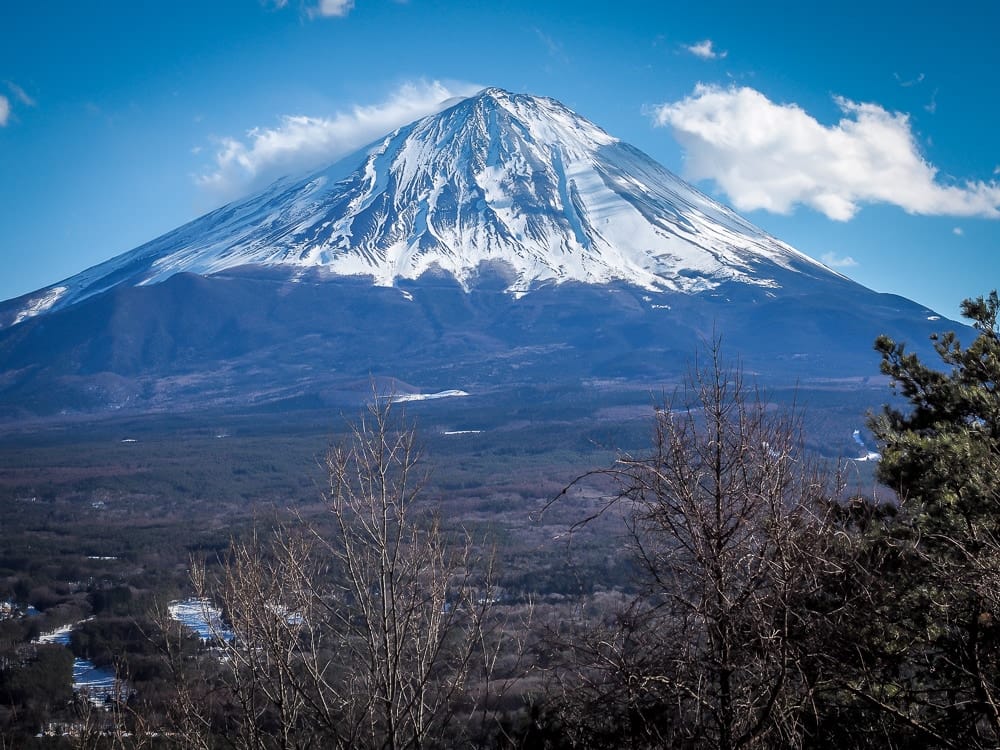
The road and trails are an easy but very rewarding hike, and can even be done in winter (as I did). You can budget an hour return for Koyo-Dai, where you’ll find a small café (closed when I visited) with a lookout platform.
It’s only another 10 minutes up from there to an even better viewpoint at Sanko-Dai (see the cover image of this article), where you can see three of the Fuji Five Lakes.

You’ll need about three hours return to make it all the way to Goko-Dai and back to the highway, but you’ll be rewarded with a view of all five lakes at the same time.
If you want to visit the other spots on this itinerary, I’d suggest sticking to Koyo-Dai and Sanko-Dai, which should take no more than 1.5 hours return.
Next, walk or take the bus one stop to Narusawa Hyoketsu (Ice Cave). After visiting the cave, you can follow a pretty trail (30 minutes) through the forest to similar Fugaku Fuketsu (Wind Cave), or hop on the bus for one stop.
The two caves were formed by molten lava when a flank volcano of Mt. Fuji erupted in the year 864. Both of them contain awesome tunnels, ice walls, ice pillars, and more, and have even been used to store silk worms.
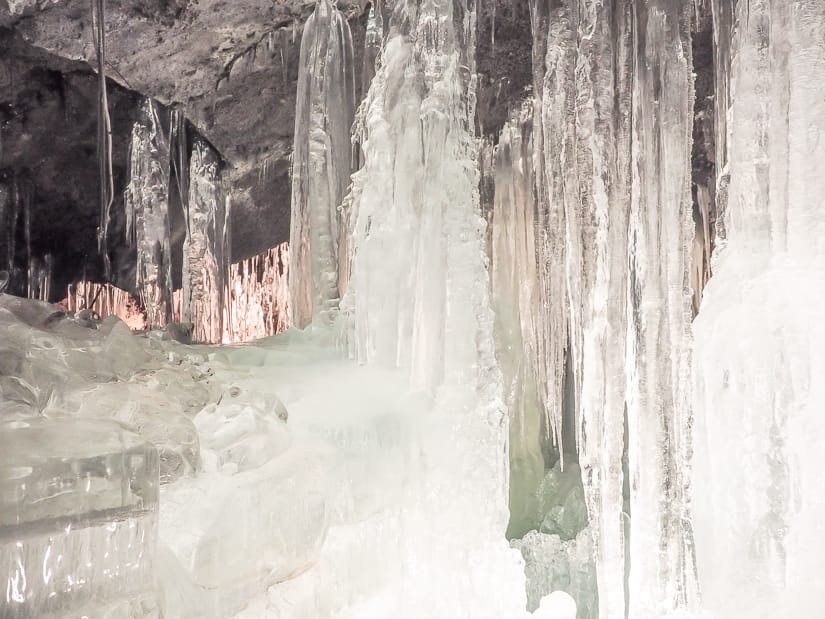
See more information on the website for the two caves , and note that there is a combined ticket if you plan to visit both.
From the Wind Cave, you can catch the green line of the sightseeing bus to remote Lai Sai (Saiko) , where you can visit Iyashi no Sato , a reconstructed traditional village with views of Fuji forming the background to Edo-era houses, which is a similar but less touristy version of Oshino Hakkai between Kawaguchiko and Yamanakako lakes.
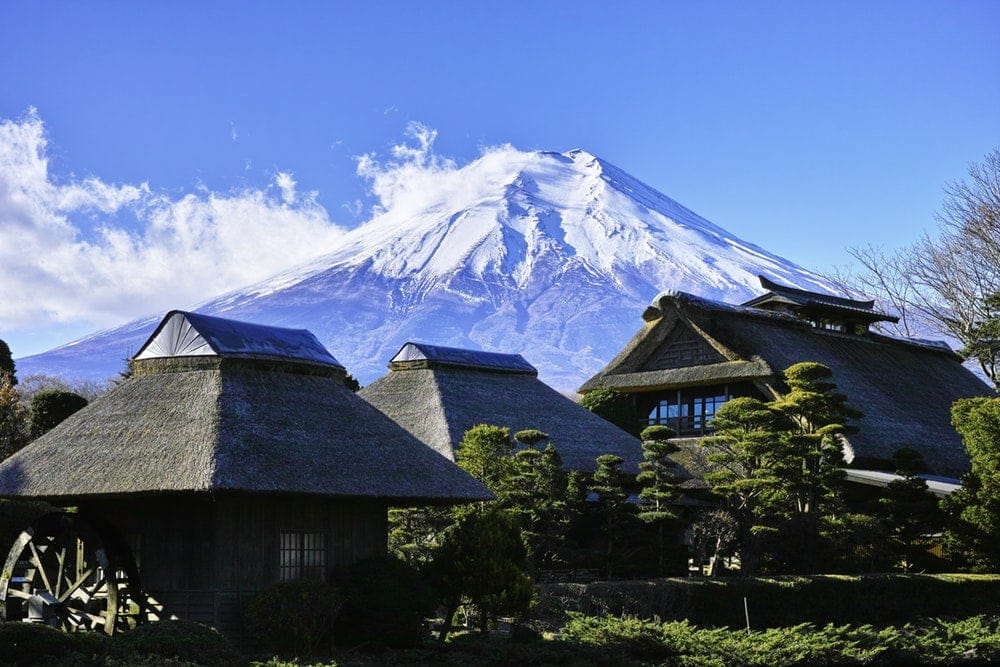
Another choice is to continue along the blue bus line to remote Lake Shoji (Shojiko) , which some say (and I personally agree) has the most beautiful Mt. Fuji views out of all the Fuji Five Lakes.
Get off at Kodaki Fuji View Point for the ultimate Fuji view. But beware; the last bus back from here to Kawaguchiko departs at 4:35 p.m, so if you want to see the sunset and get a shot like the one below, you’ll have to spend the night!
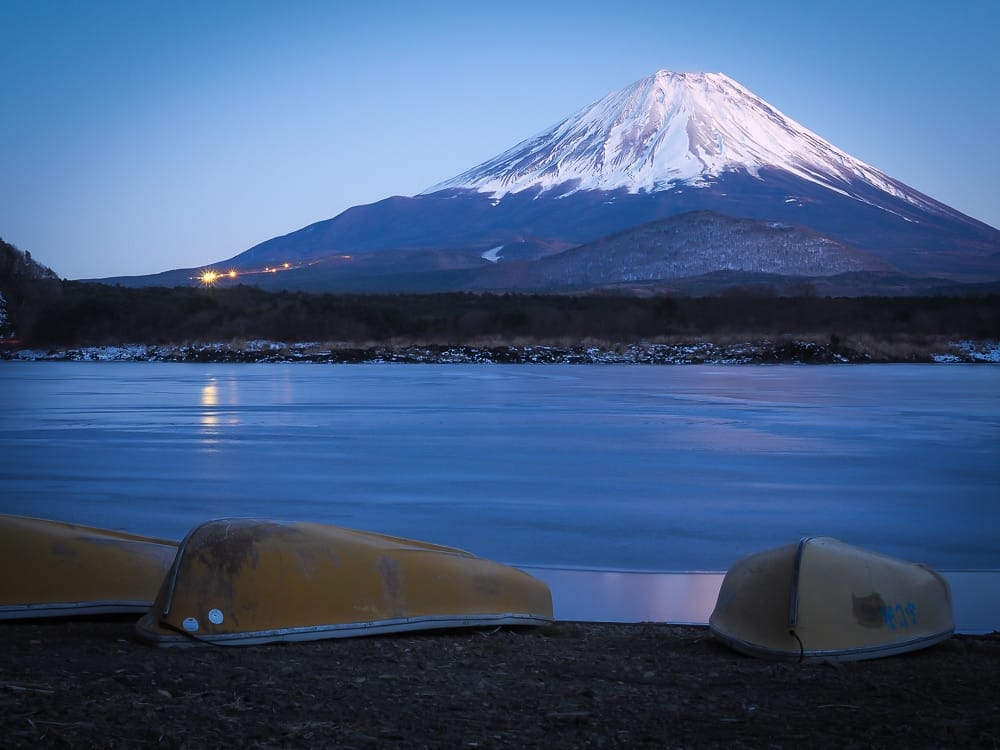
Lake Shoji is actually where I based myself when I visited the Mount Fuji region. There are only a few hotels on the entire lake, so it feels very unspoiled, and the scenery couldn’t be more beautiful. On top of that, the guesthouse where I stayed, Minshuku Murahamasou was the best traditional Japanese guesthouse I’ve ever stayed in .
The food was beyond incredible, and I truly felt I was being taken care of by my (Japanese) mother. The hosts’ American daughter in law was also available by email to answer all my questions in English before I arrived.
So if you end up getting stuck in Shojiko, or you decide to make your day trip to Mount Fuji and overnighter (and you love avoiding the tourist crowds), I can’t recommend this place enough!
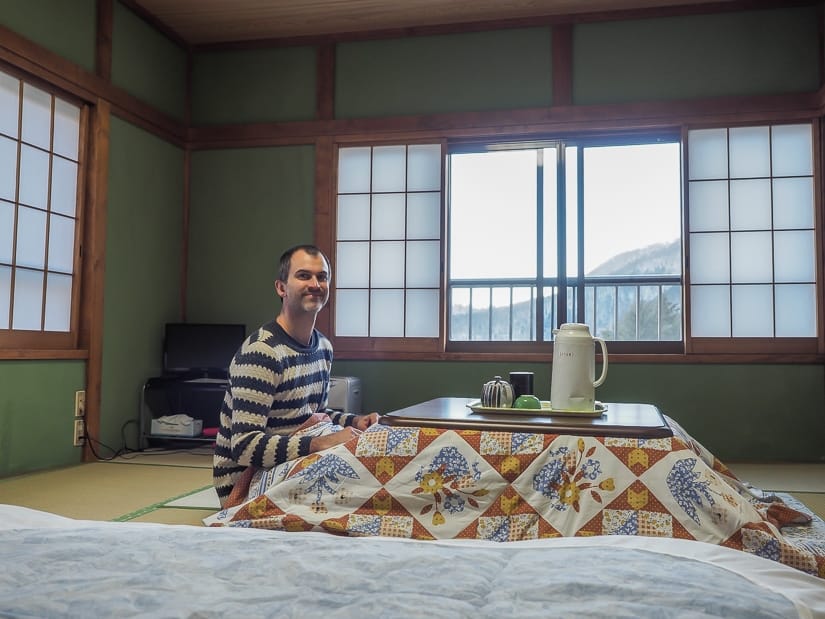
It would be tough to squeeze it into a one day itinerary for Mt. Fuji, but past Shoji Lake, the same bus (the blue line) also reaches the entrance to Motosuko (Motosu Lake) . From the bus stop at the entrance, you can walk (two hours return) to the famous 1000-Yen Viewpoint of Mt Fuji, pictured on the 1000-yen banknote.
There’s no walking path; you just have to walk along the highway, so I would only recommend this for people who REALLY want to see that view or are staying in the area longer.
Getting from Tokyo to Mount Fuji
Buses are the fastest and most convenient option for getting from Tokyo to Mount Fuji. The bus from Shinjuku or Shibuya station takes 1 hour 45 minutes and costs around ¥2000. It’s best to reserve your tickets online before you go and arrive at the station at least 30 minutes before departure.
If you head back to Tokyo during rush hour, the ride can take up to three hours.
Getting from Osaka to Mount Fuji on the Bullet Train
The Shinkansen (bullet train) travels from Shin-Osaka to Shin-Fuji station, and you can even see Mt. Fuji from the shinkansen as you approach Shin-Fuji station (sit on the left hand side!) What an exciting way to get your first glimpse of Mount Fuji! You can book your Shinkansen tickets here .
From Shin-Fuji station, there are only four buses per day to Mount Fuji , departing at 7:15, 9:45, 11:45, and 13:45. Make sure to time it right! The bus ride takes about two hours to Kawaguchiko, passing lakes Motosuko, Shoji, and the Wind/Ice caves, and you get lots of great Fuji views along the way.
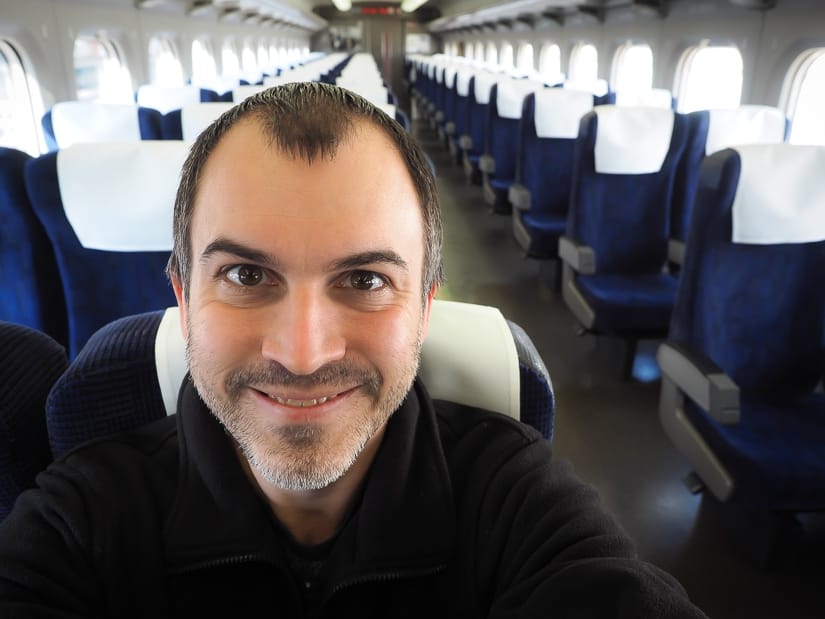
I hope you enjoy your 1 day trip to Mount Fuji, and please let me know in the comments below if you have any comments or questions!
Related Posts

11 thoughts on “Five Awesome Mount Fuji Day Trip Itinerary Ideas”
Hello, I would like to know if it is possible to go from Mont Fuji directly to Kyoto? What is the fastest way? Where does it start? Thank you a lot
Hi Jennifer, You can take the shinkansen from Kyoto to Shin Fuji Station. There’s actually a great view of Mt. Fuji from the station! Then take the bus to the Fuji 5 Lakes area. There are only 4 buses per day (last one 13:45), so make sure you get there early enough! https://bus-en.fujikyu.co.jp/pdf/rosen/timetable_shinfuji_201906.pdf
Hi Nick! Thank you so much for sharing these off-beaten guides, very informative. Question, do we need a guide in trekking the 3 peaks? We are hikers so planning to trek it on our own if trails are well marked. Thanks in advance!
Hi Mary Ann! Thanks for your comment, and I’m glad you were able to find some useful info here. Unfortunately, I haven’t personally trekked to any of these peaks, so I can’t say for sure whether a guide is necessary. I hope you are are able to find reliable info from someone who has!
Hi Nick! Thank you for this awesome guide for exploring Mt.Fuji. I would like to ask how much is the room rate of Minshuku Murahamasou? I have emailed them but still got no reply. Thann you so much
Hi there, you can find their room rates on their website: https://www.murahamasou.com/guestroom.html Their contact information is also on there. Sorry that I cannot help you further than that!
Hi Nick We are staying in Hakone, can you advise the best way to get to get to do Mishima Skywalk and Lake Kawaguchi from there. We are open to the option of staying closer for the night.
Hi Belinda, I’m sorry that I haven’t personally been to Mishima Skywalk or traveled from Hakone to Kawaguchiko. I hope you find the info you are looking for!
Hello Nick!
Thank you for such an informative blog.
Wondering if Highland Fuji Q and Lake Kawaguchiko (cable car and ship cruise) is doable for a day trip?
Thank you kindly, Leah
Sure, I think it’s possible if you get an early start to your day. You can spend 2-3 hours at Fuji Q, budget about 1 hour for the cable car, and still time to fit in a ship cruise as well.
Leave a Comment Cancel reply
- Tokyo Tourism
- Tokyo Hotels
- Tokyo Bed and Breakfast
- Tokyo Vacation Rentals
- Flights to Tokyo
- Tokyo Restaurants
- Things to Do in Tokyo
- Tokyo Travel Forum
- Tokyo Photos
- All Tokyo Hotels
- Tokyo Hotel Deals
- Things to Do
- Restaurants
- Vacation Rentals
- Travel Stories
- Rental Cars
- Add a Place
- Travel Forum
- Travelers' Choice
- Help Center
Mt Fuji group tour or solo? - Tokyo Forum
- Asia
- Japan
- Kanto
- Tokyo Prefecture
- Tokyo
Mt Fuji group tour or solo?
- United States Forums
- Europe Forums
- Canada Forums
- Asia Forums
- Central America Forums
- Africa Forums
- Caribbean Forums
- Mexico Forums
- South Pacific Forums
- South America Forums
- Middle East Forums
- Honeymoons and Romance
- Business Travel
- Train Travel
- Traveling With Disabilities
- Tripadvisor Support
- Solo Travel
- Bargain Travel
- Timeshares / Vacation Rentals
- Tokyo Prefecture forums
- Tokyo forum

5 replies to this topic

Lots of good information here = https://www.japan-guide.com/e/e2172.html

Not many tours go up to the Chureito Pagoda.
>>Lots of good information here = https://www.japan-guide.com/e/e2172.html
>> Not many tours go up to the Chureito Pagoda.
Start checking with the highway bus timetable and make plans sound like what you have to do next.
https://www.highwaybus.com/gp/inbound/index?lang=EN
https://www.jreast.co.jp/multi/routemaps/azusa_kaiji.html
- Itinerary help! 6:08 pm
- Luggages on Keisei Skyliner 1:06 pm
- Tokyo 12:29 pm
- Transiting through Haneda Terminal 2 to Terminal 3 10:15 am
- What would you do/where would you stay for 24 hours in Tokyo 9:31 am
- Teenager Shopping for New Clothes 8:41 am
- Tokai bus N - Motohakone-ko to Mishima Skywalk today
- Tokyo with teens on arrival day (Shimbashi - Ginza)? today
- Need Input Please today
- Fuji Excursion order online pickup at Haneda? yesterday
- Festivals in June 1st week yesterday
- suica app on iphone yesterday
- Tokyo wide pass yesterday
- First time in Tokyo - typical questions yesterday
- top 10 best places to go in tokyo in 4 days? 10 replies
- Confused with which area to stay 20 replies
- Tokyo to Kyoto by train 7 replies
- 1st time in tokyo... where to stay?Ginza Shinjuku or Shibuya 23 replies
- Fly in to Haneda or Narita Airport? 12 replies
- Does Tokyo have a hop on and hop off Sightseeing Bus? 6 replies
- Tokyo Weather in March? 8 replies
- Tokyo-Kyoto bullet train advice 11 replies
- Weird things to do in Tokyo? 22 replies
- Did anyone fly Delta Airlines Singapore - Narita recently? 9 replies
Tokyo Hotels and Places to Stay
- Sample 5 Day Itinerary
- Christmas & New Years in Tokyo?
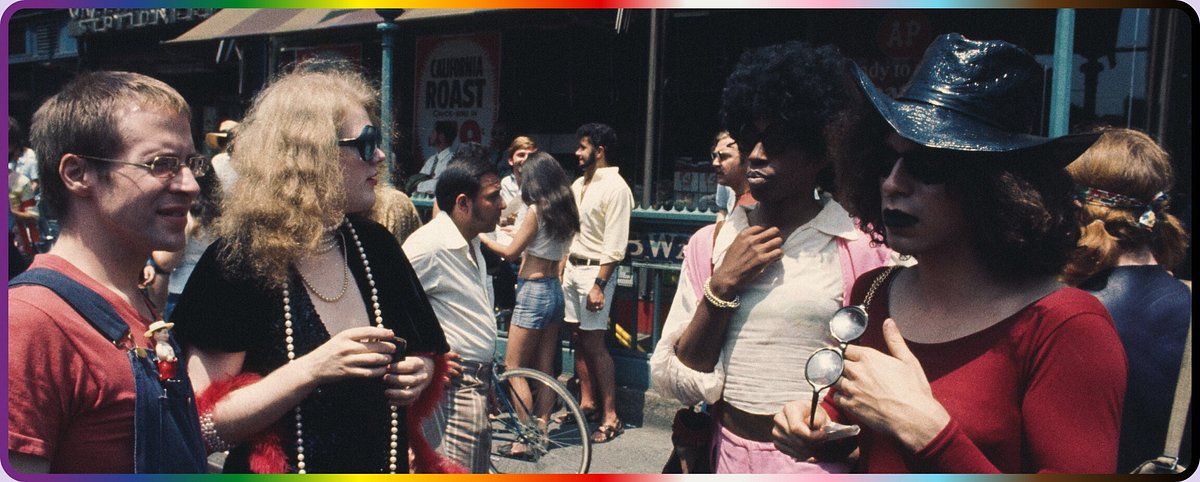
We earn a commission for products purchased through some links in this article.
5 amazing holidays to Japan for an unforgettable adventure
Considering a once-in-a-lifetime Japan holiday? Look no further with these magnificent options
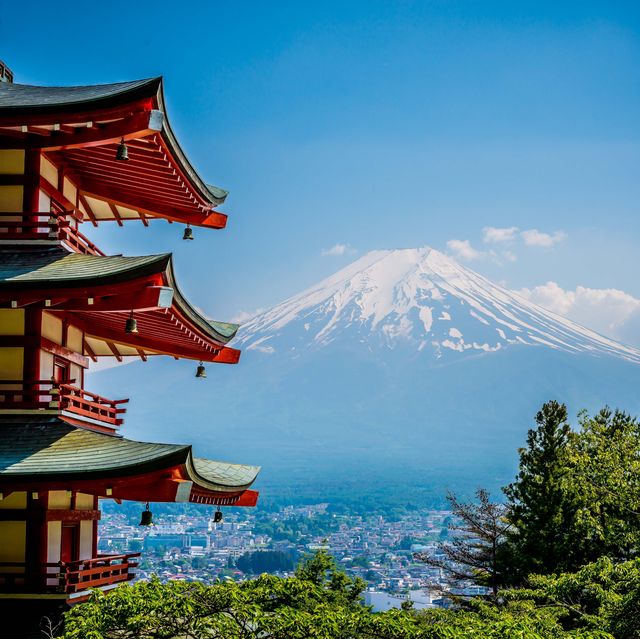
While the country's big-hitting cities such as spiritual Kyoto, cosmopolitan Osaka and vibrant Tokyo, Japan's capital and a popular springboard for Mount Fuji, are all must-sees, there are the sunny southern islands of Japan to discover too. With breath-taking beaches and a slower pace of life, they're the ideal spot for a more leisurely trip. And then there are the Japanese Alps, vast and verdant, and a hugely popular choice for a Japan skiing holiday.
While you need to consider where you'd like to visit on your epic Japan adventure, there's also the case of how . Flights go direct from London to Tokyo, but when it comes to choosing how to traverse this incredible country there are numerous options – from guided coach tours to luxury cruises.
For a helping hand with where to start, we've rounded up some of our favourite ways to discover Japan, including a group tour across the Japanese Alps , a 17-day cruise during beautiful cherry blossom season, and an indulgent inclusive break in sun-drenched Okinawa.
A tour of Japan's essential highlights
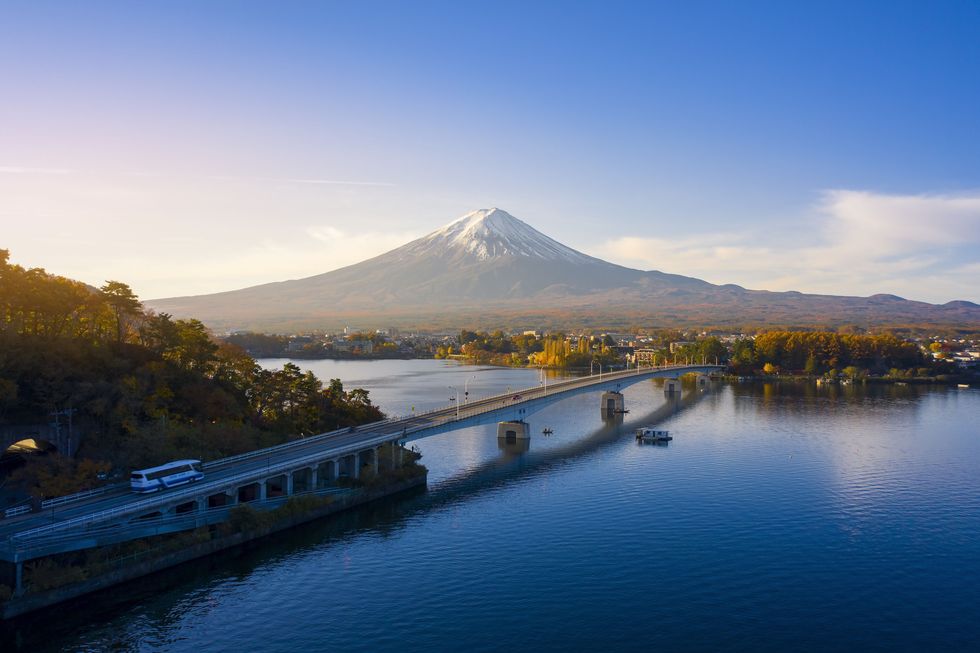
Embark on this thrilling 13-day roundtrip from Tokyo, which showcases the magical, ancient heritage of Japan as well as its futuristic, neon-lit metropolises. This guided tour, which includes coach travel and hotel accommodation, will give you plenty of time to soak up the colour and culture of Japan's capital, which boasts the bustling shopping district of Ginza, vivid Harajuku, iridescent Akihabara electric town, and world-famous Meiji Shrine in Shibuya, the commercial district.
Beyond Tokyo, you'll visit majestic Mount Fiji, Japan's tallest peak; ride the Shinkansen, the high-speed bullet train; see the resident deer in the city of Nara; spend the day in Hiroshima, which has been rebuilt into an attractive, modern city; and have the chance to stay in a ryokan , a typical Japanese inn, in Kyoto. This accessible and fully-organised tour covers all the essentials and more.
Join us on the Good Housekeeping 13-day Japan tour in August 2024.
A cruise in beautiful cherry blossom season
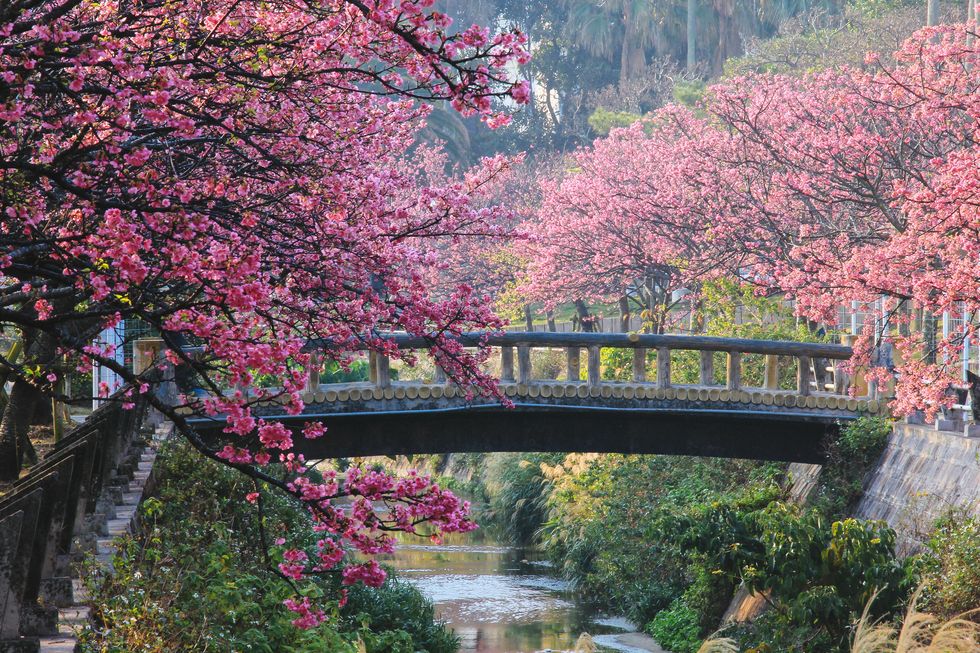
One of the biggest draws to Japan is undeniably its picturesque cherry blossom season and the custom of hanami , admiring the beauty of it. Every spring, millions of locals and visitors alike patiently wait for the first sakura (the Japanese term for cherry blossom) buds to bloom, showing off their delicate, baby pink-hued petals. The abundance of blossom flowering is celebrated with festivals, picnics and the eating of seasonal, sakura-themed delicacies.
If experiencing this springtime phenomenon is on your bucket list, then this 17-day cruise in Japan is for you. While giving you the opportunity to catch the cherry blossom in cities like Tokyo and Osaka, the leisurely sailing with Holland America enables you to see plenty more of Japan, too. Other port stops include Kagoshima, Nagasaki, Aomori and the lively, karaoke-loving city of Busan in South Korea. And all of this is without mentioning the incredible entertainment, food and bars onboard your ship, of course.
Embark on a 17-day cherry blossom cruise around Japan with Good Housekeeping in 2025.
FIND OUT MORE
A jaunt through the Japanese Alps with plenty of tradition
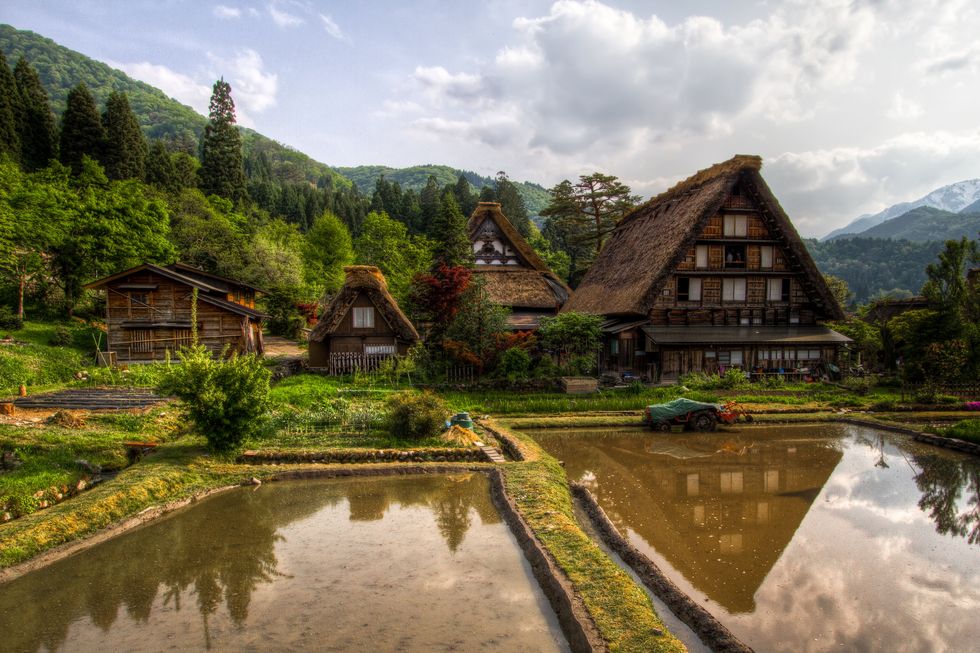
While this group tour ticks off the unmissable cities of Tokyo, Osaka, Kyoto and Nara, it takes its guests on a journey through the beautiful Japanese Alps, a series of mountain ranges on the island of Honshu. This mountainous region is home to an abundance of picturesque cities and towns, all offering a glimpse into Japan's rural life. On this 13-day tour you'll visit the pretty city of Takayama, which brims with Edo Period houses, food and craft markets and traditional restaurants.
You'll also get the chance to wander the village of Shirakawago, a UNESCO World Heritage site known for its thatched roof farmhouses that are said to resemble the praying hands of Buddhist monks. Along with admiring gorgeous scenery, you'll have the chance to get on hands-on with activities such as miso-making, washi paper-making, gold leaf crafting and origami. If you're craving a taste of traditional Japan, you'll find bags of it on this brilliantly-curated trip.
Explore the Japanese Alps with Good Housekeeping in 2024 or 2025.
A city break in Tokyo, Japan's energetic capital
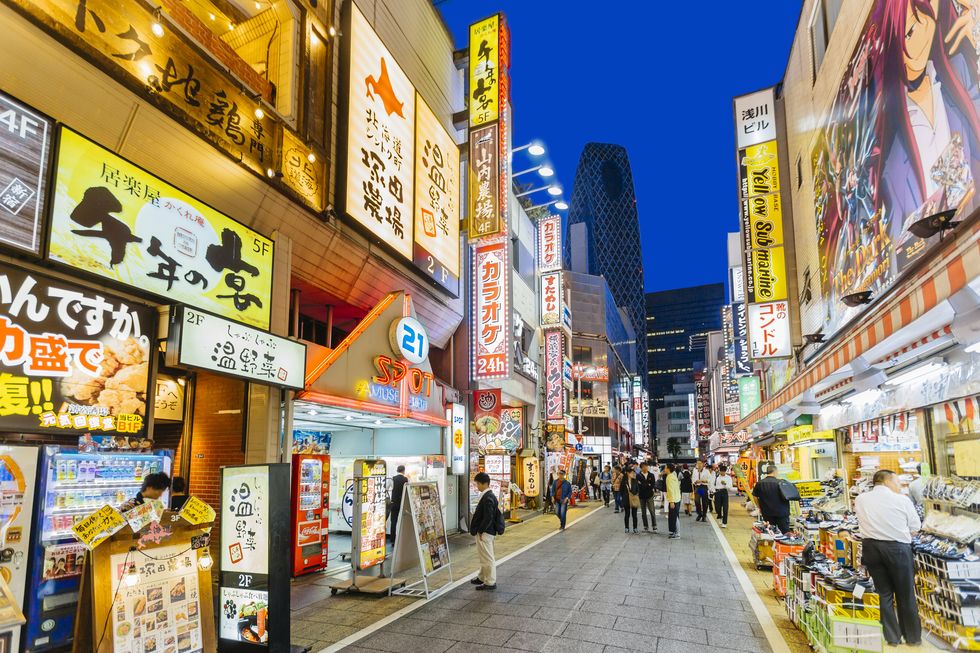
If you've got limited time or would prefer to dedicate your trip to just one destination in Japan, then Tokyo is the answer. Known as Edo until 1868, the Japanese capital is the world's most populous city and thus it's a melting pot of activity, culture and cuisines. As city breaks go, you'll be spoilt for choice here: see the Imperial Palace and many landscaped gardens (we like Koishikawa Korakuen and Hama Rikyu) in central Tokyo, the museums and towering Skytree viewing platform for city-wide views in northern Tokyo, and the busy shopping and entertainment districts of Shibuya, Shinjuku and Harajuku in the west.
For easy access to all of this (and so much more) it's best to base yourself centrally, and a hotel would give you the benefit of a helpful concierge to offer recommendations, book transfers and advise on transport throughout your trip. In a city with so much to offer, a bit of local knowledge goes a long way.
Plan a Tokyo city break British Airways, where you can book flights and hotels as a package.
A relaxing all-inclusive holiday in Okinawa
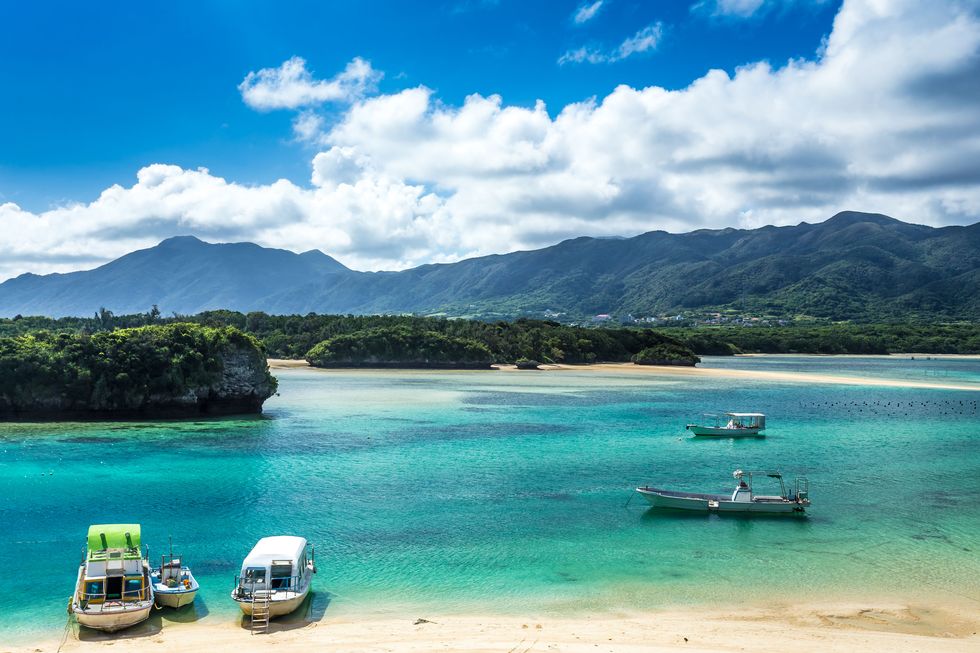
The idyllic island of Ishigaki is part of the Okinawa Prefecture in southern Japan, where the climate is tropical and the weather is warm and humid all year round. It's here that you'll find Club Med's Kabira Ishigaki resort , perched on the edge of the Kabira peninsula with endless views of the turquoise ocean ahead. A family-friendly resort, Kabira Ishigaki is the ideal way to see Japan with a hearty side of rest and relaxation. You can lounge around the freshwater pool and unwind with a treatment in the spa, or, on days where you can muster the energy, try your hand at windsurfing or kayaking in the crystal-clear sea.
The ocean is sacred here, as it's home to manta rays and other marine life, and guests wanting to learn more about life under the water's surface can book eco-friendly snorkelling tours or day trips to nearby islands. There's the chance to experience local culture on dry land too, as guests can take part in sanshin lessons (an Okinawan musical instrument that's similar to a banjo) and sample Okinawan flavours with a selection of traditional dishes, all served in a restaurant that offers 180-degree sea views. Sounds like paradise to us...
Soak up the sun, sand and sea of southern Japan at Club Med's Kabira Ishigaki resort.

@media(max-width: 64rem){.css-o9j0dn:before{margin-bottom:0.5rem;margin-right:0.625rem;color:#ffffff;width:1.25rem;bottom:-0.2rem;height:1.25rem;content:'_';display:inline-block;position:relative;line-height:1;background-repeat:no-repeat;}.loaded .css-o9j0dn:before{background-image:url(/_assets/design-tokens/goodhousekeeping/static/images/Clover.5c7a1a0.svg);}}@media(min-width: 48rem){.loaded .css-o9j0dn:before{background-image:url(/_assets/design-tokens/goodhousekeeping/static/images/Clover.5c7a1a0.svg);}} Travel

Everything you need to know about Japan in spring
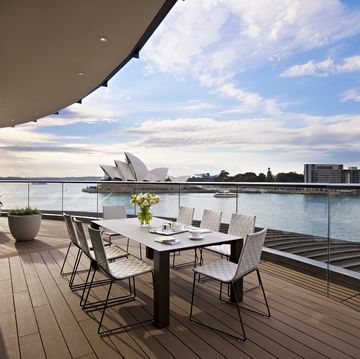
The best hotels in Sydney
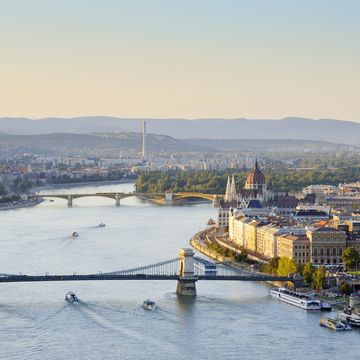
Our guide to Danube river cruises

The best river cruises

The best cruises for 2024

The best spring holidays for 2024
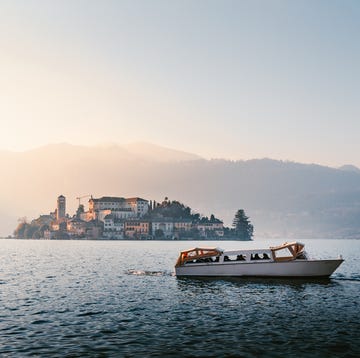
Lake Orta is the hidden gem of the Italian Lakes

Best time to visit Japan: Here's when to go
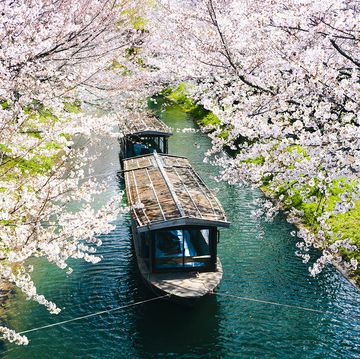
The best places to visit in Japan
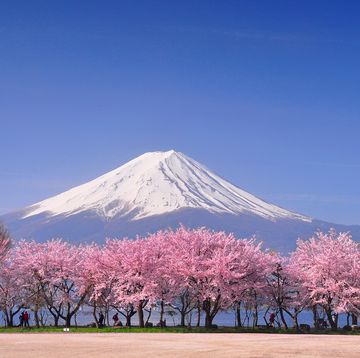
Surprising things about Japan's cherry blossom
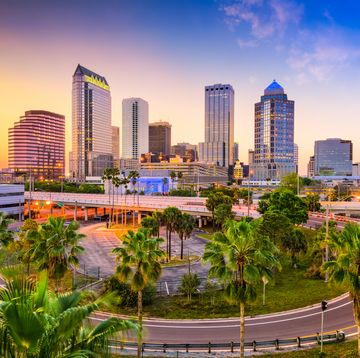
A guide to Tampa, the overlooked city in Florida

Why the best way to see Japan is on foot
F or the uninitiated, landing in Tokyo for the first time can be an overwhelming experience. On my first visit, as my Boeing 777 banked left over Japan’s capital on final approach to the blinking lights of Haneda Airport, I was hit by an initial wave of awe at the sight of a golden sun dipping behind the dim but unmistakable outline of Mount Fuji – and then by a lurch of anxiety as I caught sight of Tokyo’s vast, impenetrable sprawl unfurling into the distance below.
It goes without saying that, while Japan’s 37-million-strong megacity is the standard introduction to this distant land, visitors often find it difficult to get beneath its neon-and-chrome surface. The same is often true of the country as a whole – so densely layered with custom and history – particularly when hopping from city to city by air or lightning-fast Shinkansen (bullet train), and sight to sight by taxi or metro, pausing only to take that must-have snap.
So, on my most recent trip, I opted for a different approach: I decided to explore on foot, keen to experience a slower, gentler, more authentic side of the country and to take advantage of the many excellent walking routes and trails that snake through its cities and countryside.
Short on time, I chose to take the Golden Route, a tourist trail that follows the old Tokaido Road – once the most important of the Five Routes of the Edo period, connecting then-capital city Kyoto to Edo (modern-day Tokyo) – and now a popular way for first-time visitors to experience some of the country’s greatest hits. It’s a route more commonly done by rail or road, but one of which short, manageable stretches can easily be done on foot – so I chose three of its finest stops, donned my walking boots, and prepared to explore.
First, I headed south to Kyoto Prefecture, a region whose meandering coastline doesn’t receive as much attention as its seductive, temple-strewn capital Kyoto, yet offers an introduction to a side of Japan that couldn’t be further from Tokyo’s lights and noise.
I chose to start at Miyazu Bay in the prefecture’s north, just under five hours from Tokyo by rail. Stepping out of Amanohashidate station to be greeted by the softly curving contours of Chion-Ji Temple and drifting smoke of incense, I strolled down to the famous “land bridge”, a curious two-mile sandbar that connects to the opposite headland, and began to amble across.
Flanked by some 8,000 pine trees, traversing the spit takes around an hour (though the most cinematic views are found at the summit of Mt Nariai Outlook, reachable via a short but steep funicular), and on this crisp winter day, the lush surrounding hills looked as if crafted from brush strokes, the water impossibly still.
From here, I spent the day trekking on to Ine, an absurdly quaint fishing village around 14 miles north, characterised by a shoreline dotted with traditional boathouses known as funaya. The snow continued to fall as I paced its quiet white streets and rising coastal roads, as if I had stumbled on some secret, silent place.
For my next walk, I headed back across Japan’s main Honshu Island (though once customary to traverse the Tokaido on foot, this 280-mile stretch seemed better attempted in the comfort of a Shinkansen carriage) to the Izu peninsula, an essential stop on the Golden Route offering the finest views of the resplendent Mount Fuji, particularly at Izu Panorama Park.
Keen to veer again from the tourist trail, I left the iconic mountain to its camera-wielding visitors and headed instead for the small hot spring town of Shuzenji Onsen. Discovered around 1,200 years ago by the Buddhist monk Kobo Daishi, this spot sits snugly surrounded by lush green hills, its languid way of life attracting writers such as Yasunari Kawabata and Natsume Soseki during the Meiji era.
My day-long ramble through the town passed by swaying bamboo groves, quiet cherry blossom forests, ancient wooden shrines, communal foot baths and the toasty warm waters of the Tokko-no-Yu hot spring. From the vantage point of the bright red Kaedebashi Bridge that spans the flowing Katsuragawa River, I could see why so many continue to fall for this alluring slice of Japanese life.
Continuing north – before the Golden Route deposited me back among Tokyo’s skyscrapers – I headed for the port city of Yokohama, once a sleepy fishing village during the Edo period (a stretch of close to three centuries during which Japan closed itself off from the rest of the world) and one of the first Japanese cities to eventually open for trade with the West.
Though its inviting harbour on Tokyo Bay is wonderfully walkable, I chose to spend my time in Japan’s third-largest city at the Sankeien Garden, a tranquil oasis in southern Yokohama with snaking trails lined by charming cherry blossoms and beds of lotus flowers. Angular Japanese pine bore a passing resemblance to Californian Joshua trees, while a curving pagoda poked its head above dense green foliage to the sound of gently cascading water nearby.
As evening fell, I strolled the breezy groves of Yamashita Park, a calm oasis just beyond where Yokohama’s waterside skyscrapers and 100m-high ferris wheel formed a frenetic constellation of colours and shapes against the darkening sky. Content, I paused, sat and drank in the cool air – steady, centred and certain that I had found Japan at its loveliest.
James March was a guest of the Japan National Tourism Organization and Japan Airlines , which flies from London to Tokyo from £1,074 return
Seven spectacular walks in Japan
On the temple trail.
Shikoku, the smallest of the four main islands, is famous for its 88-temple pilgrimage trail. Pilgrimages have been key to Japanese religious practice since at least the Heian period 1,000 years ago, and on this tour travellers can enjoy ryokan guesthouses and tranquil walks alongside the bright lights of cities such as Osaka and Kyoto.
How to do it: Mac’s Adventure (0141 530 5452; macsadventure.com ) offers the eight-day Shikoku Pilgrimage Trail trip from £2,115pp, including three nights in a ryokan, three nights in three-star standard hotels and one night in a shukubo pilgrim’s lodging. Flights not included
Into the wild
They say it rains “35 days a month” on the far-flung subtropical island of Yakushima. Thankfully that wasn’t the case during my time there, but it does explain the lush green landscape here. Yakushima National Park is filled with wild deer and macaques and has a wild, ragged coastline, but a walk amid the twisted branches and gushing rivers of the Tolkien-esque Shiratani-Unsuikyo Ravine is the pièce de résistance.
How to do it: Yakushima Geographic Tour ( yaku-geo.com ) offers the one-day Shiratani-Unsuikyo trip from £220pp, including pick-up, entry fee to the National Park and lunch
Mountain escape
For a more advanced hiking challenge, the Shin-Etsu Trail carves a path through the backbone of the Sekida Mountains, a range that separates Niigata and Nagano Prefectures in central Honshu island. The trail passes through small villages, vast farmlands, soaring cedar woods and breezy beech forests, and the entire trail is signposted by easy-to-follow arrows, so you won’t get lost.
How to do it: Inside Japan Tours (0117 244 3380; insidejapantours.com ) offers the six-night Shin-Etsu Trail trip from £1,450pp, including hotel/ryokan accommodation, six breakfasts, five lunches, six dinners, and all transport between accommodation and the trail. Flights not included
Navigate a crater
Deep in the heart of Kyushu island lies Mount Aso, Japan’s largest volcano. The walk around the grasslands of its 15-mile-long caldera offers the chance to look inside the living, breathing crater of an active volcano, while the trail to the Daikanbo viewpoint gives panoramic views of the caldera, its valleys and the volcanic peaks. Pairing this day trip with the short flight to Yakushima island is a great way to see Kyushu’s distinctive scenery.
How to do it: Explore Kumamoto ( explore-kumamoto.com ) offers the one-day Around Aso Tour from £75pp, including English guide fee, transport from Higo-Ozu Station, parking and entrance fees
On an 11th-Century pilgrim’s rail
The Kii Peninsula juts out from Honshu island, and the old Kumano Kodo Trail weaves its way past dense forests, waterfalls, ancient temples and hot springs. This rural walk follows village paths and forested mountain trails, with stops each evening at traditional ryokans and minshuku that offer a window into 11th-century Japanese life.
How to do it: Mac’s Adventure (0141 530 5452; macsadventure.com ) offers the five-night Kumano Kodo Trail trip from £1,195pp, including five nights’ B&B, evening meals and trains from/to Kyoto or Osaka. Flights not included
To Japan’s north
Go the whole hog and explore Japan’s wild northernmost island with an expansive two-week tour. Hokkaido doesn’t attract the visitors that its glamorous counterparts to the south do, but that’s to your advantage. You’ll need to hire a car for this one, but Hokkaido’s empty roads pass through landscapes of smoking volcanoes, steaming hot springs, mist-covered lakes and vast national parks. Needless to say, the walks in this quiet corner of Japan are glorious.
How to do it: Inside Japan Tours (0117 244 3380; insidejapantours.com ) offers the 14-night Wild Hokkaido trip from £3,930pp, comprising 14 nights’ accommodation, all transport between destinations, including airport transfers and domestic flights, eight-day car hire and various guided hikes. Flights not included
The Samurai route
Literally “the road through the mountains”, the Nakasendo was one of Japan’s ancient highways and once crammed with travellers, including feudal lords, samurai, itinerant merchants and pilgrims. These days, the route offers a serene meander through quaint countryside, walking between perfectly preserved Nakasendo post towns such as Tsumago, Nojiri, Yabuhara and Hirasawa, while stopping at charming traditional inns along the way.
How to do it: Mac’s Adventure (0141 530 5452; macsadventure.com ) offers the nine-night Nakasendo Trail trip from £2,765pp, including B&B accommodation, four evening meals, train tickets and a private guided tour of Kyoto. Flights not included
What was your favourite walking holiday of all time? Would you choose to travel Japan by foot? Please share your comments below
Sign up to the Front Page newsletter for free: Your essential guide to the day's agenda from The Telegraph - direct to your inbox seven days a week.

Skip to content
Your browser does not support JavaScript, or it is disabled.Please check the site policy for more information.
- National Report
- Korean Peninsula
- Around Asia
- Manga & Anime
The Asahi Shimbun
Base opens for high tourist spot offering ‘best’ view of Mt. Fuji
By SHIN TOYOHIRA/ Staff Writer
April 25, 2024 at 17:49 JST

FUEFUKI, Yamanashi Prefecture—A tourist base opened here on April 25 to lure foreign visitors to a little-known spot high in the mountains that is touted to offer the most spectacular view of nearby Mount Fuji.
Lily Bell Hutte, equipped with a cafe, shop and tourist information center, serves as the gateway to Fujiyama Twin Terrace, which sits on the 1,600-meter-high Shindo Pass.
The ridge straddles the city of Fuefuki and the town of Fuji-Kawaguchiko, both in Yamanashi Prefecture.
“Mount Fuji seen from Twin Terrace is the best in Japan,” said Masakatsu Okawa, manager of the Kofu branch of JTB Corp., the travel agency that operates Lily Bell Hutte. “But the spot is not yet widely known among foreign tourists.”
Visitors can view the majestic Mount Fuji, down through to its base, Lake Kawaguchiko and, far in the distance, Lake Yamanakako on a clear day.
It was a hidden spot known only to hikers and photographers, but the Fuefuki city government spent 178 million yen ($1.1 million) on constructing viewing decks and walking trails in 2021.
The Twin Terrace observation decks are not accessible by private vehicles because the roads are narrow.
Visitors take a 10-minute bus ride from the Suzuran Gunseichi parking lot, which is located in front of Lily Bell Hutte at an altitude of 1,300 meters, after parking their vehicles there.
Fuefuki Mayor Masaki Yamashita said he hopes that the new facility will help attract foreign tourists from Lake Kawaguchiko, a popular sightseeing resort, to the city and further onto other travel destinations in Yamanashi Prefecture.
“We need to create a place where (foreign visitors) want to come if we want to bring them over to Fuefuki from Kawaguchiko,” Yamashita said at the opening ceremony for Lily Bell Hutte on April 23. “We will be happy if we can establish a new route to travel around Yamanashi Prefecture via Fuefuki.”
The city government spent about 89 million yen on constructing Lily Belle Hutte.
Yamashita said he hopes to attract 100,000 visitors to Twin Terrace over the long term.
About 20,000 people visited the facility during the eight months through November, according to the city.
Jinji Yamada, JTB managing executive officer, said the company wants to increase visitor numbers to 50,000 this year with the opening of Lily Belle Hutte and other measures.
JTB on April 25 started a bus tour from Kawaguchiko Station on the Fujikyuko Line to Twin Terrace and back three times daily.
The tour costs 3,500 yen for an adult. The company expects 13,000 participants this year.
JTB is also considering offering guided tours along hiking trails around Twin Terrace as well as travel plans combining other attractions in Yamanashi Prefecture, such as dips at the Isawa Onsen hot spring resort and fruit picking at orchards.
The shuttle bus between the Suzuran Gunseichi parking lot and Twin Terrace will run until November.
The round-trip ticket costs 1,800 yen for an adult. The fare is 500 yen for Fuefuki residents.
There is a free bus service to the Suzuran Gunseichi parking lot from a location in Fuefuki where vehicles can be parked.
For more information, visit the city government’s website at ( https://www.city.fuefuki.yamanashi.jp/kanko/sports/spot/fujiyamatwinterrace.html ) or Lily Belle Hutte’s website at ( https://fujiyama-twinterrace.com/en/ ).
Related News

Observation deck to view Mt. Fuji opens in Fuefuki mountain pass

Yamanashi pushing railway plan on Mt. Fuji, but city opposes

Surge in visitors, ‘bullet climbing’ raise concerns on Mount Fuji

An old idea gains traction as railway on Mt. Fuji proposed

With prime view of Mt. Fuji, Shizuoka terrace is reeling them in
Trending Now

Eight injured after earthquake rocks Shikoku and Kyushu
April 18, 2024

Slush avalanche cascades down Mt. Fuji during heavy rainstorm
April 12, 2024

Collapsed houses left uncleared 100 days after Noto earthquake
Recommended

Stories about memories of cherry blossoms solicited from readers

Cooking experts, chefs and others involved in the field of food introduce their special recipes intertwined with their paths in life.

A series based on diplomatic documents declassified by Japan’s Foreign Ministry

A series on the death of a Japanese woman that sparked a debate about criminal justice policy in the United States

A series about Japanese-Americans and their memories of World War II

Here is a collection of first-hand accounts by “hibakusha” atomic bomb survivors.
Learning English
- Asahi Weekly
In-house News and Messages
- The New York Times
BACK TO TOP
- Site Policy
- Transmission of user information to external service providers(利用者情報の外部送信)
Copyright © The Asahi Shimbun Company. All rights reserved. No reproduction or republication without written permission.

IMAGES
VIDEO
COMMENTS
Fujikyuko Bus. Another way to visit mount fuji from Tokyo is to take the Fujikyuko Bus. This affordable option offers a one-way ticket for just 2,000 yen per person and will take you on your journey in just over 2 hours. The trip begins at the Shinjuku Expressway Bus Terminal, located on level 4.
If you don't have a lot of room in your Japan itinerary, a Mount Fuji day trip from Tokyo is a great way to peep the famous peak. There are essentially 3 ways to experience Mount Fuji as a day trip from Tokyo: Use the Hakone Free Pass. Self-drive to Kawaguchiko. Join a guided tour.
A day-trip from Tokyo to Mount Fuji and the lesser-known Hakone five lakes area is among the favorite experiences of many travelers to Japan, so here is our guide on how to visit this famous landmark with the Japan Rail Pass. Whether you prefer climbing or a more relaxed pace, we have the perfect guide for you make the most out of this trip! Let's start with some interesting facts about Fuji ...
100K+ booked. Departing from Tokyo. Save to wishlist. Gallery. From US$ 48.35US$ 48.89. Select options. Enjoy a classic Mt Fuji tour from Tokyo and explore the nearby destinations locals and travelers love! See the picturesque 8 ponds of Oshino Hakkai, believed to have been formed from the eruption remains of Mt Fuji.
Step onto the direct bus and watch the skyscrapers of Tokyo give way to rural vistas as you glide towards the icon of Japan. The buses run towards the looming presence of Mount Fuji every 10 to 30 minutes from 6:45am to 8:15am and drop you at Kawaguchiko Station. Travel Time: 2 hours. Price: 2,000+ yen per person.
Embarking on a Mount Fuji day trip offers the chance to enjoy Japan's tallest and most revered mountain up close. Mt. Fuji's magnificence draws numerous visitors from across the globe, making it a significant destination. The popularity of Mt. Fuji and its surrounding area of Lake Kawaguchiko continues to soar, with a steady rise in tourist numbers, reaching a staggering 4.5 million visitors ...
The best Mt Fuji bus tour verdict. After browsing through different tours for some time, I finally chose the Mt Fuji Classic Tour that covers Lake Kawaguchiko with a tea ceremony experience, visiting an ancient shrine at the foot of Mt Fuji, exploring 8 sacred ponds of Oshino Hakkai and shopping at Gotemba Premium Outlets as the final stop. I was in for a treat!
Mt. Fuji or Hakone Private Sightseeing Day Trip From Toyko Mt. Fuji Full-Day Sightseeing Trip From Tokyo; Best Small-Group Tour. Best Combination Tour. Best Value Tour. Location: 6 Chome-5-1 Nishishinjuku, Shinjuku City, Tokyo: Hotel pickup and drop-off: Mitsui Sumitomo Bank, Shinjuku Nishiguchi Branch: Start: 7:50 AM: 8:30 AM: 8:00 AM ...
The coach will pick you up between 7:30 and 9 am, depending on your designated pickup location. You can choose from 5 locations when booking your day trip from Tokyo to Mount Fuji: Hotel Metropolitan, Kelo Plaza Hotel, Courtyard Marriott, Grand Prince Hotel New Takanawa or the Hamamatsucho Bus Terminal. You can choose a hotel as your pick-up ...
tokyo to mt fuji travel time. By train, it takes around 2-2.5 hours to reach Kawaguchiko Station at the northern base of Mount Fuji from major stations like Tokyo Station or Shinjuku Station.This includes transferring from the JR Chuo Line to the Fujikyu Line at Otsuki. Driving yourself by rental car or private transportation takes around 1.5-2 hours under normal traffic conditions.
Head to Fuji-Q Highland from Mt. Fuji 5th station via Kawaguchi-ko station by highway bus. The 11:40 AM departure will take 40 minutes and cost ¥1,570, one way. From there, you can enjoy roller coasters and other theme park rides to your heart's content. Day passes are ¥6,300 per person and the park is open until 5 pm.
Mount Fuji is part of the Fuji-Hakone-Izu National Park. It's located less than 100 kilometers away from Tokyo. It is a UNESCO World Heritage site since 2013 and has always been a popular destination for day trips from Tokyo. Most day trips from Tokyo to Mount Fuji will head to either Lake Kawaguchiko or Hakone.
1 How to Reach Mt. Fuji from Tokyo. 2 Things to Do Near Mt. Fuji. 2.1 See Fuji's Reflection in Lake Kawaguchi. 2.2 Visit a Unique Museum. 2.3 Enjoy the View from Chureito Pagoda. 2.4 Or From A Thrilling Rollercoaster. 2.5 Take a Hike.
Full description. Discover Mt. Fuji's beauty on a private guided day tour from Tokyo. Discover some of the best views of the iconic peak, as well as cultural gems as you visit 5th station, Oishi Park, Ninja Village, Lake Kawaguchiko, Arakurayama, Oishino Hakkai and Lake Yamanaka. Start with pickup from your hotel in Tokyo.
The cheapest way to get from Tokyo to Mount Fuji is taking the Fujikyuko Bus or Keio Bus. For a single trip, you just have to pay 2,200 yen per person for the bus ticket price. The ride takes around 1 hour 45 minutes. You can take the bus from level 4 of the Shinjuku Expressway Bus Terminal in Tokyo.
For example, my 16-day holiday covered Tokyo, Mount Fuji, Kyoto, Osaka and Hiroshima - taking between 1-3 hours to jump from one location to the next. ... A day trip to Nara Park will also see ...
3. From Tokyo to Mount Fuji by Train High-speed train passing Mt. Fuji. There are regular year-round trains from Tokyo to the Mount Fuji area. And while trains cost more and take an hour longer than buses, they also offer stunning views of mountains and lakes along the way.. The best train option available is the Fuji Excursion Limited Express train, which runs from Tokyo's Shinjuku Station ...
14 Yokohama. 15 Takayama. 16 Nikko. 17 Kobe. 18 Niseko. 19 Fujiyoshida. 20 Date, Hokkaido. Discover Mount Fuji, one of the world's most famous mountains and a UNESCO World Heritage Site. Explore the Kawaguchi Lake, 5th Station, and Oshino Hakkai on a full-day guided trip from Tokyo.
But the thing is, the sheer number of options is overwhelming (and confusing). To save you some time, we've rounded up the very best Mt. Fuji tours out there. 3 tips for picking the best Mt. Fuji tour. Mt. Fuji tours compared (chart) 1. Lake Kawaguchi scenic tour. 2.
Cruise on Lake Ashi and enjoy Mount Fuji on this guided day trip to Hakone from Tokyo. Take a cable car, see volcanic landscapes, choose to shop in the Gotemba outlets or relax in a hot spring. ... We had an incredible view of Mt. Fuji and got to relax our aching feet after walking thousands of steps around Japan! 10/10 I will be recommending ...
Join a full-day guided tour from Tokyo that travels to Mt Fuji, then continues to nearby Lake Ashi and the Mt Komagatake Ropeway. Enjoy the ease of comfortable transportation and a knowledgeable guide, who will accompany you to the revered Mt Fuji's 5th Station. Take a short boat cruise on Lake Ashi and climb by aerial tram to the top of Mt Komagatake for views of Mt Fuji. Return to Tokyo by ...
Mount Fuji and Hakone Day Trip from Tokyo: 5 th station, Hakone Pirate ship, and Gotemba outlets Highlights. This 11-hour tour found exclusively on Klook will take you to Mount Fuji 5th station. If you travel from December to March, Mt Fuji's 5th station is replaced by Mt Fuji's second station where you will have the opportunity to play in ...
Idea 1: Mt. Fuji Day Tour from Tokyo. Mount Fuji bento box! Maybe you don't want to figure out all the planning & buses by yourself. Or perhaps you want to eliminate stress about missing your bus back to Tokyo. Then taking a Mount Fuji day tour from Tokyo may be the best choice for you!
From US$ 126.15. Select options. Tour route: 5th Station - Lake Ashi - Mt. Komagatake Ropeway. Great view from the 5th station of Mt. Fuji, 2300 meters above sea level. Take a cruise through the waters of Lake Ashi. Enjoy 7-minute ropeway ride and trek up Mt. Komagatake. Gaze upon the natural grace of Mt. Fuji and enjoy panoramic views.
Answer 1 of 5: Hi, I will be going to Japan(Tokyo) for the first time alone soon and was wondering if a solo day trip to Mt. Fuji is the right way or a group tour? I really just want to check out the mountain from afar to take pics especially of that icon temple...
Day 4 of this 5 day Tokyo travel itinerary promises a fantastic blend of nature, culture, and immersive experiences. ... Ah, the majestic Mount Fuji! If you're wanting to visit the iconic view ...
Beyond Tokyo, you'll visit majestic Mount Fiji, Japan's tallest peak; ride the Shinkansen, the high-speed bullet train; see the resident deer in the city of Nara; spend the day in Hiroshima, which ...
How to do it: Inside Japan Tours (0117 244 3380; insidejapantours.com) offers the 14-night Wild Hokkaido trip from £3,930pp, comprising 14 nights' accommodation, all transport between ...
FUEFUKI, Yamanashi Prefecture—A tourist base opened here on April 25 to lure foreign visitors to a little-known spot high in the mountains that is touted to offer the most spectacular view of ...
1 likes, 2 comments - casualcruisingtravelandculture on April 23, 2024: "We saw mount Fuji and were blessed with a cloudless sky! #travel #mountfuji #tokyo #nature # ...